Vipassī Buddha
by Wikipedia
Accessed: 3/18/21
Vipaśyin Buddha
Sanskrit: विपश्यिन् Vipaśyin Buddha
Pāli: Vipassī Buddha
Burmese: ဝိပဿီဘုရား
Chinese: 毗婆尸佛 (Pinyin: Pípóshī Fó)
Japanese: 毘婆尸仏びばしぶつ (romaji: Bibashi Butsu)
Korean: 비파시불 (RR: Bipasi Bul)
Sinhala: විපස්සී බුදුන් වහන්සේ
Thai: พระวิปัสสีพุทธเจ้า Phra Wipatsi Phutthachao
Tibetan: རྣམ་གཟིགས་ Wylie: rnam gzigs
Information
Venerated by: Theravada, Mahayana, Vajrayana
Attributes: Pure Buddha
Preceded by: Puṣya Buddha
Succeeded by: Śikhin Buddha
In Buddhist tradition, Vipassī (Pāli) is the twenty-second of twenty-eight Buddhas described in Chapter 27 of the Buddhavamsa.[1] The Buddhavamsa is a Buddhist text which describes the life of Gautama Buddha and the twenty-seven Buddhas who preceded him. It is the fourteenth book of the Khuddaka Nikāya, which in turn is part of the Sutta Piṭaka. The Sutta Piṭaka is one of three pitakas (main sections) which together constitute the Tripiṭaka, or Pāli Canon of Theravada Buddhism.[2]
The third to the last Buddha of the Alamkarakalpa, Vipassī was preceded by Phussa Buddha and succeeded by Sikhī Buddha.[3]
Etymology
The Pali word Vipassī has the Sanskrit form Vipaśyin. Vi (good) and passī (saw) together mean "having seen clearly". The word belongs to the same family as the term vipassanā (contemplation). This Buddha was so named because he had big eyes, clear vision both day and night, and his insight into perpetual complicated circumstances and very deep theories.
Biography
According to the Buddhavamsa, as well as traditional Buddhist legend and mythology, Vipassī lived 91 kalpas [393 billion years]— many millions of years — before the present time.[4][5] In Vipassī's time, the longevity of humans was 84,000 years.
Vipassī was born in Bandhumatī in Khema Park, in present-day India.[6] His family was of the Kshatriya varna, which constituted the ruling and military elite of the Vedic period. His father was Bandhumā the warrior-chief, and his mother was Bandhumatī. His wife was Sutanu, and he had a son named Samavattakkhandha.[6]
Vipassī lived as a householder for 8,000 years in the palaces of Nanda, Sunanda and Sirimā. Upon renouncing his worldly life, he rode out of the palace in a chariot.[6] Vipassī practiced asceticism for eight months before attaining enlightenment under an Ajapāla nigrodha tree.[5] Just prior to achieving buddhahood, he accepted a bowl of milk rice offered by Sudassana-setthi's daughter, and grass for his seat by a guard named Sujâta.
Sources differ as to how long Vipassī lived. He was reported to have died in Sumitta Park, at the age of either 80,000[6] or 100,000 years.[5] His relics were kept in a stupa which was seven yojanas in height, which is roughly equal to 56 miles (90 km).[6]
Physical characteristics
Vipassī was 80 cubits tall, which is roughly equal to 121 feet (37 m), and his body radiated light for a distance of seven yojanas.[6]
Teachings
Vipassī preached his first sermon in the Khamamigadâya to 6,800,000 disciples, his second sermon to 100,000 disciples, and his third sermon to 80,000 disciples.[5]
His two foremost male disciples were Khanda and Tissa and his two foremost female disciples were Candâ and Candamittâ. Asoka was his personal assistant. His good donors were Punabbasummitta and Naga in the lay men, Sirimâ and Uttarâ in the lay women. Mendaki (then called Avaroja) built the Gandhakuti (scented pavilion) for him. He did the uposatha once every seven years, and the sangha observed the discipline perfectly.
See also
• Buddhist cosmology
• Glossary of Buddhism
• Longevity myths
Notes
1. Morris, R, ed. (1882). "XXVII: List of the Buddhas". The Buddhavamsa. London: Pali Text Society. pp. 66–7.
2. Lancaster, LR (2005). "Buddhist books and texts: canon and canonization". Encyclopedia of religion (2nd ed.). New York: Macmillan Reference USA. p. 1252. ISBN 978 00-286-5733-2.
3. Buddhist Text Translation Society (2007). "The Sixth Patriarchs Dharma Jewel Platform Sutra". The Collected Lectures of Tripitaka Master Hsuan Hua. Ukiah, California: Dharma Realm Buddhist Association. Retrieved 2013-03-25.
4. Beal, S (1875). "Chapter III: Exciting to religious sentiment". The romantic legend of Sâkya Buddha: from the Chinese-Sanscrit. London: Trubner & Company, Ludgate Hill. pp. 10–17.
5. Davids, TWR; Davids, R (1878). "The successive bodhisats in the times of the previous Buddhas". Buddhist birth-stories; Jataka tales. The commentarial introduction entitled Nidana-Katha; the story of the lineage. London: George Routledge & Sons. pp. 115–44.
6. Horner, IB (1975). "The nineteenth chronicle: that of the Lord Vipassin". The Minor Anthologies Of The Pali Canon: Part III: Chronicle Of Buddhas (Buddhavamsa) and Basket Of Conduct (Cariyapitaka). Oxford: Pali Text Society. pp. 74–7. ISBN 086013072X.
Freda Bedi Cont'd (#3)
Re: Freda Bedi Cont'd (#3)
Part 1 of 2
Indian Rock Art - Prehistoric Paintings of the Pachmarhi Hills
by Dr. Meenakshi Dubey Pathak
Accessed: 3/18/21
NOTICE: THIS WORK MAY BE PROTECTED BY COPYRIGHT
This is an account written and translated by Dr. Meenakshi Dubey Pathak, freelance artist and researcher in India, presented here as part of the Bradshaw Foundation India Rock Art Archive. Dr. Meenakshi Dubey Pathak is a member of the Rock Art Society of India (RASI), the Indian Society of Prehistory and Quaternary Studies and the Australian Rock Art Research Association (AURA), Australia. Dr. Dubey Pathak's extensive research not only brings to light the prehistoric rock art of India but it also highlights the drastic need for its preservation: "This wonderful and precious cultural heritage of ours is facing the danger of extinction by the unaware and uncivilized human beings and their vandalism. The agencies at work must put in a concerted effort to educate the people including the local tribes about the importance of these painted rock shelters and take steps to preserve them before its too late."
INTRODUCTION TO INDIA ROCK ART
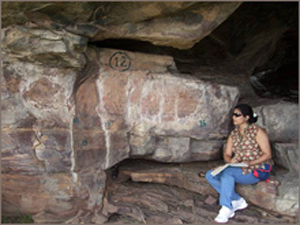
Dr. Meenakshi Dubey Pathak - Gaddie. Rock Art Site in the Vindhachal Ranges
The earliest discovery of prehistoric rock art was made in India, twelve years before the discovery of Alta Mira in Spain. Archibald Carlleyle discovered rock paintings at Sohagihat in the Mirzapur district of Uttar Pradesh in 1867 and 1868. Unfortunately he did not publish. J Cockburn rightly commented that Carlleyle’s knowledge died with him (Smith, 1906: 187). Fortunately, Carlleyle had placed some of his notes with a friend, Reverend Regionald Gatty, and V A Smith published these later, which is the only record of his discovery of Rock paintings. In his note he wrote “Lying along with the small implements in undisturbed soil of the cave floors, pieces of a heavy red mineral-coloured matter called geru were frequently found, rubbed down on one or more facets, as if for making paint. Geru is evidently a partially decomposed hematite (Iron peroxide). “On the uneven sides or walls and roofs of many caves or rock shelters, there are rock paintings apparently of various ages. Though all evidently of great age, done in red colour called geru. Some of these rude paintings appeared to illustrate in a very stiff and archaic manner scenes in the life of the ancient stone chippers. Others represent animals or hunts of animals by men with bows and arrows, spears and hatchets. With regard to the probable age of these stone implements I may mention that I never found a single ground or polished implements not a single ground ring stone or hammer stone in the soil of the floors of any of the many caves or rock shelters I examined.” (Smith 1906: 187).
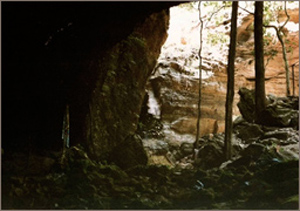
Painted Cave
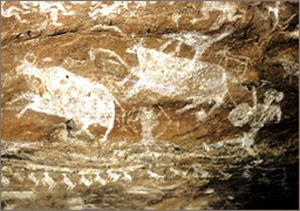
Row of Cows
In 1881 Cockburn had found fossilised rhinoceros bones in the valley of the Ken River in the Mirzapur region as well as a painting of a rhinoceros hunted by three men in a shelter near Roap Village. In 1881 J Cockburn published an account of all his discoveries (J Cockburn 1891: 91). F Fawcett in the cave of Edakal in Kozhikode district of Kerala made the earliest discoveries of rock engravings (Fawcett F 1901: 402-21). A few years later A Silberrad published a pictorial description of the rock paintings in Banda district (Silberred 1970: 567-70). C W Anderson discovered a painted shelter of Singhanpur in the Raigarh district in Madhaya Pradesh (Anderson CW 1981: 298-306). More rock paintings were found later by F R Allchin 1963: 161) (Sundara A 1974: 21-32) and (K Paddayya 1968: 294-98) from the same area as well as the Gulberga district of Karnataka. Manoranjan Ghosh brought the Adamgarh group of painted rock shelters near Hoshangabad in Madhya Pradesh to light in 1932. The first example of rock engravings was discovered in 1933 by K P Jayaswal in a rock shelter at Vikramkhol in the Sambalpur District of Orrisa. (Jayaswal KP 1933: 58-60).
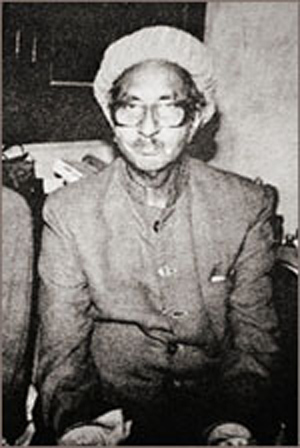
Dr V S Wakankar
As Dr Jean Clottes said, the ‘Father of Indian Rock Art’ and my (Guru) teacher Dr V S Wakankar had discovered several hundred painted shelters mainly in Central India, and attempted a broad survey of the rock paintings of the whole country and prepared a chronology of the paintings based on the content style and superimposition (Wakankar 1973: 251-353). The most important of his discoveries is Bhimbettka near Bhopal in Madhya Pradesh, which has one of the largest concentrations of rock paintings in India. Bright Allchin has published a study of prehistoric art in 1958. R K Verma in 1964, J Gupta 1967, S K Pandey 1961 and J Jacobson 1970 have also contributed to the discovery of Indian rock art. DH Gordon studied the rock paintings of Pachmarhi in the Mahadeo Hills in 1932. He wrote several papers in Indian and foreign journals and has summarised his views on Indian rock art in his book. (Gordon 1958: 98-17).
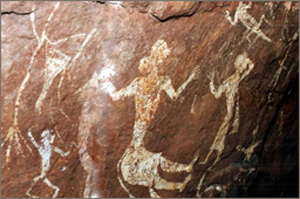
Dancers
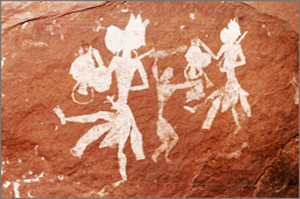
Head Hunters
In recent years Yashodhar Mathpal and Erwin Neumayer have discovered a new group of ten painted shelters on Patni Ki Rahari hill near Bari on Bhopal Bareli road (Mathpal 1976 23: 28). In April 1981 to 1990, with the help of local tribes, I discovered fifteen painted rock shelters in the Pachmarhi Hills. In India over a thousand rock shelters containing paintings are situated in more than 150 sites. In India almost every state has rock art sites of painted shelters and engraved boulders.
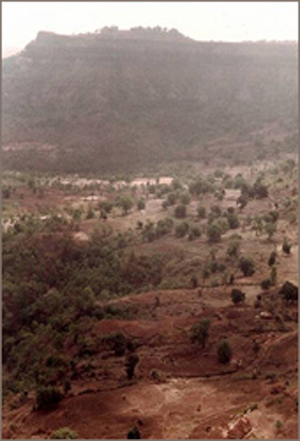
Satpura Ranges India
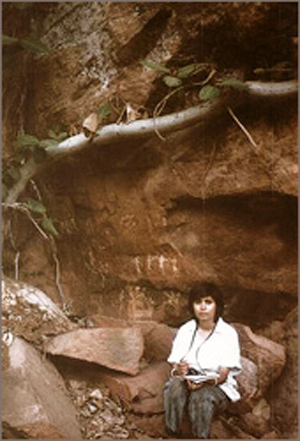
Dr Meenakshi Pathak
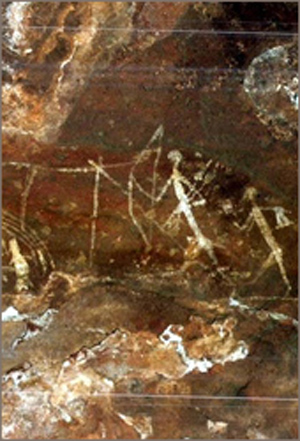
Hunting Scene
Central India is the richest zone of prehistoric rock art in India. The highest concentration of rock art sites is situated in the Satpura, Vindhya and Kaimur Hills. These hills are formed of sandstones, which weather relatively faster to form rock shelters and caves. They are located in the dense forest and were ecologically ideal for occupation by primitives. They were used for habitation in the Stone Age and even in the later periods. Inside the caves on the walls and ceilings artists painted their favourite animals or human forms, symbols, daily life hunting and fighting.
INDIAN ROCK ART: PACHMARHI EXPLORED
The Pachmarhi Hills are situated in the geographical center of the Indian sub continent in the State of Madhya Pradesh. The hills lie in the Satpura Range, formed of the Gondwanaland sandstone belonging to the Gondwanaland series of the Talcher Group formations. The sandstone sequence is of the upper Gondwanaland formation. The sandstone is relatively friable and, on weathering, forms the sandy solid found at the foot of the hills. These hills form one of the most beautiful parts of the Satpura Range. The shelters are found all over the hills and the surrounding forests, in the foothills and riverbanks. Many shelters are covered with paintings made over centuries by early inhabitants depicting a wide range of subjects expressed by them in a variety of styles and left as great heritage for us to understand them and appreciate their unique contribution.
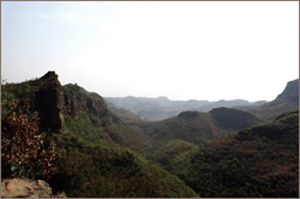
The Pachmarhi Hills
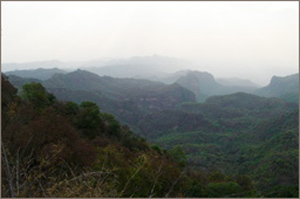
The Pachmarhi Hills
Captain J Forsyth made the discovery of this place, as a sanitarium. Forsyth was sent there in 1862 under the instructions of Sir Richard Temple, Commissioner of that day to explore this portion of the Satpura Forest. Here he built a forest lodge and named it “Bison Lodge”. His famous book “The Highlands of Central India” depicts the exquisite beauties of the Satpura range. The point from where Captain J. Forsyth forest glimpsed the extra ordinary sight of Pachmarhi is still one of the finest points named as “Forsyth point”. When he came to Pachmarhi, the area was occupied by the Korku jagirdar of Pachmarhi, but there were traces of a much older civilization in the shape of sites of ruined huts near “Handi kho” site. The total area of the plateau is about 60 sq kms including the forest area and 12.90 sq kms occupied by the Pachmarhi cantonment.
Part of Forsyth’s report states “Every where the massive group of trees and park like scenery strikes the eye and the greenery of glades and wild flowers, unseen at lower elevation, maintains the illusion that the scene is a bit out of our temperate zone. Thereafter, a multitude of beauty spots were discovered, and the place developed. Much remains the same even today. Pachmarhi still retains its tranquility, its many silences, its gentle green and its soothing forest. It is one place where solitude is miraculously achieved in moments, and the sighs of swaying trees are the only sounds you will hear. Pachmarhi is a lovely hill-girded plateau on the green Satpura range, called by the tourists as the Queen of Satpura." (M.P. Tourists 1962: 4).
By popular belief the name “Pachmarhi” is a derivation of “Pach-marhi” or a complex of five caves of the Pandava brothers, who are supposed to have spent a considerable portion of their lifetime of exile incognito in this area. Genuine place is attainable any where in “Pachmarhi”. Pachmarhi, the legend tells, was once a huge lake guarded by a monstrous serpent. This serpent began terrorizing the pilgrims visiting the sacred shrines of the Mahadeo hills. Lord Shiva, angered by this, hurled his trident at the snake, imprisoning him in the rift of a solid rock, which assumed the shape of a pot or handi. The flames of wrath dried up the lake and empty space assumed the shape of a saucer. Botanists have therefore reported the existence of plants only found by the sides of large expanses of water, these rare penmen of flora seem to bear out the myth! (M P Tourist 74:2).
The hills are thickly vegetated with rich floristic and faunal biota but quite widespread and difficult to access. The natural species represented in the rock art were of great economical importance, having food value for the shelter-dwellers and often form subjects of their painting. Rock paintings found within shelters here are the major sources of our understanding of how their creators related to their physical, biological and cultural environments. These people, as do their descendants at the present time, held beliefs and practices which expressed a direct or indirect relationship between their environment and themselves. Within this body of expression, the evolution of the art form, with the development of mankind over centuries, plays an important and multifaceted role.
GR Hunter brought the painted rock shelters of Pachmarhi Hills to the notice of D.H. Gordon (1958). Hunter had excavated some sites here in 1932 and again in 1934-35. The 1935 excavation revealed that the cultural sequence within this region commenced during the Mesolithic period, confirming that the Pachmarhi Hills were not occupied during the Palaeolithic. Thus, the rock paintings of this region belong to the Mesolithic and later periods. The Mesolithic paintings clearly depict a society of hunters and gatherers. Mainly they portray man and his relationship with animals. The subject matter of this period is quite varied, although game animals are most frequently represented. Bulls, bison, elephants, wild boars, deer, tigers, buffaloes, dogs, monkeys and crocodiles appear alongside smaller species such as rats, lizards, turtles and fishes. Some of the birds are identified as peacocks, jungle fowl and ostrich. Arthropods, such as scorpions and wild bees, were also depicted. The hunters are portrayed using spears, axes, sticks and bows and arrows.
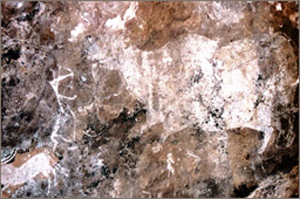
Hunting Wild Buffalo
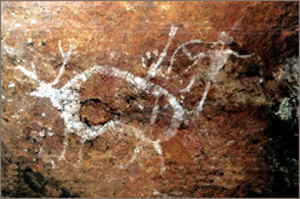
Stag Hunting
Female figures are occasionally shown. Sexual life does have a place in Mesolithic art but is not very prominent, and male and female union is rarely shown. It seems that dances were important for ceremonial or entertainment purposes during this period. For these dances headdresses and animal masks representing donkeys, crocodiles, bulls or monkeys were worn. The compositional elements of these Mesolithic paintings are highly developed. They represent an element of the creative spirit of the early people. That their aesthetic sense had developed to a high degree can be seen in geometric designs and in paintings of the X-ray style. Pregnant animals such as cow and deer depict the fetus in the womb. Most interesting depiction is a urinating cow. It suggests the awareness of medicinal value of cow urine to the primitives. As we all know according to Indian Ayurved cow urine is a very good treatment for cancer patients and for other ailments. Head Hunters are another interesting depiction . A variety of animals can be seen from elephants to ants.
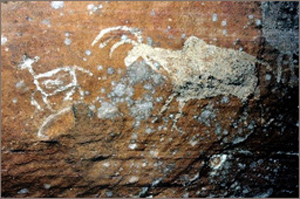
Pregnant Animal with fetus in the Womb
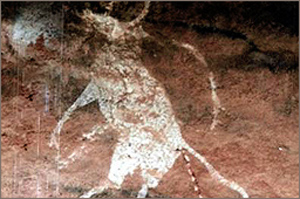
Urinating Cow
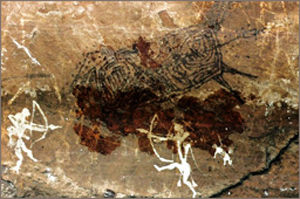
X-Ray Style Rock Art Painting
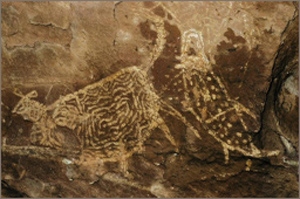
X-Ray Style Rock Art Painting
In the Pachmarhi Hills most of the paintings are from the Chalcolithic to the Historical period. Conflict is one of the main themes depicted during this time. War scenes are common but reasons for conflict are not indicated. Horsemen armed with swords and shields overlie the earlier paintings portraying the life of hunters and gatherers. They bear elaborate war equipment consisting of spears, axes, swords, shields, daggers and bows and arrows. Other individuals carry drums and trumpets, and foot soldiers as well as men riding caparisoned horses and elephants are depicted. Goats, dogs, oxen, donkeys and performing monkeys accompany the troops. The descendants of the original hunters and gatherers and artists of this region are the tribal Korku and Gond who still uphold some of the traditions of their ancestors. In the rock paintings their ancestors are depicted dancing in pairs or in rows and playing musical instruments. They hunted animals and collected honey from the hives of wild bees. Their mode of dress was quite simple. The women carried food and water and looked after the children. The forebearers of the present day tribal people had a variety of ways to express the magic of their beliefs, rituals and taboos. The tribes living in these hills have wooden memorial boards on which the carved horse and its rider is similar to those painted by their predecessors in the past on the walls of their rock shelters . They also decorate the walls of their houses and this activity seems to have its roots in the cave dwelling traditions of their ancestors. Men and horses of geometric construction are randomly spaced across the walls. Such paintings are done during the rainy season and on festive occasions, and bear a close resemblance to those found in the painted shelters.
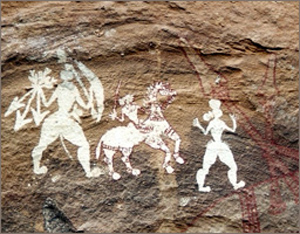
Soldiers
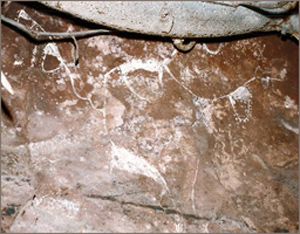
Bees Nest
Presently, the wall paintings in their houses, as in the great majority of rock paintings, are executed in red and yellow pigments prepared from hematite or other iron oxides. The white pigment was made from limestone or kaolin, while mixtures of pigment that produce pinks are also found used in paintings. The rock paintings were executed in a number of stylistic conventions. Some are only sketches or constructs of lines, while others are silhouettes filled with colours and embellished with decorative designs.
ANTIQUITY OF PACHMARHI INDIA
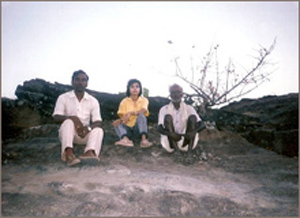
Dr Meenakshi Pathak with her team in the Pachmarhi Hills
Considerable information is now available about the antiquity of Pachmarhi from Archaeological sources. The excavation by archaeologists in different shelters has provided sufficient archaeological data of the people who occupied these shelters. Excavations were conducted in rock shelters since 1932 by GR Hunter. He introduced the cave art of Pachmarhi in his lecture before the congress of the pre-proto historic science in 1932, which brought the painted rock shelters of Pachmarhi Hills to the notice of Lt Col DH Gordon. Hunter excavated here in 1932 and 1934-35 (Hunter-1955).
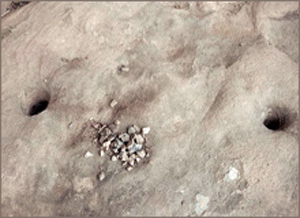
Cupules on Sand Stone
Clear evidence of Mesolithic culture has come from the Dorothy Deep shelter. The 1932 excavation was confined to the Nallah area, and a trial pit close to the rock wall up to 2’ and the 1934 excavation by a trial trench right across the breadth of the cave up to 5’ depth with undisturbed stratification. The earliest deposit was of the Mesolithic (Tardenoisian) period. The multiplicity of shapes and sizes, characteristic of most stone age cultures, suggests occupation prior to the Neolithic and the metal ages. Subsequently, the shelter was occupied by a culture using pottery. The excavator thought that though there was no sterile deposit between the two cultures, and quartz flakes were found in the upper layers where pottery abounds. It was doubtful if there was any overlap.
Three skeletons were found in association with the typical Tardenoisian flakes and implements but without any beads or other objects. Only two small pieces of cranium were found to be intact. Thus the following sequence has been worked out:
The excavation of 1935 followed the above sequence and attempted to establish the inference that the Palaeolithic man never inhabited the Mahadeo Hills. Divisible into three sub phases - upper, middle and lower. There was a definite cultural development during the Mesolithic age, in the technique of flaking, leading to the evolution of patterns more suited to the purpose. These tools are similar to those recovered from the Tardenoisian and Caspian sites in Europe and Africa (M.D. Khare 1984; 130). In 1950 A. Ghosh excavated Baniya Berry shelter where a trench of 22”X39” was dug and four layers were found. The lowest consisted of weathered sandstones and yielded no finds. Layer 3 - yellow brown soil mixed with stone chips, geometric microliths, pre pottery period. Layer 2 - of similar soil, also yielded geometric microliths. Layer 1 - top layer dark brown earth, no tools. This suggests the shelter was inhabited only during the Mesolithic period.
Then S K Pandey excavated two rock shelters in 1968. The first shelter was Jambu Dweep in which digging was barely 6 inches deep. It yielded small numbers both of microliths and pottery shreds. Another shelter, Baniya Berry, the excavation was in two distinct layers. The lower layer had loose sandy soil, with one large chalcedony piece, 2 Jasper flakes, 2 triangles and 28 chips. The upper layer of brown earth produced fluted cores and 4 parallel one-sided flakes. There was no pottery in this shelter.
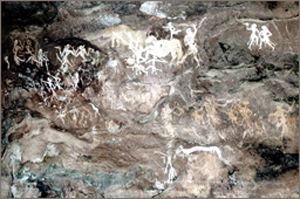
Complex Hunting/Battle Scene
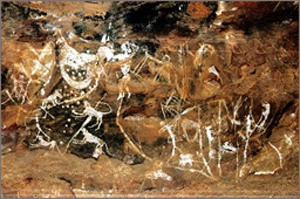
Panel with Figures & Monkeys
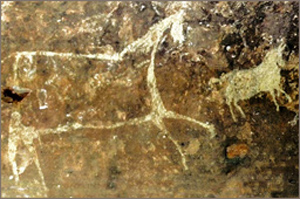
Depiction of Horses
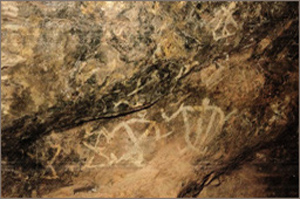
Triangular Figures
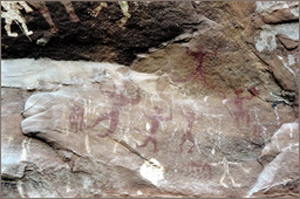
Dancing Figures
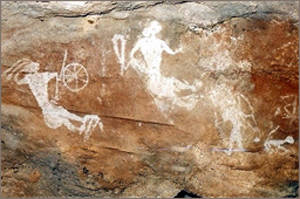
Dancing Figures
During my field research work in the year 1990-91, I collected some Mesolithic pottery shreds, a few tiny pieces of bone and a pendent of the tooth of an herbivorous animal (monkey) from the loose surface of the shelters. Total finding of microliths: Trapeze - 1, blades - 34, side scraper - 8, and burins - 2.
Mesolithic technology, introduced from outside, supplemented the older technology with the passage of time. It consists of Mesolithic tools made of slender micro blade, which were first detached from cylindrical cores by a pressure technique and then blunted on one or more margins. These tools, made of fine-grained rocks, lime, chert and chalcedony, comprise blunted back blades, obliquely truncated bladed, points, crescents triangles and trapezes. By hafting them into bone or wooden handles, these tiny tools were utilized to make knives, arrowheads, spear heads and sickles. Colour nodules are also found in the loose surface. Yellow colour nodules have been found in Bori shelter.
The gradual developments of changes can be seen in this area regarding the use of fire and construction of floors of stone slabs. In the later phases the appearance of copper tools and pottery suggests contact between the Mesolithic people of shelters and Chalcolithic people of the plains. In the upper most layers, early historic pottery shows the persistence of Mesolithic way of life up to the historic times.
ABORIGINALS
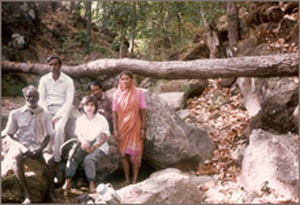
Dr Meenakshi Dubey-Pathak and the Research Team
The population of Pachmarhi is principally tribal. The main tribes are Korku and Gond. The four-sub caste of Korku is Muwasi, Bawaria, Ruma and Bondoya. The word Korku means simple men or ‘tribesmen’. (Koru meaning 'man' and ku its plural). According to Korku, traditions of their origin, on the request of Ravana, Lord Mahadeo created two images of a man and woman from the clay of an anthill. He then infused life into these figures and they were called ‘Mula’ and ‘Mulai’, with a common surnames Pathre. These two were the ancestors of the Korku tribe. Korku are a Munda or Colarian tribe as their language belongs to the Mundari of Austro-Asiatic family. The Gond tribes speak Gondi language. The Gonds also call themselves ‘Ravanvasi’, meaning descendants of Ravana king of Lanka. Their legends suggest that they have migrated to the area from Andhra in the medieval period, and they speak a Dravidian language called Gondi. The Korkus consider themselves superior to Gonds. They would not take food from Gonds, but would not refused water and chilam (cigar).
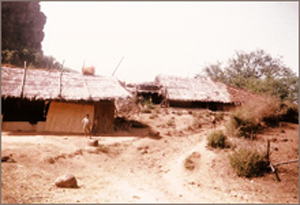
Tribal Village
The average Korkus are well built & muscular. They have a round face, a nose rather wide, prominent cheekbone, a scanty mustache and his head shaved after the Hindu fashion. They are slightly taller than Gond (Russel and Hiralal 1969 : 552). They make houses of wattle and daub and with roofs made of handmade, baked clay tiles. The locals generally sleep on the ground and a few low stools carved from teak wood serve them as pillows. There is generally a verandah in the front of the house, a cattle shed attached to the side. The villages are kept remarkably clean.The interior of the house in Korku village is kept clean. The walls are decorated with various designs drawn on festive occasion, and the villagers take delight in pasting coloured pictures on the interior walls of their hut for decoration. Every villager has a few pigs and fowls about and both of which are eaten after being sacrificed. They are by no means particular about what they eat, fowls, fish, crabs and tortoise all consumed. Bondoya korku eat buffaloes too. The millets (kodu - kutki) are grown principally in the hilly tracks of trivial inhabitant, which form the staple food. Tobacco smoking and country liquor made by the local mahua flower is very common among these aboriginals. They often supplement their food with a number of edible fruits, tubers and honey collected from the forest. The tribal economy depends on agriculture.
Like most hill tribes the korku are remarkably honest and truthful. Korku consider themselves to be Hindus, and are held to have a better claim to a place in the social structure of Hinduism than most of the other forest tribes. They worship the Sun, Moon and also Mahadeo. The main festivals among Korku tribe are Shivaratri and Nagapanchami. Pachmarhi is the important pilgrim center for Shivaratri and Nagapanchami fares. The priests of Korku are of two kinds: ‘Parihars’ and Bhumka’. The Pariahs may be any man who is visited with the divine afflatus or selected as a mouthpiece by the deity. Parihars are also rare, but every village has it Bhumka, who perform the regular sacrifices to the village gods and the special ones entailed by disease or other calamities. The Korku have some belief in sympathetic magic as other primitive people. They also trust in Omens.
Korku tribe also has funeral rites. The dead are usually buried, the head pointing to the south. The earth is mixed with thorns while being filled in so as to keep off hyenas and stones are placed over the grave. Their family members and relatives honor the dead with carved and decorated teak wood memorial boards, placed under a sacred tree in the memory of the deceased during a highly religious ceremony. The primitive men in Hoshangabad district used painting as the chief source of amusement. Pachmarhi and Adamgarh hillock is the living monument of their art. The times have changed and there is a variety of means of amusement available to the people now.
CONTEMPORARY TRIBAL ART OF PACHMARHI INDIA
In the remote mountains, deep dense forests, swamps and deserts the lives of hunters and gatherer remained almost undisturbed, long after more advanced cultures settled in the valleys and lowlands. The tribal people living in the rock shelters observed the colonizing groups and recorded their activities in paintings on the walls of their rock shelters. Later, they were to adopt from the newcomers only few basic cultural items. This is the most complete record, supported by the evidence of archaeological remains, of the tribal culture, as it existed in the past.
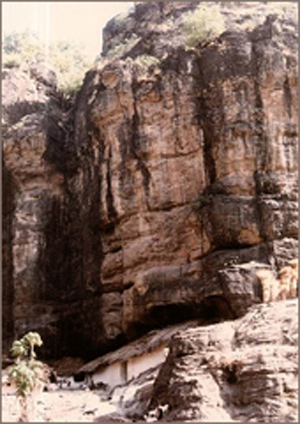
Huge Shelter Occupied by the Local Tribes
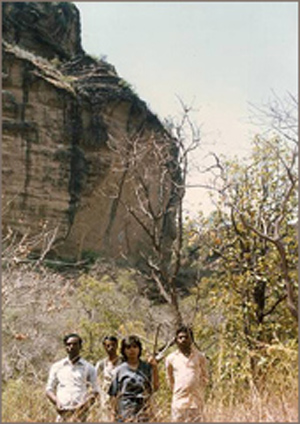
Dr Meenakshi Dubey-Pathak with Local Tribe near Shelter
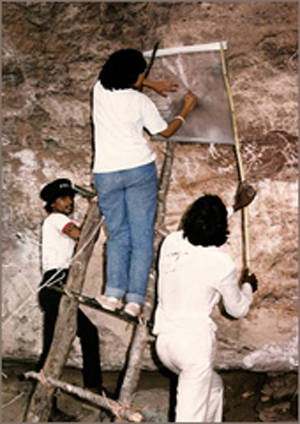
Tracing the Rock Art at the Nagdwari Cave
Over time the valley culture exerted greater influence on the tribal groups. They left the rock shelters and the painted record ceased. Although this occurred only a few hundred years ago, there exist only a few, more recent paintings, which may be linked to the earlier examples of rock art. The Korku honour their deceased members with carved and decorated teak wood memorial boards, which are placed under a sacred tree in their memories during the highly religious ceremony. This may last for seven to eight hours. During the ceremony the tribe females dance in a circle around the sacred mango tree. In between they hold the memorial board in their hands and dance.
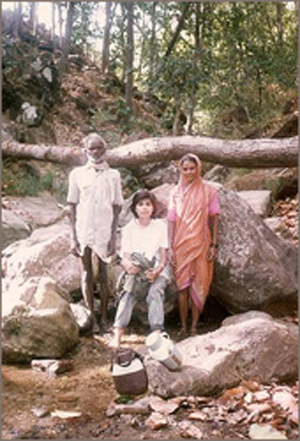
Dr Meenakshi Dubey-Pathak with Tribal Couple
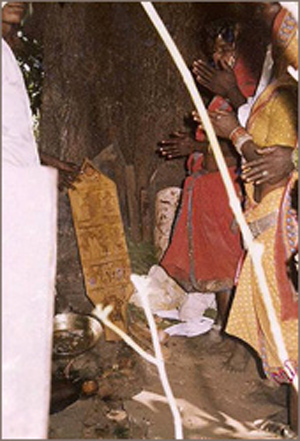
Memorial Board placed under a Sacred Tree
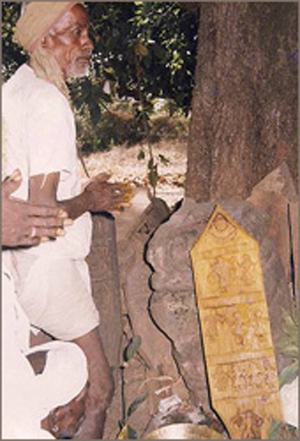
Memorial Board placed under a Sacred Tree
Following this the carved boards are venerated and wept over. Later, a goat or jungle fowl is sacrificed and eaten, while the local liquor made from the flowers of the Mahua tree (Bassia latifolia) is consumed. One such sacred tree is situated in the “Gond Baba Udhayan” (lit. - Garden of the Gond deity) located in the Pachmarhi town itself. Tribal people who come from the surrounding villages of Pachmarhi use this site for their religious rituals followed by feasts. Memorial boards are placed at the base of the sacred tree within ten years of a death. The subjects carved into the board are selected form a limited list of elements. These are usually horse riders; group of geometrical human figures holding hands, and representations of sun or moon and the name of the deceased.
In carvings of the horse and its rider the Korku do not depict their own ancestors, as they did not have horses. The figures mounted on horse represent their conquerors. This element of the carving is totally unrelated to the loves of the deceased, but its stylistic form and that of other human figures is similar to the more recent rock paintings situated in rock shelters only a few kilometers away (Wakankar and Brooks 1976: 16).
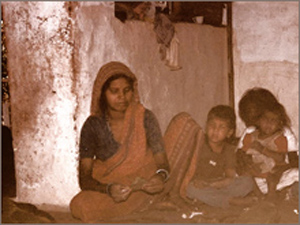
Women of the Tribe busy with their daily routine
Many of the present day tribal communities decorate the walls of their house with paintings. The selected subjects relate to their natural and cultural environments, depicting birds, floral patterns, whilst other appears to be of symbolic or ritual importance. These wall paintings also seem to have their roots in the rock art tradition. At present the Korku tribal live in wattle huts whose walls are coated by clay colored white. The tradition of paintings continues as the korku women decorated their house walls with paintings and sketches. They use local colour such as the dark or Indian red, yellow ochre, blue and white. The paintings are executed during the slack rainy season or occasionally during festival events. The women in the Korku society carry out all domestic work and look after the children.
The depiction of a peacock on the wall of a hut in the Kajri village situated 35 kilometers from Pachmarhi town is very similar to rock paintings found recently in the Langi Hill shelter . A symbol painted on the same repaired wall closely resembles a rock painting of the Swem Aam shelter that has only been recently explored. That the two traditions share the same roots can be seen in the common subject matter and the continuing stylistic conventions displayed by the contemporary art.
INDIAN ROCK ART : PACHMARHI THEMES
The subject matter in rock art can be very varied. The main subject everywhere is the animal or scenes of hunting them, which is the most common subject of rock paintings belonging to the Mesolithic and later periods. The subject matter of rock paintings also helps in studying many facets of human life. "The depictions of the species of animals, human and the food gatherers tell us much about the ecosystem in which they lived. The depiction of weapons, tools and other implements reveal their technical abilities. The illustration of his myths and beliefs bring back to our consciousness the essential aspects of out intellectual roots and displays the existential relationship between man, nature and the supernatural" (Anati-1980-20).
In the Indian rock paintings the presentation of man and animals is of almost the same standard although stylistically there are many differences (Mathpal 1980- 93). The artist did not represent everything he saw or knew. Besides animals and their hunters, there are other subjects depicted in rock art via social and cultural activities, ritual performances, domestic life and different images of women, such as mother with a child. In the early period human figures are rarely painted and the depiction is only symbolic and stick-shaped. Many human figures are conical animalized (Gordon 1960- 512), grotesque (Breuil and Lantier 1965- 187) and disproportionate (Bernguer 1973:40?45). In the rock paintings of Pachmarhi Hills prehistoric artists had depicted many cultural dimensions of their life and surroundings. Artists of early and later periods were greatly interested in the depiction of ritual dance and music. In the later period different types of musical instruments, battle scenes, soldiers, horse riders, symbols, patterns etc depicted them. The subject matter of the rock painting of Pachmarhi has been divided into the following categories: -
(a) Human forms. (b) Animal forms. (c) Scenes. (d) Material culture. (e) Mythology. (f) Nature. (g) Inscriptions.
HUMAN FORMS
Human beings are painted lesser realistically than the animals. There are total 2449 human forms belonging to all the periods in Pachmarhi. These forms have been divided into the following 30 sub-groups according to the subject matter: -
(a) Man. (b) Women. (c) Boy. (d) Girl. (e) Infant. (f) Hunter. (g) Fighter. (h) Rider. (i) Attendant. (j) Dancer. (k) Drummer. (l) Pipe Player. (m) Harp Player. (n) Cymbal Player. (o) Man with Mask. (p) Man with Kanvar. (q) Man with animal hide. (r) Women with sickle. (s) Man with axe or (Tree cutter). (t) Honey Collector. (u) Ritual performer. (v) Head Hunter. (w) Leader. (x) Mother Goddess. (y) Copulation. (z) Man in Hut. (aa) Anthropomorphic. (ab) Women engaged in domestic chores. (ac) Pregnant Women. (ae) Fragmented Figures.
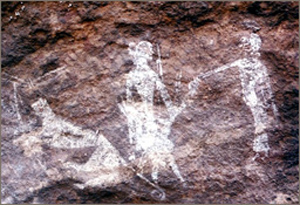
Figures with Tiger
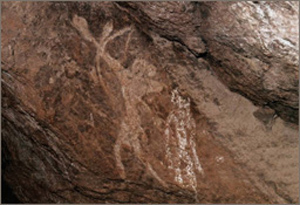
Archer
ANIMAL FORMS
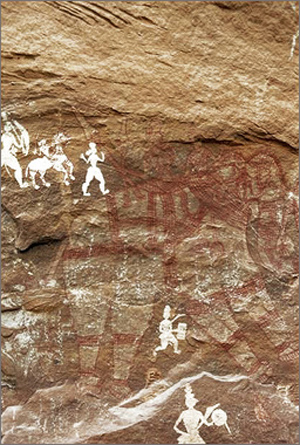
Elephant
Normally animal forms part of a hunting scene. A good number of the large or medium size animal’s figures have been painted naturalistically. The common most details are their horns, snout and ears. The animal drawings of early period are very natural and more realistic than those belonging to the later period. In the earliest period the animals were depicted in considerable size, beautifully decorated with abstract and geometric patterns. There are nearly 1008 images of animals belonging to 25 different species. These species comprise Tiger, Leopard, Elephant, Wild buffalos, Bison, Oxen, Cow, Nilgai, Sambhar, Swamp deer, Wild boar, hyena, wolf Dog, Monkey, Horse, Pangolin, crocodile and probably a giraffe like long necked animal. Drawing of Porcupine, Rabbit and small creatures like Lizard, Scorpion and Fish are also found. Drawings of birds such as jungle fowl, peafowl and some ostrich like unidentified birds are also recorded. Some depiction of insects like centipedes and honeybees has also been found.
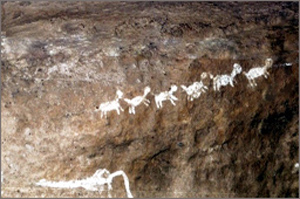
Goats
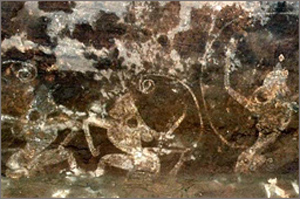
Monkeys
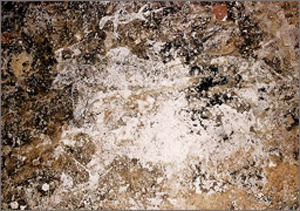
Bison with Lizard
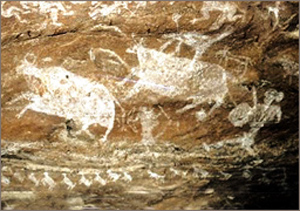
Row of Cows
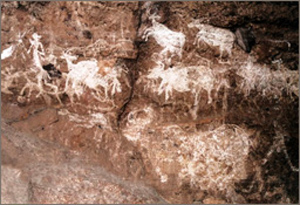
Ascetically Drawn Bison Panel
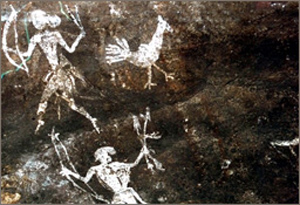
Hunters with Birds
• BIRDS
Total 37 drawings of a limited variety of birds have been found in various shelters in Pachmarhi Probably birds did not form major part of food but only an object of entertainment and curiosity in their surroundings and thus did not receive much significance in the lives of pre-historic men.
• MISCELLANEOUS
Different types of fish, turtles, scorpions, lizards, insects like centipede and honey bees have been depicted in different shelters.
Indian Rock Art - Prehistoric Paintings of the Pachmarhi Hills
by Dr. Meenakshi Dubey Pathak
Accessed: 3/18/21
NOTICE: THIS WORK MAY BE PROTECTED BY COPYRIGHT
YOU ARE REQUIRED TO READ THE COPYRIGHT NOTICE AT THIS LINK BEFORE YOU READ THE FOLLOWING WORK, THAT IS AVAILABLE SOLELY FOR PRIVATE STUDY, SCHOLARSHIP OR RESEARCH PURSUANT TO 17 U.S.C. SECTION 107 AND 108. IN THE EVENT THAT THE LIBRARY DETERMINES THAT UNLAWFUL COPYING OF THIS WORK HAS OCCURRED, THE LIBRARY HAS THE RIGHT TO BLOCK THE I.P. ADDRESS AT WHICH THE UNLAWFUL COPYING APPEARED TO HAVE OCCURRED. THANK YOU FOR RESPECTING THE RIGHTS OF COPYRIGHT OWNERS.
This is an account written and translated by Dr. Meenakshi Dubey Pathak, freelance artist and researcher in India, presented here as part of the Bradshaw Foundation India Rock Art Archive. Dr. Meenakshi Dubey Pathak is a member of the Rock Art Society of India (RASI), the Indian Society of Prehistory and Quaternary Studies and the Australian Rock Art Research Association (AURA), Australia. Dr. Dubey Pathak's extensive research not only brings to light the prehistoric rock art of India but it also highlights the drastic need for its preservation: "This wonderful and precious cultural heritage of ours is facing the danger of extinction by the unaware and uncivilized human beings and their vandalism. The agencies at work must put in a concerted effort to educate the people including the local tribes about the importance of these painted rock shelters and take steps to preserve them before its too late."
INTRODUCTION TO INDIA ROCK ART

Dr. Meenakshi Dubey Pathak - Gaddie. Rock Art Site in the Vindhachal Ranges
The earliest discovery of prehistoric rock art was made in India, twelve years before the discovery of Alta Mira in Spain. Archibald Carlleyle discovered rock paintings at Sohagihat in the Mirzapur district of Uttar Pradesh in 1867 and 1868. Unfortunately he did not publish. J Cockburn rightly commented that Carlleyle’s knowledge died with him (Smith, 1906: 187). Fortunately, Carlleyle had placed some of his notes with a friend, Reverend Regionald Gatty, and V A Smith published these later, which is the only record of his discovery of Rock paintings. In his note he wrote “Lying along with the small implements in undisturbed soil of the cave floors, pieces of a heavy red mineral-coloured matter called geru were frequently found, rubbed down on one or more facets, as if for making paint. Geru is evidently a partially decomposed hematite (Iron peroxide). “On the uneven sides or walls and roofs of many caves or rock shelters, there are rock paintings apparently of various ages. Though all evidently of great age, done in red colour called geru. Some of these rude paintings appeared to illustrate in a very stiff and archaic manner scenes in the life of the ancient stone chippers. Others represent animals or hunts of animals by men with bows and arrows, spears and hatchets. With regard to the probable age of these stone implements I may mention that I never found a single ground or polished implements not a single ground ring stone or hammer stone in the soil of the floors of any of the many caves or rock shelters I examined.” (Smith 1906: 187).

Painted Cave

Row of Cows
In 1881 Cockburn had found fossilised rhinoceros bones in the valley of the Ken River in the Mirzapur region as well as a painting of a rhinoceros hunted by three men in a shelter near Roap Village. In 1881 J Cockburn published an account of all his discoveries (J Cockburn 1891: 91). F Fawcett in the cave of Edakal in Kozhikode district of Kerala made the earliest discoveries of rock engravings (Fawcett F 1901: 402-21). A few years later A Silberrad published a pictorial description of the rock paintings in Banda district (Silberred 1970: 567-70). C W Anderson discovered a painted shelter of Singhanpur in the Raigarh district in Madhaya Pradesh (Anderson CW 1981: 298-306). More rock paintings were found later by F R Allchin 1963: 161) (Sundara A 1974: 21-32) and (K Paddayya 1968: 294-98) from the same area as well as the Gulberga district of Karnataka. Manoranjan Ghosh brought the Adamgarh group of painted rock shelters near Hoshangabad in Madhya Pradesh to light in 1932. The first example of rock engravings was discovered in 1933 by K P Jayaswal in a rock shelter at Vikramkhol in the Sambalpur District of Orrisa. (Jayaswal KP 1933: 58-60).

Dr V S Wakankar
As Dr Jean Clottes said, the ‘Father of Indian Rock Art’ and my (Guru) teacher Dr V S Wakankar had discovered several hundred painted shelters mainly in Central India, and attempted a broad survey of the rock paintings of the whole country and prepared a chronology of the paintings based on the content style and superimposition (Wakankar 1973: 251-353). The most important of his discoveries is Bhimbettka near Bhopal in Madhya Pradesh, which has one of the largest concentrations of rock paintings in India. Bright Allchin has published a study of prehistoric art in 1958. R K Verma in 1964, J Gupta 1967, S K Pandey 1961 and J Jacobson 1970 have also contributed to the discovery of Indian rock art. DH Gordon studied the rock paintings of Pachmarhi in the Mahadeo Hills in 1932. He wrote several papers in Indian and foreign journals and has summarised his views on Indian rock art in his book. (Gordon 1958: 98-17).

Dancers

Head Hunters
In recent years Yashodhar Mathpal and Erwin Neumayer have discovered a new group of ten painted shelters on Patni Ki Rahari hill near Bari on Bhopal Bareli road (Mathpal 1976 23: 28). In April 1981 to 1990, with the help of local tribes, I discovered fifteen painted rock shelters in the Pachmarhi Hills. In India over a thousand rock shelters containing paintings are situated in more than 150 sites. In India almost every state has rock art sites of painted shelters and engraved boulders.

Satpura Ranges India

Dr Meenakshi Pathak

Hunting Scene
Central India is the richest zone of prehistoric rock art in India. The highest concentration of rock art sites is situated in the Satpura, Vindhya and Kaimur Hills. These hills are formed of sandstones, which weather relatively faster to form rock shelters and caves. They are located in the dense forest and were ecologically ideal for occupation by primitives. They were used for habitation in the Stone Age and even in the later periods. Inside the caves on the walls and ceilings artists painted their favourite animals or human forms, symbols, daily life hunting and fighting.
INDIAN ROCK ART: PACHMARHI EXPLORED
The Pachmarhi Hills are situated in the geographical center of the Indian sub continent in the State of Madhya Pradesh. The hills lie in the Satpura Range, formed of the Gondwanaland sandstone belonging to the Gondwanaland series of the Talcher Group formations. The sandstone sequence is of the upper Gondwanaland formation. The sandstone is relatively friable and, on weathering, forms the sandy solid found at the foot of the hills. These hills form one of the most beautiful parts of the Satpura Range. The shelters are found all over the hills and the surrounding forests, in the foothills and riverbanks. Many shelters are covered with paintings made over centuries by early inhabitants depicting a wide range of subjects expressed by them in a variety of styles and left as great heritage for us to understand them and appreciate their unique contribution.

The Pachmarhi Hills

The Pachmarhi Hills
Captain J Forsyth made the discovery of this place, as a sanitarium. Forsyth was sent there in 1862 under the instructions of Sir Richard Temple, Commissioner of that day to explore this portion of the Satpura Forest. Here he built a forest lodge and named it “Bison Lodge”. His famous book “The Highlands of Central India” depicts the exquisite beauties of the Satpura range. The point from where Captain J. Forsyth forest glimpsed the extra ordinary sight of Pachmarhi is still one of the finest points named as “Forsyth point”. When he came to Pachmarhi, the area was occupied by the Korku jagirdar of Pachmarhi, but there were traces of a much older civilization in the shape of sites of ruined huts near “Handi kho” site. The total area of the plateau is about 60 sq kms including the forest area and 12.90 sq kms occupied by the Pachmarhi cantonment.
Part of Forsyth’s report states “Every where the massive group of trees and park like scenery strikes the eye and the greenery of glades and wild flowers, unseen at lower elevation, maintains the illusion that the scene is a bit out of our temperate zone. Thereafter, a multitude of beauty spots were discovered, and the place developed. Much remains the same even today. Pachmarhi still retains its tranquility, its many silences, its gentle green and its soothing forest. It is one place where solitude is miraculously achieved in moments, and the sighs of swaying trees are the only sounds you will hear. Pachmarhi is a lovely hill-girded plateau on the green Satpura range, called by the tourists as the Queen of Satpura." (M.P. Tourists 1962: 4).
By popular belief the name “Pachmarhi” is a derivation of “Pach-marhi” or a complex of five caves of the Pandava brothers, who are supposed to have spent a considerable portion of their lifetime of exile incognito in this area. Genuine place is attainable any where in “Pachmarhi”. Pachmarhi, the legend tells, was once a huge lake guarded by a monstrous serpent. This serpent began terrorizing the pilgrims visiting the sacred shrines of the Mahadeo hills. Lord Shiva, angered by this, hurled his trident at the snake, imprisoning him in the rift of a solid rock, which assumed the shape of a pot or handi. The flames of wrath dried up the lake and empty space assumed the shape of a saucer. Botanists have therefore reported the existence of plants only found by the sides of large expanses of water, these rare penmen of flora seem to bear out the myth! (M P Tourist 74:2).
The hills are thickly vegetated with rich floristic and faunal biota but quite widespread and difficult to access. The natural species represented in the rock art were of great economical importance, having food value for the shelter-dwellers and often form subjects of their painting. Rock paintings found within shelters here are the major sources of our understanding of how their creators related to their physical, biological and cultural environments. These people, as do their descendants at the present time, held beliefs and practices which expressed a direct or indirect relationship between their environment and themselves. Within this body of expression, the evolution of the art form, with the development of mankind over centuries, plays an important and multifaceted role.
GR Hunter brought the painted rock shelters of Pachmarhi Hills to the notice of D.H. Gordon (1958). Hunter had excavated some sites here in 1932 and again in 1934-35. The 1935 excavation revealed that the cultural sequence within this region commenced during the Mesolithic period, confirming that the Pachmarhi Hills were not occupied during the Palaeolithic. Thus, the rock paintings of this region belong to the Mesolithic and later periods. The Mesolithic paintings clearly depict a society of hunters and gatherers. Mainly they portray man and his relationship with animals. The subject matter of this period is quite varied, although game animals are most frequently represented. Bulls, bison, elephants, wild boars, deer, tigers, buffaloes, dogs, monkeys and crocodiles appear alongside smaller species such as rats, lizards, turtles and fishes. Some of the birds are identified as peacocks, jungle fowl and ostrich. Arthropods, such as scorpions and wild bees, were also depicted. The hunters are portrayed using spears, axes, sticks and bows and arrows.

Hunting Wild Buffalo

Stag Hunting
Female figures are occasionally shown. Sexual life does have a place in Mesolithic art but is not very prominent, and male and female union is rarely shown. It seems that dances were important for ceremonial or entertainment purposes during this period. For these dances headdresses and animal masks representing donkeys, crocodiles, bulls or monkeys were worn. The compositional elements of these Mesolithic paintings are highly developed. They represent an element of the creative spirit of the early people. That their aesthetic sense had developed to a high degree can be seen in geometric designs and in paintings of the X-ray style. Pregnant animals such as cow and deer depict the fetus in the womb. Most interesting depiction is a urinating cow. It suggests the awareness of medicinal value of cow urine to the primitives. As we all know according to Indian Ayurved cow urine is a very good treatment for cancer patients and for other ailments. Head Hunters are another interesting depiction . A variety of animals can be seen from elephants to ants.

Pregnant Animal with fetus in the Womb

Urinating Cow

X-Ray Style Rock Art Painting

X-Ray Style Rock Art Painting
In the Pachmarhi Hills most of the paintings are from the Chalcolithic to the Historical period. Conflict is one of the main themes depicted during this time. War scenes are common but reasons for conflict are not indicated. Horsemen armed with swords and shields overlie the earlier paintings portraying the life of hunters and gatherers. They bear elaborate war equipment consisting of spears, axes, swords, shields, daggers and bows and arrows. Other individuals carry drums and trumpets, and foot soldiers as well as men riding caparisoned horses and elephants are depicted. Goats, dogs, oxen, donkeys and performing monkeys accompany the troops. The descendants of the original hunters and gatherers and artists of this region are the tribal Korku and Gond who still uphold some of the traditions of their ancestors. In the rock paintings their ancestors are depicted dancing in pairs or in rows and playing musical instruments. They hunted animals and collected honey from the hives of wild bees. Their mode of dress was quite simple. The women carried food and water and looked after the children. The forebearers of the present day tribal people had a variety of ways to express the magic of their beliefs, rituals and taboos. The tribes living in these hills have wooden memorial boards on which the carved horse and its rider is similar to those painted by their predecessors in the past on the walls of their rock shelters . They also decorate the walls of their houses and this activity seems to have its roots in the cave dwelling traditions of their ancestors. Men and horses of geometric construction are randomly spaced across the walls. Such paintings are done during the rainy season and on festive occasions, and bear a close resemblance to those found in the painted shelters.

Soldiers

Bees Nest
Presently, the wall paintings in their houses, as in the great majority of rock paintings, are executed in red and yellow pigments prepared from hematite or other iron oxides. The white pigment was made from limestone or kaolin, while mixtures of pigment that produce pinks are also found used in paintings. The rock paintings were executed in a number of stylistic conventions. Some are only sketches or constructs of lines, while others are silhouettes filled with colours and embellished with decorative designs.
ANTIQUITY OF PACHMARHI INDIA

Dr Meenakshi Pathak with her team in the Pachmarhi Hills
Considerable information is now available about the antiquity of Pachmarhi from Archaeological sources. The excavation by archaeologists in different shelters has provided sufficient archaeological data of the people who occupied these shelters. Excavations were conducted in rock shelters since 1932 by GR Hunter. He introduced the cave art of Pachmarhi in his lecture before the congress of the pre-proto historic science in 1932, which brought the painted rock shelters of Pachmarhi Hills to the notice of Lt Col DH Gordon. Hunter excavated here in 1932 and 1934-35 (Hunter-1955).

Cupules on Sand Stone
Clear evidence of Mesolithic culture has come from the Dorothy Deep shelter. The 1932 excavation was confined to the Nallah area, and a trial pit close to the rock wall up to 2’ and the 1934 excavation by a trial trench right across the breadth of the cave up to 5’ depth with undisturbed stratification. The earliest deposit was of the Mesolithic (Tardenoisian) period. The multiplicity of shapes and sizes, characteristic of most stone age cultures, suggests occupation prior to the Neolithic and the metal ages. Subsequently, the shelter was occupied by a culture using pottery. The excavator thought that though there was no sterile deposit between the two cultures, and quartz flakes were found in the upper layers where pottery abounds. It was doubtful if there was any overlap.
Three skeletons were found in association with the typical Tardenoisian flakes and implements but without any beads or other objects. Only two small pieces of cranium were found to be intact. Thus the following sequence has been worked out:
(a) The lower levels yielded microliths of flint. The absence of metal and polished stone indicated that these people lived before metal age. The tools used were mostly crescents and scalene Triangles as well as drills and scrapers.
(b) With no sterile deposit, the Dorothy Deep shelter was inhabited by the pottery using people.
(c) Of the three skeletons recovered from the Mesolithic deposit, two belonged to children of 6-7 and 11 years of age, while the third was an adult. Evidence of a hard diet and the sign of flattening and bowing of the thighbone were discernible. The teeth of the eleven-year-old child showed great deal of wear. The adult was muscular, with small teeth and jaws. There is no evidence to show that racially he differed from the modern people of this region (Collection with British Museum, London).
The excavation of 1935 followed the above sequence and attempted to establish the inference that the Palaeolithic man never inhabited the Mahadeo Hills. Divisible into three sub phases - upper, middle and lower. There was a definite cultural development during the Mesolithic age, in the technique of flaking, leading to the evolution of patterns more suited to the purpose. These tools are similar to those recovered from the Tardenoisian and Caspian sites in Europe and Africa (M.D. Khare 1984; 130). In 1950 A. Ghosh excavated Baniya Berry shelter where a trench of 22”X39” was dug and four layers were found. The lowest consisted of weathered sandstones and yielded no finds. Layer 3 - yellow brown soil mixed with stone chips, geometric microliths, pre pottery period. Layer 2 - of similar soil, also yielded geometric microliths. Layer 1 - top layer dark brown earth, no tools. This suggests the shelter was inhabited only during the Mesolithic period.
Then S K Pandey excavated two rock shelters in 1968. The first shelter was Jambu Dweep in which digging was barely 6 inches deep. It yielded small numbers both of microliths and pottery shreds. Another shelter, Baniya Berry, the excavation was in two distinct layers. The lower layer had loose sandy soil, with one large chalcedony piece, 2 Jasper flakes, 2 triangles and 28 chips. The upper layer of brown earth produced fluted cores and 4 parallel one-sided flakes. There was no pottery in this shelter.

Complex Hunting/Battle Scene

Panel with Figures & Monkeys

Depiction of Horses

Triangular Figures

Dancing Figures

Dancing Figures
During my field research work in the year 1990-91, I collected some Mesolithic pottery shreds, a few tiny pieces of bone and a pendent of the tooth of an herbivorous animal (monkey) from the loose surface of the shelters. Total finding of microliths: Trapeze - 1, blades - 34, side scraper - 8, and burins - 2.
Mesolithic technology, introduced from outside, supplemented the older technology with the passage of time. It consists of Mesolithic tools made of slender micro blade, which were first detached from cylindrical cores by a pressure technique and then blunted on one or more margins. These tools, made of fine-grained rocks, lime, chert and chalcedony, comprise blunted back blades, obliquely truncated bladed, points, crescents triangles and trapezes. By hafting them into bone or wooden handles, these tiny tools were utilized to make knives, arrowheads, spear heads and sickles. Colour nodules are also found in the loose surface. Yellow colour nodules have been found in Bori shelter.
The gradual developments of changes can be seen in this area regarding the use of fire and construction of floors of stone slabs. In the later phases the appearance of copper tools and pottery suggests contact between the Mesolithic people of shelters and Chalcolithic people of the plains. In the upper most layers, early historic pottery shows the persistence of Mesolithic way of life up to the historic times.
ABORIGINALS

Dr Meenakshi Dubey-Pathak and the Research Team
The population of Pachmarhi is principally tribal. The main tribes are Korku and Gond. The four-sub caste of Korku is Muwasi, Bawaria, Ruma and Bondoya. The word Korku means simple men or ‘tribesmen’. (Koru meaning 'man' and ku its plural). According to Korku, traditions of their origin, on the request of Ravana, Lord Mahadeo created two images of a man and woman from the clay of an anthill. He then infused life into these figures and they were called ‘Mula’ and ‘Mulai’, with a common surnames Pathre. These two were the ancestors of the Korku tribe. Korku are a Munda or Colarian tribe as their language belongs to the Mundari of Austro-Asiatic family. The Gond tribes speak Gondi language. The Gonds also call themselves ‘Ravanvasi’, meaning descendants of Ravana king of Lanka. Their legends suggest that they have migrated to the area from Andhra in the medieval period, and they speak a Dravidian language called Gondi. The Korkus consider themselves superior to Gonds. They would not take food from Gonds, but would not refused water and chilam (cigar).

Tribal Village
The average Korkus are well built & muscular. They have a round face, a nose rather wide, prominent cheekbone, a scanty mustache and his head shaved after the Hindu fashion. They are slightly taller than Gond (Russel and Hiralal 1969 : 552). They make houses of wattle and daub and with roofs made of handmade, baked clay tiles. The locals generally sleep on the ground and a few low stools carved from teak wood serve them as pillows. There is generally a verandah in the front of the house, a cattle shed attached to the side. The villages are kept remarkably clean.The interior of the house in Korku village is kept clean. The walls are decorated with various designs drawn on festive occasion, and the villagers take delight in pasting coloured pictures on the interior walls of their hut for decoration. Every villager has a few pigs and fowls about and both of which are eaten after being sacrificed. They are by no means particular about what they eat, fowls, fish, crabs and tortoise all consumed. Bondoya korku eat buffaloes too. The millets (kodu - kutki) are grown principally in the hilly tracks of trivial inhabitant, which form the staple food. Tobacco smoking and country liquor made by the local mahua flower is very common among these aboriginals. They often supplement their food with a number of edible fruits, tubers and honey collected from the forest. The tribal economy depends on agriculture.
Like most hill tribes the korku are remarkably honest and truthful. Korku consider themselves to be Hindus, and are held to have a better claim to a place in the social structure of Hinduism than most of the other forest tribes. They worship the Sun, Moon and also Mahadeo. The main festivals among Korku tribe are Shivaratri and Nagapanchami. Pachmarhi is the important pilgrim center for Shivaratri and Nagapanchami fares. The priests of Korku are of two kinds: ‘Parihars’ and Bhumka’. The Pariahs may be any man who is visited with the divine afflatus or selected as a mouthpiece by the deity. Parihars are also rare, but every village has it Bhumka, who perform the regular sacrifices to the village gods and the special ones entailed by disease or other calamities. The Korku have some belief in sympathetic magic as other primitive people. They also trust in Omens.
Korku tribe also has funeral rites. The dead are usually buried, the head pointing to the south. The earth is mixed with thorns while being filled in so as to keep off hyenas and stones are placed over the grave. Their family members and relatives honor the dead with carved and decorated teak wood memorial boards, placed under a sacred tree in the memory of the deceased during a highly religious ceremony. The primitive men in Hoshangabad district used painting as the chief source of amusement. Pachmarhi and Adamgarh hillock is the living monument of their art. The times have changed and there is a variety of means of amusement available to the people now.
CONTEMPORARY TRIBAL ART OF PACHMARHI INDIA
In the remote mountains, deep dense forests, swamps and deserts the lives of hunters and gatherer remained almost undisturbed, long after more advanced cultures settled in the valleys and lowlands. The tribal people living in the rock shelters observed the colonizing groups and recorded their activities in paintings on the walls of their rock shelters. Later, they were to adopt from the newcomers only few basic cultural items. This is the most complete record, supported by the evidence of archaeological remains, of the tribal culture, as it existed in the past.

Huge Shelter Occupied by the Local Tribes

Dr Meenakshi Dubey-Pathak with Local Tribe near Shelter

Tracing the Rock Art at the Nagdwari Cave
Over time the valley culture exerted greater influence on the tribal groups. They left the rock shelters and the painted record ceased. Although this occurred only a few hundred years ago, there exist only a few, more recent paintings, which may be linked to the earlier examples of rock art. The Korku honour their deceased members with carved and decorated teak wood memorial boards, which are placed under a sacred tree in their memories during the highly religious ceremony. This may last for seven to eight hours. During the ceremony the tribe females dance in a circle around the sacred mango tree. In between they hold the memorial board in their hands and dance.

Dr Meenakshi Dubey-Pathak with Tribal Couple

Memorial Board placed under a Sacred Tree

Memorial Board placed under a Sacred Tree
Following this the carved boards are venerated and wept over. Later, a goat or jungle fowl is sacrificed and eaten, while the local liquor made from the flowers of the Mahua tree (Bassia latifolia) is consumed. One such sacred tree is situated in the “Gond Baba Udhayan” (lit. - Garden of the Gond deity) located in the Pachmarhi town itself. Tribal people who come from the surrounding villages of Pachmarhi use this site for their religious rituals followed by feasts. Memorial boards are placed at the base of the sacred tree within ten years of a death. The subjects carved into the board are selected form a limited list of elements. These are usually horse riders; group of geometrical human figures holding hands, and representations of sun or moon and the name of the deceased.
In carvings of the horse and its rider the Korku do not depict their own ancestors, as they did not have horses. The figures mounted on horse represent their conquerors. This element of the carving is totally unrelated to the loves of the deceased, but its stylistic form and that of other human figures is similar to the more recent rock paintings situated in rock shelters only a few kilometers away (Wakankar and Brooks 1976: 16).

Women of the Tribe busy with their daily routine
Many of the present day tribal communities decorate the walls of their house with paintings. The selected subjects relate to their natural and cultural environments, depicting birds, floral patterns, whilst other appears to be of symbolic or ritual importance. These wall paintings also seem to have their roots in the rock art tradition. At present the Korku tribal live in wattle huts whose walls are coated by clay colored white. The tradition of paintings continues as the korku women decorated their house walls with paintings and sketches. They use local colour such as the dark or Indian red, yellow ochre, blue and white. The paintings are executed during the slack rainy season or occasionally during festival events. The women in the Korku society carry out all domestic work and look after the children.
The depiction of a peacock on the wall of a hut in the Kajri village situated 35 kilometers from Pachmarhi town is very similar to rock paintings found recently in the Langi Hill shelter . A symbol painted on the same repaired wall closely resembles a rock painting of the Swem Aam shelter that has only been recently explored. That the two traditions share the same roots can be seen in the common subject matter and the continuing stylistic conventions displayed by the contemporary art.
INDIAN ROCK ART : PACHMARHI THEMES
The subject matter in rock art can be very varied. The main subject everywhere is the animal or scenes of hunting them, which is the most common subject of rock paintings belonging to the Mesolithic and later periods. The subject matter of rock paintings also helps in studying many facets of human life. "The depictions of the species of animals, human and the food gatherers tell us much about the ecosystem in which they lived. The depiction of weapons, tools and other implements reveal their technical abilities. The illustration of his myths and beliefs bring back to our consciousness the essential aspects of out intellectual roots and displays the existential relationship between man, nature and the supernatural" (Anati-1980-20).
In the Indian rock paintings the presentation of man and animals is of almost the same standard although stylistically there are many differences (Mathpal 1980- 93). The artist did not represent everything he saw or knew. Besides animals and their hunters, there are other subjects depicted in rock art via social and cultural activities, ritual performances, domestic life and different images of women, such as mother with a child. In the early period human figures are rarely painted and the depiction is only symbolic and stick-shaped. Many human figures are conical animalized (Gordon 1960- 512), grotesque (Breuil and Lantier 1965- 187) and disproportionate (Bernguer 1973:40?45). In the rock paintings of Pachmarhi Hills prehistoric artists had depicted many cultural dimensions of their life and surroundings. Artists of early and later periods were greatly interested in the depiction of ritual dance and music. In the later period different types of musical instruments, battle scenes, soldiers, horse riders, symbols, patterns etc depicted them. The subject matter of the rock painting of Pachmarhi has been divided into the following categories: -
(a) Human forms. (b) Animal forms. (c) Scenes. (d) Material culture. (e) Mythology. (f) Nature. (g) Inscriptions.
HUMAN FORMS
Human beings are painted lesser realistically than the animals. There are total 2449 human forms belonging to all the periods in Pachmarhi. These forms have been divided into the following 30 sub-groups according to the subject matter: -
(a) Man. (b) Women. (c) Boy. (d) Girl. (e) Infant. (f) Hunter. (g) Fighter. (h) Rider. (i) Attendant. (j) Dancer. (k) Drummer. (l) Pipe Player. (m) Harp Player. (n) Cymbal Player. (o) Man with Mask. (p) Man with Kanvar. (q) Man with animal hide. (r) Women with sickle. (s) Man with axe or (Tree cutter). (t) Honey Collector. (u) Ritual performer. (v) Head Hunter. (w) Leader. (x) Mother Goddess. (y) Copulation. (z) Man in Hut. (aa) Anthropomorphic. (ab) Women engaged in domestic chores. (ac) Pregnant Women. (ae) Fragmented Figures.

Figures with Tiger

Archer
ANIMAL FORMS

Elephant
Normally animal forms part of a hunting scene. A good number of the large or medium size animal’s figures have been painted naturalistically. The common most details are their horns, snout and ears. The animal drawings of early period are very natural and more realistic than those belonging to the later period. In the earliest period the animals were depicted in considerable size, beautifully decorated with abstract and geometric patterns. There are nearly 1008 images of animals belonging to 25 different species. These species comprise Tiger, Leopard, Elephant, Wild buffalos, Bison, Oxen, Cow, Nilgai, Sambhar, Swamp deer, Wild boar, hyena, wolf Dog, Monkey, Horse, Pangolin, crocodile and probably a giraffe like long necked animal. Drawing of Porcupine, Rabbit and small creatures like Lizard, Scorpion and Fish are also found. Drawings of birds such as jungle fowl, peafowl and some ostrich like unidentified birds are also recorded. Some depiction of insects like centipedes and honeybees has also been found.

Goats

Monkeys

Bison with Lizard

Row of Cows

Ascetically Drawn Bison Panel

Hunters with Birds
• BIRDS
Total 37 drawings of a limited variety of birds have been found in various shelters in Pachmarhi Probably birds did not form major part of food but only an object of entertainment and curiosity in their surroundings and thus did not receive much significance in the lives of pre-historic men.
• MISCELLANEOUS
Different types of fish, turtles, scorpions, lizards, insects like centipede and honey bees have been depicted in different shelters.
- admin
- Site Admin
- Posts: 36135
- Joined: Thu Aug 01, 2013 5:21 am
Re: Freda Bedi Cont'd (#3)
Part 2 of 2
INDIAN ROCK ART : PACHMARHI THEMES
SCENES
Prehistoric artists have drawn all aspects of their life independently and complete in it. The artists depicted various compositions on the rock surface. Such compositions usually comprise scenes of hunting, food gathering, fighting, dancing, and music, social and daily chores.
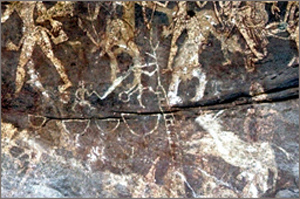
Tree Ladder Scene
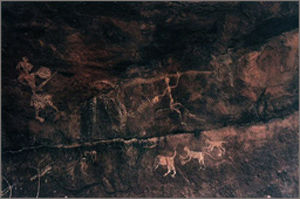
Figures with Monkeys
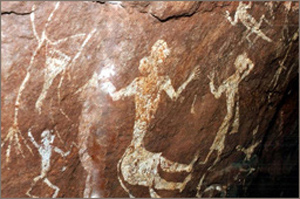
Dancers
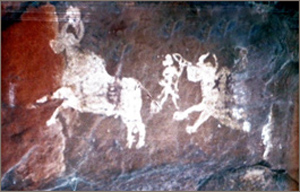
Dancing Figures and Animals
MATERIAL CULTURE - HEAD HUNTING SCENES
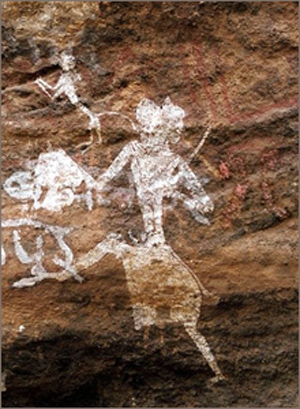
Headhunter
The subject of head hunting in the history of rock art is very uncommon. At present, in Indian rock painting its only the rock art of Pachmarhi which contain this unique depiction of head hunting. Peru in South America is the only other so far known place where scenes of head hunting are found (Bednarick 1989:73).
There are a total of seven depictions of headhunters, which have been first recorded by me. Executed in bichrome colour, these depictions belong to the historic period. The acts in these scenes depict the brutality prevalent in the society of the Stone Age man. The head hunting scene is very prominent in Lanji Hill shelter wherein a human figure is holding a human head in his right hand and shown running, yet looking back over his shoulder, perhaps anticipating a chase or ensuring himself of breaking contact with his enemy. A giant and robust figure measuring 3 ft in length and 2.5 ft in width executed in light red colour has been depicted which makes everyone curious . A headhunter with identical description as stated above, has been recorded at Swem Aam shelter.
In yet another depiction at Nagdwari shelter a headhunter decorated in red lines, perhaps his tattoo marks, has been shown carrying a well-dressed severed head . At Rajat Prapat shelter four human figures have been depicted as headhunters running in the same direction but at different distances. Drawn rhythmically and full of action, this scene is eye catching and gives an insight into the historic life.
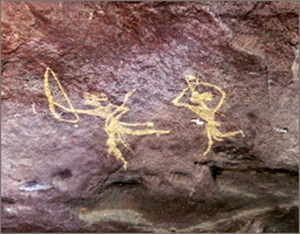
Headhunters Running
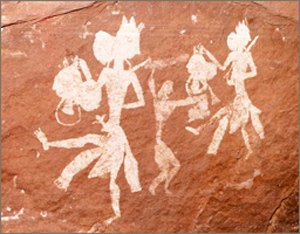
Headhunters
Remarkably, all the drawings of headhunters are filled with white colour and outlined with red colour. The figures have sharp facial features and body proportionate. Headhunters were probably most respected perhaps because they ensured protection of the clan, group or community and achieved victory over their enemies. Hence, the figures of headhunters are often found well decorated with headdress, crown, earrings and bodies covered from waist downwards up to the knees. Every figure holds a severed head, which is well decorated with crown, earrings, headdress identical to its hunter, running in the same direction and same of fashion looking back over the shoulder. The act of beheading human beings was perhaps not a ritual as nowhere in the shelters any such scene has been depicted. It may be assumed considering the prevalent brutality that beheading may be a form of severe punishment to those who committed a heinous crime of transgressing the law of the land of the tribes. However, it is quite likely that the head of the enemy was severed to ensure annihilation and carried back home to confirm victory to own ground, clan etc. and displayed as a war trophy.
Indian history is replete with the instances of human sacrifice prevalent amongst the tribes in the country, particularly, by Gond and Korku tribes. The tradition of human sacrifice was alive in Mahadeo Hill. “In the days that are forgotten, human victims hurled themselves over the rock as sacrifice to the goddess Kali and Kal Bhairav, the consort and son of Shiva, the destroyer”. Capt J Forsyth has mentioned about an eyewitness account of an incident of human sacrifice at Mahadeo Hills in his famous book “The Highlands of Central India” (Forsyth J 1889:180-184).
MYTHOLOGICAL SCENES
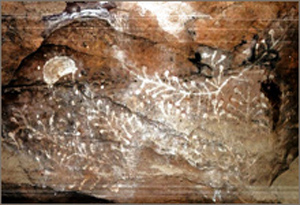
Tree Symbol Worship
The rock art suggestive of mythological origin is that of tree worship, cross worship, symbols of mother Goddess and demons. Gordon has commented that only a few Indian rock art paintings have a religious significance (Gordon 1958:109). “Symbols and so called signs found in rock paintings in different parts of the world are difficult to decipher. It is a code we have been unable to crack”, says Benerguer referring to European Ice Age symbols (Benerguer 1973:73). The paintings of Pachmarhi, which are likely to be related to mythology, have been grouped as follows:
1. Mother Goddess 2. Tree Worship 3. Symbol 4. Cross Worship 5. Swastika 6. Labyrinth (chakra) 7. Geometrical figures 8. Superhuman or deity worship 9. Demons 10. Mythical Animals
INSCRIPTIONS
Writing of inscriptions on the walls of the caves and shelters is associated with Hermits and Monks living in isolation in early historic times. It was common practice in many hills and forest area inhabited by Hermits. These inscriptions do help us place paintings of historic period to certain chronological order. Two inscriptions both in Nagri script in Pachmarhi have been recorded. One is in Dorothy Deep and the other is in Mahadeo shelter. The inscriptions in Mahadeo are too faded to be translated but the inscriptions at Dorothy Deep are by far the most legible. It consists of two lines written in cremish white colour. The first line is obviously meant to be same as commencement of much longer second like. It would appear to be from Nagri of probably 11th to 12th centuries. The translation, which does not make any sense, is as follows: "Lenamasiya a vri vri Dha Dha Ve She Jai Jai".
INDIAN ROCK ART : ANALYTICAL STUDY
The Stone Age man has painted many aspects regarding the social, cultural, economical, religious and ritualistic, pertaining to his life on the bare and uneven rock surface. The surfaces in the caves and shelters have been formed naturally over a period of time. The depictions of contemporary flora fauna and domestic activities have also found their places in these paintings. The antiquity of these unique paintings was probably realised first time by Archibald and Carlleyle in 1867-68 when they discovered the first rock paintings in India at Sohagighat in Uttar Pradesh. Mainly amateurs have brought approximately 150 sites of the rock paintings to our attention. The archeologists never seem to appreciate the antiquity of these paintings. Hence due to lack of attention, this national heritage of our country is now subjected to vandalism. It is pathetic to see at some places where those paintings are near extinction due to lack of protective measures. The shelters in Pachmarhi are well known from tourist and archaeological points of view. But their historic, cultural, artistic, musical and dimensional aspects have been left uncovered totally by most of the researchers known to have worked here. Unlike in Bhimbetka, there are numerous shelters and painted shelters scattered all over the Pachmarhi Hills. The approaches to many shelters are difficult, dangerous and time consuming.
Considering Pachmarhi town as the hub there is hardly any direction where the paintings are not evident. The painted shelters are also found in the outer periphery of the Pachmarhi Hills in the Satpura ranges. The study of these shelters has not been done in my work; however, some references of these have been made here and there. I feel a separate study in a different time frame is needed for the detail study of such paintings. Therefore, I have confined my study to the painted rock shelters of Pachmarhi Hills only. I am hopeful that this work will be an authentic record of the paintings of Pachmarhi hills for the students of the rock art in the future. The present study is the first comprehensive and exhaustive record encompassing thematic and stylistic analysis of the rock paintings of Pachmarhi Hills.
METHODOLOGY
The freehand drawings of the rock painting are the most popular method amongst the Indian scholars. But these kinds of drawings or copies can never be accurate and authentic, hence unsuitable for a scientific study. Such reproductions do not provide us the actual size of the form and scale for reduction or enlargements. Even a line drawing made in this way (reproduction without the colour scheme) cannot do justice to a coloured figure drawn on the shelter. Only a few drawings have been recorded to show the details of their features and ornaments etc. Photography is also a very common method for recording the rock paintings. It is an authentic and trustworthy method. The scholars like Leroi Gourhan (1968) have used basically coloured photographic reproduction of South Western European Cave paintings. Marshack (1975:64-89) has also used the special technique of extra close-up, ultra violet and infrared photography for his work. The photography has not been able to avoid the scratching and writing by vandals on the paintings. Many of the paintings are faded to varying degrees because of their age and prolonged exposure to the natural agencies. Therefore such paintings cannot be reproduced satisfactorily by photography. (Mathpal 1984 :4) Brooks (1975 : 92 :97) has evolved another process of reproducing Indian rock paintings. He first prepares a coloured transparency of the original paintings and makes a line drawing from it by projecting the transparency on the paper. After filling the drawing with colours he prepares a fresh transparency by superimposing the projection of the earlier transparency on the coloured drawing.
Today, the method for the reproduction of the rock painting followed is the combination of three means, tracing for dimensions, photography for colour effect and video recording. Tracing method applied by me to reproduce the rock paintings of Pachmarhi hills is not new. Nearly all the art of the Ice Age as well as the later period in Europe and Africa has been reproduced by this method (Cooks, 1961: 61-65, Vinicombe, 1966: 559 - 60). In India also J Cockburn, Manoranjan Ghosh, D.H. Gordon, V.S. Wakankar and Y Mathpal have employed the direct tracing method. In this method, the figure on the rock surface was first traced on fine transparent sheet. The reverse of the tracing paper was then rubbed with a lead Pencil to serve as carbon paper. The traced drawing was then transferred on the drawing paper. The figure on drawing paper was carefully compared with the original paintings on the rock surface to eliminate errors caused in tracing due to the uneven and rough surface of the rock. The drawing was than coloured on the spot continuously observing the tones and the shades of the original. The natural background of the painting was also reproduced in the same way. This method has been followed only in some paintings of the rock shelters, which are easily approachable and located nearer the town. The area of Pachmarhi hills is still one of the most inaccessible parts of India (Wakankar and Brooks 1975: 103). Shelters are spread all over in the dense forest. The shelters are 10 to 30 kms away from the town. This process was not found practicable at every place because the nature of terrain, constraint of the time and danger of the wild life.
The author has done the maximum recording of the rock paintings by the photography method using both coloured films and transparencies. This gives accurate sizes and originality of colours. Infact about the colours you cannot say the present colour tone is as original as it was about ten thousand years ago. Because of the natural weathering paintings are getting faded gradually and they are loosing their original colour and shades. On one hand the size and drawing of figure can certainly be correct and original but on the other one cannot say about the exact tone of their original colours from these photographs. Third method is video recording of some rock paintings of Pachmarhi area. It is so because day-by-day natural weathering and vandalism are damaging these paintings. Thus this is the best process to record the painting with there natural surroundings. All forms and compositions of Pachmarhi Hills have been copied in different methods. During the survey the figures and scenes have been counted at each shelter starting from left to right and from top to bottom. As many of the paintings are damaged and faded by natural agencies and vadalised by ignorant tourist, it is essential to have a factual record of them for the posterity.
The paintings have been analysed under the seven main categories:
(a) Human forms, (b) Animal forms, (c) Scenes, (d) Material culture, (e) Mythology, (f) Nature, (g) Inscriptions
Forms and scenes are studied according to their colour, style, size, technique, period and shelter. Description and analysis of subject matter is the main theme of the thesis. Next is the colour pigments and technology employed in the creation of paintings and finally, chronology, comparative study, motivation behind the art; the aesthetic aspects forms and styles are discussed. The present study is based on data collected from Pachmarhi hills over a period of five years during the suitable weather conditions. Consequently, the sole endeavour throughout the research work by the author has been to carry out an analytical study of the paintings, paying due attention to the above discussed aspects.
The artists painted at considerable heights, standing on ladders or branches of the nearby trees, which existed then near the shelters. Painted walls have been used several times by the painters of later periods, without removing the older paintings. These overlapped or superimposed paintings of different colours; styles and periods may be seen in the many shelters of Pachmarhi.
TECHNIQUES OF PAINTING
Four techniques have been used in the creation of Indian rock paintings. These are wet transparent colour (water colour painting), wet opaque colour (Oil or tempera), crayon (dry colour painting) and stencil (Spray colour painting). The transparent and opaque colour techniques are more common in rock paintings than the stencil technique, which is generally restricted to the execution of negative handprints (Mathpal 1984: 185). The only example of a stencil drawing is mentioned by Gordon from Kabra Pahar in Raigarh area of Madhaya Pradesh (Gordon 1959: 12). The techniques of paintings are not so complicated. Every artist should have either used wet colour or dry colours paste but drawings by means other than colour are also recorded on rock surfaces. These include engraving, carvings and brushings. Except for the stencil techniques, other techniques have been commonly used in the execution of paintings at Pachmarhi. In addition to the paintings, rock engravings are also found in Pachmarhi. The shelters at Rajat Prapat shelter bears a very few designs of symbols filled with white colour, and Astachal shelter also has an engraved horse rider. Only the earlier period paintings are found executed in wet transparent colour technique. Colours are greatly diluted in water; only red and white were applied as transparent. Later period paintings are executed in what is now known as non-transparent, opaque and crayon techniques. Only two inscriptions engraved on the rock surface have been found at Pachmarhi.
INDIAN ROCK ART: STYLE
The style is different from the technique. The word 'technique' represents the early evolutionary stage of the paintings where as the word 'style' denotes the experimental conditions. It represents the comprehensive and mature stage of the compromise. The conflicting claims in painting of symbolism and representation are very much like the conflicting claims in life of body and soul. And just as the finest forms of life are neither the extreme of hedonism on the one hand nor of asceticism on the other. Both symbolism and representation are easy enough to be described in words. It is a phenomenon that can be readily grasped by the mind (Newton 1945 : 22).
The main qualities of rock paintings which have attracted scholars and artists are the representation of figures including styles, pose and posture, composition, action, movement and different size of forms. Scholars like Breuil (Breuil? 1952 : 32-42) Burkitt (1923 : 187), Kuhn (1958 : 55, 58), Pericot (1961 :201 ? 2), Gordon (1958 : 99 ? 108), Pandey (19975 : 34), Wakankar and Brooks (1976 : 96 ? 103) and Mathpal (1984 : 171) have noticed continuous development in styles of execution. Leroi Gourhan has interpreted all the animal and human forms and abstract symbols on a well determined scheme of four styles on the assumption that in the absence of stratigraphic evidence, style alone can be the base of dating. But again he says, if we attempted this then any formless drawing, of any epoch, would be presumably Aurignacian (1968 : 44).
The style is the basic criterion to establish the chronology and decide the series, but the style alone cannot decide the chronology. We have noticed at Pachmarhi several ways of executing figures of a single period and even in a single composition. In every following composition each new figure varies from the others. Thus if all details of outline, colour filling, decoration and unpainted inner spaces on animal bodies were to be taken into account, the number of styles to emerge would be virtually limitless and therefore of no analytical value. The other factors also contribute in the classification for this purpose; the help of super-imposition and other aspects are necessary.
"The Mahadeo hill paintings have a whole array of stylistic peculiarities which do not appear in other rock paintings but which can be found in some periods of early Historic art and even in recent folk arts. An eye-catching peculiarity is the treatment of facial features. Rock painters all over India drew heads in profile. This convention was followed in the Mahadeo hills but both the eyes are usually indicated. In some paintings both eyes are placed on the visible half of the face, in others the second eye (invisible in a profile) is placed out side the profile line. The bodies of humans are always shown frontally and the legs and feets in profile" (Neumyer E, 1985; 22).
NATURALISTIC
Generally there were several types of drawings. Though we find both human and animal forms in this first style. But the realism or naturalism has been observed only in animal drawings. The technique adopted is potraying the animals in a freehand wash, no outline was drawn but the figure was completed with wash only. But in many cases, first the outline was completed and than the body was filled, either by a wash of light red or white or by different geometrical patterns. In some cases drawing was completed by a thin white wash and then the details of outlines and strips were finished with brighter white line. In this case the wash outline is so perfect that it gives a naturalistic look of the animal.
REPRESENTATIONAL
The human forms associate with the representational style are simple and without any skill. The figures are either in outline or in silhouette having the formation of square. The torso of the outline figures is decorated with straight, zigzag or horizontal lines. They have been adorned with peculiar headdresses. The figures are shown equipped with stick like objects. The overall picture gives the impression of a hunting society (plate148-). The considerable change in the human forms is also witnessed. There are divergent views regarding the origin of human forms. According to Gordon the human depiction begins with square shape which was followed by stick shape. He further elaborates that where ever square forms are found associated with stick forms, they represent transition. Henceforth, we get major development in huma drawing in stick shape and square shape. According to Wakankar the conception of human drawing beings with the portrayal of stick shape man and square shape style followed it.
In many places square shape figures are found associated with stick shape figures which on their part are equipped with bows and arrows. “At Pachmarhi the figures of both the series are shown together. The earliest human figures drawn in the picture are in square shape. The largest number of these paintings have been depicted in Pachmarhi area and at other places. However, their number is very limited. The square shape human figures have been located so far at Sighanpur, Kabra Pahad, Pachmarhi, Sagar, Khawai, Bhopal and Mandideep areas. These figures are either armed with wooden sticks or bare handed” (Panday S. K., 1975 : 93). Arrows are always fixed with microliths. These figures represent male hunters. However, at Pachmarhi some such figures do represent female form too. In the perspective drawings some time children are also shown associated with the group.
[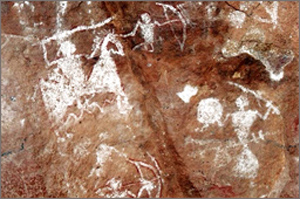 x]
x]
Hunters with Bows
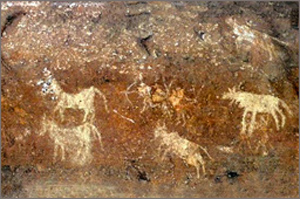
Hunting Scene
There are numerous variations among square forms. Sometime squares are filled with curvilinear liners. The hands are shown raised up, legs stretched and the head is triangular in shape. Sometime torso is decorated with linear or intricate patterns, while the limbs are shown only in stick forms. The figures are shown generally bare handed, though sticks, bows and arrows are occasionally represented. These paintings are executed in monochrome (dark red or burnt sienna) and bichrome (red and white or creamish yellow). These paintings are shown with breasts, which clearly indicate their feminity. This style has been termed as representational, the naturalism continued in case of animal figures and representational style was adopted for human figures. The earlier animal figures follow the simple decoration but gradually the complicated designs in the form of intricate patterns dominate the paintings. Gradually, this style indicates advancement in the cultural complex of the painters. His perception was gradually developing and he was leading towards the consciousness of his surroundings. Since his experiences were transferred into visual art, he started portraying the narrative groupings.
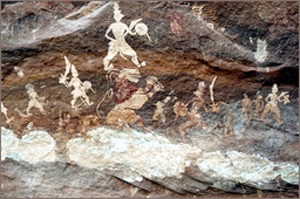
Lion Mask
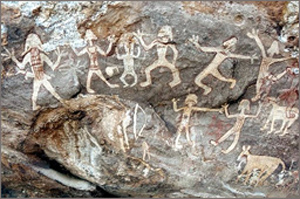
Soldiers Celebrate Victory
We get several modifications in stick like forms. The change can be detected in case of head dresses. Torso, though continued, but double or triple lined, as well as the triangular forms of torso also started. Another two more new elements were added to this style. The artists replaced the head with the animal masks. The purpose of the masks was to camoflauge the hunter during the course of hunting and identifying oneself with the totemic deity during the ceremonial dances. The second element has been found in case of animal figures in the form of X-ray drawings. The artist was well versed with the anatomy of the animals. Gradually, he started giving the anatomical details of the animals. He successfully depicted the naturalism in the animal drawings. Instead of depicting the individual animals, the paintings of heards were attempted. Artist has also attempted narrative groupings by depicting family groups engaged in different activities. Not only that even he painted the picture of man-eater tiger in different stages.
SYMBOLIC
A radical change is also marked in the paintings. The convertionalised forms gradually replaced the stick shape human figures. The decoration in case of animal figures was also changed. Afterwards, we get the domination of geometrical forms. We observed many human forms in triangular and rectangular shapes, engaged in different activities. Dancing, fighting and running, horse riders are also found executed in symbolic style. Artists have depicted them in various techniques, and monochrome and bichrome colours. The different religious symbols such as moon, sun, cross, swastika and tree worship are also depicted in the same style. This style is the most impressive manifestation of the intellectual level and represents the great majority of prehistoric art sites of painted or engrave geometric or symbolic figures.
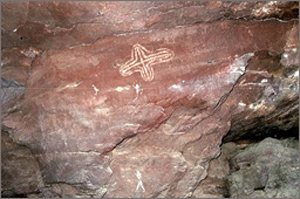
Cross Symbol
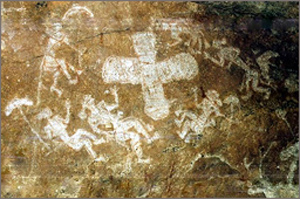
Cross Symbol
INDIAN ROCK ART: DATING THE STYLES
The chronology of the rock paintings is based on the subject matter or cultural content, superimpositions, styles and archaeological findings from the painted rock shelters. The chronological study of Indian rock paintings begins with the work of Col D H Gordon, who devoted much of his time to the study, but only 217 figures from the large shelters of Pachmarhi Hills. He classified them in four series. The first of the series was compared with those of Singhanpur and Kabra Pahar. The second one was confined to Mahadeo hills. The third was mainly from the area around Pachmarhi and could be compared with the Ellora group. He compared the paintings of Jhalai with those of Ajanta. This, of course, was put in a time bracket of about 6th century A.D. The fourth series was compared with the early medieval sculpture, dating between 9th and 13th century A.D. Each series has an early and late phase. He examined this sequence with reference to drawing in 13 more shelters in and around Pachmarhi. According to him a geometric human figure (with rectangular bodies filled in wavy lines and triangular heads) (Series IA) and stick shaped figures (IB) are older than crude figures of hunters (2A and B). Series 3A comprises both geometric figures and crude silhouettes. Series 3A has the most natural animals silhouettes. In the paintings of series 4A and 4B, horse riders and fighters are grouped. In earlier writings he has also mentioned animals of the fifth series executed in greenish yellow. But unfortunately, Gordon's chronology does not clarify his various series. He also did not give a summarized chart with details of features of each of his series.
R K Verma has classified the rock paintings of the Mirzapur area according to style, into four main series, with three subdivisions of Series-II. He has considered the silhouetted drawings of animals as the oldest. The animal figures in Series IIA are either outlined or have partially filled in limbs, while in series IIB natural silhouettes of animal and horse riders are grouped. The scene of elephant trapping at Lithuania-II is assigned to Series IIB. Drawings of Series-IIC comprise crude, outlined figures of hunters. Symbolic and geometric signs characterise paintings of Series III. In the paintings of Series IV crude figures of animals are included. Jagdish Gupta has also classified the rock paintings in 1967 on published material. S K Pandey has classified the rock paintings of Betwa region in 1969. Wakankar, who has discovered the largest number of rock paintings in India, has prepared several chronologies of Indian rock art between 1973 and 1976. Wakankar has classified the entire rock art of India into five periods and 20 styles:
Summary of paintings styles, according to Wakankar in 1976:
However, the efforts of Wakankar (1978), Gordon (1958), Verma (1964), SK Pandey (1969) and Mathpal (1984), who have been able to put forward minimum workable criteria and guidelines for choronological interpretations, are well perceived.
There are only three periods reflected in the rock paintings of Pachmarhi. One - scenes of a society of hunters and food gatherers, which can be called Prehistoric period (Mesolithic). Two - scenes of using chariots, huts, agriculture, pottery and domestic animals, which can be termed Protohistoric period (Neo/Chalcolithic). Three - scenes of fighters, riders and the use of metallic weapons, which undoubtedly, belong to the historic period.
(a) Prehistoric period - Mesolithic, Late Mesolithic.
(b) Protohistoric period ? Neolithic/Chalcolithic, Late Chalcolithic.
(c) Historic period - Historic, Late Historic.
CONCLUSION
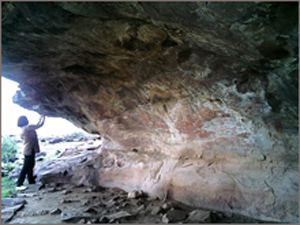
Dr Meenakshi Pathak Records Rock Art in the Pachmarhi Hills
Pachmarhi is a small township on a plateau located in the folds of the Satpura ranges in Central India. It is 210 kms from Bhopal and 52 kms from Pipariya. Pipariya is the nearest railway station on the Bombay-Howrah mainline via Jabalpur. The hills of Pachmarhi have a complex of rock shelters, very difficult to count. More than 55 shelters have been surveyed here and there still be many more to discover. The reason as to why most of India's rock art is in Central India is geological. The Satpura and Vindhayan ranges consist of soft sand stone, which over millions of years, has weathered into hills containing overhanging rocks and cliffs and caves of many shapes and sizes. From early prehistoric times till a few centuries ago these provided shelters for humankind. The archaeological excavations particularly at Jambu Dweap in the past have proved that the early Stone Age man occupied these shelters. Numerous microliths have been found at the shelters in the Bari Aam area. Most interesting findings for me was a pendant made of the tooth of an herbivorous animal probably a monkey, and yellow ochre coloured nodules at the shelter in Bori area.
The location of Pachmarhi from the ecological point of view is such that it meets the basic needs of human beings to survive - food, (in the form of animals and vegetables) water and shelters. The aboriginals exploited the edible flowers, fruits, tubers, honey and animals available for food. The natural sources of water are numerous and perennial too. The hills have the shelters, large enough to accommodate 200 to 300 people and provide protection against wind, sun and rain. It is therefore obvious that prehistoric man occupied these shelters for nearly 10,000 years! Many of these shelters contain large numbers of paintings in varying states of preservation. They are placed at varying angles on the rock faces, often overlapping other paintings and varying sizes, from a few centimeters to several meters.
Indian rock paintings, mainly concentrated in Central India, have only recently received the attention they deserve. The majority of these paintings are in Madhaya Pradesh. Pachmarhi and the surrounding Mahadeo hills make a rich center of the paintings. It is interesting to note that the rock surface was not prepared in any way before painting, and often uneven surfaces and corners were chosen for painting, while broad and even surfaces, where you may expect existence of paintings, are left unpainted. The painted shelters are often located at considerable heights and access to them is very difficult. There are many shelters which cannot be used for dwelling but are painted rather better than those more suitable for dwelling purposes. Some of the shelters have numerous figures, painted with several superimpositions of figures, whilst some shelters contain a very few figures. The majority of the paintings are red and white, showing up admirably on the rock surface. A few paintings are also in yellow colour. Infact, paintings are executed in fourteen different shades, of these three main colours - Red, White and Yellow. These colours are obtained by grinding pieces of rock found locally and mixing the powder with water or some other binder. Nodules of hematite (geru) were used for red, and limestone or Caroline for white. It is believed that fluffed out sticks were used as brushes and porcupine quills for doing the fine work. Some cupmarks and cupules have been found in the Astachal and Ghurmar shelters.
The styles of paintings range from naturalistic to very symbolic or abstract. Three main styles of execution are recorded. The oldest drawings are more naturalistic or realistic and elegant and the later ones are more representational. Drawings are outlined, monochromic, bichrome and without light and shades. Nearly all drawings of animals are shown in profile and in motion. Outlines of animal forms are generally realistic and the bodies are decorated with geometric patterns.
Horns and legs are drawn in a slight three-quarters posture. There are a few figures in an x-ray style, showing the fetus within the womb. Inner details of the body are usually omitted. In rare cases, human figures, eyes, nostrils, ear, mouth and other facial details are shown. No figures are shown with shadows on the ground. There is neither background with human and animal figures nor perspective and foreshortening. Animals in herds are drawn in horizontal rows, which are one above the other. The paintings of the Pachmarhi area may be classified broadly in three groups. Firstly, depicting scenes of hunters and food gatherers, secondly pottery makers and cultivators, and thirdly fighters and horse riders with metallic weapons. First is considered prehistoric while the second protohistoric and the last historic period. The most common subjects of prehistoric paintings are animals - bison, boar, elephant, sambhar, gaur & antilopes. Besides, there are rabbit, fish, lizard, scorpion and small creatures. The drawings of animals are very naturalistically executed and show the animals in various postures and moods - standing, walking, running, leaping, looking back etc. Hunting scenes are also very common. Usually, the hunters are shown in small groups. They were shown with sticks, bows and arrows, stone tipped spears and traps. They face large animals like bison. Human figures are shown with different activities such as ritual dancing. A very interesting painting of ritualistic dancing 8 meters long can be found at Mount Rosa shelter, which is the most beautiful drawing of the mesolithic period in this area. At the same shelter, in one instance, a woman is extracting milk from both breasts. It may be a representation of the mother Goddess. Mesolithic people were decorating their bodies with ornaments. They wore necklaces, bracelets, bangles, pendants, elbow bands, knee bands and anklets. Men wore long loose hair and women braids. They used sticks, slings, spears, bows and arrows, traps for hunting. Their arrows and spears were barbed with microliths. These people used many kinds of masks, headdress and animal hides. The masks were different in shape and were used for hunting and dancing. Headdresses were crowned with feathers, antlers and horns.
Drawings of the protohistoric period show a gradual development like pottery making, building of hutments and means of transport (cart, chariot), agricultural implements, and other man-made utensils are depicted. The execution of figures is more representational. Drawings of the historic period show a society of fighters and riders, soldiers armed with swords and shields. It is very clear but these paintings do not depict the life of the cave dwellers. In other cases this period encompasses varied subjects such as honey collection, fishing, and domestic chores. Musical scenes are depicted with different instruments - harp, drum, pipe and cymbal. In one instance a very unique and interesting depiction of Head Hunters has been seen. This kind of depiction is only found at Pachmarhi in India. These figures are holding severed human heads. The figures and severed heads are highly decorated with ornaments like earrings, necklaces, crowns, topknots, and wearing loincloths. All the figures have sharp features and are proportionately made. The figures are holding severed heads in the right hand and sword in left hand. Another interesting painting of the Bori area shows a very clear face with both eyes face in front posture. It is a very unusual depiction, which is found only in this area. The subject matter of Pachmarhi area also includes a large number of different symbols and signs, mythical creatures, trees, bushes, decorative designs and inscriptions. There are also the scenes of collecting honey with the help of pets and music too. In another painting the fishing activity is shown with the small conical net, which is called Kumna by the present tribal of Pachmarhi.
The descendants of the original hunters and gatherers and artists of this region are the Korku and Gond tribes who still uphold some of the traditions of their ancestors. In the rock paintings, their ancestors are depicted dancing in pairs or in a row and playing musical instruments. They hunted animals and collected honey from hives of wild bees. Their mode of dress was quite simple. The women used to carry food and water and looked after the children. The forebears of the present day tribal people had a variety of ways to express the magic of their beliefs, rituals and taboos. The tribes living in these hills make memorials made of wood. Carved teakwood boards placed under a sacred Mango tree honor the dead. The subject of the carvings are totally unrelated to the life of the deceased but the style and subject - horse rider, sun, moon, tree and hut - is similar to the late period paintings depicted by their predecessors in the past on the mural of the rock shelter. They also decorate the walls of their wattle hut and this activity seems to have its roots in the cave dwelling traditions of their ancestors. Man and horses of geometric construction are randomly spaced across the walls; such paintings are done during the rainy season or on festive occasions bearing close resemblance to those found in the painted shelters.
THE NEED FOR CONSERVATION
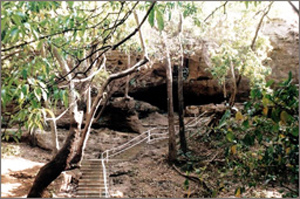
Mahadeo Cave
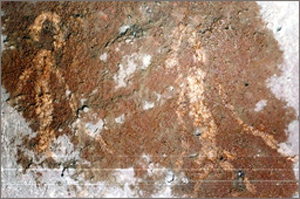
Fragmented Condition
The paintings found in Pachmarhi Hills are faded or partially obliterated and in fragmented condition. Some of them are covered with the thin layer of calcium or moss. The colours of some of the paintings have merged with those of the rock. The degree of natural preservation of these paintings varyies according to the location of the shelter, exposure to sunlight, rain, wind and worst of all, the unaware or mischievous human beings! Most of the shelters have now become accessible due to the development of tracks and roads, a consequence of the development of tourism in this area and the religious significance attached to the place. The paintings now face threat of human vandalism, and local tribal groups are now going deeper to explore the forests for their livelihood. For example, the rock paintings at Nagdwari are being badly damaged during annual festivals of Maha-Shivaratri and Nagapanchami, when pilgrims visit the shrines in thousands. The pilgrims are also damaging Neemgiri, Chitrashala and Agenda shelters that are located on the same hills of Nagdwari.
INDIAN ROCK ART : PACHMARHI THEMES
SCENES
Prehistoric artists have drawn all aspects of their life independently and complete in it. The artists depicted various compositions on the rock surface. Such compositions usually comprise scenes of hunting, food gathering, fighting, dancing, and music, social and daily chores.

Tree Ladder Scene

Figures with Monkeys

Dancers

Dancing Figures and Animals
MATERIAL CULTURE - HEAD HUNTING SCENES

Headhunter
The subject of head hunting in the history of rock art is very uncommon. At present, in Indian rock painting its only the rock art of Pachmarhi which contain this unique depiction of head hunting. Peru in South America is the only other so far known place where scenes of head hunting are found (Bednarick 1989:73).
There are a total of seven depictions of headhunters, which have been first recorded by me. Executed in bichrome colour, these depictions belong to the historic period. The acts in these scenes depict the brutality prevalent in the society of the Stone Age man. The head hunting scene is very prominent in Lanji Hill shelter wherein a human figure is holding a human head in his right hand and shown running, yet looking back over his shoulder, perhaps anticipating a chase or ensuring himself of breaking contact with his enemy. A giant and robust figure measuring 3 ft in length and 2.5 ft in width executed in light red colour has been depicted which makes everyone curious . A headhunter with identical description as stated above, has been recorded at Swem Aam shelter.
In yet another depiction at Nagdwari shelter a headhunter decorated in red lines, perhaps his tattoo marks, has been shown carrying a well-dressed severed head . At Rajat Prapat shelter four human figures have been depicted as headhunters running in the same direction but at different distances. Drawn rhythmically and full of action, this scene is eye catching and gives an insight into the historic life.

Headhunters Running

Headhunters
Remarkably, all the drawings of headhunters are filled with white colour and outlined with red colour. The figures have sharp facial features and body proportionate. Headhunters were probably most respected perhaps because they ensured protection of the clan, group or community and achieved victory over their enemies. Hence, the figures of headhunters are often found well decorated with headdress, crown, earrings and bodies covered from waist downwards up to the knees. Every figure holds a severed head, which is well decorated with crown, earrings, headdress identical to its hunter, running in the same direction and same of fashion looking back over the shoulder. The act of beheading human beings was perhaps not a ritual as nowhere in the shelters any such scene has been depicted. It may be assumed considering the prevalent brutality that beheading may be a form of severe punishment to those who committed a heinous crime of transgressing the law of the land of the tribes. However, it is quite likely that the head of the enemy was severed to ensure annihilation and carried back home to confirm victory to own ground, clan etc. and displayed as a war trophy.
Indian history is replete with the instances of human sacrifice prevalent amongst the tribes in the country, particularly, by Gond and Korku tribes. The tradition of human sacrifice was alive in Mahadeo Hill. “In the days that are forgotten, human victims hurled themselves over the rock as sacrifice to the goddess Kali and Kal Bhairav, the consort and son of Shiva, the destroyer”. Capt J Forsyth has mentioned about an eyewitness account of an incident of human sacrifice at Mahadeo Hills in his famous book “The Highlands of Central India” (Forsyth J 1889:180-184).
MYTHOLOGICAL SCENES

Tree Symbol Worship
The rock art suggestive of mythological origin is that of tree worship, cross worship, symbols of mother Goddess and demons. Gordon has commented that only a few Indian rock art paintings have a religious significance (Gordon 1958:109). “Symbols and so called signs found in rock paintings in different parts of the world are difficult to decipher. It is a code we have been unable to crack”, says Benerguer referring to European Ice Age symbols (Benerguer 1973:73). The paintings of Pachmarhi, which are likely to be related to mythology, have been grouped as follows:
1. Mother Goddess 2. Tree Worship 3. Symbol 4. Cross Worship 5. Swastika 6. Labyrinth (chakra) 7. Geometrical figures 8. Superhuman or deity worship 9. Demons 10. Mythical Animals
INSCRIPTIONS
Writing of inscriptions on the walls of the caves and shelters is associated with Hermits and Monks living in isolation in early historic times. It was common practice in many hills and forest area inhabited by Hermits. These inscriptions do help us place paintings of historic period to certain chronological order. Two inscriptions both in Nagri script in Pachmarhi have been recorded. One is in Dorothy Deep and the other is in Mahadeo shelter. The inscriptions in Mahadeo are too faded to be translated but the inscriptions at Dorothy Deep are by far the most legible. It consists of two lines written in cremish white colour. The first line is obviously meant to be same as commencement of much longer second like. It would appear to be from Nagri of probably 11th to 12th centuries. The translation, which does not make any sense, is as follows: "Lenamasiya a vri vri Dha Dha Ve She Jai Jai".
INDIAN ROCK ART : ANALYTICAL STUDY
The Stone Age man has painted many aspects regarding the social, cultural, economical, religious and ritualistic, pertaining to his life on the bare and uneven rock surface. The surfaces in the caves and shelters have been formed naturally over a period of time. The depictions of contemporary flora fauna and domestic activities have also found their places in these paintings. The antiquity of these unique paintings was probably realised first time by Archibald and Carlleyle in 1867-68 when they discovered the first rock paintings in India at Sohagighat in Uttar Pradesh. Mainly amateurs have brought approximately 150 sites of the rock paintings to our attention. The archeologists never seem to appreciate the antiquity of these paintings. Hence due to lack of attention, this national heritage of our country is now subjected to vandalism. It is pathetic to see at some places where those paintings are near extinction due to lack of protective measures. The shelters in Pachmarhi are well known from tourist and archaeological points of view. But their historic, cultural, artistic, musical and dimensional aspects have been left uncovered totally by most of the researchers known to have worked here. Unlike in Bhimbetka, there are numerous shelters and painted shelters scattered all over the Pachmarhi Hills. The approaches to many shelters are difficult, dangerous and time consuming.
Considering Pachmarhi town as the hub there is hardly any direction where the paintings are not evident. The painted shelters are also found in the outer periphery of the Pachmarhi Hills in the Satpura ranges. The study of these shelters has not been done in my work; however, some references of these have been made here and there. I feel a separate study in a different time frame is needed for the detail study of such paintings. Therefore, I have confined my study to the painted rock shelters of Pachmarhi Hills only. I am hopeful that this work will be an authentic record of the paintings of Pachmarhi hills for the students of the rock art in the future. The present study is the first comprehensive and exhaustive record encompassing thematic and stylistic analysis of the rock paintings of Pachmarhi Hills.
METHODOLOGY
The freehand drawings of the rock painting are the most popular method amongst the Indian scholars. But these kinds of drawings or copies can never be accurate and authentic, hence unsuitable for a scientific study. Such reproductions do not provide us the actual size of the form and scale for reduction or enlargements. Even a line drawing made in this way (reproduction without the colour scheme) cannot do justice to a coloured figure drawn on the shelter. Only a few drawings have been recorded to show the details of their features and ornaments etc. Photography is also a very common method for recording the rock paintings. It is an authentic and trustworthy method. The scholars like Leroi Gourhan (1968) have used basically coloured photographic reproduction of South Western European Cave paintings. Marshack (1975:64-89) has also used the special technique of extra close-up, ultra violet and infrared photography for his work. The photography has not been able to avoid the scratching and writing by vandals on the paintings. Many of the paintings are faded to varying degrees because of their age and prolonged exposure to the natural agencies. Therefore such paintings cannot be reproduced satisfactorily by photography. (Mathpal 1984 :4) Brooks (1975 : 92 :97) has evolved another process of reproducing Indian rock paintings. He first prepares a coloured transparency of the original paintings and makes a line drawing from it by projecting the transparency on the paper. After filling the drawing with colours he prepares a fresh transparency by superimposing the projection of the earlier transparency on the coloured drawing.
Today, the method for the reproduction of the rock painting followed is the combination of three means, tracing for dimensions, photography for colour effect and video recording. Tracing method applied by me to reproduce the rock paintings of Pachmarhi hills is not new. Nearly all the art of the Ice Age as well as the later period in Europe and Africa has been reproduced by this method (Cooks, 1961: 61-65, Vinicombe, 1966: 559 - 60). In India also J Cockburn, Manoranjan Ghosh, D.H. Gordon, V.S. Wakankar and Y Mathpal have employed the direct tracing method. In this method, the figure on the rock surface was first traced on fine transparent sheet. The reverse of the tracing paper was then rubbed with a lead Pencil to serve as carbon paper. The traced drawing was then transferred on the drawing paper. The figure on drawing paper was carefully compared with the original paintings on the rock surface to eliminate errors caused in tracing due to the uneven and rough surface of the rock. The drawing was than coloured on the spot continuously observing the tones and the shades of the original. The natural background of the painting was also reproduced in the same way. This method has been followed only in some paintings of the rock shelters, which are easily approachable and located nearer the town. The area of Pachmarhi hills is still one of the most inaccessible parts of India (Wakankar and Brooks 1975: 103). Shelters are spread all over in the dense forest. The shelters are 10 to 30 kms away from the town. This process was not found practicable at every place because the nature of terrain, constraint of the time and danger of the wild life.
The author has done the maximum recording of the rock paintings by the photography method using both coloured films and transparencies. This gives accurate sizes and originality of colours. Infact about the colours you cannot say the present colour tone is as original as it was about ten thousand years ago. Because of the natural weathering paintings are getting faded gradually and they are loosing their original colour and shades. On one hand the size and drawing of figure can certainly be correct and original but on the other one cannot say about the exact tone of their original colours from these photographs. Third method is video recording of some rock paintings of Pachmarhi area. It is so because day-by-day natural weathering and vandalism are damaging these paintings. Thus this is the best process to record the painting with there natural surroundings. All forms and compositions of Pachmarhi Hills have been copied in different methods. During the survey the figures and scenes have been counted at each shelter starting from left to right and from top to bottom. As many of the paintings are damaged and faded by natural agencies and vadalised by ignorant tourist, it is essential to have a factual record of them for the posterity.
The paintings have been analysed under the seven main categories:
(a) Human forms, (b) Animal forms, (c) Scenes, (d) Material culture, (e) Mythology, (f) Nature, (g) Inscriptions
Forms and scenes are studied according to their colour, style, size, technique, period and shelter. Description and analysis of subject matter is the main theme of the thesis. Next is the colour pigments and technology employed in the creation of paintings and finally, chronology, comparative study, motivation behind the art; the aesthetic aspects forms and styles are discussed. The present study is based on data collected from Pachmarhi hills over a period of five years during the suitable weather conditions. Consequently, the sole endeavour throughout the research work by the author has been to carry out an analytical study of the paintings, paying due attention to the above discussed aspects.
The artists painted at considerable heights, standing on ladders or branches of the nearby trees, which existed then near the shelters. Painted walls have been used several times by the painters of later periods, without removing the older paintings. These overlapped or superimposed paintings of different colours; styles and periods may be seen in the many shelters of Pachmarhi.
TECHNIQUES OF PAINTING
Four techniques have been used in the creation of Indian rock paintings. These are wet transparent colour (water colour painting), wet opaque colour (Oil or tempera), crayon (dry colour painting) and stencil (Spray colour painting). The transparent and opaque colour techniques are more common in rock paintings than the stencil technique, which is generally restricted to the execution of negative handprints (Mathpal 1984: 185). The only example of a stencil drawing is mentioned by Gordon from Kabra Pahar in Raigarh area of Madhaya Pradesh (Gordon 1959: 12). The techniques of paintings are not so complicated. Every artist should have either used wet colour or dry colours paste but drawings by means other than colour are also recorded on rock surfaces. These include engraving, carvings and brushings. Except for the stencil techniques, other techniques have been commonly used in the execution of paintings at Pachmarhi. In addition to the paintings, rock engravings are also found in Pachmarhi. The shelters at Rajat Prapat shelter bears a very few designs of symbols filled with white colour, and Astachal shelter also has an engraved horse rider. Only the earlier period paintings are found executed in wet transparent colour technique. Colours are greatly diluted in water; only red and white were applied as transparent. Later period paintings are executed in what is now known as non-transparent, opaque and crayon techniques. Only two inscriptions engraved on the rock surface have been found at Pachmarhi.
INDIAN ROCK ART: STYLE
The style is different from the technique. The word 'technique' represents the early evolutionary stage of the paintings where as the word 'style' denotes the experimental conditions. It represents the comprehensive and mature stage of the compromise. The conflicting claims in painting of symbolism and representation are very much like the conflicting claims in life of body and soul. And just as the finest forms of life are neither the extreme of hedonism on the one hand nor of asceticism on the other. Both symbolism and representation are easy enough to be described in words. It is a phenomenon that can be readily grasped by the mind (Newton 1945 : 22).
The main qualities of rock paintings which have attracted scholars and artists are the representation of figures including styles, pose and posture, composition, action, movement and different size of forms. Scholars like Breuil (Breuil? 1952 : 32-42) Burkitt (1923 : 187), Kuhn (1958 : 55, 58), Pericot (1961 :201 ? 2), Gordon (1958 : 99 ? 108), Pandey (19975 : 34), Wakankar and Brooks (1976 : 96 ? 103) and Mathpal (1984 : 171) have noticed continuous development in styles of execution. Leroi Gourhan has interpreted all the animal and human forms and abstract symbols on a well determined scheme of four styles on the assumption that in the absence of stratigraphic evidence, style alone can be the base of dating. But again he says, if we attempted this then any formless drawing, of any epoch, would be presumably Aurignacian (1968 : 44).
The style is the basic criterion to establish the chronology and decide the series, but the style alone cannot decide the chronology. We have noticed at Pachmarhi several ways of executing figures of a single period and even in a single composition. In every following composition each new figure varies from the others. Thus if all details of outline, colour filling, decoration and unpainted inner spaces on animal bodies were to be taken into account, the number of styles to emerge would be virtually limitless and therefore of no analytical value. The other factors also contribute in the classification for this purpose; the help of super-imposition and other aspects are necessary.
"The Mahadeo hill paintings have a whole array of stylistic peculiarities which do not appear in other rock paintings but which can be found in some periods of early Historic art and even in recent folk arts. An eye-catching peculiarity is the treatment of facial features. Rock painters all over India drew heads in profile. This convention was followed in the Mahadeo hills but both the eyes are usually indicated. In some paintings both eyes are placed on the visible half of the face, in others the second eye (invisible in a profile) is placed out side the profile line. The bodies of humans are always shown frontally and the legs and feets in profile" (Neumyer E, 1985; 22).
NATURALISTIC
Generally there were several types of drawings. Though we find both human and animal forms in this first style. But the realism or naturalism has been observed only in animal drawings. The technique adopted is potraying the animals in a freehand wash, no outline was drawn but the figure was completed with wash only. But in many cases, first the outline was completed and than the body was filled, either by a wash of light red or white or by different geometrical patterns. In some cases drawing was completed by a thin white wash and then the details of outlines and strips were finished with brighter white line. In this case the wash outline is so perfect that it gives a naturalistic look of the animal.
REPRESENTATIONAL
The human forms associate with the representational style are simple and without any skill. The figures are either in outline or in silhouette having the formation of square. The torso of the outline figures is decorated with straight, zigzag or horizontal lines. They have been adorned with peculiar headdresses. The figures are shown equipped with stick like objects. The overall picture gives the impression of a hunting society (plate148-). The considerable change in the human forms is also witnessed. There are divergent views regarding the origin of human forms. According to Gordon the human depiction begins with square shape which was followed by stick shape. He further elaborates that where ever square forms are found associated with stick forms, they represent transition. Henceforth, we get major development in huma drawing in stick shape and square shape. According to Wakankar the conception of human drawing beings with the portrayal of stick shape man and square shape style followed it.
In many places square shape figures are found associated with stick shape figures which on their part are equipped with bows and arrows. “At Pachmarhi the figures of both the series are shown together. The earliest human figures drawn in the picture are in square shape. The largest number of these paintings have been depicted in Pachmarhi area and at other places. However, their number is very limited. The square shape human figures have been located so far at Sighanpur, Kabra Pahad, Pachmarhi, Sagar, Khawai, Bhopal and Mandideep areas. These figures are either armed with wooden sticks or bare handed” (Panday S. K., 1975 : 93). Arrows are always fixed with microliths. These figures represent male hunters. However, at Pachmarhi some such figures do represent female form too. In the perspective drawings some time children are also shown associated with the group.
[
 x]
x]Hunters with Bows

Hunting Scene
There are numerous variations among square forms. Sometime squares are filled with curvilinear liners. The hands are shown raised up, legs stretched and the head is triangular in shape. Sometime torso is decorated with linear or intricate patterns, while the limbs are shown only in stick forms. The figures are shown generally bare handed, though sticks, bows and arrows are occasionally represented. These paintings are executed in monochrome (dark red or burnt sienna) and bichrome (red and white or creamish yellow). These paintings are shown with breasts, which clearly indicate their feminity. This style has been termed as representational, the naturalism continued in case of animal figures and representational style was adopted for human figures. The earlier animal figures follow the simple decoration but gradually the complicated designs in the form of intricate patterns dominate the paintings. Gradually, this style indicates advancement in the cultural complex of the painters. His perception was gradually developing and he was leading towards the consciousness of his surroundings. Since his experiences were transferred into visual art, he started portraying the narrative groupings.

Lion Mask

Soldiers Celebrate Victory
We get several modifications in stick like forms. The change can be detected in case of head dresses. Torso, though continued, but double or triple lined, as well as the triangular forms of torso also started. Another two more new elements were added to this style. The artists replaced the head with the animal masks. The purpose of the masks was to camoflauge the hunter during the course of hunting and identifying oneself with the totemic deity during the ceremonial dances. The second element has been found in case of animal figures in the form of X-ray drawings. The artist was well versed with the anatomy of the animals. Gradually, he started giving the anatomical details of the animals. He successfully depicted the naturalism in the animal drawings. Instead of depicting the individual animals, the paintings of heards were attempted. Artist has also attempted narrative groupings by depicting family groups engaged in different activities. Not only that even he painted the picture of man-eater tiger in different stages.
SYMBOLIC
A radical change is also marked in the paintings. The convertionalised forms gradually replaced the stick shape human figures. The decoration in case of animal figures was also changed. Afterwards, we get the domination of geometrical forms. We observed many human forms in triangular and rectangular shapes, engaged in different activities. Dancing, fighting and running, horse riders are also found executed in symbolic style. Artists have depicted them in various techniques, and monochrome and bichrome colours. The different religious symbols such as moon, sun, cross, swastika and tree worship are also depicted in the same style. This style is the most impressive manifestation of the intellectual level and represents the great majority of prehistoric art sites of painted or engrave geometric or symbolic figures.

Cross Symbol

Cross Symbol
INDIAN ROCK ART: DATING THE STYLES
The chronology of the rock paintings is based on the subject matter or cultural content, superimpositions, styles and archaeological findings from the painted rock shelters. The chronological study of Indian rock paintings begins with the work of Col D H Gordon, who devoted much of his time to the study, but only 217 figures from the large shelters of Pachmarhi Hills. He classified them in four series. The first of the series was compared with those of Singhanpur and Kabra Pahar. The second one was confined to Mahadeo hills. The third was mainly from the area around Pachmarhi and could be compared with the Ellora group. He compared the paintings of Jhalai with those of Ajanta. This, of course, was put in a time bracket of about 6th century A.D. The fourth series was compared with the early medieval sculpture, dating between 9th and 13th century A.D. Each series has an early and late phase. He examined this sequence with reference to drawing in 13 more shelters in and around Pachmarhi. According to him a geometric human figure (with rectangular bodies filled in wavy lines and triangular heads) (Series IA) and stick shaped figures (IB) are older than crude figures of hunters (2A and B). Series 3A comprises both geometric figures and crude silhouettes. Series 3A has the most natural animals silhouettes. In the paintings of series 4A and 4B, horse riders and fighters are grouped. In earlier writings he has also mentioned animals of the fifth series executed in greenish yellow. But unfortunately, Gordon's chronology does not clarify his various series. He also did not give a summarized chart with details of features of each of his series.
R K Verma has classified the rock paintings of the Mirzapur area according to style, into four main series, with three subdivisions of Series-II. He has considered the silhouetted drawings of animals as the oldest. The animal figures in Series IIA are either outlined or have partially filled in limbs, while in series IIB natural silhouettes of animal and horse riders are grouped. The scene of elephant trapping at Lithuania-II is assigned to Series IIB. Drawings of Series-IIC comprise crude, outlined figures of hunters. Symbolic and geometric signs characterise paintings of Series III. In the paintings of Series IV crude figures of animals are included. Jagdish Gupta has also classified the rock paintings in 1967 on published material. S K Pandey has classified the rock paintings of Betwa region in 1969. Wakankar, who has discovered the largest number of rock paintings in India, has prepared several chronologies of Indian rock art between 1973 and 1976. Wakankar has classified the entire rock art of India into five periods and 20 styles:
(a) Period I - Mesolithic or earlier (8000 (?) - 2500 BC): Style 6
(b) Period II - Neolithic/Chalcolithic & Early Iron Age (2500? 3000 BC): Styles 7-10
(c) Period III - Early Historic (300 BC ? AD 800): Style 16
(e) Period IV - Medieval (AD 800 ? 1300): Styles 17 and 18
(e) Period V - Recent (1300 AD to present): Styles 19 and 20
Summary of paintings styles, according to Wakankar in 1976:
SUMMARY OF PAINTING STYLES
Style / Features / Colours
I Mesolithic and Earlier [8000(?)-2500 BC]
1 / Large silhouette, Tuskless elephants, Bison and no human figures / Faded Red,
Brown & black
2 / Buffalos and Bisons in outline R/ ed
3 / Animal drawing in thick outlines with partially filled and decorated bodies, Hunters shown, chasing game like rhinoceros, bisons, antelope and elephant. / Red
4 / Bisons, deer and antilope in outline and non-geometric body decoration. / Red
5 / Animals with body decoration in several geometric patterns and partially filled limbs. Main animals are rhinoceros, tiger, ox, deer and antelope. / Red & Bichrome
6 / Geometric and floral designs hut shaped symbols and animals. Figures of Style-3 and human figures of Style 4 and 5. / Red & Purple
II Neolithic\Chalcolithic and Iron Age (2500 ? 300 BC)
7 / Silhouette drawing of bison, buffalow, elephant, ox, black buck, monkey, and lizard. / Red & brown
8 / Simple and stylized outline of cattle, boar, jackal, deer and antelope-overlapped by drawing of Period-III. / Red
9 / Figures depicted, crude and thick white drawing of animals and triangular bodied human figures. / White
10 / Silhouettes drawings of animals ox, tigers and human / White, Yellowish White
III Early Historic (300 BC - 800 A.D.)
11 / Symbols like Swastika, hollow cross design and inscriptions. / Red, White
Green, Yellow
12 / Animals with outlined, partially filled and large decorated bodies, Hunter with large bows and arrows, resemblance with Nevasal. Navadatoli pottery designs. / Red & Purple
13 / Drawings of horse and elephant riders Swordsman and archers in outline and wash. / Red & White
14 / Polychrome decorative patterns, Gupta and Shankh Inscription. / Red
15 / Multi coloured decorative designs. / White, Red & Yellow
16 / Social and Cultural life in natural silhouettes and scene of tribal conflicts. / White & Red
IV Medieval (800-1300AD)
17 / Stylized drawing of cavaliers and soldiers. / Red, White & Orange
18 / Silhouettes and linear drawings of elephants, horses and human forms. / Red & White
V Recent (1300 Present)
19 / Swordsmen and camel like animal in outline. / Crayon Charcoal
20 / Geometric human figures in double Outline along with Devanagri scripts. / Red
However, the efforts of Wakankar (1978), Gordon (1958), Verma (1964), SK Pandey (1969) and Mathpal (1984), who have been able to put forward minimum workable criteria and guidelines for choronological interpretations, are well perceived.
There are only three periods reflected in the rock paintings of Pachmarhi. One - scenes of a society of hunters and food gatherers, which can be called Prehistoric period (Mesolithic). Two - scenes of using chariots, huts, agriculture, pottery and domestic animals, which can be termed Protohistoric period (Neo/Chalcolithic). Three - scenes of fighters, riders and the use of metallic weapons, which undoubtedly, belong to the historic period.
(a) Prehistoric period - Mesolithic, Late Mesolithic.
(b) Protohistoric period ? Neolithic/Chalcolithic, Late Chalcolithic.
(c) Historic period - Historic, Late Historic.
CONCLUSION

Dr Meenakshi Pathak Records Rock Art in the Pachmarhi Hills
Pachmarhi is a small township on a plateau located in the folds of the Satpura ranges in Central India. It is 210 kms from Bhopal and 52 kms from Pipariya. Pipariya is the nearest railway station on the Bombay-Howrah mainline via Jabalpur. The hills of Pachmarhi have a complex of rock shelters, very difficult to count. More than 55 shelters have been surveyed here and there still be many more to discover. The reason as to why most of India's rock art is in Central India is geological. The Satpura and Vindhayan ranges consist of soft sand stone, which over millions of years, has weathered into hills containing overhanging rocks and cliffs and caves of many shapes and sizes. From early prehistoric times till a few centuries ago these provided shelters for humankind. The archaeological excavations particularly at Jambu Dweap in the past have proved that the early Stone Age man occupied these shelters. Numerous microliths have been found at the shelters in the Bari Aam area. Most interesting findings for me was a pendant made of the tooth of an herbivorous animal probably a monkey, and yellow ochre coloured nodules at the shelter in Bori area.
The location of Pachmarhi from the ecological point of view is such that it meets the basic needs of human beings to survive - food, (in the form of animals and vegetables) water and shelters. The aboriginals exploited the edible flowers, fruits, tubers, honey and animals available for food. The natural sources of water are numerous and perennial too. The hills have the shelters, large enough to accommodate 200 to 300 people and provide protection against wind, sun and rain. It is therefore obvious that prehistoric man occupied these shelters for nearly 10,000 years! Many of these shelters contain large numbers of paintings in varying states of preservation. They are placed at varying angles on the rock faces, often overlapping other paintings and varying sizes, from a few centimeters to several meters.
Indian rock paintings, mainly concentrated in Central India, have only recently received the attention they deserve. The majority of these paintings are in Madhaya Pradesh. Pachmarhi and the surrounding Mahadeo hills make a rich center of the paintings. It is interesting to note that the rock surface was not prepared in any way before painting, and often uneven surfaces and corners were chosen for painting, while broad and even surfaces, where you may expect existence of paintings, are left unpainted. The painted shelters are often located at considerable heights and access to them is very difficult. There are many shelters which cannot be used for dwelling but are painted rather better than those more suitable for dwelling purposes. Some of the shelters have numerous figures, painted with several superimpositions of figures, whilst some shelters contain a very few figures. The majority of the paintings are red and white, showing up admirably on the rock surface. A few paintings are also in yellow colour. Infact, paintings are executed in fourteen different shades, of these three main colours - Red, White and Yellow. These colours are obtained by grinding pieces of rock found locally and mixing the powder with water or some other binder. Nodules of hematite (geru) were used for red, and limestone or Caroline for white. It is believed that fluffed out sticks were used as brushes and porcupine quills for doing the fine work. Some cupmarks and cupules have been found in the Astachal and Ghurmar shelters.
The styles of paintings range from naturalistic to very symbolic or abstract. Three main styles of execution are recorded. The oldest drawings are more naturalistic or realistic and elegant and the later ones are more representational. Drawings are outlined, monochromic, bichrome and without light and shades. Nearly all drawings of animals are shown in profile and in motion. Outlines of animal forms are generally realistic and the bodies are decorated with geometric patterns.
Horns and legs are drawn in a slight three-quarters posture. There are a few figures in an x-ray style, showing the fetus within the womb. Inner details of the body are usually omitted. In rare cases, human figures, eyes, nostrils, ear, mouth and other facial details are shown. No figures are shown with shadows on the ground. There is neither background with human and animal figures nor perspective and foreshortening. Animals in herds are drawn in horizontal rows, which are one above the other. The paintings of the Pachmarhi area may be classified broadly in three groups. Firstly, depicting scenes of hunters and food gatherers, secondly pottery makers and cultivators, and thirdly fighters and horse riders with metallic weapons. First is considered prehistoric while the second protohistoric and the last historic period. The most common subjects of prehistoric paintings are animals - bison, boar, elephant, sambhar, gaur & antilopes. Besides, there are rabbit, fish, lizard, scorpion and small creatures. The drawings of animals are very naturalistically executed and show the animals in various postures and moods - standing, walking, running, leaping, looking back etc. Hunting scenes are also very common. Usually, the hunters are shown in small groups. They were shown with sticks, bows and arrows, stone tipped spears and traps. They face large animals like bison. Human figures are shown with different activities such as ritual dancing. A very interesting painting of ritualistic dancing 8 meters long can be found at Mount Rosa shelter, which is the most beautiful drawing of the mesolithic period in this area. At the same shelter, in one instance, a woman is extracting milk from both breasts. It may be a representation of the mother Goddess. Mesolithic people were decorating their bodies with ornaments. They wore necklaces, bracelets, bangles, pendants, elbow bands, knee bands and anklets. Men wore long loose hair and women braids. They used sticks, slings, spears, bows and arrows, traps for hunting. Their arrows and spears were barbed with microliths. These people used many kinds of masks, headdress and animal hides. The masks were different in shape and were used for hunting and dancing. Headdresses were crowned with feathers, antlers and horns.
Drawings of the protohistoric period show a gradual development like pottery making, building of hutments and means of transport (cart, chariot), agricultural implements, and other man-made utensils are depicted. The execution of figures is more representational. Drawings of the historic period show a society of fighters and riders, soldiers armed with swords and shields. It is very clear but these paintings do not depict the life of the cave dwellers. In other cases this period encompasses varied subjects such as honey collection, fishing, and domestic chores. Musical scenes are depicted with different instruments - harp, drum, pipe and cymbal. In one instance a very unique and interesting depiction of Head Hunters has been seen. This kind of depiction is only found at Pachmarhi in India. These figures are holding severed human heads. The figures and severed heads are highly decorated with ornaments like earrings, necklaces, crowns, topknots, and wearing loincloths. All the figures have sharp features and are proportionately made. The figures are holding severed heads in the right hand and sword in left hand. Another interesting painting of the Bori area shows a very clear face with both eyes face in front posture. It is a very unusual depiction, which is found only in this area. The subject matter of Pachmarhi area also includes a large number of different symbols and signs, mythical creatures, trees, bushes, decorative designs and inscriptions. There are also the scenes of collecting honey with the help of pets and music too. In another painting the fishing activity is shown with the small conical net, which is called Kumna by the present tribal of Pachmarhi.
The descendants of the original hunters and gatherers and artists of this region are the Korku and Gond tribes who still uphold some of the traditions of their ancestors. In the rock paintings, their ancestors are depicted dancing in pairs or in a row and playing musical instruments. They hunted animals and collected honey from hives of wild bees. Their mode of dress was quite simple. The women used to carry food and water and looked after the children. The forebears of the present day tribal people had a variety of ways to express the magic of their beliefs, rituals and taboos. The tribes living in these hills make memorials made of wood. Carved teakwood boards placed under a sacred Mango tree honor the dead. The subject of the carvings are totally unrelated to the life of the deceased but the style and subject - horse rider, sun, moon, tree and hut - is similar to the late period paintings depicted by their predecessors in the past on the mural of the rock shelter. They also decorate the walls of their wattle hut and this activity seems to have its roots in the cave dwelling traditions of their ancestors. Man and horses of geometric construction are randomly spaced across the walls; such paintings are done during the rainy season or on festive occasions bearing close resemblance to those found in the painted shelters.
THE NEED FOR CONSERVATION

Mahadeo Cave

Fragmented Condition
The paintings found in Pachmarhi Hills are faded or partially obliterated and in fragmented condition. Some of them are covered with the thin layer of calcium or moss. The colours of some of the paintings have merged with those of the rock. The degree of natural preservation of these paintings varyies according to the location of the shelter, exposure to sunlight, rain, wind and worst of all, the unaware or mischievous human beings! Most of the shelters have now become accessible due to the development of tracks and roads, a consequence of the development of tourism in this area and the religious significance attached to the place. The paintings now face threat of human vandalism, and local tribal groups are now going deeper to explore the forests for their livelihood. For example, the rock paintings at Nagdwari are being badly damaged during annual festivals of Maha-Shivaratri and Nagapanchami, when pilgrims visit the shrines in thousands. The pilgrims are also damaging Neemgiri, Chitrashala and Agenda shelters that are located on the same hills of Nagdwari.
- admin
- Site Admin
- Posts: 36135
- Joined: Thu Aug 01, 2013 5:21 am
Re: Freda Bedi Cont'd (#3)
The Message of the Superman
by Tara and Charles Carreon
3/20/21
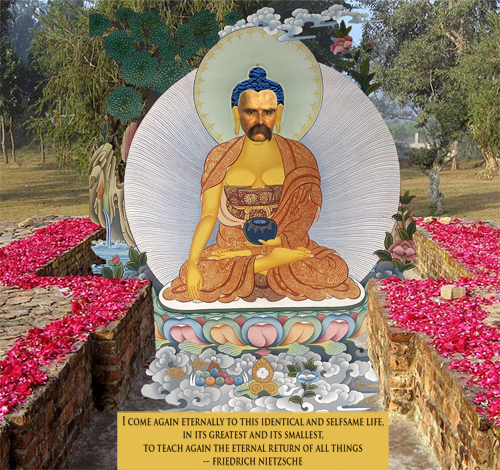
The Message of the Superman, by Tara and Charles Carreon
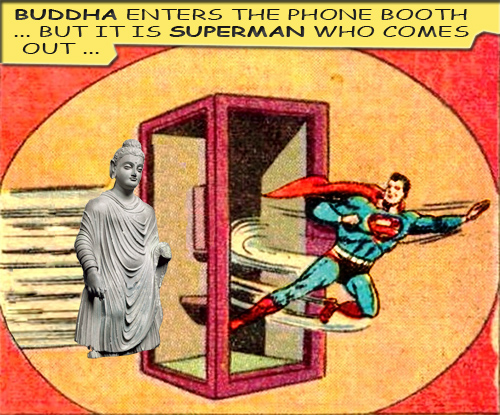
God Is Dead, Everything Is Permitted, by Tara and Charles Carreon
BUDDHA ENTERS THE PHONE BOOTH ... BUT IT IS SUPERMAN WHO COMES OUT ...
by Tara and Charles Carreon
3/20/21

The Message of the Superman, by Tara and Charles Carreon
I come again eternally to this identical and selfsame life, in its greatest and its smallest, to teach again the eternal return of all things. -- Friedrich Nietzsche

God Is Dead, Everything Is Permitted, by Tara and Charles Carreon
BUDDHA ENTERS THE PHONE BOOTH ... BUT IT IS SUPERMAN WHO COMES OUT ...
- admin
- Site Admin
- Posts: 36135
- Joined: Thu Aug 01, 2013 5:21 am
Re: Freda Bedi Cont'd (#3)
Vishnu Purana
by Wikipedia
Accessed: 3/20/21
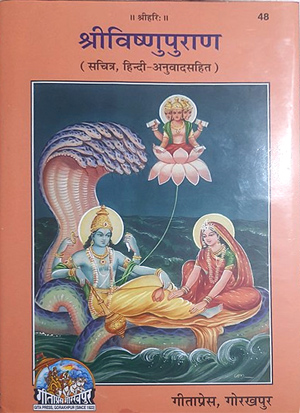
Vishnu Purana
Information
Religion: Hinduism
Author: Sage Parashara
Language: Sanskrit
Chapters: 126
Verses: 23,000
The Vishnu Purana (IAST: Viṣṇu Purāṇa) is one of the eighteen Mahapuranas, a genre of ancient and medieval texts of Hinduism.[1] It is an important Pancharatra text in the Vaishnavism literature corpus.[1][2]
The manuscripts of Vishnu Purana have survived into the modern era in many versions.[3][4][5] More than any other major Purana, the Vishnu Purana presents its contents in Pancalaksana format – Sarga (cosmogony), Pratisarga (cosmology), Vamśa (genealogy of the gods, sages and kings), Manvantara (cosmic cycles), and Vamśānucaritam (legends during the times of various kings).[6][7][8] Some manuscripts of the text are notable for not including sections found in other major Puranas, such as those on Mahatmyas and tour guides on pilgrimage,[9] but some versions include chapters on temples and travel guides to sacred pilgrimage sites.[1][10] The text is also notable as the earliest Purana to have been translated and published in 1864 CE by HH Wilson, based on manuscripts then available, setting the presumptions and premises about what Puranas may have been.[11][12]
The Vishnu Purana is among the shorter Purana texts, with about 7,000 verses in extant versions.[13][14] It primarily centers around the Hindu god Vishnu and his avatars such as Krishna, but it praises Brahma and Shiva and asserts that they are dependent on Vishnu.[14] The Purana, states Wilson, is pantheistic and the ideas in it, like other Puranas, are premised on the Vedic beliefs and ideas.[15]
Vishnu Purana, like all major Puranas, attributes its author to be sage Veda Vyasa.[16] The actual author(s) and date of its composition are unknown and contested. Estimates range of its composition range from 400 BCE to 900 CE.[9] The text was likely composed and rewritten in layers over a period of time, with roots possibly in ancient 1st-millennium BCE texts that have not survived into the modern era.[17] The Padma Purana categorizes Vishnu Purana as a Sattva Purana (Purana which represents goodness and purity).[18]
Date of composition
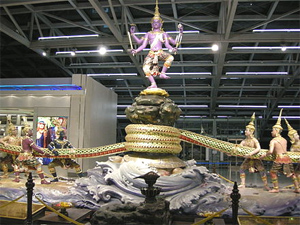
Samudra manthanam depicted in above sculpture, is described in the Vishnu Purana. Suvarnabhumi Airport, Bangkok
The composition date of Vishnu Purana is unknown and contested, with estimates widely disagreeing.[9] Some proposed dates for the earliest version[note 1] of Vishnu Purana by various scholars include:
• Vincent Smith (1908): 400-300 BCE,[9]
• CV Vaidya (1925): ~9th-century,[9]
• Moriz Winternitz (1932): possibly early 1st millennium, but states Rocher, he added, "it is no more possible to assign a definite date to the Vishnu Purana than it is for any other Purana".[9]
• Rajendra Chandra Hazra (1940): 275-325 CE[9]
• Ramachandra Dikshitar (1951): 700-300 BCE,[9][21]
• Roy (1968): after the 9th century.[9]
• Horace Hayman Wilson (1864): acknowledged that the tradition believes it to be 1st millennium BCE text and the text has roots in the Vedic literature, but after his analysis suggested that the extant manuscripts may be from the 11th century.[9][22]
• Wendy Doniger (1988): c. 450 CE.[23]
Rocher states that the "date of the Vishnu Purana is as contested as that of any other Purana".[9] References to Vishnu Purana in texts such as Brihadvishnu whose dates are better established, states Rocher, suggest that a version of Vishnu Purana existed by about 1000 CE, but it is unclear to what extent the extant manuscripts reflect the revisions during the 2nd millennium.[9][5] Vishnu Purana like all Puranas has a complicated chronology. Dimmitt and van Buitenen state that each of the Puranas including the Vishnu Purana is encyclopedic in style, and it is difficult to ascertain when, where, why and by whom these were written:[24]
Many of the extant manuscripts were written on palm leaf or copied during the British India colonial era, some in the 19th century.[25][26] The scholarship on Vishnu Purana, and other Puranas, has suffered from cases of forgeries, states Ludo Rocher, where liberties in the transmission of Puranas were normal and those who copied older manuscripts replaced words or added new content to fit the theory that the colonial scholars were keen on publishing.[25][26]
Structure
The extant text comprises six aṃśas (parts) and 126 adhyāyas (chapters).[27] The first part has 22 chapters, the second part consists 16 chapters, the third part comprises 18 chapters and the fourth part has 24 chapters. The fifth and the sixth parts are the longest and the shortest part of the text, comprising 38 and 8 chapters respectively.[28][29]
The textual tradition claims that the original Vishnu Purana had 23,000 verses,[30] but the surviving manuscripts have just a third of these, about 7,000 verses.[13] The text is composed in metric verses or sloka, wherein each verse has exactly 32 syllables, of which 16 syllables in the verse may be free style per ancient literary standards.[31]
The Vishnu Purana is an exception in that it presents its contents in Vishnu worship-related Pancalaksana format – Sarga (cosmogony), Pratisarga (cosmology), Vamśa (mythical genealogy of the gods, sages and kings), Manvantara (cosmic cycles), and Vamśānucaritam (legends during the times of various kings).[6][7][8] This is rare, state Dimmitt and van Buitenen, because just 2% of the known Puranic literature corpus is about these five Pancalaksana items, and about 98% is about diverse range of encyclopedic topics.[32]
Contents
Vishnu Purana opens as a conversation between sage Maitreya and his guru, Parashara, with the sage asking, "what is the nature of this universe and everything that is in it?"[27][35]
First aṃśa: cosmology
The first Amsha (part) of Vishnu Purana presents cosmology, dealing with the creation, maintenance and destruction of the universe.[36] The mythology, states Rocher, is woven with the evolutionary theories of Samkhya school of Hindu philosophy.[36]
The Hindu god Vishnu is presented as the central element of this text's cosmology, unlike some other Puranas where Shiva or Brahma or goddess Shakti are. The reverence and the worship of Vishnu is described in 22 chapters of the first part as the means for liberation, along with the profuse use of the synonymous names of Vishnu such as Hari, Janardana, Madhava, Achyuta, Hrishikesha and others.[36][37] The chapters 1.16 through 1.20 of the Vishnu Purana presents the legend of compassionate and Vishnu devotee Prahlada and his persecution by his demon king father Hiranyakasipu, wherein Prahlada is ultimately saved by Vishnu.[38][39] This story is also found in other Puranas.[40]
Vishnu is described in the first book of Vishnu Purana as, translates Wilson, all elements, all matter in the world, the entire universe, all living beings, as well as Atman (Inner Self, essence) within every living being, nature, intellect, ego, mind, senses, ignorance, wisdom, the four Vedas, all that is and all that is not.[37][41]
Second aṃśa: earth
The second part of the text describes its theory of earth, the seven continents and seven oceans.[33][42] It describes mount Meru, mount Mandara and other major mountains, as well as Bharata-varsha (literally, the country of Bharata) along with its numerous rivers and diverse people.[33][43] The seven continents are named Jambu, Plaksha, Salmala, Kusha, Krauncha, Saka and Pushkara, each surrounded by different types of liquids (salt water, fresh water, wine, sugarcane juice, clarified butter, liquid yoghurt, and milk).[33][42]
This part of the Vishnu Purana describes spheres above the earth, planets, the sun and the moon. Four chapters (2.13 to 2.16)[44] of the second book of the text present the legends of King Bharata, who abdicates his throne to lead the life of a sannyasi, which is similar to the legends found in section 5.7 to 5.14 of the Bhagavata Purana.[33] The geography of Mount Mandara as east of Mount Meru, presented in this book and other Puranas, states Stella Kramrisch, may be related to the word Mandir (Hindu temple) and the reason of its design, "image, aim and destination".[45]
Third aṃśa: time
The initial chapters of the third book of the Vishnu Purana presents its theory of manvantaras, or Manus-ages (each 306.72 million years long[46]).[33][47] This is premised upon the Hindu belief that everything is cyclic, and even Yuga (era, ages) start, mature and then dissolve. Six manvantaras, states the text, have already passed, and the current age belong to the seventh.[47] In each age, asserts the text, the Vedas are arranged into four, it is challenged, and this has happened twenty eight times already.[48] Each time, a Veda-Vyasa appears and he diligently organizes the eternal knowledge, with the aid of his students.[33][49]
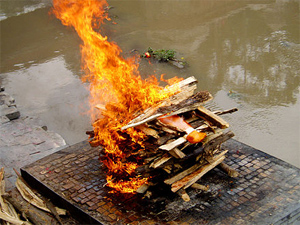
The Vishnu Purana includes several chapters in book 3 on rites of passage from birth through death. Included are chapters on cremation rites (above).
After presenting the emergence of Vedic schools, the text presents the ethical duties of the four varnas in chapter 2.8, the four Ashrama (stages) of the life of each human being in chapter 2.9, the rites of passage including wedding rituals in chapters 2.10 through 2.12, and Shraddha (rites in honor of ancestors, faith) in chapters 2.13 through 2.16.[33][50]
The Vishnu Purana asserts that the Brahmin should study shastras, worship gods and perform libations on behalf of others, the Kshatriya should maintain arms and protect the earth, the Vaishya should engage in commerce and farming, while the Shudra should subsist by profits of trade, service other varnas and through mechanical labor.[51][52] The text asserts the ethical duties of all varnas is to do good to others, never abuse anyone, never engage in calumny or untruth, never covet another person's wife, never steal another's property, never bear ill-will towards anyone, never beat or slay any human being or living being.[53][52] Be diligent in the service of the gods, sages and guru, asserts the Purana, seek the welfare of all creatures, one's own children and of one's own soul.[53][54] Anyone, regardless of their varna or stage of life, who lives a life according to the above duties is the best worshipper of Vishnu, claims the Vishnu Purana.[53][54] Similar statements on ethical duties of man are found in other parts of Vishnu Purana.[55]
The text describes in chapter 2.9, the four stages of life as brahmacharya (student), grihastha (householder), vanaprastha (retirement) and sannyasa (renunciation, mendicant).[56][57] The text repeats the ethical duties in this chapter, translates Wilson.[56][57] The chapters on Shraddha (rites for ancestors) describe the rites associated with a death in family, the preparation of the dead body, its cremation and the rituals after the cremation.[58]
The third book closes with the legend of Vishnu, through Mayamoha, helping the Devas win over Asuras, by teaching the Asuras heretical doctrines that deny the Vedas, who declare their contempt for the Vedas, which makes them easy to identify and thereby defeat.[33][59]
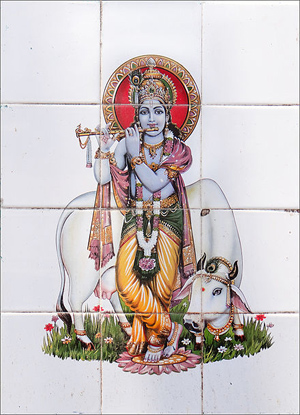
The longest part of the Vishnu Purana is dedicated to the legend of Krishna (above).
Fourth aṃśa: dynasties
The fourth book of the text, in 24 long chapters, presents royal dynasties, starting with Brahma, followed by solar and lunar dynasties, then those on earth over the Yugas (eras), with Pariksit asserted as the "current king".[33][60][61] The text includes the legends of numerous characters such as Shaubhri, Mandhatri, Narmada, sage Kapila, Rama, Nimi, Janaka, Buddha, Satyavati, Puru, Yadu, Krishna, Devaka, Pandu, Kuru, Bharata, Bhisma and others.[62]
Fifth aṃśa: Krishna
The fifth book of the Vishnu Purana is the longest, with 38 chapters.[63][64][65] It is dedicated to the legend of Krishna, as an avatar of Vishnu.[66] The book begins with the story of Krishna's birth, his childhood pranks and plays, his exploits, his purpose of ending the tyranny of demon-tyrant king of Mathura, named Kansa.[63][67][65]
The Krishna story in the Vishnu Purana is similar to his legend in the Bhagavata Purana, in several other Puranas and the Harivamsa of the Mahabharata.[63] Scholars have long debated whether the Bhagavata Purana expanded the Krishna legend in the Vishnu Purana, or whether the latter abridged the version in former, or both depended on the Harivamsa estimated to have been composed sometime in the 1st millennium of the common era.[63][68][69]
Sixth aṃśa: liberation
The last book of the Vishnu Purana is the shortest, with 8 chapters.[63][71] The first part of the sixth book asserts that Kali Yuga is vicious, cruel and filled with evilness that create suffering, yet "Kali Yuga is excellent" because one can refuse to join the evil, devote oneself to Vishnu and thus achieve salvation.[72]
The last chapters, from 6.6 to 6.7 of the text discusses Yoga and meditation, as a means to Vishnu devotion.[63][73] Contemplative devotion, asserts the text, is the union with the Brahman (supreme soul, ultimate reality), which is only achievable with virtues such as compassion, truth, honesty, disinterestedness, self-restraint and holy studies.[74] The text mentions five Yamas, five Niyamas, Pranayama and Pratyahara.[75] The pure and perfect soul is called Vishnu, states the text, and absorption in Vishnu is liberation.[76]
The final chapter 6.8 of the text asserts itself to be an "imperishable Vaishnava Purana".[77]
Influences
Vishnu Purana is one of the 18 major Puranas, and these text share many legends, likely influenced each other.[63] The fifth chapter of the Vishnu Purana was likely influenced by the Mahabharata.[68] Similarly, the verses on rites of passage and ashramas (stages) of life are likely drawn from the Dharmasutra literature. Rajendra Hazra, in 1940, assumed that Vishnu Purana is ancient and proposed that texts such as Apasthamba Dharmasutra borrowed text from it.[78] Modern scholars such as Allan Dahlaquist disagree, however, and state that the borrowing may have been in the other direction, from Dharmasutras into the Purana.[78]
Other chapters, particularly those in book 5 and 6 of the Vishnu Purana have Advaita Vedanta and Yoga influences.[79][80][81] The theistic Vedanta scholar Ramanuja, according to Sucharita Adluri, incorporated ideas from the Vishnu Purana to identify the Brahman concept in the Upanishads with Vishnu, thus providing a Vedic foundation to the Srivaishnava tradition.[82]
See also
• Dvaita Vedanta
• Hindu texts
• Upanishad
• Veda
Notes
1. This is not the version that has survived into the modern era. The estimates for earliest version are based on the analysis of the content, events described, literary style, references to other Indian texts within this Purana.[19][20]
References
1. Dalal 2014, p. 460.
2. Rocher 1986, pp. 245-249.
3. Rocher 1986, pp. 18, 245-249.
4. Wilson 1864, pp. xxxiv-xxxv.
5. Gregory Bailey (2003). Arvind Sharma (ed.). The Study of Hinduism. University of South Carolina Press. pp. 141–142. ISBN 978-1-57003-449-7.
6. Rocher 1986, pp. 248-249.
7. Rao 1993, pp. 85–100.
8. Johnson 2009, p. 248.
9. Rocher 1986, p. 249.
10. Ariel Glucklich 2008, p. 146, Quote: The earliest promotional works aimed at tourists from that era were called mahatmyas.
11. Wilson 1864, pp. i-xviii, for full context and comparison of Vishnu Purana with other Puranas then known, see all of the Preface section..
12. Gregory Bailey (2003). Arvind Sharma (ed.). The Study of Hinduism. University of South Carolina Press. pp. 148–149. ISBN 978-1-57003-449-7.
13. Wilson 1864, p. xxxv.
14. Rocher 1986, p. 246, 248 with footnote 501.
15. Wilson 1864, pp. xii-xiv.
16. Rocher 1986, p. 48.
17. Rocher 1986, pp. 41-48, 249.
18. Wilson, H. H. (1840). The Vishnu Purana: A system of Hindu mythology and tradition. Oriental Translation Fund. p. 12.
19. Dimmitt & van Buitenen 2012, p. 1-7.
20. Rocher 1986, p. 38-49, 59-66.
21. K P Gietz 1992, p. 986 with note 5739.
22. Edward Balfour (1885). The Cyclopædia of India and of Eastern and Southern Asia. B. Quaritch. p. 1025.
23. Collins 1988, p. 36.
24. Dimmitt & van Buitenen 2012, p. 5.
25. Rocher 1986, pp. 49-53.
26. Avril Ann Powell (2010). Scottish Orientalists and India: The Muir Brothers, Religion, Education and Empire. Boydell & Brewer. pp. 130, 128–134, 87–90. ISBN 978-1-84383-579-0.
27. Rocher 1986, p. 246.
28. Rocher 1986, pp. 246-248.
29. Wilson 1864.
30. Kireet Joshi (1991). The Veda and Indian Culture: An Introductory Essay. Motilal Banarsidass. p. 106. ISBN 978-81-208-0889-8.
31. Dimmitt & van Buitenen 2012, p. xiii.
32. Dimmitt & van Buitenen 2012, p. 9.
33. Rocher 1986, p. 247.
34. Wilson 1865, pp. 94-95.
35. "A Brief History of India", by Alain Daniélou, publisher = Inner Traditions / Bear & Co., p. 25
36. Rocher 1986, pp. 246-247.
37. Wilson 1865, pp. 93-96.
38. Dutt 1896, pp. ii-iii.
39. Wilson 1865, pp. 32-68.
40. Wendy Doniger (2000), Merriam-Webster's Encyclopedia of World Religions, Merriam-Webster, ISBN 978-0877790440, page 455
41. Wilson 1864, pp. 170-172, 196-198.
42. Wilson 1865, pp. 109-126.
43. Wilson 1865, pp. 127-190.
44. Wilson 1865, pp. 312-336.
45. Kramrisch 1976, p. 161 with footnote 78.
46. Doniger, Wendy; Hawley, John Stratton, eds. (1999). "Merriam-Webster's Encyclopedia of World Religions". Merriam-Webster. Merriam-Webster, Incorporated. p. 691 (Manu). ISBN 0877790442. a day in the life of Brahma is divided into 14 periods called manvantaras ("Manu intervals"), each of which lasts for 306,720,000 years. In every second cycle [(new kalpa after pralaya)] the world is recreated, and a new Manu appears to become the father of the next human race. The present age is considered to be the seventh Manu cycle.
47. Wilson 1866, pp. 1-19.
48. Wilson 1866, pp. 33-51.
49. Wilson 1866, pp. 40-42.
50. Wilson 1866, pp. 80-199.
51. Wilson 1866, pp. 85-87.
52. Dutt 1896, pp. 191-192.
53. Wilson 1866, pp. 80-90.
54. Dutt 1896, pp. 191-193.
55. NK Devaraja (1976), What is living and what is dead in traditional Indian philosophy?, Philosophy East and West, Volume 26, Issue 4, pages 427-442, Quote: "Thus in the Visnu Purana, Prahlada, the great devotee of Visnu, is found making a number of statements of the following type: Knowing that god Visnu is present in all creatures - since neither the totality of living beings, nor myself, nor the food is other than Viṣṇu - I serve all creatures with food; may this food bring them satisfaction. Elsewhere, in the same text, we read: We offer obeisance to that unborn, imperishable Brahman which is present in our and others bodies and in everything else, there being nothing other than it anywhere. This teaching of the ethics of universal love and service..."
56. Wilson 1866, pp. 92-96.
57. Dutt 1896, pp. 194-196.
58. Wilson 1866, pp. 1 48-170.
59. Wilson 1866, pp. 207-227.
60. Wilson 1866, pp. 229-336.
61. Wilson 1868, pp. 1-242.
62. Dutt 1896, pp. 237-306.
63. Rocher 1986, p. 248.
64. Wilson 1868, pp. 245-342.
65. Wilson 1870, pp. 1-167.
66. Dutt 1896, pp. 317-418.
67. Wilson 1870, pp. 245-342.
68. Walter Ruben (1941), The Kṛṣṇacarita in the Harivaṃśa and Certain Purāṇas, Journal of the American Oriental Society, Vol. 61, No. 3, pages 115-127
69. Bryant 2007, pp. 9-10, 95-109 (Chapter by Ekkehard Lorenz).
70. Wilson 1870, p. 225.
71. Wilson 1870, pp. 168-255.
72. Wilson 1870, pp. 177-185 with footnotes.
73. Wilson 1870, pp. 216-255.
74. Wilson 1870, pp. 227-229 with footnotes.
75. Wilson 1870, pp. 230-232 with footnotes.
76. Wilson 1870, pp. 242-243.
77. Wilson 1870, p. 244.
78. Allan Dahlaquist (1996). Megasthenes and Indian Religion. Motilal Banarsidass. p. 92 with footnote 1. ISBN 978-81-208-1323-6.
79. NK Devaraja (1970), Contemporary Relevance of Advaita Vedānta, Philosophy East and West, Vol. 20, No. 2, pages 129-136
80. KSR Datta (1978), The Visnu Purana and Advaita, Journal: Purana, Vol 20, pages 193-196
81. R. Balasubramanian (2000). "Advaita in the Puranas". Advaita Vedānta. Motilal Banarsidass. pp. 51–78. ISBN 978-8187586043.
82. Sucharita Adluri (2015), Textual authority in Classical Indian Thought: Ramanuja and the Visnu Purana, Routledge, ISBN 978-0415695756, pages 1-11, 18-26
Bibliography
• Bryant, Edwin Francis (2007). Krishna: A Sourcebook. Oxford University Press. ISBN 978-0-19-803400-1.
• Collins, Charles Dillard (1988). The Iconography and Ritual of Siva at Elephanta: On Life, Illumination, and Being. SUNY Press. ISBN 978-0-88706-773-0.
• Dimmitt, Cornelia; van Buitenen, J. A. B. (2012). Classical Hindu Mythology: A Reader in the Sanskrit Puranas. Temple University Press (1st Edition: 1977). ISBN 978-1-4399-0464-0.
• Dalal, Rosen (2014). Hinduism: An Alphabetical Guide. Penguin. ISBN 978-8184752779.
• Dutt, MN (1896). A prose translation of Vishnupuranam. Elysium Press.
• Flood, Gavin (1996). An Introduction to Hinduism. Cambridge: Cambridge University Press. ISBN 0-521-43878-0.
• K P Gietz; et al. (1992). Epic and Puranic Bibliography (Up to 1985) Annoted and with Indexes: Part I: A - R, Part II: S - Z, Indexes. Otto Harrassowitz Verlag. ISBN 978-3-447-03028-1.
• Ariel Glucklich (2008). The Strides of Vishnu : Hindu Culture in Historical Perspective: Hindu Culture in Historical Perspective. Oxford University Press. ISBN 978-0-19-971825-2.
• Johnson, W.J. (2009). A Dictionary of Hinduism. Oxford University Press. ISBN 978-0-19-861025-0.
• Kramrisch, Stella (1976). The Hindu Temple, Volume 1 & 2. Motilal Banarsidass. ISBN 81-208-0223-3.
• Rao, Velcheru Narayana (1993). "Purana as Brahminic Ideology". In Doniger Wendy (ed.). Purana Perennis: Reciprocity and Transformation in Hindu and Jaina Texts. Albany: State University of New York Press. ISBN 0-7914-1381-0.
• Rocher, Ludo (1986). The Puranas. Otto Harrassowitz Verlag. ISBN 978-3447025225.
• Thapar, Romila (2013), The Past Before Us, Harvard University Press, ISBN 978-0-674-72651-2
• Wilson, H. H. (1864). The Vishnu Purana: A System of Hindu Mythology and Tradition (Volume 1: Introduction, Book I). Read Country Books (reprinted in 2006). ISBN 1-84664-664-2.
• Wilson, H. H. (1865). The Vishnu Purana: A System of Hindu Mythology and Tradition (Volume 2: Book I & II).
• Wilson, H. H. (1866). The Vishnu Purana: A System of Hindu Mythology and Tradition (Volume 3: Book III & IV).
• Wilson, H. H. (1868). The Vishnu Purana: A System of Hindu Mythology and Tradition (Volume 4: Book IV & V).
• Wilson, H. H. (1870). The Vishnu Purana: A System of Hindu Mythology and Tradition (Volume 5 Part 1: Book V & VI).
Further reading
• Mani, Vettam. Puranic Encyclopedia. 1st English ed. New Delhi: Motilal Banarsidass, 1975.
• Shri Vishnupuran published by Gitapress Gorakhpur
External links
• Vishnu Purana translation by H.H. Wilson at sacred-texts
• Vishnu Purana English translation correct IAST transliteration and glossary
• Other language versions on the Internet Archive: Sanskrit (by Vishnuchitta Alwar, 1922), Bengali by Kaliprasanna Vidyaratna (1926), Hindi, Telugu by K. Bhavanarayana (1930)
by Wikipedia
Accessed: 3/20/21

Vishnu Purana
Information
Religion: Hinduism
Author: Sage Parashara
Language: Sanskrit
Chapters: 126
Verses: 23,000
The Vishnu Purana (IAST: Viṣṇu Purāṇa) is one of the eighteen Mahapuranas, a genre of ancient and medieval texts of Hinduism.[1] It is an important Pancharatra text in the Vaishnavism literature corpus.[1][2]
The manuscripts of Vishnu Purana have survived into the modern era in many versions.[3][4][5] More than any other major Purana, the Vishnu Purana presents its contents in Pancalaksana format – Sarga (cosmogony), Pratisarga (cosmology), Vamśa (genealogy of the gods, sages and kings), Manvantara (cosmic cycles), and Vamśānucaritam (legends during the times of various kings).[6][7][8] Some manuscripts of the text are notable for not including sections found in other major Puranas, such as those on Mahatmyas and tour guides on pilgrimage,[9] but some versions include chapters on temples and travel guides to sacred pilgrimage sites.[1][10] The text is also notable as the earliest Purana to have been translated and published in 1864 CE by HH Wilson, based on manuscripts then available, setting the presumptions and premises about what Puranas may have been.[11][12]
The Vishnu Purana is among the shorter Purana texts, with about 7,000 verses in extant versions.[13][14] It primarily centers around the Hindu god Vishnu and his avatars such as Krishna, but it praises Brahma and Shiva and asserts that they are dependent on Vishnu.[14] The Purana, states Wilson, is pantheistic and the ideas in it, like other Puranas, are premised on the Vedic beliefs and ideas.[15]
Vishnu Purana, like all major Puranas, attributes its author to be sage Veda Vyasa.[16] The actual author(s) and date of its composition are unknown and contested. Estimates range of its composition range from 400 BCE to 900 CE.[9] The text was likely composed and rewritten in layers over a period of time, with roots possibly in ancient 1st-millennium BCE texts that have not survived into the modern era.[17] The Padma Purana categorizes Vishnu Purana as a Sattva Purana (Purana which represents goodness and purity).[18]
Date of composition

Samudra manthanam depicted in above sculpture, is described in the Vishnu Purana. Suvarnabhumi Airport, Bangkok
The composition date of Vishnu Purana is unknown and contested, with estimates widely disagreeing.[9] Some proposed dates for the earliest version[note 1] of Vishnu Purana by various scholars include:
• Vincent Smith (1908): 400-300 BCE,[9]
• CV Vaidya (1925): ~9th-century,[9]
• Moriz Winternitz (1932): possibly early 1st millennium, but states Rocher, he added, "it is no more possible to assign a definite date to the Vishnu Purana than it is for any other Purana".[9]
• Rajendra Chandra Hazra (1940): 275-325 CE[9]
• Ramachandra Dikshitar (1951): 700-300 BCE,[9][21]
• Roy (1968): after the 9th century.[9]
• Horace Hayman Wilson (1864): acknowledged that the tradition believes it to be 1st millennium BCE text and the text has roots in the Vedic literature, but after his analysis suggested that the extant manuscripts may be from the 11th century.[9][22]
• Wendy Doniger (1988): c. 450 CE.[23]
Rocher states that the "date of the Vishnu Purana is as contested as that of any other Purana".[9] References to Vishnu Purana in texts such as Brihadvishnu whose dates are better established, states Rocher, suggest that a version of Vishnu Purana existed by about 1000 CE, but it is unclear to what extent the extant manuscripts reflect the revisions during the 2nd millennium.[9][5] Vishnu Purana like all Puranas has a complicated chronology. Dimmitt and van Buitenen state that each of the Puranas including the Vishnu Purana is encyclopedic in style, and it is difficult to ascertain when, where, why and by whom these were written:[24]
As they exist today, the Puranas are a stratified literature. Each titled work consists of material that has grown by numerous accretions in successive historical eras. Thus no Purana has a single date of composition. (...) It is as if they were libraries to which new volumes have been continuously added, not necessarily at the end of the shelf, but randomly.
— Cornelia Dimmitt and J.A.B. van Buitenen, Classical Hindu Mythology: A Reader in the Sanskrit Puranas[24]
Many of the extant manuscripts were written on palm leaf or copied during the British India colonial era, some in the 19th century.[25][26] The scholarship on Vishnu Purana, and other Puranas, has suffered from cases of forgeries, states Ludo Rocher, where liberties in the transmission of Puranas were normal and those who copied older manuscripts replaced words or added new content to fit the theory that the colonial scholars were keen on publishing.[25][26]
Structure
The extant text comprises six aṃśas (parts) and 126 adhyāyas (chapters).[27] The first part has 22 chapters, the second part consists 16 chapters, the third part comprises 18 chapters and the fourth part has 24 chapters. The fifth and the sixth parts are the longest and the shortest part of the text, comprising 38 and 8 chapters respectively.[28][29]
The textual tradition claims that the original Vishnu Purana had 23,000 verses,[30] but the surviving manuscripts have just a third of these, about 7,000 verses.[13] The text is composed in metric verses or sloka, wherein each verse has exactly 32 syllables, of which 16 syllables in the verse may be free style per ancient literary standards.[31]
The Vishnu Purana is an exception in that it presents its contents in Vishnu worship-related Pancalaksana format – Sarga (cosmogony), Pratisarga (cosmology), Vamśa (mythical genealogy of the gods, sages and kings), Manvantara (cosmic cycles), and Vamśānucaritam (legends during the times of various kings).[6][7][8] This is rare, state Dimmitt and van Buitenen, because just 2% of the known Puranic literature corpus is about these five Pancalaksana items, and about 98% is about diverse range of encyclopedic topics.[32]
Contents
Who is Vishnu?
Out of Vishnu this universe has arisen,
in him its exists,
he is the one who governs its existence and destruction,
he is the universe.
—Vishnu Purana, 1.14[33][34]
Vishnu Purana opens as a conversation between sage Maitreya and his guru, Parashara, with the sage asking, "what is the nature of this universe and everything that is in it?"[27][35]
First aṃśa: cosmology
The first Amsha (part) of Vishnu Purana presents cosmology, dealing with the creation, maintenance and destruction of the universe.[36] The mythology, states Rocher, is woven with the evolutionary theories of Samkhya school of Hindu philosophy.[36]
The Hindu god Vishnu is presented as the central element of this text's cosmology, unlike some other Puranas where Shiva or Brahma or goddess Shakti are. The reverence and the worship of Vishnu is described in 22 chapters of the first part as the means for liberation, along with the profuse use of the synonymous names of Vishnu such as Hari, Janardana, Madhava, Achyuta, Hrishikesha and others.[36][37] The chapters 1.16 through 1.20 of the Vishnu Purana presents the legend of compassionate and Vishnu devotee Prahlada and his persecution by his demon king father Hiranyakasipu, wherein Prahlada is ultimately saved by Vishnu.[38][39] This story is also found in other Puranas.[40]
Vishnu is described in the first book of Vishnu Purana as, translates Wilson, all elements, all matter in the world, the entire universe, all living beings, as well as Atman (Inner Self, essence) within every living being, nature, intellect, ego, mind, senses, ignorance, wisdom, the four Vedas, all that is and all that is not.[37][41]
Second aṃśa: earth
The second part of the text describes its theory of earth, the seven continents and seven oceans.[33][42] It describes mount Meru, mount Mandara and other major mountains, as well as Bharata-varsha (literally, the country of Bharata) along with its numerous rivers and diverse people.[33][43] The seven continents are named Jambu, Plaksha, Salmala, Kusha, Krauncha, Saka and Pushkara, each surrounded by different types of liquids (salt water, fresh water, wine, sugarcane juice, clarified butter, liquid yoghurt, and milk).[33][42]
This part of the Vishnu Purana describes spheres above the earth, planets, the sun and the moon. Four chapters (2.13 to 2.16)[44] of the second book of the text present the legends of King Bharata, who abdicates his throne to lead the life of a sannyasi, which is similar to the legends found in section 5.7 to 5.14 of the Bhagavata Purana.[33] The geography of Mount Mandara as east of Mount Meru, presented in this book and other Puranas, states Stella Kramrisch, may be related to the word Mandir (Hindu temple) and the reason of its design, "image, aim and destination".[45]
Third aṃśa: time
The initial chapters of the third book of the Vishnu Purana presents its theory of manvantaras, or Manus-ages (each 306.72 million years long[46]).[33][47] This is premised upon the Hindu belief that everything is cyclic, and even Yuga (era, ages) start, mature and then dissolve. Six manvantaras, states the text, have already passed, and the current age belong to the seventh.[47] In each age, asserts the text, the Vedas are arranged into four, it is challenged, and this has happened twenty eight times already.[48] Each time, a Veda-Vyasa appears and he diligently organizes the eternal knowledge, with the aid of his students.[33][49]

The Vishnu Purana includes several chapters in book 3 on rites of passage from birth through death. Included are chapters on cremation rites (above).
After presenting the emergence of Vedic schools, the text presents the ethical duties of the four varnas in chapter 2.8, the four Ashrama (stages) of the life of each human being in chapter 2.9, the rites of passage including wedding rituals in chapters 2.10 through 2.12, and Shraddha (rites in honor of ancestors, faith) in chapters 2.13 through 2.16.[33][50]
The Vishnu Purana asserts that the Brahmin should study shastras, worship gods and perform libations on behalf of others, the Kshatriya should maintain arms and protect the earth, the Vaishya should engage in commerce and farming, while the Shudra should subsist by profits of trade, service other varnas and through mechanical labor.[51][52] The text asserts the ethical duties of all varnas is to do good to others, never abuse anyone, never engage in calumny or untruth, never covet another person's wife, never steal another's property, never bear ill-will towards anyone, never beat or slay any human being or living being.[53][52] Be diligent in the service of the gods, sages and guru, asserts the Purana, seek the welfare of all creatures, one's own children and of one's own soul.[53][54] Anyone, regardless of their varna or stage of life, who lives a life according to the above duties is the best worshipper of Vishnu, claims the Vishnu Purana.[53][54] Similar statements on ethical duties of man are found in other parts of Vishnu Purana.[55]
The text describes in chapter 2.9, the four stages of life as brahmacharya (student), grihastha (householder), vanaprastha (retirement) and sannyasa (renunciation, mendicant).[56][57] The text repeats the ethical duties in this chapter, translates Wilson.[56][57] The chapters on Shraddha (rites for ancestors) describe the rites associated with a death in family, the preparation of the dead body, its cremation and the rituals after the cremation.[58]
The third book closes with the legend of Vishnu, through Mayamoha, helping the Devas win over Asuras, by teaching the Asuras heretical doctrines that deny the Vedas, who declare their contempt for the Vedas, which makes them easy to identify and thereby defeat.[33][59]

The longest part of the Vishnu Purana is dedicated to the legend of Krishna (above).
Fourth aṃśa: dynasties
The fourth book of the text, in 24 long chapters, presents royal dynasties, starting with Brahma, followed by solar and lunar dynasties, then those on earth over the Yugas (eras), with Pariksit asserted as the "current king".[33][60][61] The text includes the legends of numerous characters such as Shaubhri, Mandhatri, Narmada, sage Kapila, Rama, Nimi, Janaka, Buddha, Satyavati, Puru, Yadu, Krishna, Devaka, Pandu, Kuru, Bharata, Bhisma and others.[62]
Fifth aṃśa: Krishna
The fifth book of the Vishnu Purana is the longest, with 38 chapters.[63][64][65] It is dedicated to the legend of Krishna, as an avatar of Vishnu.[66] The book begins with the story of Krishna's birth, his childhood pranks and plays, his exploits, his purpose of ending the tyranny of demon-tyrant king of Mathura, named Kansa.[63][67][65]
The Krishna story in the Vishnu Purana is similar to his legend in the Bhagavata Purana, in several other Puranas and the Harivamsa of the Mahabharata.[63] Scholars have long debated whether the Bhagavata Purana expanded the Krishna legend in the Vishnu Purana, or whether the latter abridged the version in former, or both depended on the Harivamsa estimated to have been composed sometime in the 1st millennium of the common era.[63][68][69]
Sixth aṃśa: liberation
Soul and Prakriti
This soul is of its own nature,
pure, composed of happiness and wisdom.
The properties of pain, ignorance and impurity,
are those of Prakriti, not of soul.
—Vishnu Purana, 6.7[70]
The last book of the Vishnu Purana is the shortest, with 8 chapters.[63][71] The first part of the sixth book asserts that Kali Yuga is vicious, cruel and filled with evilness that create suffering, yet "Kali Yuga is excellent" because one can refuse to join the evil, devote oneself to Vishnu and thus achieve salvation.[72]
The last chapters, from 6.6 to 6.7 of the text discusses Yoga and meditation, as a means to Vishnu devotion.[63][73] Contemplative devotion, asserts the text, is the union with the Brahman (supreme soul, ultimate reality), which is only achievable with virtues such as compassion, truth, honesty, disinterestedness, self-restraint and holy studies.[74] The text mentions five Yamas, five Niyamas, Pranayama and Pratyahara.[75] The pure and perfect soul is called Vishnu, states the text, and absorption in Vishnu is liberation.[76]
The final chapter 6.8 of the text asserts itself to be an "imperishable Vaishnava Purana".[77]
Influences
Vishnu Purana is one of the 18 major Puranas, and these text share many legends, likely influenced each other.[63] The fifth chapter of the Vishnu Purana was likely influenced by the Mahabharata.[68] Similarly, the verses on rites of passage and ashramas (stages) of life are likely drawn from the Dharmasutra literature. Rajendra Hazra, in 1940, assumed that Vishnu Purana is ancient and proposed that texts such as Apasthamba Dharmasutra borrowed text from it.[78] Modern scholars such as Allan Dahlaquist disagree, however, and state that the borrowing may have been in the other direction, from Dharmasutras into the Purana.[78]
Other chapters, particularly those in book 5 and 6 of the Vishnu Purana have Advaita Vedanta and Yoga influences.[79][80][81] The theistic Vedanta scholar Ramanuja, according to Sucharita Adluri, incorporated ideas from the Vishnu Purana to identify the Brahman concept in the Upanishads with Vishnu, thus providing a Vedic foundation to the Srivaishnava tradition.[82]
See also
• Dvaita Vedanta
• Hindu texts
• Upanishad
• Veda
Notes
1. This is not the version that has survived into the modern era. The estimates for earliest version are based on the analysis of the content, events described, literary style, references to other Indian texts within this Purana.[19][20]
References
1. Dalal 2014, p. 460.
2. Rocher 1986, pp. 245-249.
3. Rocher 1986, pp. 18, 245-249.
4. Wilson 1864, pp. xxxiv-xxxv.
5. Gregory Bailey (2003). Arvind Sharma (ed.). The Study of Hinduism. University of South Carolina Press. pp. 141–142. ISBN 978-1-57003-449-7.
6. Rocher 1986, pp. 248-249.
7. Rao 1993, pp. 85–100.
8. Johnson 2009, p. 248.
9. Rocher 1986, p. 249.
10. Ariel Glucklich 2008, p. 146, Quote: The earliest promotional works aimed at tourists from that era were called mahatmyas.
11. Wilson 1864, pp. i-xviii, for full context and comparison of Vishnu Purana with other Puranas then known, see all of the Preface section..
12. Gregory Bailey (2003). Arvind Sharma (ed.). The Study of Hinduism. University of South Carolina Press. pp. 148–149. ISBN 978-1-57003-449-7.
13. Wilson 1864, p. xxxv.
14. Rocher 1986, p. 246, 248 with footnote 501.
15. Wilson 1864, pp. xii-xiv.
16. Rocher 1986, p. 48.
17. Rocher 1986, pp. 41-48, 249.
18. Wilson, H. H. (1840). The Vishnu Purana: A system of Hindu mythology and tradition. Oriental Translation Fund. p. 12.
19. Dimmitt & van Buitenen 2012, p. 1-7.
20. Rocher 1986, p. 38-49, 59-66.
21. K P Gietz 1992, p. 986 with note 5739.
22. Edward Balfour (1885). The Cyclopædia of India and of Eastern and Southern Asia. B. Quaritch. p. 1025.
23. Collins 1988, p. 36.
24. Dimmitt & van Buitenen 2012, p. 5.
25. Rocher 1986, pp. 49-53.
26. Avril Ann Powell (2010). Scottish Orientalists and India: The Muir Brothers, Religion, Education and Empire. Boydell & Brewer. pp. 130, 128–134, 87–90. ISBN 978-1-84383-579-0.
27. Rocher 1986, p. 246.
28. Rocher 1986, pp. 246-248.
29. Wilson 1864.
30. Kireet Joshi (1991). The Veda and Indian Culture: An Introductory Essay. Motilal Banarsidass. p. 106. ISBN 978-81-208-0889-8.
31. Dimmitt & van Buitenen 2012, p. xiii.
32. Dimmitt & van Buitenen 2012, p. 9.
33. Rocher 1986, p. 247.
34. Wilson 1865, pp. 94-95.
35. "A Brief History of India", by Alain Daniélou, publisher = Inner Traditions / Bear & Co., p. 25
36. Rocher 1986, pp. 246-247.
37. Wilson 1865, pp. 93-96.
38. Dutt 1896, pp. ii-iii.
39. Wilson 1865, pp. 32-68.
40. Wendy Doniger (2000), Merriam-Webster's Encyclopedia of World Religions, Merriam-Webster, ISBN 978-0877790440, page 455
41. Wilson 1864, pp. 170-172, 196-198.
42. Wilson 1865, pp. 109-126.
43. Wilson 1865, pp. 127-190.
44. Wilson 1865, pp. 312-336.
45. Kramrisch 1976, p. 161 with footnote 78.
46. Doniger, Wendy; Hawley, John Stratton, eds. (1999). "Merriam-Webster's Encyclopedia of World Religions". Merriam-Webster. Merriam-Webster, Incorporated. p. 691 (Manu). ISBN 0877790442. a day in the life of Brahma is divided into 14 periods called manvantaras ("Manu intervals"), each of which lasts for 306,720,000 years. In every second cycle [(new kalpa after pralaya)] the world is recreated, and a new Manu appears to become the father of the next human race. The present age is considered to be the seventh Manu cycle.
47. Wilson 1866, pp. 1-19.
48. Wilson 1866, pp. 33-51.
49. Wilson 1866, pp. 40-42.
50. Wilson 1866, pp. 80-199.
51. Wilson 1866, pp. 85-87.
52. Dutt 1896, pp. 191-192.
53. Wilson 1866, pp. 80-90.
54. Dutt 1896, pp. 191-193.
55. NK Devaraja (1976), What is living and what is dead in traditional Indian philosophy?, Philosophy East and West, Volume 26, Issue 4, pages 427-442, Quote: "Thus in the Visnu Purana, Prahlada, the great devotee of Visnu, is found making a number of statements of the following type: Knowing that god Visnu is present in all creatures - since neither the totality of living beings, nor myself, nor the food is other than Viṣṇu - I serve all creatures with food; may this food bring them satisfaction. Elsewhere, in the same text, we read: We offer obeisance to that unborn, imperishable Brahman which is present in our and others bodies and in everything else, there being nothing other than it anywhere. This teaching of the ethics of universal love and service..."
56. Wilson 1866, pp. 92-96.
57. Dutt 1896, pp. 194-196.
58. Wilson 1866, pp. 1 48-170.
59. Wilson 1866, pp. 207-227.
60. Wilson 1866, pp. 229-336.
61. Wilson 1868, pp. 1-242.
62. Dutt 1896, pp. 237-306.
63. Rocher 1986, p. 248.
64. Wilson 1868, pp. 245-342.
65. Wilson 1870, pp. 1-167.
66. Dutt 1896, pp. 317-418.
67. Wilson 1870, pp. 245-342.
68. Walter Ruben (1941), The Kṛṣṇacarita in the Harivaṃśa and Certain Purāṇas, Journal of the American Oriental Society, Vol. 61, No. 3, pages 115-127
69. Bryant 2007, pp. 9-10, 95-109 (Chapter by Ekkehard Lorenz).
70. Wilson 1870, p. 225.
71. Wilson 1870, pp. 168-255.
72. Wilson 1870, pp. 177-185 with footnotes.
73. Wilson 1870, pp. 216-255.
74. Wilson 1870, pp. 227-229 with footnotes.
75. Wilson 1870, pp. 230-232 with footnotes.
76. Wilson 1870, pp. 242-243.
77. Wilson 1870, p. 244.
78. Allan Dahlaquist (1996). Megasthenes and Indian Religion. Motilal Banarsidass. p. 92 with footnote 1. ISBN 978-81-208-1323-6.
79. NK Devaraja (1970), Contemporary Relevance of Advaita Vedānta, Philosophy East and West, Vol. 20, No. 2, pages 129-136
80. KSR Datta (1978), The Visnu Purana and Advaita, Journal: Purana, Vol 20, pages 193-196
81. R. Balasubramanian (2000). "Advaita in the Puranas". Advaita Vedānta. Motilal Banarsidass. pp. 51–78. ISBN 978-8187586043.
82. Sucharita Adluri (2015), Textual authority in Classical Indian Thought: Ramanuja and the Visnu Purana, Routledge, ISBN 978-0415695756, pages 1-11, 18-26
Bibliography
• Bryant, Edwin Francis (2007). Krishna: A Sourcebook. Oxford University Press. ISBN 978-0-19-803400-1.
• Collins, Charles Dillard (1988). The Iconography and Ritual of Siva at Elephanta: On Life, Illumination, and Being. SUNY Press. ISBN 978-0-88706-773-0.
• Dimmitt, Cornelia; van Buitenen, J. A. B. (2012). Classical Hindu Mythology: A Reader in the Sanskrit Puranas. Temple University Press (1st Edition: 1977). ISBN 978-1-4399-0464-0.
• Dalal, Rosen (2014). Hinduism: An Alphabetical Guide. Penguin. ISBN 978-8184752779.
• Dutt, MN (1896). A prose translation of Vishnupuranam. Elysium Press.
• Flood, Gavin (1996). An Introduction to Hinduism. Cambridge: Cambridge University Press. ISBN 0-521-43878-0.
• K P Gietz; et al. (1992). Epic and Puranic Bibliography (Up to 1985) Annoted and with Indexes: Part I: A - R, Part II: S - Z, Indexes. Otto Harrassowitz Verlag. ISBN 978-3-447-03028-1.
• Ariel Glucklich (2008). The Strides of Vishnu : Hindu Culture in Historical Perspective: Hindu Culture in Historical Perspective. Oxford University Press. ISBN 978-0-19-971825-2.
• Johnson, W.J. (2009). A Dictionary of Hinduism. Oxford University Press. ISBN 978-0-19-861025-0.
• Kramrisch, Stella (1976). The Hindu Temple, Volume 1 & 2. Motilal Banarsidass. ISBN 81-208-0223-3.
• Rao, Velcheru Narayana (1993). "Purana as Brahminic Ideology". In Doniger Wendy (ed.). Purana Perennis: Reciprocity and Transformation in Hindu and Jaina Texts. Albany: State University of New York Press. ISBN 0-7914-1381-0.
• Rocher, Ludo (1986). The Puranas. Otto Harrassowitz Verlag. ISBN 978-3447025225.
• Thapar, Romila (2013), The Past Before Us, Harvard University Press, ISBN 978-0-674-72651-2
• Wilson, H. H. (1864). The Vishnu Purana: A System of Hindu Mythology and Tradition (Volume 1: Introduction, Book I). Read Country Books (reprinted in 2006). ISBN 1-84664-664-2.
• Wilson, H. H. (1865). The Vishnu Purana: A System of Hindu Mythology and Tradition (Volume 2: Book I & II).
• Wilson, H. H. (1866). The Vishnu Purana: A System of Hindu Mythology and Tradition (Volume 3: Book III & IV).
• Wilson, H. H. (1868). The Vishnu Purana: A System of Hindu Mythology and Tradition (Volume 4: Book IV & V).
• Wilson, H. H. (1870). The Vishnu Purana: A System of Hindu Mythology and Tradition (Volume 5 Part 1: Book V & VI).
Further reading
• Mani, Vettam. Puranic Encyclopedia. 1st English ed. New Delhi: Motilal Banarsidass, 1975.
• Shri Vishnupuran published by Gitapress Gorakhpur
External links
• Vishnu Purana translation by H.H. Wilson at sacred-texts
• Vishnu Purana English translation correct IAST transliteration and glossary
• Other language versions on the Internet Archive: Sanskrit (by Vishnuchitta Alwar, 1922), Bengali by Kaliprasanna Vidyaratna (1926), Hindi, Telugu by K. Bhavanarayana (1930)
- admin
- Site Admin
- Posts: 36135
- Joined: Thu Aug 01, 2013 5:21 am
Re: Freda Bedi Cont'd (#3)
Koot Hoomi
by Wikipedia
Accessed: 3/21/21
Koot Hoomi (also spelled Kuthumi, and frequently referred to simply as K.H.) is said to be one of the Mahatmas that inspired the founding of the Theosophical Society in 1875. He engaged in a correspondence with two English Theosophists living in India, A. P. Sinnett and A. O. Hume, which correspondence was published in the book The Mahatma Letters to A. P. Sinnett.
Skeptics have described Koot Hoomi and the other Mahatmas as a hoax.[1]
Personal features
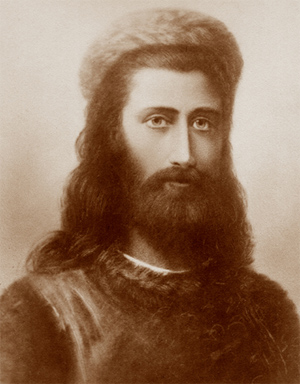
A portrait of Master Koot Hoomi by Hermann Schmiechen
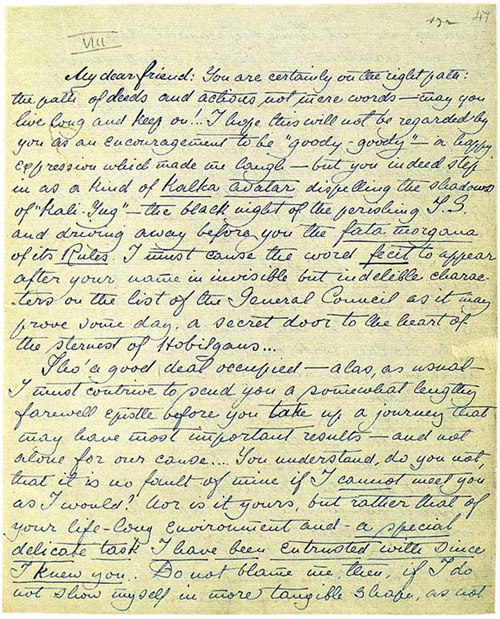
Facsimile (a fragment) of the 8th letter from the Koot Hoomi
Little descriptive references to K.H. occur in The Mahatma Letters to A. P. Sinnett and the writings of Mme. Blavatsky. The name Koot Hoomi seems to be a pseudonym. We find a reference to a "Rishi Kuthumi" in several Puranas, as for example in the Vishnu Purana (Book 3, Chapter 6) where he is said to be a pupil of Paushyinji. In reference to this Mme. Blavatsky wrote:
K.H.'s early letters to Sinnett are signed with the name Koot Hoomi Lal Sing. However, later in the correspondence, he says the "Lal Singh" was an addition made by his disciple Djwal Khool:
In an interview by Charles Johnston to H. P. Blavatsky, he described the handwriting of Master K.H. in the following way:
Master KH is said to live in a house in a ravine in Tibet, near the house of Master Morya. In 1881, Colonel Henry S. Olcott wrote to A. O. Hume:
Mme. Blavatsky, in a letter to Mary Hollis Billing[6] wrote:
This is confirmed by a reference given by Mahatma K. H. himself, in a letter to A. P. Sinnett:
C. W. Leadbeater described the physical appearance of Master KH as follows:
Education in Europe
Apparently before being an Adept, Master Koot Hoomi visited Europe and studied in some of the Universities there. Mme. Blavatsky said that Mahatma K.H. "is a Kashmiri Brahman by birth . . . and has travelled a good deal in Europe."[4]
Mr. A. O. Hume, in his "Hints on Esoteric Theosophy," wrote:
Master Morya referred to K.H. as "a fine scholar".[11] Master K.H. is alleged to have spoken English and French, which in one letter led Master M. to call him "Frenchified".[12]
K.H.'s retreat and initiation
Mme. Blavatsky in Oct 2, 1881 described this to Mrs. Mary Hollis Billing as follows:
Master Morya in a letter to A. P. Sinnett described K.H.'s retreat as follows:
Incarnations
The Master Kuthumi led a solitary lifestyle in His last incarnation. At the end of the nineteenth century, He ascended. The Teaching of the Ascended Masters speak of some of his previous incarnations by famous people.[14]
• Thutmose III
• Pythagoras
• Belshazzar
• Francis of Assisi
• Shah Jahan
• Merlin the Magician
Skepticism
There is skepticism about the existence of Koot Hoomi. Gordon Stein in his book Encyclopedia of Hoaxes has noted:
In 1884, Rev. George Patterson published an article "The Collapse of Koot Hoomi" which stated that Koot Hoomi did not exist.[15] Based on information he received from Emma Coulomb it was alleged that Hoomi was actually a dummy made from cloth with a painted face that her husband Alexis Coulomb wore on his shoulders at night. Blavatsky denied the accusations of fraud.[15]
Moncure D. Conway visited Blavatsky and investigated claims of the Mahatmas in 1884. He suggested that Hoomi was a fictitious creation of Blavatsky.[16] Conway wrote that Blavatsky "created the imaginary Koothoomi (originally Kothume) by piecing together parts of the names of her two chief disciples, Olcott and Hume."[17]
See also
• Ascended masters
• Alice A.Bailey
• Benjamin Creme
• Hodgson Report
• Initiation (Theosophy)
• K.H. Letters to C.W. Leadbeater
• Mahātmā
• Helena Roerich
• Theosophy
References
1. Stein, Gordon. (1993). Encyclopedia of Hoaxes. Gale Group. p. 224. ISBN 0-8103-8414-0
2. Blavatsky, H. P., Collected Writings vol. VI, (Adyar, Madras: Theosophical Publishing House, 1979), 41.
3. Hao Chin, Vic., Mahatma Letters to A. P. Sinnett No. 136, (Quezon City, Philippines: Theosophical Publishing House, 1993), 450.
4. Blavatsky, H. P., Collected Writings vol. VIII, (Adyar, Madras: Theosophical Publishing House, 1979), 399.
5. Hume, A. O., Hints on Esoteric Theosophy vol. 1 (Bombay, India: The Theosophical Society, 1882), 83
6. "Mary Hollis Billing - Theosophy Wiki". theosophy.wiki. Retrieved 2020-11-09.
7. Blavatsky, H.P., The Theosophical Forum (Point Loma, California: May 1936), 345.
8. Vicente Hao Chin, Jr., The Mahatma Letters to A.P. Sinnett in chronological sequence No. 5 (Quezon City: Theosophical Publishing House, 1993), ???.
9. Leadbeater, C. W., The Masters and the Path (Chicago: Theosophical Press, 1925), 38.
10. Hume, A. O., Hints on Esoteric Theosophy vol. 1 (Bombay, India: The Theosophical Society, 1882), 29
11. Hao Chin, Vic., Mahatma Letters to A. P. Sinnett No. 29, (Quezon City, Philippines: Theosophical Publishing House, 1993), 86.
12. Hao Chin, Vic., Mahatma Letters to A. P. Sinnett No. 26, (Quezon City, Philippines: Theosophical Publishing House, 1993), 83.
13. Hao Chin, Vic., Mahatma Letters to A. P. Sinnett No. 29, (Quezon City, Philippines: Theosophical Publishing House, 1993), 87.
14. Prophet, Mark. (2003). The masters and their retreats. Prophet, Elizabeth Clare., Booth, Annice. Corwin Springs, Mont.: Summit University Press. ISBN 0972040242. OCLC 53117044.
15. Fuller, Jean Overton. (1988). Blavatsky and Her Teachers: An Investigative Biography. East-West Publications. pp. 144-146
16. Conway, Moncure D. (1906). My Pilgrimage to the Wise Men of the East. Houghton, Mifflin and Company. pp. 201-202
17. Versluis, Arthur. (1993). American Transcendentalism and Asian Religions. Oxford University Press. p. 291. ISBN 0-19-507658-3
Further reading
• Moncure D. Conway. (1906). My Pilgrimage to the Wise Men of the East. Houghton, Mifflin and Company.
• Richard Hodgson. (1885). Account of Personal Investigations in India and Discussion of the Authorship of the “Koot Hoomi” Letters. Proceedings of the Society for Psychical Research 3: 207-380.
• Jeffrey D. Lavoie. (2012). The Theosophical Society: The History of a Spiritualist Movement. Brown Walker Press.
External links
• Echoes of the Past: Master Koot Hoomi by Mary K. Neff
• Where was the "Ravine in Tibet"? by Daniel H. Caldwell
• The Collapse of Koot Hoomi by Rev. George Patterson
by Wikipedia
Accessed: 3/21/21
-- Koot Hoomi, by Theosophy Wiki
-- Nisi Kanta Chattopadhyaya, by Theosophy Wiki
-- Chapter II: The Origin of the Yatra [Excerpt from The Bengali Drama: It's Origin and Development], by P Guha-Thakurta
-- Retrospect of the Year 1876-7, Excerpt from The Brahmo Year-Book for 1877: Brief Records of Work and Life in the Theistic Churches of India, edited by Sophia Dobson Collet
-- Personal Intelligence, from Journal of the National Indian Association in Aid of Social Progress and Female Education in India, by Sir M. Monier-Williams, KCIE
-- 1879, Excerpt from Masters and Men: The Human Story in the Mahatma Letters (a fictionalized account), by Virginia Hanson
-- Gustav Theodor Fechner, by Theosophy Wiki
-- Gustav Fechner, by Wikipedia
Koot Hoomi (also spelled Kuthumi, and frequently referred to simply as K.H.) is said to be one of the Mahatmas that inspired the founding of the Theosophical Society in 1875. He engaged in a correspondence with two English Theosophists living in India, A. P. Sinnett and A. O. Hume, which correspondence was published in the book The Mahatma Letters to A. P. Sinnett.
Skeptics have described Koot Hoomi and the other Mahatmas as a hoax.[1]
Personal features

A portrait of Master Koot Hoomi by Hermann Schmiechen

Facsimile (a fragment) of the 8th letter from the Koot Hoomi
Little descriptive references to K.H. occur in The Mahatma Letters to A. P. Sinnett and the writings of Mme. Blavatsky. The name Koot Hoomi seems to be a pseudonym. We find a reference to a "Rishi Kuthumi" in several Puranas, as for example in the Vishnu Purana (Book 3, Chapter 6) where he is said to be a pupil of Paushyinji. In reference to this Mme. Blavatsky wrote:
The name of Rishi Koothumi is mentioned in more than one Purana, and his Code is among the 18 Codes written by the various Rishis and preserved at Calcutta in the library of the Asiatic Society. But we have not been told whether there is any connection between our Mahatma of that name, and the Rishi, and we do not feel justified in speculating upon the subject. All we know is, that both are Northern Brahmans, while the Môryas are Kshatriyas.[2]
K.H.'s early letters to Sinnett are signed with the name Koot Hoomi Lal Sing. However, later in the correspondence, he says the "Lal Singh" was an addition made by his disciple Djwal Khool:
Why have you printed The Occult World before sending it to me for revision? I would have never allowed the passage to pass; nor the "Lal Sing" either foolishly invented as half a nom de plume by Djwal K. and carelessly allowed by me to take root without thinking of the consequences. . .[3]
In an interview by Charles Johnston to H. P. Blavatsky, he described the handwriting of Master K.H. in the following way:
. . . evidently a man of very gentle and even character, but of tremendously strong will; logical, easy-going, and taking endless pains to make his meaning clear. It was altogether the handwriting of a cultivated and very sympathetic man.[4]
Master KH is said to live in a house in a ravine in Tibet, near the house of Master Morya. In 1881, Colonel Henry S. Olcott wrote to A. O. Hume:
I have also personally known [Master Koot Hoomi] since 1875. He is of quite a different, a gentler, type, yet the bosom friend of the other [Master Morya]. They live near each other with a small Buddhist Temple about midway between their houses. In New York, I had . . . and a colored sketch on China silk of the landscape near [Koot Hoomi]'s and my Chohan's residences with a glimpse of the latter’s house and of part of the little temple.[5]
Mme. Blavatsky, in a letter to Mary Hollis Billing[6] wrote:
Now Morya lives generally with Koot-Hoomi who has his house in the direction of the Kara Korum [Karakoram] Mountains, beyond Ladak, which is in Little Tibet and belongs now to Kashmire. It is a large wooden building in the Chinese fashion pagoda-like, between a lake and a beautiful mountain. . . .[7]
This is confirmed by a reference given by Mahatma K. H. himself, in a letter to A. P. Sinnett:
I was coming down the defiles of Kouenlun — Karakorum you call them . . . and was crossing over to Lhadak on my way home.[8]
C. W. Leadbeater described the physical appearance of Master KH as follows:
The Master Kuthumi wears the body of a Kashmiri Brahman, and is as fair in complexion as the average Englishman. He, too, has flowing hair, and His eyes are blue and full of joy and love. His hair and beard are brown, which, as the sunlight catches it, becomes ruddy with glints of gold. His face is somewhat hard to describe, for His expression is ever changing as He smiles; the nose is finely chiselled, and the eyes are large and of a wonderful liquid blue.[9]
Education in Europe
Apparently before being an Adept, Master Koot Hoomi visited Europe and studied in some of the Universities there. Mme. Blavatsky said that Mahatma K.H. "is a Kashmiri Brahman by birth . . . and has travelled a good deal in Europe."[4]
Mr. A. O. Hume, in his "Hints on Esoteric Theosophy," wrote:
Take a case said to have occurred many years ago in Germany, in which a Brother, who has corresponded with us, is said to have taken part. He was at this time a student, and though in course of preparation was not then himself an Adept, but was, like all regular chelas, under the special charge of an Adept. A young friend of his was accused of forgery, and tried for the same. Our Brother, then a student as above explained, was called as a witness to prove his friend's handwriting; the case was perfectly clear and a conviction certain. Through his mentor, our Brother learnt that his accused friend did not really deserve punishment that would necessarily fall on him, and which would have ruined not only him, but other innocent persons dependent on him. He had really committed a forgery but not knowingly or meaningly, though it was impossible to show this. So when the alleged forged document was handed to the witness, he merely said: "I see nothing written here," and returned the deed blank. His mentor had caused the entire writing to disappear. It was supposed that a wrong paper had been by mistake handed to the witness; search was made high and low, but the deed never appeared, and the accused was perforce acquitted.[10]
Master Morya referred to K.H. as "a fine scholar".[11] Master K.H. is alleged to have spoken English and French, which in one letter led Master M. to call him "Frenchified".[12]
K.H.'s retreat and initiation
Mme. Blavatsky in Oct 2, 1881 described this to Mrs. Mary Hollis Billing as follows:
K. H. or Koot-Hoomi is now gone to sleep for three months to prepare during this Sumadhi or continuous trance state for his initiation, the last but one, when he will become one of the highest adepts. Poor K. H. his body is now lying cold and stiff in a separate square building of stone with no windows or doors in it, the entrance to which is effected through an underground passage from a door in Toong-ting (reliquary, a room situated in every Thaten (temple) or Lamisery; and his Spirit is quite free. An adept might lie so for years, when his body was carefully prepared for it beforehand by mesmeric passes etc. It is a beautiful spot where he is now in the square tower. The Himalayas on the right and a lovely lake near the lamisery. His Cho-han (spiritual instructor, master, and the Chief of a Tibetan Monastery takes care of his body. M . . also goes occasionally to visit him. It is an awful mystery that state of cataleptic sleep for such a length of time. . .[7]
Master Morya in a letter to A. P. Sinnett described K.H.'s retreat as follows:
At a certain spot not to be mentioned to outsiders, there is a chasm spanned by a frail bridge of woven grasses and with a raging torrent beneath. The bravest member of your Alpine clubs would scarcely dare to venture the passage, for it hangs like a spider’s web and seems to be rotten and impassable. Yet it is not; and he who dares the trial and succeeds — as he will if it is right that he should be permitted — comes into a gorge of surpassing beauty of scenery — to one of our places and to some of our people, of which and whom there is no note or minute among European geographers. At a stone’s throw from the old Lamasery stands the old tower, within whose bosom have gestated generations of Bodhisatwas. It is there, where now rests your lifeless friend — my brother, the light of my soul, to whom I made a faithful promise to watch during his absence over his work.[13]
Incarnations
The Master Kuthumi led a solitary lifestyle in His last incarnation. At the end of the nineteenth century, He ascended. The Teaching of the Ascended Masters speak of some of his previous incarnations by famous people.[14]
• Thutmose III
• Pythagoras
• Belshazzar
• Francis of Assisi
• Shah Jahan
• Merlin the Magician
Skepticism
There is skepticism about the existence of Koot Hoomi. Gordon Stein in his book Encyclopedia of Hoaxes has noted:
"There were flaws in Blavatsky's work. Koot Hoomi, for example, claimed to have been an Indian (not a Tibetan) who studied in Germany. Yet he did not speak German, Hindi, or Punjabi. He spoke French and English, but wrote them using the overlined characteristic of Russians who write in English or French. The other Mahatma, Master Morya, had a weakness for pipe smoking, something that was strictly forbidden in Tibet. Both these Masters supposedly lived in Tibet. Other inconsistencies obvious now, were not enough to alert Sinnett that he was being hoaxed."[1]
In 1884, Rev. George Patterson published an article "The Collapse of Koot Hoomi" which stated that Koot Hoomi did not exist.[15] Based on information he received from Emma Coulomb it was alleged that Hoomi was actually a dummy made from cloth with a painted face that her husband Alexis Coulomb wore on his shoulders at night. Blavatsky denied the accusations of fraud.[15]
Moncure D. Conway visited Blavatsky and investigated claims of the Mahatmas in 1884. He suggested that Hoomi was a fictitious creation of Blavatsky.[16] Conway wrote that Blavatsky "created the imaginary Koothoomi (originally Kothume) by piecing together parts of the names of her two chief disciples, Olcott and Hume."[17]
See also
• Ascended masters
• Alice A.Bailey
• Benjamin Creme
• Hodgson Report
• Initiation (Theosophy)
• K.H. Letters to C.W. Leadbeater
• Mahātmā
• Helena Roerich
• Theosophy
References
1. Stein, Gordon. (1993). Encyclopedia of Hoaxes. Gale Group. p. 224. ISBN 0-8103-8414-0
2. Blavatsky, H. P., Collected Writings vol. VI, (Adyar, Madras: Theosophical Publishing House, 1979), 41.
3. Hao Chin, Vic., Mahatma Letters to A. P. Sinnett No. 136, (Quezon City, Philippines: Theosophical Publishing House, 1993), 450.
4. Blavatsky, H. P., Collected Writings vol. VIII, (Adyar, Madras: Theosophical Publishing House, 1979), 399.
5. Hume, A. O., Hints on Esoteric Theosophy vol. 1 (Bombay, India: The Theosophical Society, 1882), 83
6. "Mary Hollis Billing - Theosophy Wiki". theosophy.wiki. Retrieved 2020-11-09.
7. Blavatsky, H.P., The Theosophical Forum (Point Loma, California: May 1936), 345.
8. Vicente Hao Chin, Jr., The Mahatma Letters to A.P. Sinnett in chronological sequence No. 5 (Quezon City: Theosophical Publishing House, 1993), ???.
9. Leadbeater, C. W., The Masters and the Path (Chicago: Theosophical Press, 1925), 38.
10. Hume, A. O., Hints on Esoteric Theosophy vol. 1 (Bombay, India: The Theosophical Society, 1882), 29
11. Hao Chin, Vic., Mahatma Letters to A. P. Sinnett No. 29, (Quezon City, Philippines: Theosophical Publishing House, 1993), 86.
12. Hao Chin, Vic., Mahatma Letters to A. P. Sinnett No. 26, (Quezon City, Philippines: Theosophical Publishing House, 1993), 83.
13. Hao Chin, Vic., Mahatma Letters to A. P. Sinnett No. 29, (Quezon City, Philippines: Theosophical Publishing House, 1993), 87.
14. Prophet, Mark. (2003). The masters and their retreats. Prophet, Elizabeth Clare., Booth, Annice. Corwin Springs, Mont.: Summit University Press. ISBN 0972040242. OCLC 53117044.
15. Fuller, Jean Overton. (1988). Blavatsky and Her Teachers: An Investigative Biography. East-West Publications. pp. 144-146
16. Conway, Moncure D. (1906). My Pilgrimage to the Wise Men of the East. Houghton, Mifflin and Company. pp. 201-202
17. Versluis, Arthur. (1993). American Transcendentalism and Asian Religions. Oxford University Press. p. 291. ISBN 0-19-507658-3
Further reading
• Moncure D. Conway. (1906). My Pilgrimage to the Wise Men of the East. Houghton, Mifflin and Company.
• Richard Hodgson. (1885). Account of Personal Investigations in India and Discussion of the Authorship of the “Koot Hoomi” Letters. Proceedings of the Society for Psychical Research 3: 207-380.
• Jeffrey D. Lavoie. (2012). The Theosophical Society: The History of a Spiritualist Movement. Brown Walker Press.
External links
• Echoes of the Past: Master Koot Hoomi by Mary K. Neff
• Where was the "Ravine in Tibet"? by Daniel H. Caldwell
• The Collapse of Koot Hoomi by Rev. George Patterson
- admin
- Site Admin
- Posts: 36135
- Joined: Thu Aug 01, 2013 5:21 am
Re: Freda Bedi Cont'd (#3)
Koot Hoomi
by Theosophy Wiki
Accessed: 3/20/21

Portrait of Mahatma Koot Hoomi by H. Schmiechen
Koot Hoomi (also spelled Kuthumi, and frequently referred to simply as K.H.) is one of the Mahatmas that inspired the founding of the Theosophical Society. He engaged in a correspondence with two English Theosophists living in India, A. P. Sinnett and A. O. Hume, correspondence was published in the book The Mahatma Letters to A. P. Sinnett.
Personal features
Few descriptive references to K.H. occur in The Mahatma Letters to A. P. Sinnett and the writings of Mme. Blavatsky. The name Koot Hoomi seems to be a pseudonym. We find a reference to a "Rishi Kuthumi" in several Puranas, as for example in the Vishnu Purana (Book 3, Chapter 6) where he is said to be a pupil of Paushyinji. In reference to this Mme. Blavatsky wrote:
K.H.'s early letters to Sinnett are signed with the name Koot Hoomi Lal Sing. However, later in the correspondence, he says the "Lal Singh" was an addition made by his disciple Djwal Khool:
The word "Lal" is mostly used in Chitral (now in Pakistan) as surname or "Title name", meaning "Tribe Chief". "Singh" is a common title, middle name, or surname originally used by the Hindu Kshatriyas (warriors and kings). It is used as a surname or middle name by Sikhs, and Hindu communities like Rajputs, Marathas, Jats, Yadavs and Ahirs among other.
In an interview by Charles Johnston to H. P. Blavatsky, he described the handwriting of Master K.H. in the following way:
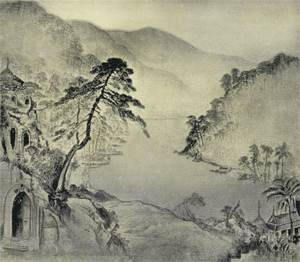
Master KH is said to live in a house in a ravine in Tibet, near the house of Master Morya. In 1881, Colonel Henry S. Olcott wrote to A. O. Hume:
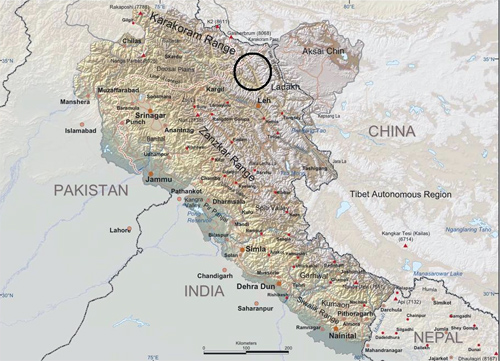
Mme. Blavatsky, in a letter to Mrs. Hollis Billings wrote:
This is confirmed by a reference given by Mahatma K. H. himself, in a letter to A. P. Sinnett:
Account by C. W. Leadbeater
C. W. Leadbeater described the physical appearance of Master KH in this way:
Education in Europe
Apparently before being an Adept, Master Koot Hoomi visited Europe and studied in some of the Universities there. Mme. Blavatsky said that Mahatma K.H. "is a Kashmiri Brahman by birth . . . and has travelled a good deal in Europe."[8]
Mr. A. O. Hume, in his "Hints on Esoteric Theosophy," wrote:
Maybe it is because of this that the Master Morya refers to K.H. as "a fine scholar".[10] Master K.H. speaks English and French well, which in one letter led Master M. to call him "Frenchified". [11]. He probably knew German also.
In a letter received by Mr. Sinnett on July 5, 1881, Master K.H. wrote:
In 1883, C. C. Massey, leader of the British Theosophists, tried to test this evidence of the existence of the Mahatmas by writing to Dr. Hugo Wernekke, who lived at Weimar, Germany, and was in touch with a Professor Gustav T. Fechner. He wanted "to find out whether Professor Fechner ever had such a conversation with an Oriental." The answer from Professor G. T. Fechner to Dr. Hugo Wernekke dated "Leipzig, April 25th, 1883" said:
C. C. Massey wrongly assumed that Nisi Kanta Chattopadhyaya was a pseudonym used by Master K.H., although the former was a well-known Indian gentleman.
Travels
Koot Hoomi traveled widely, as documented by Mary K. Neff:[14]
• 1870s - student in Europe - Leipzig, Zurich, Wurzburg
• 1880 - Toling, in western Tibet; Kashmir; Karakorum, in Mongolia
• 1881 - Tirich Mir, a mountain in the Hindu Kush range; Sakkya-Jung, Ghalaring-Tho Lamasery, and Horpa Pa La, in unknown territory
• 1882 - Unknown location of KH's retreat; Himalayan lamasery near Darjeeling
• 1883 - extended tour of Asia; Lake Manasarovara in the Himalayas; Lahore; Kashmir; Madras; Singapore; Ceylon; Burma; Mysore; Sanangerri (unknown location); China; Cambodia
Travel was difficult. KH wrote in Mahatma Letter No. 20, "I hope these disjointed reflections may be pardoned in one who remained for over nine days in his stirrups without dismounting."
K.H.'s retreat and initiation
On Oct 2, 1881, Mme. Blavatsky described this to Mrs. Hollis Billings as follows:
Master Morya in a letter to A. P. Sinnett described K.H.'s retreat as follows:
In another letter, Mme. Blavatsky writes:
Writings
K.H. was an excellent writer. In addition to his extensive correspondence, he provided articles and guidance to several periodicals.
Letters written by K.H.
K. H. had the assignment to educate two English Theosophists living in India, A. P. Sinnett and A. O. Hume, and this primarily took the form of correspondence that was published in the book The Mahatma Letters to A. P. Sinnett. In addition, letters to H. P. Blavatsky, Colonel Olcott, and many others were published in Letters from the Masters of the Wisdom.
For a list of Master K. H.'s letters that were published in these sources, see Category:ML from Koot Hoomi. There are 195 letters in all, which were typically written in blue ink. His writing demonstrates a wide knowledge of religion, science, literature, and current affairs, and frequently includes phrases in Latin and French.
Involvement in periodicals
He took a keen interest in The Theosophist, and wrote many articles. He "exercised a constant and varied supervision, from proof reading to furnishing material for articles and substance for replies to enquiring or controversial letters, when not writing them himself."[17] KH was also heavily involved in planning for the establishment of A. P. Sinnett's proposed daily Indian newspaper, The Phoenix, but funding for the venture was never sufficient.
Samples of signature
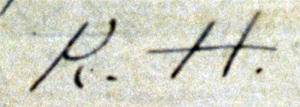
Initials from Mahatma Letter No. 74
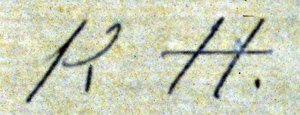
Initials from Mahatma Letter No. 98

Signature from Mahatma Letter No. 2
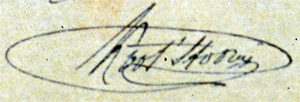
Signature from Mahatma Letter No. 9
Online resources
Articles
• Where was the "Ravine in Tibet"? by Daniel H. Caldwell
• K.H. and the Kadampas by Jacques Mahnich
• Echoes of the Past: Master Koot Hoomi by Mary K. Neff
Notes
1. H. P. Blavatsky, Collected Writings vol. VI, (Adyar, Madras: Theosophical Publishing House, 1979), 41.
2. Vicente Hao Chin, Jr., ed., Mahatma Letters to A. P. Sinnett in Chronological Sequence No. 136, (Quezon City, Phillipines: Theosophical Publishing House, 1993), 450. See Mahatma Letter No. 136 page 10.
3. H. P. Blavatsky, Collected Writings vol. VIII, (Adyar, Madras: Theosophical Publishing House, 1979), 399.
4. A. O. Hume, Hints on Esoteric Theosophy vol. 1 (Bombay, India: The Theosophical Society, 1882), 83.
5. H. P. Blavatsky, The Theosophical Forum (May, 1936), 345.
6. Vicente Hao Chin, Jr., The Mahatma Letters to A.P. Sinnett in Chronological Sequence No. 5 (Quezon City: Theosophical Publishing House, 1993), 15. See Mahatma Letter No. 5 page 2.
7. C. W. Leadbeater, The Masters and the Path (Chicago: Theosophical Press, 1925), 38.
8. H. P. Blavatsky, Collected Writings vol. VIII, (Adyar, Madras: Theosophical Publishing House, 1979), 399.
9. A. O. Hume, Hints on Esoteric Theosophy vol. 1 (Bombay, India: The Theosophical Society, 1882), 29.
10. Vicente Hao Chin, Jr., ed., Mahatma Letters to A. P. Sinnett in Chronological Sequence No. 29, (Quezon City, Phillipines: Theosophical Publishing House, 1993), 86. See Mahatma Letter No. 29 page 1.
11. Vicente Hao Chin, Jr., ed., Mahatma Letters to A. P. Sinnett in Chronological Sequence No. 26, (Quezon City, Phillipines: Theosophical Publishing House, 1993), 83. See Mahatma Letter No. 26 page 1.
12. Vicente Hao Chin, Jr., ed., Mahatma Letters to A. P. Sinnett in Chronological Sequence No. 18, (Quezon City, Phillipines: Theosophical Publishing House, 1993), 63. See Mahatma Letter No. 18 page 13-14.
13. See "Echoes of the Past: Master Koot Hoomi" by Mary K. Neff at http://www.blavatskyarchives.com/neffkoothoomi.htm
14. Mary K. Neff, The "Brothers" of Madame Blavatsky (Adyar, Madras, India: Theosophical Publishing House, 1932), 63-79. Quoting from Introduction to Letters of H. P. Blavatsky to A. P. Sinnett, The Mahatma Letters to A. P. Sinnett, and other sources.
15. H. P. Blavatsky, The Theosophical Forum (Point Loma, California: May 1936), 345.
16. Vicente Hao Chin, Jr., ed., Mahatma Letters to A. P. Sinnett in Chronological Sequence No. 29, (Quezon City, Phillipines: Theosophical Publishing House, 1993), 87. See Mahatma Letter No. 29 page 4.
17. Mary K. Neff, The "Brothers" of Madame Blavatsky (Adyar, Madras, India: Theosophical Publishing House, 1932), 22. See Chapter III, pages 22-33.
***********************
Nisi Kanta Chattopadhyaya
by Theosophy Wiki
Accessed: 3/20/21
Nishikânta Chattopâdhyâya (1852-1910) was a well-known Hindu gentleman, Principal of the Hyderabad College and author of works on Oriental, Theosophical, philosophical, and other subjects. His name was erroneously thought to have been a pseudonym used by Master K.H. in Europe.
Personal life and education
Little is known of the life of Nishikânta Chattopâdhyâya. He was educated in Europe:
Confusion with Master K.H.
In The Mahatma Letters, Master K.H. mentions a conversation he had with a certain "G. H. Fechner." Trying to verify this statement, C. C. Massey wrote to Dr. Hugo Wernekke, at Weimar, Germany, inquiring "whether Professor Fechner ever had such a conversation with an Oriental whom we could thus identify with Koot Humi." He received the following answer from Professor Gustav T. Fechner:
C. C. Massey assumed that "Nisi Kanta Chattapadhyaya" was a pseudonym used by Master K.H. However, this is not the case. Charles J. Ryan reports[3] that Katherine Tingley met Dr. N. K. Chattopadhyaya when she was in Bombay in 1896, and received an autograph copy of his book, "The Reminiscences of the German University Life,"[4] where he talks about his encounter with Prof. G. T. Fechner.
Writings
• The Yatras, or the Popular Dramas of Bengal. Ca. 1882. 16 editions published between 1882 and 1976 in English.
• Buddhism and Christianity, with an Appendix on Nirvana. London, 1882. 24 pages. Translated from the German in Indische Essays. The German edition Buddhismus und Christenthum. Mit einem Anhang über das Nirvâna was also published in 1882.
• Indische Essays. Zurich, 1883. Five editions published in 1883 in German and other languages.
• Three Lectures: the Reminiscences of the German University Life ; The True Theosophist ; and the Mricchakatikam, or, The Toy Cart. [Erscheinungsort nicht ermittelbar]: [Verlag nicht ermittelbar], gedr. 1895. 89 pages. Two editions published in 1895 in English.
• "Reminiscences of German University Life": a lecture delivered on the 30th April, 1892. 1901 in English.
• "The True Theosophist, or, Moral and Spiritual Culture: a Lecture". 1892 in English.
• "Mricchakatika or, The toy-cart of King Sūdraka; a study". Mysore: Graduates' Trading Association Press, 1902. English.
• The Mystic Story of Peter Schlemihl. Written with Adelbert von Chamisso. Mysore: Graduates' Trading Association Press, 1902.
• Lecture on Zoroastrianism. 1894. Madras: The Theosophist Office, 1906. English.
• Why Have I Accepted Islam. Two editions published in 1971 in English. Also published in Chicago, IL: Kazi Publications, [between 1980 and 1997].
• Social and Religious Reformation in India : a lecture delivered in the Rungacharlu Memorial Hall, Mysore, on November 27th, 1901. [Mysore], 1901. English.
• The Study of History: a lecture. 1902 in English.
• Notices and Reviews of Dr. Nishikanta Chattopádhyáya's Lectures. 1897 in English. [With a preface signed: Akhil Chandra Mukerjee.]
• Muhammed, "the Prophet of Islam": a lecture delivered on the 25th of November 1904, at the residence of Mirza Faiaz Ali Khan, Chudderghat, Hyderabad, Deccan. 1900. Sultanpura, Hyderabad: Villa Academy, 1971. English. 36 pages.
• Christ in the Koran. Allahabad: Indian Press, 1907. English.
• Two Essays on the Life and Philosophy of Ibn-Rushd or Averroes. Allahabad : M. Ghulam Muhammad, 1909.
Additional resources
• "The Identity of Koot Hoomi of Kashmir" blog entry from the American Minervan. Accessed Jun 14, 2019.
Notes
1. National Indian Association, Journal of the National Indian Association (1883), 128.
2. Echoes of the Past: Master Koot Hoomi by Mary K. Neff
3. An Important Correction by Charles J. Ryan
4. Three Lectures : the Reminiscences of the German University Life ; The True Theosophist ; and the Mricchakatikam, or, The Toy Cart by Nishikânta Chattopâdhyâya
***********************
Gustav Theodor Fechner
by Theosophy Wiki
Accessed: 3/20/21
Gustav Theodor Fechner (April 19, 1801 – November 18, 1887), was a German experimental psychologist interested in Spiritualism.
Mahatama Letters reference
Gustav Theodor Fechner may have been the "G. H. Fechner" mentioned by Master K.H. in one of his letters:
The ideas quoted in this Letter had been reported in the The N. Y. Nation, as follows:
When Prof. Fechner was asked about having met a Hindu at Leipzig, he said he did, although clarified that the name of the Hindu concerned was Nisi Kanta Chattopadhyaya, not Koot Hoomi. Some Theosophists thought this was a pseudonym used by Master K.H. However, this was not the case, according to Charles J. Ryan in an article published in The Canadian Theosophist[3]
See also Koot Hoomi: Education in Europe for more about Fechner.
Review by William James
William James wrote an insightful article about the philosophy of G. T. Fechner, entitled "The Doctrine of the Earth-Soul and of Beings Intermediate Between Man and God." [The Doctrine of the Earth-Soul and of Beings intermediate between Man and God, by William James, Hibbert Journal 7:278 (1908)] This review of the article appeared in The Theosophic Messenger in 1909:
Writings
On Life After Death. Chicago: The Open Court Publishing Company, 1917. 3rd edition.
Additional resources
• James, William. "The Doctrine of the Earth-Soul and of Beings Intermediate Between Man and God." Hibbert Journal VII (January, 1909), 278.
1. Theosophy Wiki Mahatma Letter No. 18, pages 13-14.
2. The N. Y. Nation, Oct. 2, 1879, p. 229.
3. Charles J. Ryan, "An Important Correction" The Canadian Theosophist (December 15, 1936), 326-329. See also Cox's work, Who Wrote the March-Hare Attack on the Mahatma Letters? Victoria, British Columbia, Canada: H.P.B. Library, 1936, reprinted here at the Blavatsky Archives website.
4. "Current Literature" The Theosophic Messenger 10.6 (March, 1909), 259-260. Review of article by William James, "The Doctrine of the Earth-Soul and of Beings Intermediate Between Man and God" Hibbert Journal VII (January, 1909), 278. See Internet Archive for Hibbert Journal VII.
by Theosophy Wiki
Accessed: 3/20/21
Sumantu, son of Jaimini, studied the Samaveda, or Ch'handigya, under his father: and his own son, Sucarman, studied under the same teacher, but founded a different school; which was the origin of two others, derived from his pupils, Hiranyanabha and Paushyinji, and thence branching into a thousand more: for Locacshi, Cut’humi, and other disciples of Paushyinji, gave their names to separate schools, which were increased by their pupils. The 'Sac'ha entitled Caut'humi still subsists. Hiranyanabha, the other pupil of Sucarman, had fifteen disciples, authors of Sanhitas, collectively called the northern Samagas; and fifteen others, entitled the southern Samagas: and Criti, one of his pupils, had twenty-four disciples, by whom, and by their followers, the other schools were founded. Most of them are now lost; and, according to a legend, were destroyed by the thunderbolt of Indra. The principal 'Sac'ha now subsisting is that of Ranayaniyas, including seven subdivisions; one of which is entitled Caut'humi, as above-mentioned, and comprehends six distinct schools. That of the Talavacaras, likewise, is extant, at least, in part: as will be shown in speaking of the Upanishads.
-- Essays on the Religion and Philosophy of the Hindus, by Henry Thomas Colebrooke, Esq.

Portrait of Mahatma Koot Hoomi by H. Schmiechen
Koot Hoomi (also spelled Kuthumi, and frequently referred to simply as K.H.) is one of the Mahatmas that inspired the founding of the Theosophical Society. He engaged in a correspondence with two English Theosophists living in India, A. P. Sinnett and A. O. Hume, correspondence was published in the book The Mahatma Letters to A. P. Sinnett.
Personal features
Few descriptive references to K.H. occur in The Mahatma Letters to A. P. Sinnett and the writings of Mme. Blavatsky. The name Koot Hoomi seems to be a pseudonym. We find a reference to a "Rishi Kuthumi" in several Puranas, as for example in the Vishnu Purana (Book 3, Chapter 6) where he is said to be a pupil of Paushyinji. In reference to this Mme. Blavatsky wrote:
The name of Rishi Koothumi is mentioned in more than one Purana, and his Code is among the 18 Codes written by the various Rishis and preserved at Calcutta in the library of the Asiatic Society.[??] But we have not been told whether there is any connection between our Mahatma of that name, and the Rishi, and we do not feel justified in speculating upon the subject. All we know is, that both are Northern Brahmans, while the Môryas are Kshatriyas.[1]
K.H.'s early letters to Sinnett are signed with the name Koot Hoomi Lal Sing. However, later in the correspondence, he says the "Lal Singh" was an addition made by his disciple Djwal Khool:
Why have you printed the Occult World before sending it to me for revision? I would have never allowed the passage to pass; nor the "Lal Sing" either foolishly invented as half a nom de plume by Djwal K. and carelessly allowed by me to take root without thinking of the consequences. . .[2]
The word "Lal" is mostly used in Chitral (now in Pakistan) as surname or "Title name", meaning "Tribe Chief". "Singh" is a common title, middle name, or surname originally used by the Hindu Kshatriyas (warriors and kings). It is used as a surname or middle name by Sikhs, and Hindu communities like Rajputs, Marathas, Jats, Yadavs and Ahirs among other.
In an interview by Charles Johnston to H. P. Blavatsky, he described the handwriting of Master K.H. in the following way:
. . . evidently a man of very gentle and even character, but of tremendously strong will; logical, easy-going, and taking endless pains to make his meaning clear. It was altogether the handwriting of a cultivated and very sympathetic man.[3]

Master KH is said to live in a house in a ravine in Tibet, near the house of Master Morya. In 1881, Colonel Henry S. Olcott wrote to A. O. Hume:
I have also personally known [Master Koot Hoomi] since 1875. He is of quite a different, a gentler, type, yet the bosom friend of the other [Master Morya]. They live near each other with a small Buddhist Temple about midway between their houses. In New York, I had . . . a colored sketch on China silk of the landscape near [Koot Hoomi]'s and my Chohan's residences with a glimpse of the latter’s house and of part of the little temple.[4]

Mme. Blavatsky, in a letter to Mrs. Hollis Billings wrote:
Now Morya lives generally with Koot-Hoomi who has his house in the direction of the Kara Korum [Karakoram] Mountains, beyond Ladak, which is in Little Tibet and belongs now to Kashmire. It is a large wooden building in the Chinese fashion pagoda-like, between a lake and a beautiful mountain. . . .[5]
This is confirmed by a reference given by Mahatma K. H. himself, in a letter to A. P. Sinnett:
I was coming down the defiles of Kouenlun — Karakorum you call them . . . and was crossing over to Lhadak on my way home.[6]
Account by C. W. Leadbeater
C. W. Leadbeater described the physical appearance of Master KH in this way:
The Master Kuthumi wears the body of a Kashmiri Brahman, and is as fair in complexion as the average Englishman. He, too, has flowing hair, and His eyes are blue and full of joy and love. His hair and beard are brown, which, as the sunlight catches it, becomes ruddy with glints of gold. His face is somewhat hard to describe, for His expression is ever changing as He smiles; the nose is finely chiselled, and the eyes are large and of a wonderful liquid blue.[7]
29. Eyes deep blue
-- -- Physical characteristics of the Buddha, by Wikipedia
Education in Europe
Apparently before being an Adept, Master Koot Hoomi visited Europe and studied in some of the Universities there. Mme. Blavatsky said that Mahatma K.H. "is a Kashmiri Brahman by birth . . . and has travelled a good deal in Europe."[8]
Mr. A. O. Hume, in his "Hints on Esoteric Theosophy," wrote:
Take a case said to have occurred many years ago in Germany, in which a Brother, who has corresponded with us, is said to have taken part. He was at this time a student, and though in course of preparation was not then himself an Adept, but was, like all regular chelas, under the special charge of an Adept. A young friend of his was accused of forgery, and tried for the same. Our Brother, then a student as above explained, was called as a witness to prove his friend's handwriting; the case was perfectly clear and a conviction certain. Through his mentor, our Brother learnt that his accused friend did not really deserve punishment that would necessarily fall on him, and which would have ruined not only him, but other innocent persons dependent on him. He had really committed a forgery but not knowingly or meaningly, though it was impossible to show this. So when the alleged forged document was handed to the witness, he merely said: "I see nothing written here," and returned the deed blank. His mentor had caused the entire writing to disappear. It was supposed that a wrong paper had been by mistake handed to the witness; search was made high and low, but the deed never appeared, and the accused was perforce acquitted.[9]
Maybe it is because of this that the Master Morya refers to K.H. as "a fine scholar".[10] Master K.H. speaks English and French well, which in one letter led Master M. to call him "Frenchified". [11]. He probably knew German also.
In a letter received by Mr. Sinnett on July 5, 1881, Master K.H. wrote:
I may answer you, what I said to G. H. Fechner one day, when he wanted to know the Hindu view on what he had written — "You are right;... ‘every diamond, every crystal, every plant and star has its own individual soul, besides man and animal...’ and, ‘there is a hierarchy of souls from the lowest forms of matter up to the World Soul,’ but you are mistaken when adding to the above the assurance that ‘the spirits of the departed hold direct psychic communication with Souls that are still connected with a human body’ — for, they do not."[12]
In 1883, C. C. Massey, leader of the British Theosophists, tried to test this evidence of the existence of the Mahatmas by writing to Dr. Hugo Wernekke, who lived at Weimar, Germany, and was in touch with a Professor Gustav T. Fechner. He wanted "to find out whether Professor Fechner ever had such a conversation with an Oriental." The answer from Professor G. T. Fechner to Dr. Hugo Wernekke dated "Leipzig, April 25th, 1883" said:
What Mr. Massey enquires about is undoubtedly in the main correct; the name of the Hindu concerned, when he was in Leipzig, was however, Nisi Kanta Chattopadhyaya, not Koot Humi. In the middle of the seventies he lived for about one year in Leipzig and aroused a certain interest owing to his foreign nationality, without being otherwise conspicuous; he was introduced to several families and became a member of the Academic Philosophical Society, to which you also belonged, where on one occasion he gave a lecture on Buddhism.[13]
C. C. Massey wrongly assumed that Nisi Kanta Chattopadhyaya was a pseudonym used by Master K.H., although the former was a well-known Indian gentleman.
Travels
Koot Hoomi traveled widely, as documented by Mary K. Neff:[14]
• 1870s - student in Europe - Leipzig, Zurich, Wurzburg
• 1880 - Toling, in western Tibet; Kashmir; Karakorum, in Mongolia
• 1881 - Tirich Mir, a mountain in the Hindu Kush range; Sakkya-Jung, Ghalaring-Tho Lamasery, and Horpa Pa La, in unknown territory
• 1882 - Unknown location of KH's retreat; Himalayan lamasery near Darjeeling
• 1883 - extended tour of Asia; Lake Manasarovara in the Himalayas; Lahore; Kashmir; Madras; Singapore; Ceylon; Burma; Mysore; Sanangerri (unknown location); China; Cambodia
Travel was difficult. KH wrote in Mahatma Letter No. 20, "I hope these disjointed reflections may be pardoned in one who remained for over nine days in his stirrups without dismounting."
K.H.'s retreat and initiation
On Oct 2, 1881, Mme. Blavatsky described this to Mrs. Hollis Billings as follows:
K. H. or Koot-Hoomi is now gone to sleep for three months to prepare during this Sumadhi or continuous trance state for his initiation, the last but one, when he will become one of the highest adepts. Poor K. H. his body is now lying cold and stiff in a separate square building of stone with no windows or doors in it, the entrance to which is effected through an underground passage from a door in Toong-ting (reliquary, a room situated in every Thaten (temple) or Lamisery; and his Spirit is quite free. An adept might lie so for years, when his body was carefully prepared for it beforehand by mesmeric passes etc. It is a beautiful spot where he is now in the square tower. The Himalayas on the right and a lovely lake near the lamisery. His Cho-han (spiritual instructor, master, and the Chief of a Tibetan Monastery takes care of his body. M . . also goes occasionally to visit him. It is an awful mystery that state of cataleptic sleep for such a length of time. . .[15]
Master Morya in a letter to A. P. Sinnett described K.H.'s retreat as follows:
At a certain spot not to be mentioned to outsiders, there is a chasm spanned by a frail bridge of woven grasses and with a raging torrent beneath. The bravest member of your Alpine clubs would scarcely dare to venture the passage, for it hangs like a spider’s web and seems to be rotten and impassable. Yet it is not; and he who dares the trial and succeeds — as he will if it is right that he should be permitted — comes into a gorge of surpassing beauty of scenery — to one of our places and to some of our people, of which and whom there is no note or minute among European geographers. At a stone’s throw from the old Lamasery stands the old tower, within whose bosom have gestated generations of Bodhisatwas. It is there, where now rests your lifeless friend — my brother, the light of my soul, to whom I made a faithful promise to watch during his absence over his work.[16]
In another letter, Mme. Blavatsky writes:
Koot Hoomi awoke from his Samadhi on December 24th [1881]. On the 1st of January [1882], he communicated with us, and is now teaching Mr. Sinnett philosophy again.
Writings
K.H. was an excellent writer. In addition to his extensive correspondence, he provided articles and guidance to several periodicals.
Letters written by K.H.
K. H. had the assignment to educate two English Theosophists living in India, A. P. Sinnett and A. O. Hume, and this primarily took the form of correspondence that was published in the book The Mahatma Letters to A. P. Sinnett. In addition, letters to H. P. Blavatsky, Colonel Olcott, and many others were published in Letters from the Masters of the Wisdom.
For a list of Master K. H.'s letters that were published in these sources, see Category:ML from Koot Hoomi. There are 195 letters in all, which were typically written in blue ink. His writing demonstrates a wide knowledge of religion, science, literature, and current affairs, and frequently includes phrases in Latin and French.
Involvement in periodicals
He took a keen interest in The Theosophist, and wrote many articles. He "exercised a constant and varied supervision, from proof reading to furnishing material for articles and substance for replies to enquiring or controversial letters, when not writing them himself."[17] KH was also heavily involved in planning for the establishment of A. P. Sinnett's proposed daily Indian newspaper, The Phoenix, but funding for the venture was never sufficient.
Samples of signature

Initials from Mahatma Letter No. 74

Initials from Mahatma Letter No. 98

Signature from Mahatma Letter No. 2

Signature from Mahatma Letter No. 9
Online resources
Articles
• Where was the "Ravine in Tibet"? by Daniel H. Caldwell
• K.H. and the Kadampas by Jacques Mahnich
• Echoes of the Past: Master Koot Hoomi by Mary K. Neff
Notes
1. H. P. Blavatsky, Collected Writings vol. VI, (Adyar, Madras: Theosophical Publishing House, 1979), 41.
2. Vicente Hao Chin, Jr., ed., Mahatma Letters to A. P. Sinnett in Chronological Sequence No. 136, (Quezon City, Phillipines: Theosophical Publishing House, 1993), 450. See Mahatma Letter No. 136 page 10.
3. H. P. Blavatsky, Collected Writings vol. VIII, (Adyar, Madras: Theosophical Publishing House, 1979), 399.
4. A. O. Hume, Hints on Esoteric Theosophy vol. 1 (Bombay, India: The Theosophical Society, 1882), 83.
5. H. P. Blavatsky, The Theosophical Forum (May, 1936), 345.
6. Vicente Hao Chin, Jr., The Mahatma Letters to A.P. Sinnett in Chronological Sequence No. 5 (Quezon City: Theosophical Publishing House, 1993), 15. See Mahatma Letter No. 5 page 2.
7. C. W. Leadbeater, The Masters and the Path (Chicago: Theosophical Press, 1925), 38.
8. H. P. Blavatsky, Collected Writings vol. VIII, (Adyar, Madras: Theosophical Publishing House, 1979), 399.
9. A. O. Hume, Hints on Esoteric Theosophy vol. 1 (Bombay, India: The Theosophical Society, 1882), 29.
10. Vicente Hao Chin, Jr., ed., Mahatma Letters to A. P. Sinnett in Chronological Sequence No. 29, (Quezon City, Phillipines: Theosophical Publishing House, 1993), 86. See Mahatma Letter No. 29 page 1.
11. Vicente Hao Chin, Jr., ed., Mahatma Letters to A. P. Sinnett in Chronological Sequence No. 26, (Quezon City, Phillipines: Theosophical Publishing House, 1993), 83. See Mahatma Letter No. 26 page 1.
12. Vicente Hao Chin, Jr., ed., Mahatma Letters to A. P. Sinnett in Chronological Sequence No. 18, (Quezon City, Phillipines: Theosophical Publishing House, 1993), 63. See Mahatma Letter No. 18 page 13-14.
13. See "Echoes of the Past: Master Koot Hoomi" by Mary K. Neff at http://www.blavatskyarchives.com/neffkoothoomi.htm
14. Mary K. Neff, The "Brothers" of Madame Blavatsky (Adyar, Madras, India: Theosophical Publishing House, 1932), 63-79. Quoting from Introduction to Letters of H. P. Blavatsky to A. P. Sinnett, The Mahatma Letters to A. P. Sinnett, and other sources.
15. H. P. Blavatsky, The Theosophical Forum (Point Loma, California: May 1936), 345.
16. Vicente Hao Chin, Jr., ed., Mahatma Letters to A. P. Sinnett in Chronological Sequence No. 29, (Quezon City, Phillipines: Theosophical Publishing House, 1993), 87. See Mahatma Letter No. 29 page 4.
17. Mary K. Neff, The "Brothers" of Madame Blavatsky (Adyar, Madras, India: Theosophical Publishing House, 1932), 22. See Chapter III, pages 22-33.
***********************
Nisi Kanta Chattopadhyaya
by Theosophy Wiki
Accessed: 3/20/21
Nishikânta Chattopâdhyâya (1852-1910) was a well-known Hindu gentleman, Principal of the Hyderabad College and author of works on Oriental, Theosophical, philosophical, and other subjects. His name was erroneously thought to have been a pseudonym used by Master K.H. in Europe.
Personal life and education
Little is known of the life of Nishikânta Chattopâdhyâya. He was educated in Europe:
Mr. Nisi Kanta Chattopadhyaya has taken the degree of Doctor of Philosophy (Ph.D.) at the University of Zurich. The Dean of the Faculty and his colleagues, in conferring on him summa cum laude, highest distinction of the University, expressed themselves as highly satisfied with the way in which he had passed the Examination.[1]
Confusion with Master K.H.
In The Mahatma Letters, Master K.H. mentions a conversation he had with a certain "G. H. Fechner." Trying to verify this statement, C. C. Massey wrote to Dr. Hugo Wernekke, at Weimar, Germany, inquiring "whether Professor Fechner ever had such a conversation with an Oriental whom we could thus identify with Koot Humi." He received the following answer from Professor Gustav T. Fechner:
What Mr. Massey enquires about is undoubtedly in the main correct; the name of the Hindu concerned, when he was in Leipzig, was however, Nisi Kanta Chattopadhyaya, not Koot Humi. In the middle of the seventies he lived for about one year in Leipzig and aroused a certain interest owing to his foreign nationality, without being otherwise conspicuous; he was introduced to several families and became a member of the Academic Philosophical Society, to which you also belonged, where on one occasion he gave a lecture on Buddhism. I have these notes from Mr. Wirth, the Librarian of the Society, who is good enough to read to me three times a week. I also heard him give a lecture in a private circle on the position of women among the Hindus. I remember very well that he visited me once, and though I cannot remember our conversation, his statement that I questioned him about the faith of the Hindus is very likely correct. Apart from this I have not had personal intercourse with him; but, after his complete disappearance from Leipzig, I have been interested to hear about him, and especially to know that he plays an important role in his native country, such as undoubtedly he could not play here.[2]
C. C. Massey assumed that "Nisi Kanta Chattapadhyaya" was a pseudonym used by Master K.H. However, this is not the case. Charles J. Ryan reports[3] that Katherine Tingley met Dr. N. K. Chattopadhyaya when she was in Bombay in 1896, and received an autograph copy of his book, "The Reminiscences of the German University Life,"[4] where he talks about his encounter with Prof. G. T. Fechner.
An Important Correction
by Charles J. Ryan
[Reprinted from The Canadian Theosophist, December 15, 1936, pp. 326-329.]
Editor, Canadian Theosophist: - May I draw attention to one or two points in regard to Mr. H. R. W. Cox’s excellent defence of H.P.B. against the most recent attack. The first deals with a statement in your August number.
On pages 173-4 Mr. Cox discusses the problem of the Hindu who met a certain scholar named Fechner, and quotes Mr. Basil Crump’s Evolution. The main points are these: In The Mahatma Letters, p. 44, the Master K.H. mentions a conversation he had "one day" with a certain "G. H. Fechner", but does not say when or where it took place. Mr. Crump, in Evolution, informs us that C. C. Massey, once a leading Theosophist, received information from Leipzig that a Professor Fechner, living there, remembered having met a Hindu at some unnamed period and having heard him lecture. The Hindu also visited Professor Fechner. The Professor said that the name of the Hindu was Nisi Kanta Chattapadhyaya, and that he was not particularly conspicuous. Mr. Massey seems to have thought that he had, in this way, received independent evidence of the presence of the Master K.H. at Leipzig in the earlier ‘seventies, for he explains the reason that Professor Fechner did not know the name Koot Hoomi by a very reasonable supposition, viz.:"In case it may be wondered why he [the Master K.H.] used a different name, it may be mentioned that when members of this Order have to travel in the outer world they always do so incognito."
Mr. Cox appears to agree with Massey, or he would not quote the above remark in his defence of H. P. Blavatsky against the Messrs. Hares’ charges.
Unfortunately Nisi Kanta Chattopadhyaya and the Master K.H. are two different persons, and the argument is therefore not valid, useful as it would be if confirmed. The former was a well-known Hindu gentleman, Principal of the Hyderabad College and author of sundry interesting works on Oriental, philosophical, and other subjects. He was evidently interested in Theosophy, for he presented Katherine Tingley, when she was in Bombay in 1896, with an autograph copy of one of his books, now in the Oriental Department of the Theosophical Library at Point Loma, California.
The first article or chapter in this book is called "The Reminiscences of the German University Life," and it is a report of a lecture by Dr. N. K. Chattopadhyaya on April 30, 1892 at Secunderabad. In this chapter he says:"I once met Prof. Gustav Fechner, the author of a book called "Psycho-Physik" in which he has enunciated certain laws whose importance . . . . is as great as Newton’s Law of Gravitation . . . . I had the privilege of escorting the old sage home and on the way he asked quite a number of questions about the Yogis and the Fakirs of India . . . Seeing more of him by and by I came to discover that he was quite a mystic, and had actually written a book called the "Zend-Avesta" a masterly exposition of Vedantic pantheism in the light of modern science."
The "Sage" was, of course, the famous Gustav Theodor Fechner.
Turning to The Mahatma Letters, we find that the Master’s conversation "one day" was held with a certain G. H. Fechner, and, as mentioned above, it was not connected with Leipzig. Question: was the Master K.H. referring to some unknown Fechner whose initials were G. H. and not G. T. and who has not been identified? That seems highly improbable. Is it more likely that the H. is a mere slip of the pen or even a typographical error, and that the Master really referred to the eminent philosopher, with whom he had a short conversation, probably so short that it had been quite forgotten by G. T. Fechner, who only recollected N. K. Chattopadhyaya.
However this may be, Professor Gustav T. Fechner’s message to C. C. Massey cannot be used as if it related to the Master K.H., because the Professor definitely states that his Hindu was Chattopadhyaya, and the latter positively confirms the fact. We have learned from other sources that the Master spent some time in Germany, but I am not aware that Leipzig is mentioned in Theosophical literature in that connection. In the Sinnett letters, H. P. Blavatsky says:". . . Wurzburg. It is near Heidelberg and Nurenberg, and all the centres one of the Masters lived in, and it is He who advised my Master to send me there. . ." (p. 105)
My second point relates to what the Hare Brothers call the "notable admission" by H. P. Blavatsky in connection with alleged Mahatma letters sent by her to importunate claimants for advice on their personal, worldly affairs - not connected with Theosophy....
Charles J. Ryan.
General Offices, Theosophical Society,
Point Loma, California.
Writings
• The Yatras, or the Popular Dramas of Bengal. Ca. 1882. 16 editions published between 1882 and 1976 in English.
• Buddhism and Christianity, with an Appendix on Nirvana. London, 1882. 24 pages. Translated from the German in Indische Essays. The German edition Buddhismus und Christenthum. Mit einem Anhang über das Nirvâna was also published in 1882.
• Indische Essays. Zurich, 1883. Five editions published in 1883 in German and other languages.
• Three Lectures: the Reminiscences of the German University Life ; The True Theosophist ; and the Mricchakatikam, or, The Toy Cart. [Erscheinungsort nicht ermittelbar]: [Verlag nicht ermittelbar], gedr. 1895. 89 pages. Two editions published in 1895 in English.
• "Reminiscences of German University Life": a lecture delivered on the 30th April, 1892. 1901 in English.
• "The True Theosophist, or, Moral and Spiritual Culture: a Lecture". 1892 in English.
• "Mricchakatika or, The toy-cart of King Sūdraka; a study". Mysore: Graduates' Trading Association Press, 1902. English.
• The Mystic Story of Peter Schlemihl. Written with Adelbert von Chamisso. Mysore: Graduates' Trading Association Press, 1902.
• Lecture on Zoroastrianism. 1894. Madras: The Theosophist Office, 1906. English.
• Why Have I Accepted Islam. Two editions published in 1971 in English. Also published in Chicago, IL: Kazi Publications, [between 1980 and 1997].
• Social and Religious Reformation in India : a lecture delivered in the Rungacharlu Memorial Hall, Mysore, on November 27th, 1901. [Mysore], 1901. English.
• The Study of History: a lecture. 1902 in English.
• Notices and Reviews of Dr. Nishikanta Chattopádhyáya's Lectures. 1897 in English. [With a preface signed: Akhil Chandra Mukerjee.]
• Muhammed, "the Prophet of Islam": a lecture delivered on the 25th of November 1904, at the residence of Mirza Faiaz Ali Khan, Chudderghat, Hyderabad, Deccan. 1900. Sultanpura, Hyderabad: Villa Academy, 1971. English. 36 pages.
• Christ in the Koran. Allahabad: Indian Press, 1907. English.
• Two Essays on the Life and Philosophy of Ibn-Rushd or Averroes. Allahabad : M. Ghulam Muhammad, 1909.
Ibn Rushd (Arabic: ابن رشد; full name in Arabic: أبو الوليد محمد ابن احمد ابن رشد, romanized: Abū l-Walīd Muḥammad Ibn ʾAḥmad Ibn Rušd; 14 April 1126 – 11 December 1198), often Latinized as Averroes (English: /əˈvɛroʊiːz/), was a Muslim Andalusian polymath and jurist who wrote about many subjects, including philosophy, theology, medicine, astronomy, physics, psychology, mathematics, Islamic jurisprudence and law, and linguistics. The author of more than 100 books and treatises, Being described as "founding father of secular thought in Western Europe", his philosophical works include numerous commentaries on Aristotle, for which he was known in the western world as The Commentator and Father of rationalism. Ibn Rushd also served as a chief judge and a court physician for the Almohad Caliphate.
He was born in Córdoba in 1126 to a family of prominent judges—his grandfather was the chief judge of the city. In 1169 he was introduced to the caliph Abu Yaqub Yusuf, who was impressed with his knowledge, became his patron and commissioned many of Averroes' commentaries. Averroes later served multiple terms as a judge in Seville and Córdoba. In 1182, he was appointed as court physician and the chief judge of Córdoba. After Abu Yusuf's death in 1184, he remained in royal favor until he fell into disgrace in 1195. He was targeted on various charges—likely for political reasons—and was exiled to nearby Lucena. He returned to royal favor shortly before his death on 11 December 1198.
Averroes was a strong proponent of Aristotelianism; he attempted to restore what he considered the original teachings of Aristotle and opposed the Neoplatonist tendencies of earlier Muslim thinkers, such as Al-Farabi and Avicenna. He also defended the pursuit of philosophy against criticism by Ashari theologians such as Al-Ghazali. Averroes argued that philosophy was permissible in Islam and even compulsory among certain elites. He also argued scriptural text should be interpreted allegorically if it appeared to contradict conclusions reached by reason and philosophy. In Islamic jurisprudence, he wrote the Bidāyat al-Mujtahid on the differences between Islamic schools of law and the principles that caused their differences. In medicine, he proposed a new theory of stroke, described the signs and symptoms of Parkinson's disease for the first time, and might have been the first to identify the retina as the part of the eye responsible for sensing light. His medical book Al-Kulliyat fi al-Tibb, translated into Latin and known as the Colliget, became a textbook in Europe for centuries.
His legacy in the Islamic world was modest for geographical and intellectual reasons. In the west, Averroes was known for his extensive commentaries on Aristotle, many of which were translated into Latin and Hebrew. The translations of his work reawakened western European interest in Aristotle and Greek thinkers, an area of study that had been widely abandoned after the fall of the Roman Empire. His thoughts generated controversies in Latin Christendom and triggered a philosophical movement called Averroism based on his writings. His unity of the intellect thesis, proposing that all humans share the same intellect, became one of the most well-known and controversial Averroist doctrines in the west. His works were condemned by the Catholic Church in 1270 and 1277. Although weakened by condemnations and sustained critique from Thomas Aquinas, Latin Averroism continued to attract followers up to the sixteenth century.
-- Averroes, by Wikipedia
Additional resources
• "The Identity of Koot Hoomi of Kashmir" blog entry from the American Minervan. Accessed Jun 14, 2019.
Notes
1. National Indian Association, Journal of the National Indian Association (1883), 128.
2. Echoes of the Past: Master Koot Hoomi by Mary K. Neff
3. An Important Correction by Charles J. Ryan
4. Three Lectures : the Reminiscences of the German University Life ; The True Theosophist ; and the Mricchakatikam, or, The Toy Cart by Nishikânta Chattopâdhyâya
***********************
Gustav Theodor Fechner
by Theosophy Wiki
Accessed: 3/20/21
Gustav Theodor Fechner (April 19, 1801 – November 18, 1887), was a German experimental psychologist interested in Spiritualism.
Mahatama Letters reference
Gustav Theodor Fechner may have been the "G. H. Fechner" mentioned by Master K.H. in one of his letters:
I may answer you, what I said to G. H. Fechner one day, when he wanted to know the Hindu view on what he had written — "You are right; . . . 'every diamond, every crystal, every plant and star has its own individual soul, besides man and animal . . .' and, 'there is a hierarchy of souls from the lowest forms of matter up to the World Soul' . . ."[1]
The ideas quoted in this Letter had been reported in the The N. Y. Nation, as follows:
He endeavors to make out that every diamond, every crystal, every plant, planet, and star has its own individual soul, besides man and animals; that there is a hierarchy of souls from the lowest forms of matter up to the world-soul -- a sort of eclectic, semi-pantheistic nondescript; and that the spirits of the departed hold psychic communication with souls that are still connected with a human frame.[2]
When Prof. Fechner was asked about having met a Hindu at Leipzig, he said he did, although clarified that the name of the Hindu concerned was Nisi Kanta Chattopadhyaya, not Koot Hoomi. Some Theosophists thought this was a pseudonym used by Master K.H. However, this was not the case, according to Charles J. Ryan in an article published in The Canadian Theosophist[3]
See also Koot Hoomi: Education in Europe for more about Fechner.
Review by William James
William James wrote an insightful article about the philosophy of G. T. Fechner, entitled "The Doctrine of the Earth-Soul and of Beings Intermediate Between Man and God." [The Doctrine of the Earth-Soul and of Beings intermediate between Man and God, by William James, Hibbert Journal 7:278 (1908)] This review of the article appeared in The Theosophic Messenger in 1909:
An account of the philosophy of G. T. Fechner... outlines Fechner's standing as a scientist, and introduces him also in his lesser-known role of a transcendental philosopher. Fechner reckoned our habit of regarding the spiritual not as a rule but as an exception in the midst of Nature, the original sin of both popular and scientific thought. He himself consistently maintained the opposite view, supporting it by a wonderful number and variety of analogies, with the fundamental conclusion that the constitution of the world is the same throughout, and that as we conceive the consciousness of the individual, so we must conceive a consciousness of a higher and higher order in an indefinite series. The supposition of an earth consciousness he seeks to maintain by reviewing the characteristic marks of superiority which we have been in the habit of associating with the consciousness of man, and by pointing out, through analogy, the entire propriety of assuming these in still more perfect degree as part of the earth-soul: independent of other external beings is no less characteristic of the earth than of the human individual; complexity in unity, in the case of the earth, exceeds that of any other organism; development from within is no less its characteristic mode than that of man himself; while in individuality of type and indifference from other beings of its type, the earth is extraordinarily distinct. Fechner continues a most brilliant handling of this subject through several different volumes, from all of which Professor James has taken the most illuminating extracts, all making, however, for this one conclusion, namely, the criticism that ordinary transcendentalism of the more modern type leaves everything intermediary out. Where Fechner saw unlimited gradations in consciousness, "it recognizes only the extremes, as if after the first rude face of the phenomenal world in all its particularity, nothing but the supreme in all its perfection could be found. First, you and I, just as we are in our places; and the moment we get below that surface, the unutterable Absolute itself! Doesn't this show a singularly indigent imagination? Isn't this brave universe made on a richer pattern, with room in it for a long hierarchy of beings? Materialistic science makes it infinitely richer in terms, with its molecules and aether, and electrons, and what not. Absolute idealism, thinking of reality only under intellectual forms, know not what to do with bodies of any grade, and can make no use of any psychophysical analogy or correspondence. The resultant thinness is startling when compared with the thickness and articulation of such a universe as Fechner paints. * * * [sic] One of my reasons for printing this article has been to make the thinness of current transcendentalism appear more evident by an effect of contrast. Scholasticism ran thick; Hegel himself ran thick; but English and American transcendentalism run thin. If philosophy is more a matter of passionate vision than of logic -- and I believe it is, logic only finding reasons for the vision afterwards -- must not such thinness come, either from the vision being defective in the disciples, or from their passion, matched with Fechner's or with Hegel's own passion, being as moonlight unto sunlight or as water unto wine?"[4]
Writings
On Life After Death. Chicago: The Open Court Publishing Company, 1917. 3rd edition.
Additional resources
• James, William. "The Doctrine of the Earth-Soul and of Beings Intermediate Between Man and God." Hibbert Journal VII (January, 1909), 278.
1. Theosophy Wiki Mahatma Letter No. 18, pages 13-14.
2. The N. Y. Nation, Oct. 2, 1879, p. 229.
3. Charles J. Ryan, "An Important Correction" The Canadian Theosophist (December 15, 1936), 326-329. See also Cox's work, Who Wrote the March-Hare Attack on the Mahatma Letters? Victoria, British Columbia, Canada: H.P.B. Library, 1936, reprinted here at the Blavatsky Archives website.
4. "Current Literature" The Theosophic Messenger 10.6 (March, 1909), 259-260. Review of article by William James, "The Doctrine of the Earth-Soul and of Beings Intermediate Between Man and God" Hibbert Journal VII (January, 1909), 278. See Internet Archive for Hibbert Journal VII.
- admin
- Site Admin
- Posts: 36135
- Joined: Thu Aug 01, 2013 5:21 am
Re: Freda Bedi Cont'd (#3)
Gustav Fechner
by Wikipedia
Accessed: 3/20/21
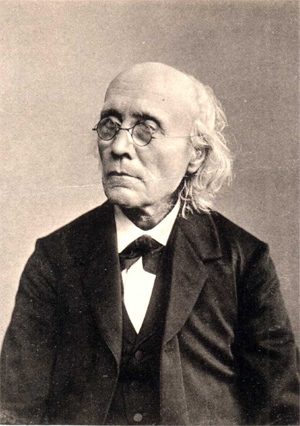
Gustav Fechner
Born: Gustav Theodor Fechner, 19 April 1801, Groß Särchen (near Muskau), Saxony, Holy Roman Empire
Died: 18 November 1887 (aged 86), Leipzig, Saxony, German Empire
Nationality: German
Education: Medizinische Akademie Carl Gustav Carus [de]
Leipzig University (PhD, 1835)
Known for: Weber–Fechner law
Scientific career
Fields: Experimental psychology
Institutions: Leipzig University
Thesis: De variis intensitatem vis Galvanicae metiendi methodis (1835)
Notable students: Hermann Lotze
Influences: Immanuel Kant
Influenced Gerardus Heymans; Wilhelm Wundt; William James; Alfred North Whitehead; Charles Hartshorne; Ernst Weber; Sigmund Freud; Friedrich Paulsen; Ludwig von Bertalanffy
Gustav Theodor Fechner (/ˈfɛxnər/; German: [ˈfɛçnɐ]; 19 April 1801 – 18 November 1887)[1] was a German experimental psychologist, philosopher, and physicist. An early pioneer in experimental psychology and founder of psychophysics, he inspired many 20th-century scientists and philosophers. He is also credited with demonstrating the non-linear relationship between psychological sensation and the physical intensity of a stimulus via the formula: {\displaystyle S=K\ln I}{\displaystyle S=K\ln I}, which became known as the Weber–Fechner law.[2][3]
Early life and scientific career
Fechner was born at Groß Särchen, near Muskau, in Lower Lusatia, where his father was a pastor. Despite being raised by his religious father, Fechner became an atheist in later life.[4] He was educated first at Sorau (now Żary in Western Poland).
In 1817 he studied medicine at the Medizinische Akademie Carl Gustav Carus [de] in Dresden and from 1818 at the University of Leipzig, the city in which he spent the rest of his life.[5] He earned his PhD from Leipzig in 1835.
In 1834 he was appointed professor of physics at Leipzig. But in 1839, he contracted an eye disorder while studying the phenomena of color and vision, and, after much suffering, resigned. Subsequently, recovering, he turned to the study of the mind and its relations with the body, giving public lectures on the subjects dealt with in his books. Whilst lying in bed, Fechner had an insight into the relationship between mental sensations and material sensations. This insight proved to be significant in the development of psychology as there was now a quantitative relationship between the mental and physical worlds.[6]
Contributions
Fechner published chemical and physical papers, and translated chemical works by Jean-Baptiste Biot and Louis Jacques Thénard from French. He also wrote several poems and humorous pieces, such as the Vergleichende Anatomie der Engel (1825), written under the pseudonym of "Dr. Mises."
Elemente der Psychophysik
Fechner's epoch-making work was his Elemente der Psychophysik (1860). He started from the monistic thought that bodily facts and conscious facts, though not reducible one to the other, are different sides of one reality. His originality lies in trying to discover an exact mathematical relation between them. The most famous outcome of his inquiries is the law known as the Weber–Fechner law which may be expressed as follows:
The law has been found to be immensely useful, but to fail for very faint and for very strong sensations. Within its useful range, Fechner's law is that sensation is a logarithmic function of physical intensity. S. S. Stevens pointed out that such a law does not account for the fact that perceived relationships among stimuli (e.g., papers coloured black, dark grey, grey, light grey, and white) are unchanged with changes in overall intensity (i.e., in the level of illumination of the papers). He proposed, in his famous 1961 paper entitled "To Honor Fechner and Repeal His Law", that intensity of stimulation is related to perception via a power-law.
Fechner's general formula for getting at the number of units in any sensation is S = c log R, where S stands for the sensation, R for the stimulus numerically estimated, and c for a constant that must be separately determined by experiment in each particular order of sensibility. Fechner's reasoning has been criticized on the grounds that although stimuli are composite, sensations are not. "Every sensation," says William James, "presents itself as an indivisible unit; and it is quite impossible to read any clear meaning into the notion that they are masses of units combined."
The Fechner color effect
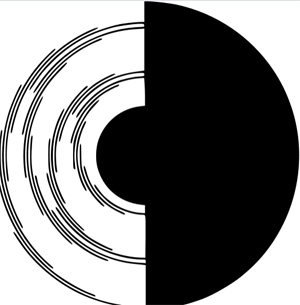
A sample of a Benham's disk
In 1838, he also studied the still-mysterious perceptual illusion of what is still called the Fechner color effect, whereby colors are seen in a moving pattern of black and white. The English journalist and amateur scientist Charles Benham, in 1894, enabled English-speakers to learn of the effect through the invention of the spinning top that bears his name, Benham's top. Whether Fechner and Benham ever actually met face to face for any reason is not known.
The median
In 1878, Fechner published a paper in which he developed the notion of the median. He later delved into experimental aesthetics and thought to determine the shapes and dimensions of aesthetically pleasing objects. He mainly used the sizes of paintings as his data base. In his 1876 Vorschule der Aesthetik, he used the method of extreme ranks for subjective judgements.[7]
Fechner is generally credited with introducing the median into the formal analysis of data.[8]
Synesthesia
In 1871, Fechner reported the first empirical survey of coloured letter photisms among 73 synesthetes.[9][10] His work was followed in the 1880s by that of Francis Galton.[11][12][13]
Corpus callosum split
One of Fechner's speculations about consciousness dealt with brain. During his time, it was known that the brain is bilaterally symmetrical and that there is a deep division between the two halves that are linked by a connecting band of fibers called the corpus callosum. Fechner speculated that if the corpus callosum were split, two separate streams of consciousness would result -- the mind would become two. Yet, Fechner believed that his theory would never be tested; he was incorrect. During the mid-twentieth century, Roger Sperry and Michael Gazzaniga worked on epileptic patients with sectioned corpus callosum and observed that Fechner's idea was correct.[14]
Golden section hypothesis
Fechner constructed ten rectangles with different ratios of width to length and asked numerous observers to choose the "best" and "worst" rectangle shape. He was concerned with the visual appeal of rectangles with different proportions. Participants were explicitly instructed to disregard any associations that they have with the rectangles, e.g. with objects of similar ratios. The rectangles chosen as "best" by the largest number of participants and as "worst" by the fewest participants had a ratio of 0.62 (21:34).[15] This ratio is known as the "golden section" (or golden ratio) and referred to the ratio of a rectangle's width to length that is most appealing to the eye. Carl Stumpf was a participant in this study.
However, there has been some ongoing dispute on the experiment itself, as the fact that Fechner deliberately discarded results of the study ill-fitting to his needs became known, with many mathematicians, including Mario Livio, refuting the result of the experiment.
The two-piece normal distribution
In his posthumously published Kollektivmasslehre (1897), Fechner introduced the Zweiseitige Gauss'sche Gesetz or two-piece normal distribution, to accommodate the asymmetries he had observed in empirical frequency distributions in many fields. The distribution has been independently rediscovered by several authors working in different fields.[16]
Fechner's paradox
In 1861, Fechner reported that if he looked at a light with a darkened piece of glass over one eye then closed that eye, the light appeared to become brighter, even though less light was coming into his eyes.[17] This phenomenon has come to be called Fechner's paradox.[18] It has been the subject of numerous research papers, including in the 2000s.[19] It occurs because the perceived brightness of the light with both eyes open is similar to the average brightness of each light viewed with one eye.[17]
Influence
Fechner, along with Wilhelm Wundt and Hermann von Helmholtz, is recognized as one of the founders of modern experimental psychology. His clearest contribution was the demonstration that because the mind was susceptible to measurement and mathematical treatment, psychology had the potential to become a quantified science. Theorists such as Immanuel Kant had long stated that this was impossible, and that therefore, a science of psychology was also impossible.
Though he had a vast influence on psychophysics, the actual disciples of his general philosophy were few. Ernst Mach was inspired by his work on psychophysics.[20] William James also admired his work: in 1904, he wrote an admiring introduction to the English translation of Fechner's Büchlein vom Leben nach dem Tode (Little Book of Life After Death). Furthermore, he influenced Sigmund Freud, who refers to Fechner when introducing the concept of psychic locality in his The Interpretation of Dreams that he illustrates with the microscope-metaphor.[21][22][23]
Fechner's world concept was highly animistic. He felt the thrill of life everywhere, in plants, earth, stars, the total universe. Man stands midway between the souls of plants and the souls of stars, who are angels.[24] God, the soul of the universe, must be conceived as having an existence analogous to men. Natural laws are just the modes of the unfolding of God's perfection. In his last work Fechner, aged but full of hope, contrasts this joyous "daylight view" of the world with the dead, dreary "night view" of materialism. Fechner's work in aesthetics is also important. He conducted experiments to show that certain abstract forms and proportions are naturally pleasing to our senses, and gave some new illustrations of the working of aesthetic association. Charles Hartshorne saw him as a predecessor on his and Alfred North Whitehead's philosophy and regretted that Fechner's philosophical work had been neglected for so long.[25]
Fechner's position in reference to predecessors and contemporaries is not very sharply defined. He was remotely a disciple of Schelling, learnt much from Baruch Spinoza, G. W. Leibniz, Johann Friedrich Herbart, Arthur Schopenhauer, and Christian Hermann Weisse, and decidedly rejected G. W. F. Hegel and the monadism of Rudolf Hermann Lotze.
Fechner's work continues to have an influence on modern science, inspiring continued exploration of human perceptual abilities by researchers such as Jan Koenderink, Farley Norman, David Heeger, and others.
Honours
Fechner Crater
In 1970, the International Astronomical Union named a crater on the far side of the moon after Fechner.[26]
Fechner Day
In 1985 the International Society for Psychophysics called its annual conference Fechner Day. The conference is now scheduled to include 22 October to allow psychophysicists to celebrate the anniversary of Fechner's waking up on that day in 1850 with a new approach into how to study the mind.[27] Fechner Day runs annually with the 2018 Fechner Day being the 34th.[28] It is organized annually, by a different academic host each year.[29][30]
Family and later life
Little is known of Fechner's later years, nor of the circumstances, cause, and manner of his death.
Fechner was the brother of painter Eduard Clemens Fechner and of Clementine Wieck Fechner, who was the stepmother of Clara Wieck when Clementine became her father Friedrich Wieck's second wife.
Works
• Praemissae ad theoriam organismi generalem ("Advances in the general theory of organisms") (1823).
• (Dr. Mises) Stapelia mixta (1824). Internet Archive (Harvard)
• Resultate der bis jetzt unternommenen Pflanzenanalysen ("Results of plant analyses undertaken to date") (1829). Internet Archive (Stanford)
• Maassbestimmungen über die galvanische Kette (1831).
• (Dr. Mises) Schutzmittel für die Cholera ("Protective equipment for cholera") (1832). Google (Harvard) — Google (UWisc)
• Repertorium der Experimentalphysik (1832). 3 volumes.
o Volume 1. Internet Archive (NYPL) — Internet Archive (Oxford)
o Volume 2. Internet Archive (NYPL) — Internet Archive (Oxford)
o Volume 3. Internet Archive (NYPL) — Internet Archive (Oxford)
• (ed.) Das Hauslexicon. Vollständiges Handbuch praktischer Lebenskenntnisse für alle Stände (1834–38). 8 volumes.
• Das Büchlein vom Leben nach dem Tode (1836). 6th ed., 1906. Internet Archive (Harvard) — Internet Archive (NYPL)
o (in English) On Life After Death (1882). Google (Oxford) — IA (UToronto) 2nd ed., 1906. Internet Archive (UMich) 3rd ed., 1914. IA (UIllinois)
o (in English) The Little Book of Life After Death (1904). IA (UToronto) 1905, Internet Archive (UCal) — IA (Ucal) — IA (UToronto)
• (Dr. Mises) Gedichte (1841). Internet Archive (Oxford)
• Ueber das höchste Gut ("Concerning the Highest Good") (1846). Internet Archive (Stanford)
• (Dr. Mises) Nanna oder über das Seelenleben der Pflanzen (1848). 2nd ed., 1899. 3rd ed., 1903. Internet Archive (UMich) 4th ed., 1908. Internet Archive (Harvard)
• Zend-Avesta oder über die Dinge des Himmels und des Jenseits (1851). 3 volumes. 3rd ed., 1906. Google (Harvard)
• Ueber die physikalische und philosophische Atomenlehre (1855). 2nd ed., 1864. Internet Archive (Stanford)
• Professor Schleiden und der Mond (1856). Google (UMich)
• Elemente der Psychophysik (1860). 2 volumes. Volume 1. Google (ULausanne) Volume 2. Internet Archive (NYPL)
• Ueber die Seelenfrage ("Concerning the Soul") (1861). Internet Archive (NYPL) — Internet Archive (UCal) — Internet Archive (UMich) 2nd ed., 1907. Google (Harvard)
• Die drei Motive und Gründe des Glaubens ("The three motives and reasons of faith") (1863). Google (Harvard) — Internet Archive (NYPL)
• Einige Ideen zur Schöpfungs- und Entwickelungsgeschichte der Organismen (1873). Internet Archive (UMich)
• (Dr. Mises) Kleine Schriften (1875). Internet Archive (UMich)
• Erinnerungen an die letzen Tage der Odlehre und ihres Urhebers (1876). Google (Harvard)
• Vorschule der Aesthetik (1876). 2 Volumes. Internet Archive (Harvard)
• In Sachen der Psychophysik (1877). Internet Archive (Stanford)
• Die Tagesansicht gegenüber der Nachtansicht (1879). Google (Oxford) 2nd ed., 1904. Internet Archive (Stanford)
• Revision der Hauptpuncte der Psychophysik (1882). Internet Archive (Harvard)
• Kollektivmasslehre (1897). Internet Archive (NYPL)
References
1. "Gustav Fechner - German psychologist and physicist". Encyclopedia Britannica. Retrieved 18 January 2019.
2. Fancher, R. E. (1996). Pioneers of Psychology (3rd ed.). New York: W. W. Norton & Company. ISBN 0-393-96994-0.
3. Sheynin, Oscar (2004), "Fechner as a statistician.", British Journal of Mathematical and Statistical Psychology (published May 2004), 57 (Pt 1), pp. 53–72, doi:10.1348/000711004849196, PMID 15171801
4. Michael Heidelberger (2004). "1: Life and Work". Nature from within: Gustav Theodor Fechner and his Psychophysical Worldview. University of Pittsburgh Press. p. 21. ISBN 9780822970774. The study of medicine also contributed to a loss of religious faith and to becoming atheist.
5. Fechner, Gustav Theodor at vlp.mpiwg-berlin.mpg.de.
6. Schultz, P.D., & Schultz, S.E. (2008). A History of Modern Psychology.(pp. 81-82).Thompson Wadsworth.
7. Michael Heidelberger. "Gustav Theodor Fechner". /statprob.com. Archived from the original on 4 March 2016. Retrieved 5 January 2014.
8. Keynes, John Maynard; A Treatise on Probability (1921), Pt II Ch XVII §5 (p 201).
9. Fechner, G. (1876) Vorschule der Aesthetik. Leipzig: Breitkopf und Hartel. Website: chuoft.pdf
10. Campen, Cretien van (1996). De verwarring der zintuigen. Artistieke en psychologische experimenten met synesthesie. Psychologie & Maatschappij, vol. 20, nr. 1, pp. 10–26.
11. Galton F (1880). "Visualized Numerals". Nature. 21 (543): 494–5. doi:10.1038/021494e0.
12. Galton F (1880). "Visualized Numerals". Nature. 21 (533): 252–6. doi:10.1038/021252a0.
13. Galton F. (1883). Inquiries into Human Faculty and Its Development. Macmillan. Retrieved 2008-06-17.
14. [Gazzinga, M.S (1970). The bisected brain. New York: Appleton-Century-Crofts]
15. Fechner, Gustav (1876). Vorschule der Ästhetik. Leipzig: Breitkopf & Härtel. pp. 190–202.
16. Wallis, K.F. (2014). "The two-piece normal, binormal, or double Gaussian distribution: its origin and rediscoveries". Statistical Science, Vol. 29, No. 1, pp.106-112. DOI: 10.1214/13-STS417 arXiv:1405.4995
17. Levelt, W. J. M. (1965). Binocular brightness averaging and contour information. British Journal of Psychology, 56, 1-13. https://dx.doi.org/10.1111/j.2044-8295.1965.tb00939.x
18. Robinson, T. R. (1896). Light intensity and depth perception. American Journal of Psychology, 7, 518-532. https://dx.doi.org/10.2307/1411847
19. Ding, J., & Levi, D. M. (2017). Binocular combination of luminance profiles. Journal of Vision, 17(13, 4), 1-32. https://dx.doi.org/10.1167/17.13.4
20. Pojman, Paul, "Ernst Mach", The Stanford Encyclopedia of Philosophy (Winter 2011 Edition), Edward N. Zalta (ed.) [1]
21. Nicholls, Angus; Liebshcher, Martin (24 June 2010). Thinking the Unconscious: Nineteenth-Century German Thought. Cambridge University Press. p. 272. ISBN 9780521897532.
22. Freud, Sigmund (18 March 2015). The Interpretation of Dreams. Translated by A. A. Brill. Mineola New York: Courier Dover Publications. p. 35. ISBN 978-0-486-78942-2.
23. Sulloway, Frank J. (1979). Freud: Biologist of the Mind.(pp. 66-67). Basic Books.
24. Marshall, M E (1969), "Gustav Fechner, Dr. Mises, and the comparative anatomy of angels.", Journal of the History of the Behavioral Sciences (published Jan 1969), 5(1), pp. 39–58, doi:10.1002/1520-6696(196901)5:1<39::AID-JHBS2300050105>3.0.CO;2-C, PMID 11610088
25. For Hartshorne's appreciation of Fechner see his Aquinas to Whitehead – Seven Centuries of Metafysics of Religion. Hartshorne also comments that William James failed to do justice to the theological aspects of Fechner's work. Hartshorne saw also resemblances with the work of Fechner's contemporary Jules Lequier. See also: Hartshorne – Reese (ed.) Philosophers speak of God.
26. Fechner, Gazetteer of Planetary Nomenclature, International Astronomical Union (IAU) Working Group for Planetary System Nomenclature (WGPSN)
27. Kreuger, L. E. (1993) Personal Communication. ref History of Psychology 4th edition David Hothersal 2004 ISBN 9780072849653
28. http://www.ispsychophysics.org/fd2018/
29. "FECHNER DAY 2018". fechnerdays Webseite!. Retrieved 18 January 2019.
30. "Fechner Day 2017 — Welcome (index)". fechnerday.com. Retrieved 18 January2019.
Further reading
• Heidelberger, M. (2001), "Gustav Theodor Fechner" in Statisticians of the Centuries (ed. C. C. Heyde and E. Seneta) pp. 142–147. New York: Springer Verlag, 2001.
• Heidelberger, M. (2004), Nature From Within: Gustav Theodor Fechner and his Psychophysical Worldview (trans. Cynthia Klohr), Pittsburgh, PA: University of Pittsburgh Press, 2004. ISBN 0-822-9421-00
• Robinson, David K. (2010), "Gustav Fechner: 150 years of Elemente der Psychophysik", in History of Psychology, Vol 13(4), Nov 2010, pp. 409–410. [2]
• Stigler, Stephen M. (1986), The History of Statistics: The Measurement of Uncertainty before 1900, Cambridge, MA: Harvard University Press, pp. 242–254.
External links
• Works by Gustav Theodor Fechner at Project Gutenberg
• Works by or about Gustav Fechner at Internet Archive
• William James on Fechner
• Works of Gustav Theodor Fechner at Projekt Gutenberg-DE. (German)
• Excerpt from Elements of Psychophysics from the Classics in the History of Psychology website.
• Robert H. Wozniak's Introduction to Elemente der Psychophysik.
• Biography, bibliography and digitized sources in the Virtual Laboratory of the Max Planck Institute for the History of Science
• Granville Stanley 1912 'Founders of modern psychology p. 125ff archive.org
• Gustav Theodor Fechner 1904 The Little Book of Life after Death Foreword by William James
• Gustav Theodor Fechner 1908 The Living Word
• Gustav Theodor Fechner at statprob.com
**************************
Gustav Theodor Fechner
by Theosophy Wiki
Accessed: 3/20/21
Gustav Theodor Fechner (April 19, 1801 – November 18, 1887), was a German experimental psychologist interested in Spiritualism.
Mahatama Letters reference
Gustav Theodor Fechner may have been the "G. H. Fechner" mentioned by Master K.H. in one of his letters:
The ideas quoted in this Letter had been reported in the The N.Y. Nation, as follows:
When Prof. Fechner was asked about having met a Hindu at Leipzig, he said he did, although clarified that the name of the Hindu concerned was Nisi Kanta Chattopadhyaya, not Koot Hoomi. Some Theosophists thought this was a pseudonym used by Master K.H. However, this was not the case, according to Charles J. Ryan in an article published in The Canadian Theosophist[3]
See also Koot Hoomi: Education in Europe for more about Fechner.
Review by William James
William James wrote an insightful article about the philosophy of G. T. Fechner, entitled "The Doctrine of the Earth-Soul and of Beings Intermediate Between Man and God." [The Doctrine of the Earth-Soul and of Beings intermediate between Man and God, by William James, Hibbert Journal 7:278 (1908)] This review of the article appeared in The Theosophic Messenger in 1909:
Writings
On Life After Death. Chicago: The Open Court Publishing Company, 1917. 3rd edition.
Additional resources
• James, William. "The Doctrine of the Earth-Soul and of Beings Intermediate Between Man and God." Hibbert Journal VII (January, 1909), 278.
1. Theosophy Wiki Mahatma Letter No. 18, pages 13-14.
2. The N. Y. Nation, Oct. 2, 1879, p. 229.
3. Charles J. Ryan, "An Important Correction" The Canadian Theosophist (December 15, 1936), 326-329. See also Cox's work, Who Wrote the March-Hare Attack on the Mahatma Letters? Victoria, British Columbia, Canada: H.P.B. Library, 1936, reprinted here at the Blavatsky Archives website.
4. "Current Literature" The Theosophic Messenger 10.6 (March, 1909), 259-260. Review of article by William James, "The Doctrine of the Earth-Soul and of Beings Intermediate Between Man and God" Hibbert Journal VII (January, 1909), 278. See Internet Archive for Hibbert Journal VII.
by Wikipedia
Accessed: 3/20/21

Gustav Fechner
Born: Gustav Theodor Fechner, 19 April 1801, Groß Särchen (near Muskau), Saxony, Holy Roman Empire
Died: 18 November 1887 (aged 86), Leipzig, Saxony, German Empire
Nationality: German
Education: Medizinische Akademie Carl Gustav Carus [de]
Leipzig University (PhD, 1835)
Known for: Weber–Fechner law
Scientific career
Fields: Experimental psychology
Institutions: Leipzig University
Thesis: De variis intensitatem vis Galvanicae metiendi methodis (1835)
Notable students: Hermann Lotze
Influences: Immanuel Kant
Influenced Gerardus Heymans; Wilhelm Wundt; William James; Alfred North Whitehead; Charles Hartshorne; Ernst Weber; Sigmund Freud; Friedrich Paulsen; Ludwig von Bertalanffy
Gustav Theodor Fechner (/ˈfɛxnər/; German: [ˈfɛçnɐ]; 19 April 1801 – 18 November 1887)[1] was a German experimental psychologist, philosopher, and physicist. An early pioneer in experimental psychology and founder of psychophysics, he inspired many 20th-century scientists and philosophers. He is also credited with demonstrating the non-linear relationship between psychological sensation and the physical intensity of a stimulus via the formula: {\displaystyle S=K\ln I}{\displaystyle S=K\ln I}, which became known as the Weber–Fechner law.[2][3]
Early life and scientific career
Fechner was born at Groß Särchen, near Muskau, in Lower Lusatia, where his father was a pastor. Despite being raised by his religious father, Fechner became an atheist in later life.[4] He was educated first at Sorau (now Żary in Western Poland).
In 1817 he studied medicine at the Medizinische Akademie Carl Gustav Carus [de] in Dresden and from 1818 at the University of Leipzig, the city in which he spent the rest of his life.[5] He earned his PhD from Leipzig in 1835.
In 1834 he was appointed professor of physics at Leipzig. But in 1839, he contracted an eye disorder while studying the phenomena of color and vision, and, after much suffering, resigned. Subsequently, recovering, he turned to the study of the mind and its relations with the body, giving public lectures on the subjects dealt with in his books. Whilst lying in bed, Fechner had an insight into the relationship between mental sensations and material sensations. This insight proved to be significant in the development of psychology as there was now a quantitative relationship between the mental and physical worlds.[6]
Contributions
Fechner published chemical and physical papers, and translated chemical works by Jean-Baptiste Biot and Louis Jacques Thénard from French. He also wrote several poems and humorous pieces, such as the Vergleichende Anatomie der Engel (1825), written under the pseudonym of "Dr. Mises."
Elemente der Psychophysik
Fechner's epoch-making work was his Elemente der Psychophysik (1860). He started from the monistic thought that bodily facts and conscious facts, though not reducible one to the other, are different sides of one reality. His originality lies in trying to discover an exact mathematical relation between them. The most famous outcome of his inquiries is the law known as the Weber–Fechner law which may be expressed as follows:
"In order that the intensity of a sensation may increase in arithmetical progression, the stimulus must increase in geometrical progression."
The law has been found to be immensely useful, but to fail for very faint and for very strong sensations. Within its useful range, Fechner's law is that sensation is a logarithmic function of physical intensity. S. S. Stevens pointed out that such a law does not account for the fact that perceived relationships among stimuli (e.g., papers coloured black, dark grey, grey, light grey, and white) are unchanged with changes in overall intensity (i.e., in the level of illumination of the papers). He proposed, in his famous 1961 paper entitled "To Honor Fechner and Repeal His Law", that intensity of stimulation is related to perception via a power-law.
Fechner's general formula for getting at the number of units in any sensation is S = c log R, where S stands for the sensation, R for the stimulus numerically estimated, and c for a constant that must be separately determined by experiment in each particular order of sensibility. Fechner's reasoning has been criticized on the grounds that although stimuli are composite, sensations are not. "Every sensation," says William James, "presents itself as an indivisible unit; and it is quite impossible to read any clear meaning into the notion that they are masses of units combined."
The Fechner color effect

A sample of a Benham's disk
In 1838, he also studied the still-mysterious perceptual illusion of what is still called the Fechner color effect, whereby colors are seen in a moving pattern of black and white. The English journalist and amateur scientist Charles Benham, in 1894, enabled English-speakers to learn of the effect through the invention of the spinning top that bears his name, Benham's top. Whether Fechner and Benham ever actually met face to face for any reason is not known.
The median
In 1878, Fechner published a paper in which he developed the notion of the median. He later delved into experimental aesthetics and thought to determine the shapes and dimensions of aesthetically pleasing objects. He mainly used the sizes of paintings as his data base. In his 1876 Vorschule der Aesthetik, he used the method of extreme ranks for subjective judgements.[7]
Fechner is generally credited with introducing the median into the formal analysis of data.[8]
Synesthesia
In 1871, Fechner reported the first empirical survey of coloured letter photisms among 73 synesthetes.[9][10] His work was followed in the 1880s by that of Francis Galton.[11][12][13]
Corpus callosum split
One of Fechner's speculations about consciousness dealt with brain. During his time, it was known that the brain is bilaterally symmetrical and that there is a deep division between the two halves that are linked by a connecting band of fibers called the corpus callosum. Fechner speculated that if the corpus callosum were split, two separate streams of consciousness would result -- the mind would become two. Yet, Fechner believed that his theory would never be tested; he was incorrect. During the mid-twentieth century, Roger Sperry and Michael Gazzaniga worked on epileptic patients with sectioned corpus callosum and observed that Fechner's idea was correct.[14]
Golden section hypothesis
Fechner constructed ten rectangles with different ratios of width to length and asked numerous observers to choose the "best" and "worst" rectangle shape. He was concerned with the visual appeal of rectangles with different proportions. Participants were explicitly instructed to disregard any associations that they have with the rectangles, e.g. with objects of similar ratios. The rectangles chosen as "best" by the largest number of participants and as "worst" by the fewest participants had a ratio of 0.62 (21:34).[15] This ratio is known as the "golden section" (or golden ratio) and referred to the ratio of a rectangle's width to length that is most appealing to the eye. Carl Stumpf was a participant in this study.
However, there has been some ongoing dispute on the experiment itself, as the fact that Fechner deliberately discarded results of the study ill-fitting to his needs became known, with many mathematicians, including Mario Livio, refuting the result of the experiment.
The two-piece normal distribution
In his posthumously published Kollektivmasslehre (1897), Fechner introduced the Zweiseitige Gauss'sche Gesetz or two-piece normal distribution, to accommodate the asymmetries he had observed in empirical frequency distributions in many fields. The distribution has been independently rediscovered by several authors working in different fields.[16]
Fechner's paradox
In 1861, Fechner reported that if he looked at a light with a darkened piece of glass over one eye then closed that eye, the light appeared to become brighter, even though less light was coming into his eyes.[17] This phenomenon has come to be called Fechner's paradox.[18] It has been the subject of numerous research papers, including in the 2000s.[19] It occurs because the perceived brightness of the light with both eyes open is similar to the average brightness of each light viewed with one eye.[17]
Influence
Fechner, along with Wilhelm Wundt and Hermann von Helmholtz, is recognized as one of the founders of modern experimental psychology. His clearest contribution was the demonstration that because the mind was susceptible to measurement and mathematical treatment, psychology had the potential to become a quantified science. Theorists such as Immanuel Kant had long stated that this was impossible, and that therefore, a science of psychology was also impossible.
Though he had a vast influence on psychophysics, the actual disciples of his general philosophy were few. Ernst Mach was inspired by his work on psychophysics.[20] William James also admired his work: in 1904, he wrote an admiring introduction to the English translation of Fechner's Büchlein vom Leben nach dem Tode (Little Book of Life After Death). Furthermore, he influenced Sigmund Freud, who refers to Fechner when introducing the concept of psychic locality in his The Interpretation of Dreams that he illustrates with the microscope-metaphor.[21][22][23]
Fechner's world concept was highly animistic. He felt the thrill of life everywhere, in plants, earth, stars, the total universe. Man stands midway between the souls of plants and the souls of stars, who are angels.[24] God, the soul of the universe, must be conceived as having an existence analogous to men. Natural laws are just the modes of the unfolding of God's perfection. In his last work Fechner, aged but full of hope, contrasts this joyous "daylight view" of the world with the dead, dreary "night view" of materialism. Fechner's work in aesthetics is also important. He conducted experiments to show that certain abstract forms and proportions are naturally pleasing to our senses, and gave some new illustrations of the working of aesthetic association. Charles Hartshorne saw him as a predecessor on his and Alfred North Whitehead's philosophy and regretted that Fechner's philosophical work had been neglected for so long.[25]
Fechner's position in reference to predecessors and contemporaries is not very sharply defined. He was remotely a disciple of Schelling, learnt much from Baruch Spinoza, G. W. Leibniz, Johann Friedrich Herbart, Arthur Schopenhauer, and Christian Hermann Weisse, and decidedly rejected G. W. F. Hegel and the monadism of Rudolf Hermann Lotze.
Fechner's work continues to have an influence on modern science, inspiring continued exploration of human perceptual abilities by researchers such as Jan Koenderink, Farley Norman, David Heeger, and others.
Honours
Fechner Crater
In 1970, the International Astronomical Union named a crater on the far side of the moon after Fechner.[26]
Fechner Day
In 1985 the International Society for Psychophysics called its annual conference Fechner Day. The conference is now scheduled to include 22 October to allow psychophysicists to celebrate the anniversary of Fechner's waking up on that day in 1850 with a new approach into how to study the mind.[27] Fechner Day runs annually with the 2018 Fechner Day being the 34th.[28] It is organized annually, by a different academic host each year.[29][30]
Family and later life
Little is known of Fechner's later years, nor of the circumstances, cause, and manner of his death.
Fechner was the brother of painter Eduard Clemens Fechner and of Clementine Wieck Fechner, who was the stepmother of Clara Wieck when Clementine became her father Friedrich Wieck's second wife.
Works
• Praemissae ad theoriam organismi generalem ("Advances in the general theory of organisms") (1823).
• (Dr. Mises) Stapelia mixta (1824). Internet Archive (Harvard)
• Resultate der bis jetzt unternommenen Pflanzenanalysen ("Results of plant analyses undertaken to date") (1829). Internet Archive (Stanford)
• Maassbestimmungen über die galvanische Kette (1831).
• (Dr. Mises) Schutzmittel für die Cholera ("Protective equipment for cholera") (1832). Google (Harvard) — Google (UWisc)
• Repertorium der Experimentalphysik (1832). 3 volumes.
o Volume 1. Internet Archive (NYPL) — Internet Archive (Oxford)
o Volume 2. Internet Archive (NYPL) — Internet Archive (Oxford)
o Volume 3. Internet Archive (NYPL) — Internet Archive (Oxford)
• (ed.) Das Hauslexicon. Vollständiges Handbuch praktischer Lebenskenntnisse für alle Stände (1834–38). 8 volumes.
• Das Büchlein vom Leben nach dem Tode (1836). 6th ed., 1906. Internet Archive (Harvard) — Internet Archive (NYPL)
o (in English) On Life After Death (1882). Google (Oxford) — IA (UToronto) 2nd ed., 1906. Internet Archive (UMich) 3rd ed., 1914. IA (UIllinois)
o (in English) The Little Book of Life After Death (1904). IA (UToronto) 1905, Internet Archive (UCal) — IA (Ucal) — IA (UToronto)
• (Dr. Mises) Gedichte (1841). Internet Archive (Oxford)
• Ueber das höchste Gut ("Concerning the Highest Good") (1846). Internet Archive (Stanford)
• (Dr. Mises) Nanna oder über das Seelenleben der Pflanzen (1848). 2nd ed., 1899. 3rd ed., 1903. Internet Archive (UMich) 4th ed., 1908. Internet Archive (Harvard)
• Zend-Avesta oder über die Dinge des Himmels und des Jenseits (1851). 3 volumes. 3rd ed., 1906. Google (Harvard)
• Ueber die physikalische und philosophische Atomenlehre (1855). 2nd ed., 1864. Internet Archive (Stanford)
• Professor Schleiden und der Mond (1856). Google (UMich)
• Elemente der Psychophysik (1860). 2 volumes. Volume 1. Google (ULausanne) Volume 2. Internet Archive (NYPL)
• Ueber die Seelenfrage ("Concerning the Soul") (1861). Internet Archive (NYPL) — Internet Archive (UCal) — Internet Archive (UMich) 2nd ed., 1907. Google (Harvard)
• Die drei Motive und Gründe des Glaubens ("The three motives and reasons of faith") (1863). Google (Harvard) — Internet Archive (NYPL)
• Einige Ideen zur Schöpfungs- und Entwickelungsgeschichte der Organismen (1873). Internet Archive (UMich)
• (Dr. Mises) Kleine Schriften (1875). Internet Archive (UMich)
• Erinnerungen an die letzen Tage der Odlehre und ihres Urhebers (1876). Google (Harvard)
• Vorschule der Aesthetik (1876). 2 Volumes. Internet Archive (Harvard)
• In Sachen der Psychophysik (1877). Internet Archive (Stanford)
• Die Tagesansicht gegenüber der Nachtansicht (1879). Google (Oxford) 2nd ed., 1904. Internet Archive (Stanford)
• Revision der Hauptpuncte der Psychophysik (1882). Internet Archive (Harvard)
• Kollektivmasslehre (1897). Internet Archive (NYPL)
References
1. "Gustav Fechner - German psychologist and physicist". Encyclopedia Britannica. Retrieved 18 January 2019.
2. Fancher, R. E. (1996). Pioneers of Psychology (3rd ed.). New York: W. W. Norton & Company. ISBN 0-393-96994-0.
3. Sheynin, Oscar (2004), "Fechner as a statistician.", British Journal of Mathematical and Statistical Psychology (published May 2004), 57 (Pt 1), pp. 53–72, doi:10.1348/000711004849196, PMID 15171801
4. Michael Heidelberger (2004). "1: Life and Work". Nature from within: Gustav Theodor Fechner and his Psychophysical Worldview. University of Pittsburgh Press. p. 21. ISBN 9780822970774. The study of medicine also contributed to a loss of religious faith and to becoming atheist.
5. Fechner, Gustav Theodor at vlp.mpiwg-berlin.mpg.de.
6. Schultz, P.D., & Schultz, S.E. (2008). A History of Modern Psychology.(pp. 81-82).Thompson Wadsworth.
7. Michael Heidelberger. "Gustav Theodor Fechner". /statprob.com. Archived from the original on 4 March 2016. Retrieved 5 January 2014.
8. Keynes, John Maynard; A Treatise on Probability (1921), Pt II Ch XVII §5 (p 201).
9. Fechner, G. (1876) Vorschule der Aesthetik. Leipzig: Breitkopf und Hartel. Website: chuoft.pdf
10. Campen, Cretien van (1996). De verwarring der zintuigen. Artistieke en psychologische experimenten met synesthesie. Psychologie & Maatschappij, vol. 20, nr. 1, pp. 10–26.
11. Galton F (1880). "Visualized Numerals". Nature. 21 (543): 494–5. doi:10.1038/021494e0.
12. Galton F (1880). "Visualized Numerals". Nature. 21 (533): 252–6. doi:10.1038/021252a0.
13. Galton F. (1883). Inquiries into Human Faculty and Its Development. Macmillan. Retrieved 2008-06-17.
14. [Gazzinga, M.S (1970). The bisected brain. New York: Appleton-Century-Crofts]
15. Fechner, Gustav (1876). Vorschule der Ästhetik. Leipzig: Breitkopf & Härtel. pp. 190–202.
16. Wallis, K.F. (2014). "The two-piece normal, binormal, or double Gaussian distribution: its origin and rediscoveries". Statistical Science, Vol. 29, No. 1, pp.106-112. DOI: 10.1214/13-STS417 arXiv:1405.4995
17. Levelt, W. J. M. (1965). Binocular brightness averaging and contour information. British Journal of Psychology, 56, 1-13. https://dx.doi.org/10.1111/j.2044-8295.1965.tb00939.x
18. Robinson, T. R. (1896). Light intensity and depth perception. American Journal of Psychology, 7, 518-532. https://dx.doi.org/10.2307/1411847
19. Ding, J., & Levi, D. M. (2017). Binocular combination of luminance profiles. Journal of Vision, 17(13, 4), 1-32. https://dx.doi.org/10.1167/17.13.4
20. Pojman, Paul, "Ernst Mach", The Stanford Encyclopedia of Philosophy (Winter 2011 Edition), Edward N. Zalta (ed.) [1]
21. Nicholls, Angus; Liebshcher, Martin (24 June 2010). Thinking the Unconscious: Nineteenth-Century German Thought. Cambridge University Press. p. 272. ISBN 9780521897532.
22. Freud, Sigmund (18 March 2015). The Interpretation of Dreams. Translated by A. A. Brill. Mineola New York: Courier Dover Publications. p. 35. ISBN 978-0-486-78942-2.
23. Sulloway, Frank J. (1979). Freud: Biologist of the Mind.(pp. 66-67). Basic Books.
24. Marshall, M E (1969), "Gustav Fechner, Dr. Mises, and the comparative anatomy of angels.", Journal of the History of the Behavioral Sciences (published Jan 1969), 5(1), pp. 39–58, doi:10.1002/1520-6696(196901)5:1<39::AID-JHBS2300050105>3.0.CO;2-C, PMID 11610088
25. For Hartshorne's appreciation of Fechner see his Aquinas to Whitehead – Seven Centuries of Metafysics of Religion. Hartshorne also comments that William James failed to do justice to the theological aspects of Fechner's work. Hartshorne saw also resemblances with the work of Fechner's contemporary Jules Lequier. See also: Hartshorne – Reese (ed.) Philosophers speak of God.
26. Fechner, Gazetteer of Planetary Nomenclature, International Astronomical Union (IAU) Working Group for Planetary System Nomenclature (WGPSN)
27. Kreuger, L. E. (1993) Personal Communication. ref History of Psychology 4th edition David Hothersal 2004 ISBN 9780072849653
28. http://www.ispsychophysics.org/fd2018/
29. "FECHNER DAY 2018". fechnerdays Webseite!. Retrieved 18 January 2019.
30. "Fechner Day 2017 — Welcome (index)". fechnerday.com. Retrieved 18 January2019.
Further reading
• Heidelberger, M. (2001), "Gustav Theodor Fechner" in Statisticians of the Centuries (ed. C. C. Heyde and E. Seneta) pp. 142–147. New York: Springer Verlag, 2001.
• Heidelberger, M. (2004), Nature From Within: Gustav Theodor Fechner and his Psychophysical Worldview (trans. Cynthia Klohr), Pittsburgh, PA: University of Pittsburgh Press, 2004. ISBN 0-822-9421-00
• Robinson, David K. (2010), "Gustav Fechner: 150 years of Elemente der Psychophysik", in History of Psychology, Vol 13(4), Nov 2010, pp. 409–410. [2]
• Stigler, Stephen M. (1986), The History of Statistics: The Measurement of Uncertainty before 1900, Cambridge, MA: Harvard University Press, pp. 242–254.
External links
• Works by Gustav Theodor Fechner at Project Gutenberg
• Works by or about Gustav Fechner at Internet Archive
• William James on Fechner
• Works of Gustav Theodor Fechner at Projekt Gutenberg-DE. (German)
• Excerpt from Elements of Psychophysics from the Classics in the History of Psychology website.
• Robert H. Wozniak's Introduction to Elemente der Psychophysik.
• Biography, bibliography and digitized sources in the Virtual Laboratory of the Max Planck Institute for the History of Science
• Granville Stanley 1912 'Founders of modern psychology p. 125ff archive.org
• Gustav Theodor Fechner 1904 The Little Book of Life after Death Foreword by William James
• Gustav Theodor Fechner 1908 The Living Word
• Gustav Theodor Fechner at statprob.com
**************************
Gustav Theodor Fechner
by Theosophy Wiki
Accessed: 3/20/21
Gustav Theodor Fechner (April 19, 1801 – November 18, 1887), was a German experimental psychologist interested in Spiritualism.
Mahatama Letters reference
Gustav Theodor Fechner may have been the "G. H. Fechner" mentioned by Master K.H. in one of his letters:
I may answer you, what I said to G. H. Fechner one day, when he wanted to know the Hindu view on what he had written — "You are right; . . . 'every diamond, every crystal, every plant and star has its own individual soul, besides man and animal . . .' and, 'there is a hierarchy of souls from the lowest forms of matter up to the World Soul' . . ."[1]
Fechner's world concept was highly animistic. He felt the thrill of life everywhere, in plants, earth, stars, the total universe. Man stands midway between the souls of plants and the souls of stars, who are angels. God, the soul of the universe, must be conceived as having an existence analogous to men. Natural laws are just the modes of the unfolding of God's perfection. In his last work Fechner, aged but full of hope, contrasts this joyous "daylight view" of the world with the dead, dreary "night view" of materialism. Fechner's work in aesthetics is also important. He conducted experiments to show that certain abstract forms and proportions are naturally pleasing to our senses, and gave some new illustrations of the working of aesthetic association. Charles Hartshorne saw him as a predecessor on his and Alfred North Whitehead's philosophy and regretted that Fechner's philosophical work had been neglected for so long.
-- Gustav Fechner, by Wikipedia
The ideas quoted in this Letter had been reported in the The N.Y. Nation, as follows:
He endeavors to make out that every diamond, every crystal, every plant, planet, and star has its own individual soul, besides man and animals; that there is a hierarchy of souls from the lowest forms of matter up to the world-soul -- a sort of eclectic, semi-pantheistic nondescript; and that the spirits of the departed hold psychic communication with souls that are still connected with a human frame.[2]
When Prof. Fechner was asked about having met a Hindu at Leipzig, he said he did, although clarified that the name of the Hindu concerned was Nisi Kanta Chattopadhyaya, not Koot Hoomi. Some Theosophists thought this was a pseudonym used by Master K.H. However, this was not the case, according to Charles J. Ryan in an article published in The Canadian Theosophist[3]
An Important Correction
by Charles J. Ryan
[Reprinted from The Canadian Theosophist, December 15, 1936, pp. 326-329.]
Editor, Canadian Theosophist: - May I draw attention to one or two points in regard to Mr. H. R. W. Cox’s excellent defence of H.P.B. against the most recent attack. The first deals with a statement in your August number.
On pages 173-4 Mr. Cox discusses the problem of the Hindu who met a certain scholar named Fechner, and quotes Mr. Basil Crump’s Evolution. The main points are these: In The Mahatma Letters, p. 44, the Master K.H. mentions a conversation he had "one day" with a certain "G. H. Fechner", but does not say when or where it took place. Mr. Crump, in Evolution, informs us that C. C. Massey, once a leading Theosophist, received information from Leipzig that a Professor Fechner, living there, remembered having met a Hindu at some unnamed period and having heard him lecture. The Hindu also visited Professor Fechner. The Professor said that the name of the Hindu was Nisi Kanta Chattapadhyaya, and that he was not particularly conspicuous. Mr. Massey seems to have thought that he had, in this way, received independent evidence of the presence of the Master K.H. at Leipzig in the earlier ‘seventies, for he explains the reason that Professor Fechner did not know the name Koot Hoomi by a very reasonable supposition, viz.:"In case it may be wondered why he [the Master K.H.] used a different name, it may be mentioned that when members of this Order have to travel in the outer world they always do so incognito."
Mr. Cox appears to agree with Massey, or he would not quote the above remark in his defence of H. P. Blavatsky against the Messrs. Hares’ charges.
Unfortunately Nisi Kanta Chattopadhyaya and the Master K.H. are two different persons, and the argument is therefore not valid, useful as it would be if confirmed. The former was a well-known Hindu gentleman, Principal of the Hyderabad College and author of sundry interesting works on Oriental, philosophical, and other subjects. He was evidently interested in Theosophy, for he presented Katherine Tingley, when she was in Bombay in 1896, with an autograph copy of one of his books, now in the Oriental Department of the Theosophical Library at Point Loma, California.
The first article or chapter in this book is called "The Reminiscences of the German University Life," and it is a report of a lecture by Dr. N. K. Chattopadhyaya on April 30, 1892 at Secunderabad. In this chapter he says:"I once met Prof. Gustav Fechner, the author of a book called "Psycho-Physik" in which he has enunciated certain laws whose importance . . . . is as great as Newton’s Law of Gravitation . . . . I had the privilege of escorting the old sage home and on the way he asked quite a number of questions about the Yogis and the Fakirs of India . . . Seeing more of him by and by I came to discover that he was quite a mystic, and had actually written a book called the "Zend-Avesta" a masterly exposition of Vedantic pantheism in the light of modern science."
The "Sage" was, of course, the famous Gustav Theodor Fechner.
Turning to The Mahatma Letters, we find that the Master’s conversation "one day" was held with a certain G. H. Fechner, and, as mentioned above, it was not connected with Leipzig. Question: was the Master K.H. referring to some unknown Fechner whose initials were G. H. and not G. T. and who has not been identified? That seems highly improbable. Is it more likely that the H. is a mere slip of the pen or even a typographical error, and that the Master really referred to the eminent philosopher, with whom he had a short conversation, probably so short that it had been quite forgotten by G. T. Fechner, who only recollected N. K. Chattopadhyaya.
However this may be, Professor Gustav T. Fechner’s message to C. C. Massey cannot be used as if it related to the Master K.H., because the Professor definitely states that his Hindu was Chattopadhyaya, and the latter positively confirms the fact. We have learned from other sources that the Master spent some time in Germany, but I am not aware that Leipzig is mentioned in Theosophical literature in that connection. In the Sinnett letters, H. P. Blavatsky says:". . . Wurzburg. It is near Heidelberg and Nurenberg, and all the centres one of the Masters lived in, and it is He who advised my Master to send me there. . ." (p. 105)
My second point relates to what the Hare Brothers call the "notable admission" by H. P. Blavatsky in connection with alleged Mahatma letters sent by her to importunate claimants for advice on their personal, worldly affairs - not connected with Theosophy....
Charles J. Ryan.
General Offices, Theosophical Society,
Point Loma, California.
See also Koot Hoomi: Education in Europe for more about Fechner.
Review by William James
William James wrote an insightful article about the philosophy of G. T. Fechner, entitled "The Doctrine of the Earth-Soul and of Beings Intermediate Between Man and God." [The Doctrine of the Earth-Soul and of Beings intermediate between Man and God, by William James, Hibbert Journal 7:278 (1908)] This review of the article appeared in The Theosophic Messenger in 1909:
An account of the philosophy of G. T. Fechner... outlines Fechner's standing as a scientist, and introduces him also in his lesser-known role of a transcendental philosopher. Fechner reckoned our habit of regarding the spiritual not as a rule but as an exception in the midst of Nature, the original sin of both popular and scientific thought. He himself consistently maintained the opposite view, supporting it by a wonderful number and variety of analogies, with the fundamental conclusion that the constitution of the world is the same throughout, and that as we conceive the consciousness of the individual, so we must conceive a consciousness of a higher and higher order in an indefinite series. The supposition of an earth consciousness he seeks to maintain by reviewing the characteristic marks of superiority which we have been in the habit of associating with the consciousness of man, and by pointing out, through analogy, the entire propriety of assuming these in still more perfect degree as part of the earth-soul: independent of other external beings is no less characteristic of the earth than of the human individual; complexity in unity, in the case of the earth, exceeds that of any other organism; development from within is no less its characteristic mode than that of man himself; while in individuality of type and indifference from other beings of its type, the earth is extraordinarily distinct. Fechner continues a most brilliant handling of this subject through several different volumes, from all of which Professor James has taken the most illuminating extracts, all making, however, for this one conclusion, namely, the criticism that ordinary transcendentalism of the more modern type leaves everything intermediary out. Where Fechner saw unlimited gradations in consciousness, "it recognizes only the extremes, as if after the first rude face of the phenomenal world in all its particularity, nothing but the supreme in all its perfection could be found. First, you and I, just as we are in our places; and the moment we get below that surface, the unutterable Absolute itself! Doesn't this show a singularly indigent imagination? Isn't this brave universe made on a richer pattern, with room in it for a long hierarchy of beings? Materialistic science makes it infinitely richer in terms, with its molecules and aether, and electrons, and what not. Absolute idealism, thinking of reality only under intellectual forms, know not what to do with bodies of any grade, and can make no use of any psychophysical analogy or correspondence. The resultant thinness is startling when compared with the thickness and articulation of such a universe as Fechner paints. * * * [sic] One of my reasons for printing this article has been to make the thinness of current transcendentalism appear more evident by an effect of contrast. Scholasticism ran thick; Hegel himself ran thick; but English and American transcendentalism run thin. If philosophy is more a matter of passionate vision than of logic -- and I believe it is, logic only finding reasons for the vision afterwards -- must not such thinness come, either from the vision being defective in the disciples, or from their passion, matched with Fechner's or with Hegel's own passion, being as moonlight unto sunlight or as water unto wine?"[4]
Writings
On Life After Death. Chicago: The Open Court Publishing Company, 1917. 3rd edition.
Additional resources
• James, William. "The Doctrine of the Earth-Soul and of Beings Intermediate Between Man and God." Hibbert Journal VII (January, 1909), 278.
1. Theosophy Wiki Mahatma Letter No. 18, pages 13-14.
2. The N. Y. Nation, Oct. 2, 1879, p. 229.
3. Charles J. Ryan, "An Important Correction" The Canadian Theosophist (December 15, 1936), 326-329. See also Cox's work, Who Wrote the March-Hare Attack on the Mahatma Letters? Victoria, British Columbia, Canada: H.P.B. Library, 1936, reprinted here at the Blavatsky Archives website.
4. "Current Literature" The Theosophic Messenger 10.6 (March, 1909), 259-260. Review of article by William James, "The Doctrine of the Earth-Soul and of Beings Intermediate Between Man and God" Hibbert Journal VII (January, 1909), 278. See Internet Archive for Hibbert Journal VII.
- admin
- Site Admin
- Posts: 36135
- Joined: Thu Aug 01, 2013 5:21 am
Re: Freda Bedi Cont'd (#3)
Nisi Kanta Chattopadhyaya
by Theosophy Wiki
Accessed: 3/20/21
Nishikânta Chattopâdhyâya (1852-1910) was a well-known Hindu gentleman, Principal of the Hyderabad College and author of works on Oriental, Theosophical, philosophical, and other subjects. His name was erroneously thought to have been a pseudonym used by Master K.H. in Europe.
Personal life and education
Little is known of the life of Nishikânta Chattopâdhyâya. He was educated in Europe:
Confusion with Master K.H.
In The Mahatma Letters, Master K.H. mentions a conversation he had with a certain "G. H. Fechner." Trying to verify this statement, C. C. Massey wrote to Dr. Hugo Wernekke, at Weimar, Germany, inquiring "whether Professor Fechner ever had such a conversation with an Oriental whom we could thus identify with Koot Humi." He received the following answer from Professor Gustav T. Fechner:
C. C. Massey assumed that "Nisi Kanta Chattapadhyaya" was a pseudonym used by Master K.H. However, this is not the case. Charles J. Ryan reports[3] that Katherine Tingley met Dr. N. K. Chattopadhyaya when she was in Bombay in 1896, and received an autograph copy of his book, "The Reminiscences of the German University Life,"[4] where he talks about his encounter with Prof. G. T. Fechner.
Writings
• The Yatras, or the Popular Dramas of Bengal. Ca. 1882. 16 editions published between 1882 and 1976 in English.
• Buddhism and Christianity, with an Appendix on Nirvana. London, 1882. 24 pages. Translated from the German in Indische Essays. The German edition Buddhismus und Christenthum. Mit einem Anhang über das Nirvâna was also published in 1882.
• Indische Essays. Zurich, 1883. Five editions published in 1883 in German and other languages.
• Three Lectures: the Reminiscences of the German University Life ; The True Theosophist ; and the Mricchakatikam, or, The Toy Cart. [Erscheinungsort nicht ermittelbar]: [Verlag nicht ermittelbar], gedr. 1895. 89 pages. Two editions published in 1895 in English.
• "Reminiscences of German University Life": a lecture delivered on the 30th April, 1892. 1901 in English.
• "The True Theosophist, or, Moral and Spiritual Culture: a Lecture". 1892 in English.
• "Mricchakatika or, The toy-cart of King Sūdraka; a study". Mysore: Graduates' Trading Association Press, 1902. English.
• The Mystic Story of Peter Schlemihl. Written with Adelbert von Chamisso. Mysore: Graduates' Trading Association Press, 1902.
• Lecture on Zoroastrianism. 1894. Madras: The Theosophist Office, 1906. English.
• Why Have I Accepted Islam. Two editions published in 1971 in English. Also published in Chicago, IL: Kazi Publications, [between 1980 and 1997].
• Social and Religious Reformation in India : a lecture delivered in the Rungacharlu Memorial Hall, Mysore, on November 27th, 1901. [Mysore], 1901. English.
• The Study of History: a lecture. 1902 in English.
• Notices and Reviews of Dr. Nishikanta Chattopádhyáya's Lectures. 1897 in English. [With a preface signed: Akhil Chandra Mukerjee.]
• Muhammed, "the Prophet of Islam": a lecture delivered on the 25th of November 1904, at the residence of Mirza Faiaz Ali Khan, Chudderghat, Hyderabad, Deccan. 1900. Sultanpura, Hyderabad: Villa Academy, 1971. English. 36 pages.
• Christ in the Koran. Allahabad: Indian Press, 1907. English.
• Two Essays on the Life and Philosophy of Ibn-Rushd or Averroes. Allahabad : M. Ghulam Muhammad, 1909.
Additional resources
• "The Identity of Koot Hoomi of Kashmir" blog entry from the American Minervan. Accessed Jun 14, 2019.
Notes
1. National Indian Association, Journal of the National Indian Association (1883), 128.
2. Echoes of the Past: Master Koot Hoomi by Mary K. Neff
3. An Important Correction by Charles J. Ryan
4. Three Lectures : the Reminiscences of the German University Life ; The True Theosophist ; and the Mricchakatikam, or, The Toy Cart by Nishikânta Chattopâdhyâya
*************************
Chapter II: The Origin of the Yatra [Excerpt from The Bengali Drama: It's Origin and Development]
by P Guha-Thakurta
1930
If we carefully examine all the older and more primitive forms of dramatic art, even in peoples very far removed from each other geographically and ethnologically, we notice that “drama” in its first stage arises almost invariably from mimetic song and dancing as integral parts of some religious or secular rites. It is quite obvious that the Yatras, as we find them to-day, did not owe their origin mainly to the desire for amusements of a secular nature nor were they entirely the outcome of religious ritual. The name “yatra” literally means a “procession.” A “yatra” originally may have been such a procession as was customary with worshippers and devotees at the time of the regular festivals of their own god or cult. Some kind of musical performance and sympathetic dancing must have formed a part of the procession. Even when the “yatra” no longer remained rigidly connected with religious ceremonies at a regular place of worship, it was still called by its original name, “procession.” Professor Sylvain Levi observed: “Associes aux processions (Yatras) du culte ces spectacles en prirent le nom, et ils le garderent encore après s’etre detaches des ceremonies religieuses pour mener une existence independente.”1 [Google translate: Associated with the processions (Yatras) of the cult these spectacles took the name from it, and they kept it even after having detached themselves from the religious ceremonies to lead an independent existence.] Though one may trace a close connection between primitive drama and music and religious ritual in all countries, it should not be forgotten that the Yatras of Bengal differ in many important characteristics from all other varieties of dramatic representation, whether ancient or modern, and whether in the east or west. The difference lies not so much in the actual types of plays represented by the Yatras as in the specific circumstances under which the performances used to take place and still take place. We will go into this question in greater detail in subsequent chapters.2 The main difficulty in the way of arriving at definite conclusions in regard to the actual sources of the Yatra is the total absence of a chronological history of the older Yatras and their writers. The existing specimens belong to a much later period from 1800 downwards. If we were in possession of a really authentic list of all the Yatras, whether still in existence or not, we could have surmised something about their true nature and also the earlier methods of their production. It is quite probable that at a very early stage the Yatrawalas used to extemporize the music and words of the plays to suit a specific religious festival or social entertainment and that they made no serious attempt at literary composition or publication. We have also no means of discovering whether the religious festivals with which the Yatras were so closely associated in the beginning, are in any way similar to those held in ancient India in honour of the various gods and goddesses. In fact, we know only very little about the so-called “dramatic” festivals of ancient times. The account of alleged “dramatic spectacles” exhibited before the two disciples of Buddha, given in the early Buddhist literature and mentioned by Csoma Korosi,3 does not throw any real light upon the problem of historical sequence. In the third century B.C. Megasthenes speaks of the cult of Siva “as being very predominant among the inhabitants of the mountains who wreathed, anointed, carrying bells and cymbals, followed their kings during the festivals of this god.”4 The same writer describes how the Indo-Aryans belonging to the mountains “worshipped Dionysus or Siva while those of the plain Heracles or Vishnu, and indeed quite especially in his incarnation as Krishna.”5 Another historian tells us: “In the Mahabharata which, however, in its existing redaction, is conceived in the interest of Vishnuism, the cultus which we find most widely spread is that of Civa. He is the Dionysus of Megasthenes, who relates that he was worshipped especially upon the mountains, the rival cultus of Heracles or Krishna being thenceforth dominant in the plains of the Ganges.”6 Dr. Nisi Kanta Chattopadhyay has attempted to prove that all these religious festivals to which references are found in ancient Indian history partook of the nature of the Bengali Yatras and were as well their real precursors.7 This is, of course, extremely conjectural. There is no doubt that religious festivals in the form of dramatic pantomimes used to be performed in ancient India in connection with various popular gods and heroes, but certainly there is no historical evidence to prove a continuous evolution of these festivals or these spectacular performances. Lassen seems to have taken the right view in regard to this whole question: “There cannot be anything contrary to the supposition that similar festivals with similar representations were also celebrated at a much earlier period, although it must be reserved to further researches to show how early this was and of what nature these festivals really were.”8
The contention that the Yatra developed entirely or mainly in connection with the cult or worship of Krsna is open to objection on some very simple and obvious grounds. Firstly, the historical facts and literary data which generally give rise to this theory are quite insufficient and one-sided. For instance, Dr. Nisi Kanta Chattopadhyay attempts to prove it9 by a very exclusive treatment of a handful of Krsna-Yatras of only one well-known Yatrawala, Krsna Kamal Gosvami, published between 1860-71. Secondly, the repeated and persistent mention of Jaydeb’s Gita Gobinda, as if it were a Bengali Yatra, has led the champions of the Krsnaite origin of the Yatra into obvious mistakes. Gita Gobinda is not a Bengali drama; it is written in Sanskrit. Although it presents some traits of resemblance with some of the Krsna-Yatras, it can hardly be regarded as a representative of the Bengali Yatra proper. It is quite true that Bengal has for a long time been the stronghold of Vaisnava thoughts and ideas and that the religious and aesthetic movements started by Chaitanya [1486-1534] and his companions, have influenced Bengali life and literature to an enormous extent. But it should not be forgotten that religion of many forms and cults is inseparably connected with the life of the Hindus. The historian Barth bears witness to “the religious ardour with which the militant parties of the different sects maintain the exclusive title of their god to supremacy and adoration.”10 We know that in Bengal as well as in other parts of India, the cult of Siva flourished side by side with the cult of Krsna, and in fact, in point of historical time, the Siva cult is believed to have preceded the Krsna-cult.11 In the pre-Muhammadan period of Bengali history, Saivism grew up as a strong religious power, combated Buddhism, and succeeded in reviving and reinstating Hinduism in Bengal. It was not until much later, during the time of the Pauranic Renaissance in Bengal that Saivism declined and was overshadowed by the new Sakta-cult.12 An old Bengali journal named “Soma Prakas” is mentioned13 as having contained a statement to the effect that the Yatras that were in existence long before the coming of Chaitanya depended, almost without exception, on Sakta subjects and at that time the Krsna-Yatra was not even heard of. The Sakta cult, which in Bengal for the most part consists in the worship of the “Divine Mother” in the form of the goddess Kali or Durga or any of her other incarnations such as Chandi or Manasa, found its most characteristic expression in the popular Chandi-Yatras and Bhasan-Yatras. Most likely the Chandi-Yatra grew out of a very old type of musical performance called Chandir Gan (The Song of Chandi). The best specimens of the Chandi-Yatra in Bengal are those by Guru Prasad Ballabh of Farasdanga. The Bhasan-Yatra is usually connected with the annual festival of Manasa Devi in the villages of lower Bengal. The festival is both social and religious. Boat races and ‘mela’s (village fairs are held during the day and at night the worshippers keep vigil, and chant poems before the temple of the goddess. The songs are taken from the popular stories connected with Behula and Phullara and also from the events in the life of Chamd Saodagar (Chamd, the merchant) who, having fallen under the wrath of Manasa for defying her, wanders in many lands and is ultimately driven by strange circumstances to worship her. Bhasan-Yatras produced by Lausen Baral were among the best of their kind.14 The cult of Siva was also represented by those popular plays which dealt with the domestic scenes on Mount Kailas, the mythical abode of Siva. Mr. Binay Kumar Sarkar15 gives us an interesting account of an ancient Hindu institution, partly religious and partly dramatic, known as the Gambhara festival, which is entirely connected with the cult and worship of Siva. It used to be held in honour of Siva regularly every year in different parts of Bengal, Assam and Orissa. Mr. Sarkar things that “to a certain extent, the literature of the Gambhira-cycles may be compared with the Mystery and Miracle plays in old English and No-plays of Japan.”16 Mr. Sarkar traces the origin of the Gambhira institution from the very earliest times through the Vedas, epics, Buddhistic literature and the records of Hiuen Tsang, indicates the total extent of the geographical area through which it actually spread, deals with the dramatic devices and methods by which it was presented to the people, and points out its influence upon Bengali culture and folk-arts. Mr. Sarkar says, “The educative influence of such agencies as popular festivals is very well illustrated by their effects upon the literature, arts, industries, morals, and public spirit of the people who took part in this socio-religious ceremony in connection with the worship of Siva.”17 Besides the Saiva and Sakta Yatras, there actually existed in Bengal many other different varieties of Yatra such as the Rama-Yatra and Vidya-Sundar Yatra which were also very widely popular in their own time. Jay Chandra, Prem Chamd and Ananda were well-known Adhikaris or Yatrawalas, who became renowned in Bengal by their productions of the Rama Yatra. Gopal Uriya (1819-59) was the foremost among the producers of the Vidya-Sundar-Yatra. The songs and dances of Hira, a flower-girl, constituted the chief feature of all Vidya-Sundar-Yatras.18 The existence of Yatras other than Krsna-Yatras before the latter appeared in Bengal cannot, therefore, be doubted. Even Krsna Kamal Gosvami, to whose Yatras Dr. Nisi Kanta Chattopadhyay specifically refers, remarks19 that numerous plays based on the epics were existent in his own time, and the reason why he himself thought of writing some Krsna-Yatras was that he found the others either too learned for ordinary people or too much vitiated by obscenity. Krsna Kamal (1810-88) is perhaps the most renowned of all the reformers of the Yatra. The Krsna-Yatra in Bengal owes its increasing popularity and refinement almost entirely to Krsna Kamal. His first Yatra, called Svapna Bilas (Dream Pleasure) was composed about 1835. It was performed immediately by several Yatra-parties in Dacca. It was published some years later and had an amazing circulation. In a preface to his second production named Bichitra Bilas (The Amour Wonderful), Krsna Kamal wrote about Svapna Bilas: “The public probably liked the work; otherwise why should there be a sale of 20,000 copies in such a short time?” Rai Unmadini (The Frenzied Radha) which came after Bichitra Bilas, is perhaps his best and most finished Yatra. His other minor Yatras are Bharat Milan (The Meeting with Bharat), Nimai Sanyas (The Renunciation of Nimai), and Gostha (A Pastoral Idyll). Except Bharat Milan, in which the episode of the meeting of Bharat and Rama when Bharat implores Rama to come back to Ayodhya, is taken from the Mahabharata, all the Yatras of Krsna Kamal deal with incidents in the life of Krsna in Brndaban. His Krsna-Yatras were, as a rule, characterized by a strong emotional lyricism and the moral earnestness of a true Vaisnav. The Krsna-Yatra was developed and popularized by a host of other writers and producers, both before and after Krsna Kamal. The name of Sisuram Adhikari will always be remembered as one of the ablest and most successful producers of the Krsna-Yatra. He was a contemporary of Ram Prasad (1718-75) and Bharat Chandra (1722-60). An account of him appears in Rajendra Lal Mitra’s Bibidhartha Samgraha.20 The improvements Sisuram introduced into the Yatra were later carried on by his well-known disciple Sridam-Subal. Sridam-Subal also found a very worthy successor in Paramananda Das. At the time of Paramananda and his contemporary Prem Chamd of Vidya-Sundar-Yatra fame, the Krsna-Yatra reached its high-water mark. Paramananda introduced a new feature into the songs well known as “tukko” (which means the turning of the last part of a song written in payar style into a kirtan ending), which became very popular. After Paramananda’s death, his mantle fell on Gobinda Adhikari (1798-1870). Besides being a good producer, Gobinda was an original composer of songs, most of which were written in alliterative verse. Gobinda discarded his master’s “tukko” style of singing which was, however, revived later by his own disciple Badan. After the death of Badan, the Yatra began to decline in Bengal. The tradition was, however, carried on by inferior men like Brajanath and Nilkantha but they were unable to save the Yatra from its inevitable fate. It is quite evident that the later improved tone and healthier development of the Yatra came as a direct result of the Vaisnava revival under Chaitanya and his followers. Its gradual growth and expansion went hand in hand with the dissemination of the cult of Krsna. In fact, there actually came in the history of popular dramatic representations in Bengal a time when the Krsna-Yatra over-shadowed all others and became the most convenient instrument in the hands of the Vaisnavas to propagate their ideas amongst the masses.
From the above brief survey of the different varieties of the Bengali Yantras, it appears quite clearly that the theme of a Yatra was by no means necessarily taken from the life and adventures of Krsna, but was quite as often adapted from the Ramayana and Mahabharata, Pauranic legends, folk-tales, and mythology. Professor Sylvain Levi, while speaking of the very wide range of topics dealt with in the Yatras, observed: “Les auteurs ne sont pas interdit toutefois de sortir du cycle Krishnaite; ils ont emprunte sans scruple leurs sujets au Mahabharata et au Ramayana … le civaisme meme a prete parfois ses divinites et ses legends: temoin les amours de Civa et Parvati.”21 [Google translate: The authors are not however forbidden to leave the Krishnaite cycle; they unscrupulously borrowed their subjects from the Mahabharata and the Ramayana… the civaisme itself sometimes lent its divinities and its legends: witness the loves of Civa and Parvati.] Sir J.H. Marshall22 gives us a very interesting descriptive list of the various existing types of dramatic representations in India. It shows a large quantity of different themes which are adopted for the various performances and the many religious cults and institutions with which these are associated. There is no doubt that in Bengal, as elsewhere, the different social and religious institutions largely contributed to the development of literature and fine arts. As a matter of fact, at no point of their literary or religious history did the people of Bengal completely neglect or forget to celebrate in song, drama, poetry or ritual their innumerable gods and goddesses.23 A country like Bengal which is so old may quite reasonably claim to have a history or at least a legendary past of its own, the most important events of which will naturally have been utilized in a suitable manner for purposes of popular entertainment and instruction. It may be concluded, therefore, that the popular plays like the Yatra did not necessarily confine themselves to the worship and cult of Krsna or draw their inspiration only from the literature or history that gathered round this god, but drew freely from the Puranas and mythology, folk-legends and epic stories and, in fact, from every possible indigenous source.
The Bengali Yatra may be regarded then as a kind of community drama originating in the religious worship of the various gods and goddesses of antiquity and serving as a convenient medium through which the religious and social ideas and feelings appropriate to the different festivals and holidays, found a natural expression. Divine worship as a whole suggested the possibilities of dramatic representation, for which the epics and folk-literature gave characters, and the ancient mythology and Puranas furnished stories. In fact, no other type of popular drama has sprung so directly out of the peculiar conditions of Bengali life, nor has any other form of play developed in such definite and close connection with the distinctive aesthetic ideas and religious beliefs of the Bengali people. The merits and defects of the Yatra can be fully understood only if we bear in mind the essential characteristics of Bengali culture and the particular temperament and sentiments to which it has always appealed. To the entire rural Bengali community, the Yatras have been as familiar as their daily routine of life, acquainted as they are with all the traditional stories with which these plays deal. They recognize their heroes of history and legend as soon as they appear in a play and they accept from generation to generation, without the slightest demur, all the old tales of romance and mythology exactly in the way these are presented and interpreted to them through the Yatras.24 The Yatras most clearly demonstrate what a firm hold the Puranas, epics and mythology of the past have retained on the minds of the Bengali people. We are not, therefore, surprised in the least that the dramatic devices and methods of the Yatra should have remained pretty much the same for ages, and that the successive playwrights and Yatrawalas should have utilized the same stories over and over again.
_______________
Notes:
1. Le Theatre Indien, p. 394.
2. See Chaps. IV and V, pp. 20-30.
3. Asiatic Researches, xx, 50. See also Weber, Indische Literraturgeschichte, p. 217. Also Lassen, Indische Alterhumskunde, vol. ii, p. 502.
4. Indische Alterthumskunde, vol. ii, pp. 690 and 698.
5. Indische Alterthumskunde, vol. iii, p. 453; see also vol. i, pp. 795 and 925. Cf. Megasthenes, Indica, p. 135, ed. by Schwanbeck. Lassen's interpretation of the passage from Megasthenes has been contested by A. Weber (Indische Studien, ii, p. 409)
6. A. Barth, The Religions of India, trans. by J. Wood (1882), p. 163.
7. The Yatras or The Popular Dramas of Bengal, pp. 45 ff.
8. Indische Alterthumskunde, chap. ii. p. 505.
9. See The Yatras or The Popular Dramas of Bengal, pp. 2 ff.
10. The Religions of India, p. 183.
11. See D.C. Sen, History of Bengali Language and Literature, pp. 63-73 and 235-50.
12. Ibid., pp. 252-362.
13. See Amarendra Nath Ray's article entitled "Yatra Katha" in the first number of Rup o Ranga, 1321 B.S. (A.D. 1914-15).
14. For a fuller account of the cult of Manasa Devi, the folk literature connected with her, and the places where festivals are still regularly held in her honour, see D.C. Sen, History of Bengali Language and Literature, pp. 256 ff.
15. The Folk-Element in Hindu Culture, pp. 14 ff.
16. Ibid., p. 20.
17. Ibid., pp. 14-15.
18. A very interesting account of the Vidya-Sundar Yatras in Bengal appeared in Sanjib Chandra Chatterji's Yatra-Samalochana (A critical review of the Yatra), Calcutta, 1907.
19. See The Collected Works of Krsna Kamal Gosvami, 2nd ed., pp. 179-80.
20. Mentioned by Mr. Amarendra Nath Ray. See Rup o Ranga, first number, 1331 B.S. (A.D. 1924-25), p. 19.
21. Le Theatre Indien, p. 394.
22. See Dr. William Ridgeway's Dramas and Dramatic Dances of non-European Races, pp. 172-210.
23. "The Hindu tendency to deify the energies, nature-forces, or personal attributes or emotions has constructed all the gods and goddesses of India, practically speaking, as so many embodiments of the various phases of the country itself and of the culture it has developed through the ages. And the invention of deities has not yet ceased." -- Mr. B.K. Sarkar, Folk-Element in Hindu Culture, p. 260.
24. It may be mentioned in this connection that Aristotle approved of the choice of legendary themes for the Attic drama because of the inherent Greek faith in the mythology of the country and its intimate connection with the traditional history of the people. -- See Politics, C9.
**************************
Retrospect of the Year 1876-7, Excerpt from The Brahmo Year-Book for 1877: Brief Records of Work and Life in the Theistic Churches of India
edited by Sophia Dobson Collet
"Mercury" Steam Printing Works, High Street, Bedford
1877
Lastly, it should be mentioned that among the Indian youths who come to England for study, several Brahmos have won honourable distinction. Mr. Krishna Govinda Gupta, C.S., and Mr. Ananda Mohan Bose, M.A. Cantab., now a rising barrister of Calcutta, returned home in 1874; and during the past year, Mr. Prasanna Kumar Ray, having taken the degree of Dr. of Science (in Mental Philosophy) at the Universities of London and of Edinburgh, returned to India, and was shortly afterwards appointed Assistant-Professor at Patna College, and in the department of physical science. A Dacca friend informs me that Dr. Ray "is the President of a scientific society established at Patna, and periodical lectures on scientific subjects are delivered by himself and other Bengali gentlemen under its auspices." He also conducts divine service in the local Brahmo Somaj. -- Another young Brahmo, Babu Nisi Kanta Chattopadhaya, after studying some time at Edinburgh, and for two or three years at Leipzig, has lately been appointed Professor of Oriental Languages at the University of St. Petersburgh, an appointment probably resulting from the reputation which he has gained from various lectures on Oriental subjects which he delivered in Germany last winter. These lectures are now appearing in the Leipzig Duetsche Wochenschrift, and the two which have reached me are both able and interesting. The first, on "Buddhism and Christianity," [Buddhism and Christianity: The Chronology of the Hindus. Lectures in German by Nisi Kanta Chattopadhyaya. Published in the Deutsche Wochenschrift (German Weekly Journal), Nos. 1, 2, 11, 12, and 13. July and September, 1877. Leipzig: Carl Hildebrand. Thalstrasse 31.] has given much offence in some religious circles in Germany, from its freely expressed views on certain points. Doubtless the author's conception of Christianity is inadequate, and rests upon an insufficient knowledge of Christian life and history; but he warmly appreciates the moral idealism of Christ, and he writes to me thus of his general position towards Christianity: -- "It is not at all true that it is antagonistic, as is fancied by many here. In my lectures I have proceeded as objectively as possible, and I have consciously neither exalted Buddhism nor depreciated Christianity. Those who know me, know that I love the spirit of Christ, the life in Jesus, as much as ever."
It only remains to add that these four Brahmo students are all natives of East Bengal, and commenced their career at the Dacca College.
************************
Personal Intelligence, from Journal of the National Indian Association in Aid of Social Progress and Female Education in India
Dominus Illuminatio Mea [Lord is my light]
Sir M. Monier-Williams, KCIE
1883
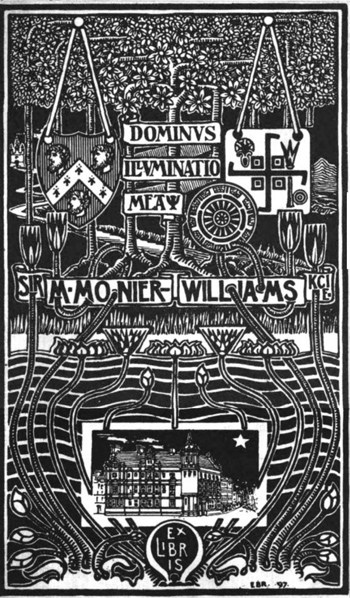
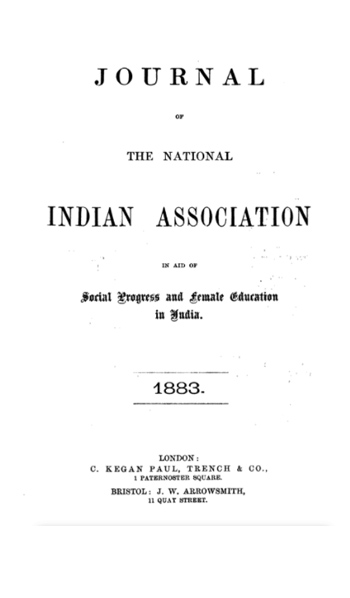
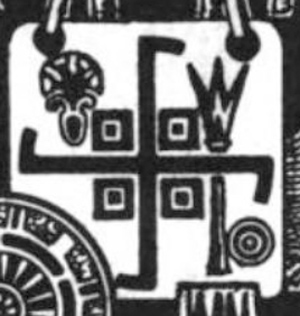
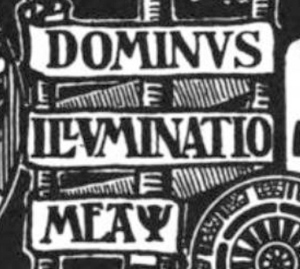
Dominus Illuminatio Mea [Lord is my light]
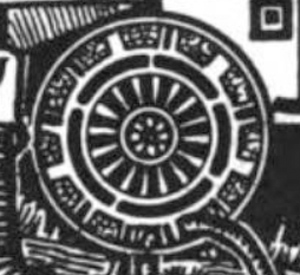
Mr. Nisi Kanta Chattopadhyaya has taken the degree of Doctor of Philosophy (Ph.D.) in the University of Zurich. The Dean of the Faculty and his colleagues, in conferring on him summa cum laude, the highest distinction of the University, expressed themselves as highly satisfied with the way in which he had passed the Examination.
****************************
1879, Excerpt from Masters and Men: The Human Story in the Mahatma Letters (a fictionalized account)
by Virginia Hanson
The Theosophical Publishing House
Madras, India
c 1980 The Theosophical Publishing House
Most of the Letters are over the signature of the Mahatma Koot Hoomi, usually signed simply "K.H." A Kashmiri Brahmin by birth, at the time of the correspondence he was a Buddhist. Koot Hoomi is a mystical name which he instructed H.P.B. to use in connection with his correspondence with Mr. Sinnett. It is possible that his real name was Nisi Kanta Chattopadhyaya, as that seems to have been the name by which he was known when he was attending at least one European University. He was fluent in both English and French and was sometimes affectionally spoken of by the Mahatma Morya as "my Frenchified K.H."
At one time, under special circumstances, the Mahatma Morya took over the correspondence temporarily. He too used only his initial as a signature. "He was a Rajput by birth," said H.P.B., "One of the warrior race of the Indian desert, the finest and handsomest nation in the world." He was "a giant, six feet eight, and splendidly built; a superb type of manly beauty." The Mahatma K.H. referred to him humorously as "my bulky brother." He was not proficient in English and spoke of himself as using words and phrases "lying idle in my friend's brain" -- meaning, of course, the brain of the Mahatma K.H.
by Theosophy Wiki
Accessed: 3/20/21
Nishikânta Chattopâdhyâya (1852-1910) was a well-known Hindu gentleman, Principal of the Hyderabad College and author of works on Oriental, Theosophical, philosophical, and other subjects. His name was erroneously thought to have been a pseudonym used by Master K.H. in Europe.
Personal life and education
Little is known of the life of Nishikânta Chattopâdhyâya. He was educated in Europe:
Mr. Nisi Kanta Chattopadhyaya has taken the degree of Doctor of Philosophy (Ph.D.) at the University of Zurich. The Dean of the Faculty and his colleagues, in conferring on him summa cum laude, highest distinction of the University, expressed themselves as highly satisfied with the way in which he had passed the Examination.[1]
Confusion with Master K.H.
In The Mahatma Letters, Master K.H. mentions a conversation he had with a certain "G. H. Fechner." Trying to verify this statement, C. C. Massey wrote to Dr. Hugo Wernekke, at Weimar, Germany, inquiring "whether Professor Fechner ever had such a conversation with an Oriental whom we could thus identify with Koot Humi." He received the following answer from Professor Gustav T. Fechner:
What Mr. Massey enquires about is undoubtedly in the main correct; the name of the Hindu concerned, when he was in Leipzig, was however, Nisi Kanta Chattopadhyaya, not Koot Humi. In the middle of the seventies he lived for about one year in Leipzig and aroused a certain interest owing to his foreign nationality, without being otherwise conspicuous; he was introduced to several families and became a member of the Academic Philosophical Society, to which you also belonged, where on one occasion he gave a lecture on Buddhism. I have these notes from Mr. Wirth, the Librarian of the Society, who is good enough to read to me three times a week. I also heard him give a lecture in a private circle on the position of women among the Hindus. I remember very well that he visited me once, and though I cannot remember our conversation, his statement that I questioned him about the faith of the Hindus is very likely correct. Apart from this I have not had personal intercourse with him; but, after his complete disappearance from Leipzig, I have been interested to hear about him, and especially to know that he plays an important role in his native country, such as undoubtedly he could not play here.[2]
C. C. Massey assumed that "Nisi Kanta Chattapadhyaya" was a pseudonym used by Master K.H. However, this is not the case. Charles J. Ryan reports[3] that Katherine Tingley met Dr. N. K. Chattopadhyaya when she was in Bombay in 1896, and received an autograph copy of his book, "The Reminiscences of the German University Life,"[4] where he talks about his encounter with Prof. G. T. Fechner.
An Important Correction
by Charles J. Ryan
[Reprinted from The Canadian Theosophist, December 15, 1936, pp. 326-329.]
Editor, Canadian Theosophist: - May I draw attention to one or two points in regard to Mr. H. R. W. Cox’s excellent defence of H.P.B. against the most recent attack. The first deals with a statement in your August number.
On pages 173-4 Mr. Cox discusses the problem of the Hindu who met a certain scholar named Fechner, and quotes Mr. Basil Crump’s Evolution. The main points are these: In The Mahatma Letters, p. 44, the Master K.H. mentions a conversation he had "one day" with a certain "G. H. Fechner", but does not say when or where it took place. Mr. Crump, in Evolution, informs us that C. C. Massey, once a leading Theosophist, received information from Leipzig that a Professor Fechner, living there, remembered having met a Hindu at some unnamed period and having heard him lecture. The Hindu also visited Professor Fechner. The Professor said that the name of the Hindu was Nisi Kanta Chattapadhyaya, and that he was not particularly conspicuous. Mr. Massey seems to have thought that he had, in this way, received independent evidence of the presence of the Master K.H. at Leipzig in the earlier ‘seventies, for he explains the reason that Professor Fechner did not know the name Koot Hoomi by a very reasonable supposition, viz.:"In case it may be wondered why he [the Master K.H.] used a different name, it may be mentioned that when members of this Order have to travel in the outer world they always do so incognito."
Mr. Cox appears to agree with Massey, or he would not quote the above remark in his defence of H. P. Blavatsky against the Messrs. Hares’ charges.
Unfortunately Nisi Kanta Chattopadhyaya and the Master K.H. are two different persons, and the argument is therefore not valid, useful as it would be if confirmed. The former was a well-known Hindu gentleman, Principal of the Hyderabad College and author of sundry interesting works on Oriental, philosophical, and other subjects. He was evidently interested in Theosophy, for he presented Katherine Tingley, when she was in Bombay in 1896, with an autograph copy of one of his books, now in the Oriental Department of the Theosophical Library at Point Loma, California.
The first article or chapter in this book is called "The Reminiscences of the German University Life," and it is a report of a lecture by Dr. N. K. Chattopadhyaya on April 30, 1892 at Secunderabad. In this chapter he says:"I once met Prof. Gustav Fechner, the author of a book called "Psycho-Physik" in which he has enunciated certain laws whose importance . . . . is as great as Newton’s Law of Gravitation . . . . I had the privilege of escorting the old sage home and on the way he asked quite a number of questions about the Yogis and the Fakirs of India . . . Seeing more of him by and by I came to discover that he was quite a mystic, and had actually written a book called the "Zend-Avesta" a masterly exposition of Vedantic pantheism in the light of modern science."
The "Sage" was, of course, the famous Gustav Theodor Fechner.
Turning to The Mahatma Letters, we find that the Master’s conversation "one day" was held with a certain G. H. Fechner, and, as mentioned above, it was not connected with Leipzig. Question: was the Master K.H. referring to some unknown Fechner whose initials were G. H. and not G. T. and who has not been identified? That seems highly improbable. Is it more likely that the H. is a mere slip of the pen or even a typographical error, and that the Master really referred to the eminent philosopher, with whom he had a short conversation, probably so short that it had been quite forgotten by G. T. Fechner, who only recollected N. K. Chattopadhyaya.
However this may be, Professor Gustav T. Fechner’s message to C. C. Massey cannot be used as if it related to the Master K.H., because the Professor definitely states that his Hindu was Chattopadhyaya, and the latter positively confirms the fact. We have learned from other sources that the Master spent some time in Germany, but I am not aware that Leipzig is mentioned in Theosophical literature in that connection. In the Sinnett letters, H. P. Blavatsky says:". . . Wurzburg. It is near Heidelberg and Nurenberg, and all the centres one of the Masters lived in, and it is He who advised my Master to send me there. . ." (p. 105)
My second point relates to what the Hare Brothers call the "notable admission" by H. P. Blavatsky in connection with alleged Mahatma letters sent by her to importunate claimants for advice on their personal, worldly affairs - not connected with Theosophy....
Charles J. Ryan.
General Offices, Theosophical Society,
Point Loma, California.
Writings
• The Yatras, or the Popular Dramas of Bengal. Ca. 1882. 16 editions published between 1882 and 1976 in English.
• Buddhism and Christianity, with an Appendix on Nirvana. London, 1882. 24 pages. Translated from the German in Indische Essays. The German edition Buddhismus und Christenthum. Mit einem Anhang über das Nirvâna was also published in 1882.
• Indische Essays. Zurich, 1883. Five editions published in 1883 in German and other languages.
• Three Lectures: the Reminiscences of the German University Life ; The True Theosophist ; and the Mricchakatikam, or, The Toy Cart. [Erscheinungsort nicht ermittelbar]: [Verlag nicht ermittelbar], gedr. 1895. 89 pages. Two editions published in 1895 in English.
• "Reminiscences of German University Life": a lecture delivered on the 30th April, 1892. 1901 in English.
• "The True Theosophist, or, Moral and Spiritual Culture: a Lecture". 1892 in English.
• "Mricchakatika or, The toy-cart of King Sūdraka; a study". Mysore: Graduates' Trading Association Press, 1902. English.
• The Mystic Story of Peter Schlemihl. Written with Adelbert von Chamisso. Mysore: Graduates' Trading Association Press, 1902.
• Lecture on Zoroastrianism. 1894. Madras: The Theosophist Office, 1906. English.
• Why Have I Accepted Islam. Two editions published in 1971 in English. Also published in Chicago, IL: Kazi Publications, [between 1980 and 1997].
• Social and Religious Reformation in India : a lecture delivered in the Rungacharlu Memorial Hall, Mysore, on November 27th, 1901. [Mysore], 1901. English.
• The Study of History: a lecture. 1902 in English.
• Notices and Reviews of Dr. Nishikanta Chattopádhyáya's Lectures. 1897 in English. [With a preface signed: Akhil Chandra Mukerjee.]
• Muhammed, "the Prophet of Islam": a lecture delivered on the 25th of November 1904, at the residence of Mirza Faiaz Ali Khan, Chudderghat, Hyderabad, Deccan. 1900. Sultanpura, Hyderabad: Villa Academy, 1971. English. 36 pages.
• Christ in the Koran. Allahabad: Indian Press, 1907. English.
• Two Essays on the Life and Philosophy of Ibn-Rushd or Averroes. Allahabad : M. Ghulam Muhammad, 1909.
Ibn Rushd (Arabic: ابن رشد; full name in Arabic: أبو الوليد محمد ابن احمد ابن رشد, romanized: Abū l-Walīd Muḥammad Ibn ʾAḥmad Ibn Rušd; 14 April 1126 – 11 December 1198), often Latinized as Averroes (English: /əˈvɛroʊiːz/), was a Muslim Andalusian polymath and jurist who wrote about many subjects, including philosophy, theology, medicine, astronomy, physics, psychology, mathematics, Islamic jurisprudence and law, and linguistics. The author of more than 100 books and treatises, Being described as "founding father of secular thought in Western Europe", his philosophical works include numerous commentaries on Aristotle, for which he was known in the western world as The Commentator and Father of rationalism. Ibn Rushd also served as a chief judge and a court physician for the Almohad Caliphate.
He was born in Córdoba in 1126 to a family of prominent judges—his grandfather was the chief judge of the city. In 1169 he was introduced to the caliph Abu Yaqub Yusuf, who was impressed with his knowledge, became his patron and commissioned many of Averroes' commentaries. Averroes later served multiple terms as a judge in Seville and Córdoba. In 1182, he was appointed as court physician and the chief judge of Córdoba. After Abu Yusuf's death in 1184, he remained in royal favor until he fell into disgrace in 1195. He was targeted on various charges—likely for political reasons—and was exiled to nearby Lucena. He returned to royal favor shortly before his death on 11 December 1198.
Averroes was a strong proponent of Aristotelianism; he attempted to restore what he considered the original teachings of Aristotle and opposed the Neoplatonist tendencies of earlier Muslim thinkers, such as Al-Farabi and Avicenna. He also defended the pursuit of philosophy against criticism by Ashari theologians such as Al-Ghazali. Averroes argued that philosophy was permissible in Islam and even compulsory among certain elites. He also argued scriptural text should be interpreted allegorically if it appeared to contradict conclusions reached by reason and philosophy. In Islamic jurisprudence, he wrote the Bidāyat al-Mujtahid on the differences between Islamic schools of law and the principles that caused their differences. In medicine, he proposed a new theory of stroke, described the signs and symptoms of Parkinson's disease for the first time, and might have been the first to identify the retina as the part of the eye responsible for sensing light. His medical book Al-Kulliyat fi al-Tibb, translated into Latin and known as the Colliget, became a textbook in Europe for centuries.
His legacy in the Islamic world was modest for geographical and intellectual reasons. In the west, Averroes was known for his extensive commentaries on Aristotle, many of which were translated into Latin and Hebrew. The translations of his work reawakened western European interest in Aristotle and Greek thinkers, an area of study that had been widely abandoned after the fall of the Roman Empire. His thoughts generated controversies in Latin Christendom and triggered a philosophical movement called Averroism based on his writings. His unity of the intellect thesis, proposing that all humans share the same intellect, became one of the most well-known and controversial Averroist doctrines in the west. His works were condemned by the Catholic Church in 1270 and 1277. Although weakened by condemnations and sustained critique from Thomas Aquinas, Latin Averroism continued to attract followers up to the sixteenth century.
-- Averroes, by Wikipedia
Additional resources
• "The Identity of Koot Hoomi of Kashmir" blog entry from the American Minervan. Accessed Jun 14, 2019.
Notes
1. National Indian Association, Journal of the National Indian Association (1883), 128.
2. Echoes of the Past: Master Koot Hoomi by Mary K. Neff
3. An Important Correction by Charles J. Ryan
4. Three Lectures : the Reminiscences of the German University Life ; The True Theosophist ; and the Mricchakatikam, or, The Toy Cart by Nishikânta Chattopâdhyâya
*************************
Chapter II: The Origin of the Yatra [Excerpt from The Bengali Drama: It's Origin and Development]
by P Guha-Thakurta
1930
If we carefully examine all the older and more primitive forms of dramatic art, even in peoples very far removed from each other geographically and ethnologically, we notice that “drama” in its first stage arises almost invariably from mimetic song and dancing as integral parts of some religious or secular rites. It is quite obvious that the Yatras, as we find them to-day, did not owe their origin mainly to the desire for amusements of a secular nature nor were they entirely the outcome of religious ritual. The name “yatra” literally means a “procession.” A “yatra” originally may have been such a procession as was customary with worshippers and devotees at the time of the regular festivals of their own god or cult. Some kind of musical performance and sympathetic dancing must have formed a part of the procession. Even when the “yatra” no longer remained rigidly connected with religious ceremonies at a regular place of worship, it was still called by its original name, “procession.” Professor Sylvain Levi observed: “Associes aux processions (Yatras) du culte ces spectacles en prirent le nom, et ils le garderent encore après s’etre detaches des ceremonies religieuses pour mener une existence independente.”1 [Google translate: Associated with the processions (Yatras) of the cult these spectacles took the name from it, and they kept it even after having detached themselves from the religious ceremonies to lead an independent existence.] Though one may trace a close connection between primitive drama and music and religious ritual in all countries, it should not be forgotten that the Yatras of Bengal differ in many important characteristics from all other varieties of dramatic representation, whether ancient or modern, and whether in the east or west. The difference lies not so much in the actual types of plays represented by the Yatras as in the specific circumstances under which the performances used to take place and still take place. We will go into this question in greater detail in subsequent chapters.2 The main difficulty in the way of arriving at definite conclusions in regard to the actual sources of the Yatra is the total absence of a chronological history of the older Yatras and their writers. The existing specimens belong to a much later period from 1800 downwards. If we were in possession of a really authentic list of all the Yatras, whether still in existence or not, we could have surmised something about their true nature and also the earlier methods of their production. It is quite probable that at a very early stage the Yatrawalas used to extemporize the music and words of the plays to suit a specific religious festival or social entertainment and that they made no serious attempt at literary composition or publication. We have also no means of discovering whether the religious festivals with which the Yatras were so closely associated in the beginning, are in any way similar to those held in ancient India in honour of the various gods and goddesses. In fact, we know only very little about the so-called “dramatic” festivals of ancient times. The account of alleged “dramatic spectacles” exhibited before the two disciples of Buddha, given in the early Buddhist literature and mentioned by Csoma Korosi,3 does not throw any real light upon the problem of historical sequence. In the third century B.C. Megasthenes speaks of the cult of Siva “as being very predominant among the inhabitants of the mountains who wreathed, anointed, carrying bells and cymbals, followed their kings during the festivals of this god.”4 The same writer describes how the Indo-Aryans belonging to the mountains “worshipped Dionysus or Siva while those of the plain Heracles or Vishnu, and indeed quite especially in his incarnation as Krishna.”5 Another historian tells us: “In the Mahabharata which, however, in its existing redaction, is conceived in the interest of Vishnuism, the cultus which we find most widely spread is that of Civa. He is the Dionysus of Megasthenes, who relates that he was worshipped especially upon the mountains, the rival cultus of Heracles or Krishna being thenceforth dominant in the plains of the Ganges.”6 Dr. Nisi Kanta Chattopadhyay has attempted to prove that all these religious festivals to which references are found in ancient Indian history partook of the nature of the Bengali Yatras and were as well their real precursors.7 This is, of course, extremely conjectural. There is no doubt that religious festivals in the form of dramatic pantomimes used to be performed in ancient India in connection with various popular gods and heroes, but certainly there is no historical evidence to prove a continuous evolution of these festivals or these spectacular performances. Lassen seems to have taken the right view in regard to this whole question: “There cannot be anything contrary to the supposition that similar festivals with similar representations were also celebrated at a much earlier period, although it must be reserved to further researches to show how early this was and of what nature these festivals really were.”8
The contention that the Yatra developed entirely or mainly in connection with the cult or worship of Krsna is open to objection on some very simple and obvious grounds. Firstly, the historical facts and literary data which generally give rise to this theory are quite insufficient and one-sided. For instance, Dr. Nisi Kanta Chattopadhyay attempts to prove it9 by a very exclusive treatment of a handful of Krsna-Yatras of only one well-known Yatrawala, Krsna Kamal Gosvami, published between 1860-71. Secondly, the repeated and persistent mention of Jaydeb’s Gita Gobinda, as if it were a Bengali Yatra, has led the champions of the Krsnaite origin of the Yatra into obvious mistakes. Gita Gobinda is not a Bengali drama; it is written in Sanskrit. Although it presents some traits of resemblance with some of the Krsna-Yatras, it can hardly be regarded as a representative of the Bengali Yatra proper. It is quite true that Bengal has for a long time been the stronghold of Vaisnava thoughts and ideas and that the religious and aesthetic movements started by Chaitanya [1486-1534] and his companions, have influenced Bengali life and literature to an enormous extent. But it should not be forgotten that religion of many forms and cults is inseparably connected with the life of the Hindus. The historian Barth bears witness to “the religious ardour with which the militant parties of the different sects maintain the exclusive title of their god to supremacy and adoration.”10 We know that in Bengal as well as in other parts of India, the cult of Siva flourished side by side with the cult of Krsna, and in fact, in point of historical time, the Siva cult is believed to have preceded the Krsna-cult.11 In the pre-Muhammadan period of Bengali history, Saivism grew up as a strong religious power, combated Buddhism, and succeeded in reviving and reinstating Hinduism in Bengal. It was not until much later, during the time of the Pauranic Renaissance in Bengal that Saivism declined and was overshadowed by the new Sakta-cult.12 An old Bengali journal named “Soma Prakas” is mentioned13 as having contained a statement to the effect that the Yatras that were in existence long before the coming of Chaitanya depended, almost without exception, on Sakta subjects and at that time the Krsna-Yatra was not even heard of. The Sakta cult, which in Bengal for the most part consists in the worship of the “Divine Mother” in the form of the goddess Kali or Durga or any of her other incarnations such as Chandi or Manasa, found its most characteristic expression in the popular Chandi-Yatras and Bhasan-Yatras. Most likely the Chandi-Yatra grew out of a very old type of musical performance called Chandir Gan (The Song of Chandi). The best specimens of the Chandi-Yatra in Bengal are those by Guru Prasad Ballabh of Farasdanga. The Bhasan-Yatra is usually connected with the annual festival of Manasa Devi in the villages of lower Bengal. The festival is both social and religious. Boat races and ‘mela’s (village fairs are held during the day and at night the worshippers keep vigil, and chant poems before the temple of the goddess. The songs are taken from the popular stories connected with Behula and Phullara and also from the events in the life of Chamd Saodagar (Chamd, the merchant) who, having fallen under the wrath of Manasa for defying her, wanders in many lands and is ultimately driven by strange circumstances to worship her. Bhasan-Yatras produced by Lausen Baral were among the best of their kind.14 The cult of Siva was also represented by those popular plays which dealt with the domestic scenes on Mount Kailas, the mythical abode of Siva. Mr. Binay Kumar Sarkar15 gives us an interesting account of an ancient Hindu institution, partly religious and partly dramatic, known as the Gambhara festival, which is entirely connected with the cult and worship of Siva. It used to be held in honour of Siva regularly every year in different parts of Bengal, Assam and Orissa. Mr. Sarkar things that “to a certain extent, the literature of the Gambhira-cycles may be compared with the Mystery and Miracle plays in old English and No-plays of Japan.”16 Mr. Sarkar traces the origin of the Gambhira institution from the very earliest times through the Vedas, epics, Buddhistic literature and the records of Hiuen Tsang, indicates the total extent of the geographical area through which it actually spread, deals with the dramatic devices and methods by which it was presented to the people, and points out its influence upon Bengali culture and folk-arts. Mr. Sarkar says, “The educative influence of such agencies as popular festivals is very well illustrated by their effects upon the literature, arts, industries, morals, and public spirit of the people who took part in this socio-religious ceremony in connection with the worship of Siva.”17 Besides the Saiva and Sakta Yatras, there actually existed in Bengal many other different varieties of Yatra such as the Rama-Yatra and Vidya-Sundar Yatra which were also very widely popular in their own time. Jay Chandra, Prem Chamd and Ananda were well-known Adhikaris or Yatrawalas, who became renowned in Bengal by their productions of the Rama Yatra. Gopal Uriya (1819-59) was the foremost among the producers of the Vidya-Sundar-Yatra. The songs and dances of Hira, a flower-girl, constituted the chief feature of all Vidya-Sundar-Yatras.18 The existence of Yatras other than Krsna-Yatras before the latter appeared in Bengal cannot, therefore, be doubted. Even Krsna Kamal Gosvami, to whose Yatras Dr. Nisi Kanta Chattopadhyay specifically refers, remarks19 that numerous plays based on the epics were existent in his own time, and the reason why he himself thought of writing some Krsna-Yatras was that he found the others either too learned for ordinary people or too much vitiated by obscenity. Krsna Kamal (1810-88) is perhaps the most renowned of all the reformers of the Yatra. The Krsna-Yatra in Bengal owes its increasing popularity and refinement almost entirely to Krsna Kamal. His first Yatra, called Svapna Bilas (Dream Pleasure) was composed about 1835. It was performed immediately by several Yatra-parties in Dacca. It was published some years later and had an amazing circulation. In a preface to his second production named Bichitra Bilas (The Amour Wonderful), Krsna Kamal wrote about Svapna Bilas: “The public probably liked the work; otherwise why should there be a sale of 20,000 copies in such a short time?” Rai Unmadini (The Frenzied Radha) which came after Bichitra Bilas, is perhaps his best and most finished Yatra. His other minor Yatras are Bharat Milan (The Meeting with Bharat), Nimai Sanyas (The Renunciation of Nimai), and Gostha (A Pastoral Idyll). Except Bharat Milan, in which the episode of the meeting of Bharat and Rama when Bharat implores Rama to come back to Ayodhya, is taken from the Mahabharata, all the Yatras of Krsna Kamal deal with incidents in the life of Krsna in Brndaban. His Krsna-Yatras were, as a rule, characterized by a strong emotional lyricism and the moral earnestness of a true Vaisnav. The Krsna-Yatra was developed and popularized by a host of other writers and producers, both before and after Krsna Kamal. The name of Sisuram Adhikari will always be remembered as one of the ablest and most successful producers of the Krsna-Yatra. He was a contemporary of Ram Prasad (1718-75) and Bharat Chandra (1722-60). An account of him appears in Rajendra Lal Mitra’s Bibidhartha Samgraha.20 The improvements Sisuram introduced into the Yatra were later carried on by his well-known disciple Sridam-Subal. Sridam-Subal also found a very worthy successor in Paramananda Das. At the time of Paramananda and his contemporary Prem Chamd of Vidya-Sundar-Yatra fame, the Krsna-Yatra reached its high-water mark. Paramananda introduced a new feature into the songs well known as “tukko” (which means the turning of the last part of a song written in payar style into a kirtan ending), which became very popular. After Paramananda’s death, his mantle fell on Gobinda Adhikari (1798-1870). Besides being a good producer, Gobinda was an original composer of songs, most of which were written in alliterative verse. Gobinda discarded his master’s “tukko” style of singing which was, however, revived later by his own disciple Badan. After the death of Badan, the Yatra began to decline in Bengal. The tradition was, however, carried on by inferior men like Brajanath and Nilkantha but they were unable to save the Yatra from its inevitable fate. It is quite evident that the later improved tone and healthier development of the Yatra came as a direct result of the Vaisnava revival under Chaitanya and his followers. Its gradual growth and expansion went hand in hand with the dissemination of the cult of Krsna. In fact, there actually came in the history of popular dramatic representations in Bengal a time when the Krsna-Yatra over-shadowed all others and became the most convenient instrument in the hands of the Vaisnavas to propagate their ideas amongst the masses.
From the above brief survey of the different varieties of the Bengali Yantras, it appears quite clearly that the theme of a Yatra was by no means necessarily taken from the life and adventures of Krsna, but was quite as often adapted from the Ramayana and Mahabharata, Pauranic legends, folk-tales, and mythology. Professor Sylvain Levi, while speaking of the very wide range of topics dealt with in the Yatras, observed: “Les auteurs ne sont pas interdit toutefois de sortir du cycle Krishnaite; ils ont emprunte sans scruple leurs sujets au Mahabharata et au Ramayana … le civaisme meme a prete parfois ses divinites et ses legends: temoin les amours de Civa et Parvati.”21 [Google translate: The authors are not however forbidden to leave the Krishnaite cycle; they unscrupulously borrowed their subjects from the Mahabharata and the Ramayana… the civaisme itself sometimes lent its divinities and its legends: witness the loves of Civa and Parvati.] Sir J.H. Marshall22 gives us a very interesting descriptive list of the various existing types of dramatic representations in India. It shows a large quantity of different themes which are adopted for the various performances and the many religious cults and institutions with which these are associated. There is no doubt that in Bengal, as elsewhere, the different social and religious institutions largely contributed to the development of literature and fine arts. As a matter of fact, at no point of their literary or religious history did the people of Bengal completely neglect or forget to celebrate in song, drama, poetry or ritual their innumerable gods and goddesses.23 A country like Bengal which is so old may quite reasonably claim to have a history or at least a legendary past of its own, the most important events of which will naturally have been utilized in a suitable manner for purposes of popular entertainment and instruction. It may be concluded, therefore, that the popular plays like the Yatra did not necessarily confine themselves to the worship and cult of Krsna or draw their inspiration only from the literature or history that gathered round this god, but drew freely from the Puranas and mythology, folk-legends and epic stories and, in fact, from every possible indigenous source.
The Bengali Yatra may be regarded then as a kind of community drama originating in the religious worship of the various gods and goddesses of antiquity and serving as a convenient medium through which the religious and social ideas and feelings appropriate to the different festivals and holidays, found a natural expression. Divine worship as a whole suggested the possibilities of dramatic representation, for which the epics and folk-literature gave characters, and the ancient mythology and Puranas furnished stories. In fact, no other type of popular drama has sprung so directly out of the peculiar conditions of Bengali life, nor has any other form of play developed in such definite and close connection with the distinctive aesthetic ideas and religious beliefs of the Bengali people. The merits and defects of the Yatra can be fully understood only if we bear in mind the essential characteristics of Bengali culture and the particular temperament and sentiments to which it has always appealed. To the entire rural Bengali community, the Yatras have been as familiar as their daily routine of life, acquainted as they are with all the traditional stories with which these plays deal. They recognize their heroes of history and legend as soon as they appear in a play and they accept from generation to generation, without the slightest demur, all the old tales of romance and mythology exactly in the way these are presented and interpreted to them through the Yatras.24 The Yatras most clearly demonstrate what a firm hold the Puranas, epics and mythology of the past have retained on the minds of the Bengali people. We are not, therefore, surprised in the least that the dramatic devices and methods of the Yatra should have remained pretty much the same for ages, and that the successive playwrights and Yatrawalas should have utilized the same stories over and over again.
_______________
Notes:
1. Le Theatre Indien, p. 394.
2. See Chaps. IV and V, pp. 20-30.
3. Asiatic Researches, xx, 50. See also Weber, Indische Literraturgeschichte, p. 217. Also Lassen, Indische Alterhumskunde, vol. ii, p. 502.
4. Indische Alterthumskunde, vol. ii, pp. 690 and 698.
5. Indische Alterthumskunde, vol. iii, p. 453; see also vol. i, pp. 795 and 925. Cf. Megasthenes, Indica, p. 135, ed. by Schwanbeck. Lassen's interpretation of the passage from Megasthenes has been contested by A. Weber (Indische Studien, ii, p. 409)
6. A. Barth, The Religions of India, trans. by J. Wood (1882), p. 163.
7. The Yatras or The Popular Dramas of Bengal, pp. 45 ff.
8. Indische Alterthumskunde, chap. ii. p. 505.
9. See The Yatras or The Popular Dramas of Bengal, pp. 2 ff.
10. The Religions of India, p. 183.
11. See D.C. Sen, History of Bengali Language and Literature, pp. 63-73 and 235-50.
12. Ibid., pp. 252-362.
13. See Amarendra Nath Ray's article entitled "Yatra Katha" in the first number of Rup o Ranga, 1321 B.S. (A.D. 1914-15).
14. For a fuller account of the cult of Manasa Devi, the folk literature connected with her, and the places where festivals are still regularly held in her honour, see D.C. Sen, History of Bengali Language and Literature, pp. 256 ff.
15. The Folk-Element in Hindu Culture, pp. 14 ff.
16. Ibid., p. 20.
17. Ibid., pp. 14-15.
18. A very interesting account of the Vidya-Sundar Yatras in Bengal appeared in Sanjib Chandra Chatterji's Yatra-Samalochana (A critical review of the Yatra), Calcutta, 1907.
19. See The Collected Works of Krsna Kamal Gosvami, 2nd ed., pp. 179-80.
20. Mentioned by Mr. Amarendra Nath Ray. See Rup o Ranga, first number, 1331 B.S. (A.D. 1924-25), p. 19.
21. Le Theatre Indien, p. 394.
22. See Dr. William Ridgeway's Dramas and Dramatic Dances of non-European Races, pp. 172-210.
23. "The Hindu tendency to deify the energies, nature-forces, or personal attributes or emotions has constructed all the gods and goddesses of India, practically speaking, as so many embodiments of the various phases of the country itself and of the culture it has developed through the ages. And the invention of deities has not yet ceased." -- Mr. B.K. Sarkar, Folk-Element in Hindu Culture, p. 260.
24. It may be mentioned in this connection that Aristotle approved of the choice of legendary themes for the Attic drama because of the inherent Greek faith in the mythology of the country and its intimate connection with the traditional history of the people. -- See Politics, C9.
**************************
Retrospect of the Year 1876-7, Excerpt from The Brahmo Year-Book for 1877: Brief Records of Work and Life in the Theistic Churches of India
edited by Sophia Dobson Collet
"Mercury" Steam Printing Works, High Street, Bedford
1877
Lastly, it should be mentioned that among the Indian youths who come to England for study, several Brahmos have won honourable distinction. Mr. Krishna Govinda Gupta, C.S., and Mr. Ananda Mohan Bose, M.A. Cantab., now a rising barrister of Calcutta, returned home in 1874; and during the past year, Mr. Prasanna Kumar Ray, having taken the degree of Dr. of Science (in Mental Philosophy) at the Universities of London and of Edinburgh, returned to India, and was shortly afterwards appointed Assistant-Professor at Patna College, and in the department of physical science. A Dacca friend informs me that Dr. Ray "is the President of a scientific society established at Patna, and periodical lectures on scientific subjects are delivered by himself and other Bengali gentlemen under its auspices." He also conducts divine service in the local Brahmo Somaj. -- Another young Brahmo, Babu Nisi Kanta Chattopadhaya, after studying some time at Edinburgh, and for two or three years at Leipzig, has lately been appointed Professor of Oriental Languages at the University of St. Petersburgh, an appointment probably resulting from the reputation which he has gained from various lectures on Oriental subjects which he delivered in Germany last winter. These lectures are now appearing in the Leipzig Duetsche Wochenschrift, and the two which have reached me are both able and interesting. The first, on "Buddhism and Christianity," [Buddhism and Christianity: The Chronology of the Hindus. Lectures in German by Nisi Kanta Chattopadhyaya. Published in the Deutsche Wochenschrift (German Weekly Journal), Nos. 1, 2, 11, 12, and 13. July and September, 1877. Leipzig: Carl Hildebrand. Thalstrasse 31.] has given much offence in some religious circles in Germany, from its freely expressed views on certain points. Doubtless the author's conception of Christianity is inadequate, and rests upon an insufficient knowledge of Christian life and history; but he warmly appreciates the moral idealism of Christ, and he writes to me thus of his general position towards Christianity: -- "It is not at all true that it is antagonistic, as is fancied by many here. In my lectures I have proceeded as objectively as possible, and I have consciously neither exalted Buddhism nor depreciated Christianity. Those who know me, know that I love the spirit of Christ, the life in Jesus, as much as ever."
It only remains to add that these four Brahmo students are all natives of East Bengal, and commenced their career at the Dacca College.
************************
Personal Intelligence, from Journal of the National Indian Association in Aid of Social Progress and Female Education in India
Dominus Illuminatio Mea [Lord is my light]
Sir M. Monier-Williams, KCIE
1883




Dominus Illuminatio Mea [Lord is my light]

Mr. Nisi Kanta Chattopadhyaya has taken the degree of Doctor of Philosophy (Ph.D.) in the University of Zurich. The Dean of the Faculty and his colleagues, in conferring on him summa cum laude, the highest distinction of the University, expressed themselves as highly satisfied with the way in which he had passed the Examination.
****************************
1879, Excerpt from Masters and Men: The Human Story in the Mahatma Letters (a fictionalized account)
by Virginia Hanson
The Theosophical Publishing House
Madras, India
c 1980 The Theosophical Publishing House
Most of the Letters are over the signature of the Mahatma Koot Hoomi, usually signed simply "K.H." A Kashmiri Brahmin by birth, at the time of the correspondence he was a Buddhist. Koot Hoomi is a mystical name which he instructed H.P.B. to use in connection with his correspondence with Mr. Sinnett. It is possible that his real name was Nisi Kanta Chattopadhyaya, as that seems to have been the name by which he was known when he was attending at least one European University. He was fluent in both English and French and was sometimes affectionally spoken of by the Mahatma Morya as "my Frenchified K.H."
At one time, under special circumstances, the Mahatma Morya took over the correspondence temporarily. He too used only his initial as a signature. "He was a Rajput by birth," said H.P.B., "One of the warrior race of the Indian desert, the finest and handsomest nation in the world." He was "a giant, six feet eight, and splendidly built; a superb type of manly beauty." The Mahatma K.H. referred to him humorously as "my bulky brother." He was not proficient in English and spoke of himself as using words and phrases "lying idle in my friend's brain" -- meaning, of course, the brain of the Mahatma K.H.
In 1870, the same year that Keshub visited England, two other Indians took ship from England to America. They were a Bombay textile magnate called Moolji Thackersey (Seth Damodar Thackersey Mulji, died 1880) and Mr. Tulsidas. Josephine Ransom, an early historian of the Theosophical Society, writes that they were “on a mission to the West to see what could be done to introduce Eastern spiritual and philosophic ideas.” Traveling on the same boat was Henry Olcott, fresh from his experiences in London’s spiritualist circles. Olcott was sufficiently impressed by this shipboard meeting to keep a framed photograph of the two Indians on the wall of the apartment he was sharing with Blavatsky in 1877. It was one evening in that year that a visitor who had traveled in India (sometimes identified as James Peebles) remarked on the photograph. Olcott writes in his memoirs of the consequences of this extraordinary series of coincidences:I took it down, showed it to him, and asked if he knew either of the two. He did know Moolji Thackersey and had quite recently met him in Bombay. I got the address, and by the next mail wrote to Moolji about our Society, our love for India and what caused it. In due course he replied in quite enthusiastic terms, accepted the offered diploma of membership, and told me about a great Hindu pandit and reformer, who had begun a powerful movement for the resuscitation of pure Vedic religion.
This reformer was Swami Dayananda Saraswati (1824-1882). In 1870 he was still an eccentric traveling preacher with no aspirations to international influence: something that grew on him precisely after meeting the Brahmo Samajists. He met Devandranath [Debendranath] Tagore in 1870; in 1873 Keshub Chunder Sen gave him the advice (which he took) to stop wearing only a loincloth and speaking only Sanskrit. Indefatigably stumping round the subcontinent, Dayananda founded his “powerful movement,” the Arya Samaj, in 1875. This chronology suggests that in 1870 Thackersey was probably coming to America as a representative of the Brahmo Samaj, but that by the time Olcott got in touch with him again, he had transferred his allegiance to the Arya Samaj.
The Arya Samaj was more radical than any wing of the Brahmo Samaj, on which it was partially modeled. Dayananda was a monotheist who believed in the Vedas as the sole revealed scripture and the basis for a universal religion. The various gods addressed in the Vedic hymns (Agni, Indra, etc.), he explained as aspects of the One, and he was prepared to demonstrate how these ancient texts contained all possible knowledge of man, nature, and the means of salvation and happiness. Of the quarrels between the various religions, he wrote: “My purpose and aim is to help in putting an end to this mutual wrangling, to preach universal truth, to bring all men under one religion so that they may, by ceasing to hate each other and firmly loving each other, life in peace and work for their common welfare.” He had no respect whatever for Brahmanism: for their scriptures, rituals, polytheism, caste system, and discrimination against women. Unfortunately for his opponents, he was immensely learned and articulate, could out-argue most pundits, and had, in the last resort (which often seems to have occurred) the advantage of being 6’9” tall and broad to match.
From Dayananda’s point of view, the Brahmo Samajists had erred both in their failure to recognize the supremacy of the Vedas, and in their too-ready embrace of the errors of other religions. They were moreover too addicted to Brahmanic customs and privileges. Here is a contemporary summary of his social principles:He says that no inhabitant of India should be called a Hindu, that an ignorant Brahmin should be made a Shudra, and a Shudra, who is learned, well-behaved and religious should be made a Brahmin. Both men and women should be taught Language, Grammar, Dharmashastras, Vedas, Science and Philosophy. Women should receive special education in Chemistry, Music and Medical Science; they should know what foods promote health, strength and vigour. He condemns child marriage as the root of the most of the evils. A girl should be educated and married at the age of twenty. If a widow wants to remarry, she should be allowed to do so. According to his opinion, there is no particular difference between the householder and the sannyasi.
It is not surprising that the Theosophists in New York took kindly to the Arya Samaj, at first through correspondence with Thackersey, then through the Bombay branch head, Hurrychund Chintamon, and lastly through Dayananda himself. The two societies were united for a time, though the Theosophists were disillusioned as soon as they discovered the strength of Dayananda's Vedic fundamentalism and his hostility to all other religions. On Dayananda's unexpected death, Blavatsky wrote a generous obituary in The Theosophist for December 1883. She appreciated him for defending what he saw as the best of his native heritage against the priestcraft of Brahmins and Christians alike, and for his leadership in an enlightened social policy of which she could only have approved.
As the Arya Samaj continued to flourish after Dayananda's death, it became a rallying point for that movement of Hindu nationalism that wanted neither to turn back the clock to Brahmanic theocracy, nor to embrace Western materialism along with the benefits of science and technology. What Rammohun Roy had set in motion, the Arya Samaj carried forward into the era of the Indian National Congress and the independence movement of the twentieth century. Dayananda himself died -- some said poisoned -- at the time when his mission was beginning to have real success among the North Indian rulers, but he had done enough to be celebrated as a father-figure by leaders of Indian independence such as Jawaharlal Nehru, Mahatma Gandhi, Indira Gandhi, and Aurobindo Ghose.
-- The Theosophical Enlightenment, by Joscelyn Godwin
- admin
- Site Admin
- Posts: 36135
- Joined: Thu Aug 01, 2013 5:21 am
Re: Freda Bedi Cont'd (#3)
Carl Gustav Carus
by Wikipedia
Accessed: 3/20/21
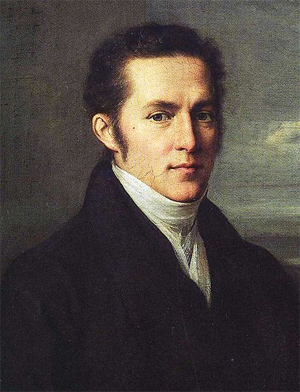
Carl Gustav Carus by Johann Carl Rößler
Carl Gustav Carus (3 January 1789 – 28 July 1869) was a German physiologist and painter, born in Leipzig, who played various roles during the Romantic era. A friend of the writer Johann Wolfgang von Goethe, he was a many-sided man: a doctor, a naturalist, a scientist, a psychologist, and a landscape painter who studied under Caspar David Friedrich.
Life and work
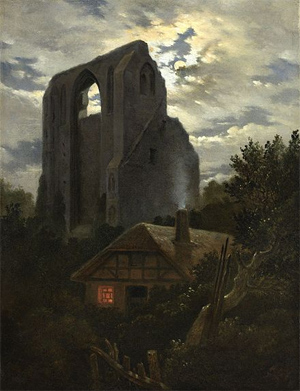
Carl Gustav Carus - Ruine Eldena mit Hütte bei Greifswald im Mondschein
In 1811 he graduated as a doctor of medicine and a doctor of philosophy. In 1814 he was appointed professor of obstetrics and director of the maternity clinic at the teaching institution for medicine and surgery in Dresden. He wrote on art theory. From 1814 to 1817 he taught himself oil painting working under Caspar David Friedrich, a Dresden landscape painter. Subsequently he studied under Julius Schnorr von Carolsfeld at the Oeser drawing academy.
When the King of Saxony, Frederick Augustus II, made an informal tour of Britain in 1844, Carus accompanied him as his personal physician. It was not a state visit, but the King, with Carus, was the guest of Queen Victoria and Prince Albert at Windsor Castle, and Carus was able to visit many of the sights in London and the university cities of Oxford and Cambridge, and meet others active in the field of scientific discoveries. They toured widely in England, Wales and Scotland, and afterwards Carus published, on the basis of his journal, The King of Saxony's Journey through England and Scotland, 1844.[1]
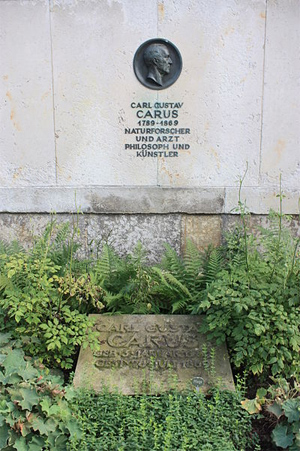
The grave of Carl Gustav Carus, Trinitatis-friedhof, Dresden
He is best known to scientists for originating the concept of the vertebrate archetype, a seminal idea in the development of Darwin's theory of evolution. In 1836, he was elected a foreign member of the Royal Swedish Academy of Sciences.[2] Carus is also noted for Psyche (1846).[3]
He developed a theory of landscape painting whose objective was the visualization of the inner workings of geological phenomena, which he called "Erdlebenbildkunst" (pictorial art of the life of the earth).[4]
Carl Jung credited Carus with pointing to the unconscious as the essential basis of the psyche.
Carus died in Dresden. He is buried in the Trinitatis-Friedhof (Trinitatis Cemetery) east of the city centre. The grave lies in the south-west section, against the southern wall.
Family
His daughter Charlotte Carus married the artist Ernst Rietschel.
Botanical Reference
The standard author abbreviation Carus is used to indicate this person as the author when citing a botanical name.[5]
Written works
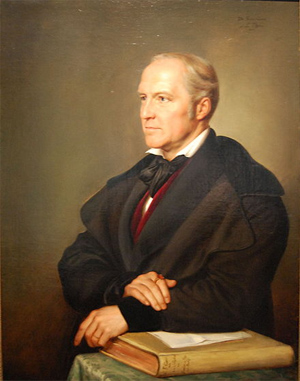
Carl Gustav Carus by Julius Hübner
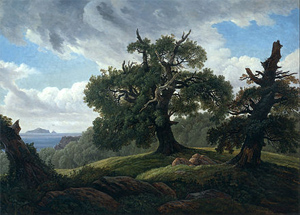
Memory of a Wooded Island in the Baltic Sea (Oak trees by the Sea)
Zoology, entomology, comparative anatomy, evolution
• Lehrbuch der Zootomie (1818, 1834).
• Erläuterungstafeln zur vergleichenden Anatomie (1826–1855).
• Von den äusseren Lebensbedingungen der weiss- und kaltblütigen Tiere (1824).
• Über den Blutkreislauf der Insekten (1827).
• Grundzüge der vergleichenden Anatomie und Physiologie (1828).
• Lehrbuch der Physiologie für Naturforscher und Aerzte (1838)- also medical
• Zwölf Briefe über das Erdleben (1841).
• Natur und Idee oder das Werdende und sein Gesetz. 1861.
Medical
• Lehrbuch der Gynekologie (1820, 1838).
• Grundzüge einer neuen Kranioskopie (1841).
• System der Physiologie (1847–1849).
• Erfahrungsresultate aus ärztlichen Studien und ärztlichen Wirken (1859).
• Neuer Atlas der Kranioskopie (1864).
Psychology, metaphysics, race, physiognomy
• Vorlesungen über Psychologie (1831).
• Psyche; zur Entwicklungsgeschichte der Seele (1846, 1851).
• Über Grund und Bedeutung der verschiedenen Formen der Hand in veschiedenen Personen (About the reason and significance of the various forms of hand in different persons)(1846).
• Physis. Zur Geschichte des leiblichen Lebens (1851).
• Denkschrift zum 100jährigen Geburtstagsfeste Goethes. Über ungleiche Befähigung der verschiedenen Symbolik der menschlichen Gestalt (1852, 1858).
• Über Lebensmagnetismus und über die magischen Wirkungen überhaupt (1857).
• Über die typisch gewordenen Abbildungen menschlicher Kopfformen (1863).
• Goethe dessen seine Bedeutung für unsere und die kommende Zeit (1863).
• Lebenserinnerungen und Denkwürdigkeiten – 4 volumes (1865–1866).
• Vergleichende Psychologie oder Geschichte der Seele in der Reihenfolge der Tierwelt (1866).
Art
• Neun Briefe über Landschaftsmalerei. Zuvor ein Brief von Goethe als Einleitung (1819–1831).
• Die Lebenskunst nach den Inschriften des Tempels zu Delphi ( 1863).
• Betrachtungen und Gedanken vor auserwählten Bildern der Dresdener Galerie (1867).
Travel
• Sicilien und Neapel (1856).
Translations
• Carus' translation of Dante Alighieri's Divine Comedy, Paradise, Canto I. at academia.edu
Art gallery
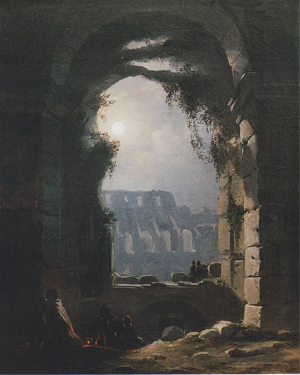
The Colosseum in Moonlight
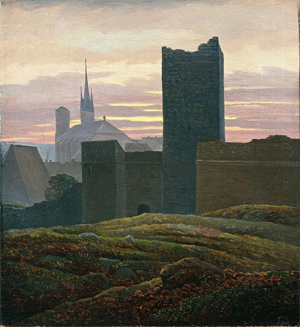
The Imperial Castle
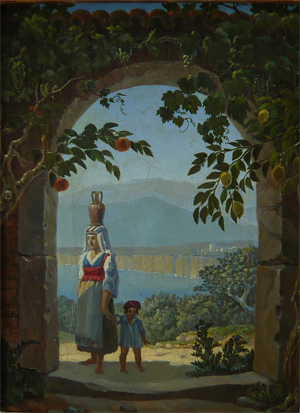
In Memory of Sorrento
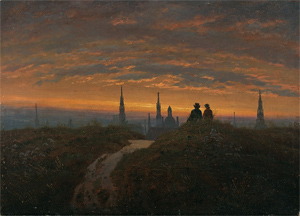
View of Dresden at Sunset
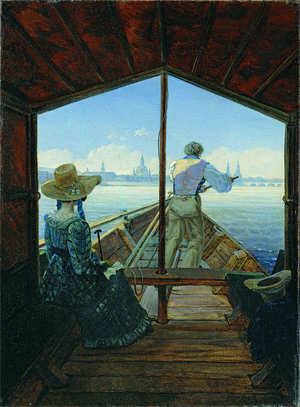
Barge Trip on the Elbe near Dresden
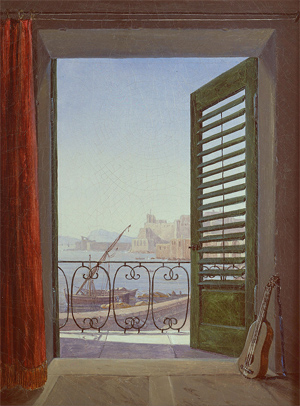
Balcony Room with a View of the Bay of Naples , 1829 or 1830.
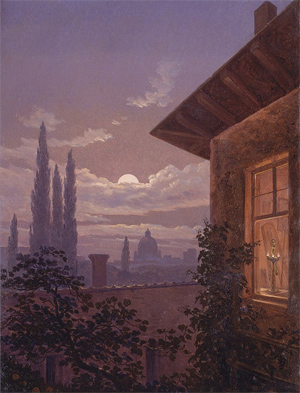
Italian Moonshine (Rome, St. Peter's in Moonshine)
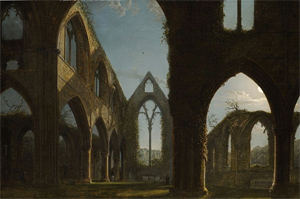
Tintern Abbey
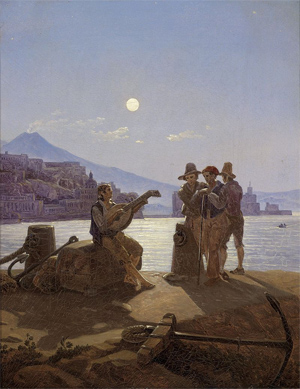
Italian Fishermen in Port
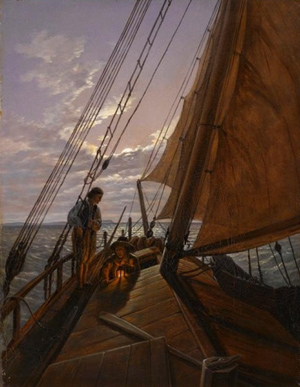
Sailboat
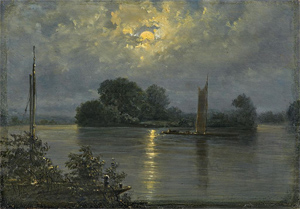
Full Moon near Pillnitz
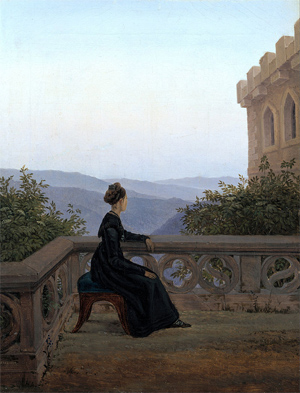
Woman on the Balcony
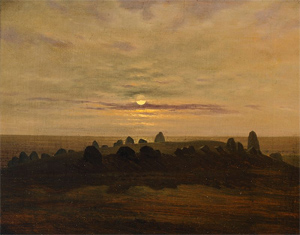
Stoane Age Mound
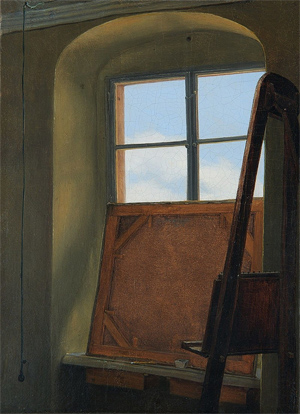
The Studio Window
See also
• Philosophy of the Unconscious (von Hartmann)
• List of German painters
References
1. C.G.Carus, The King of Saxony's Journey through England and Scotland, 1844, english edition, London, Chapman and Hall, 1846
2. Ellenberger, Henri F. (1970). The Discovery of the Unconscious: The History and Evolution of Dynamic Psychiatry. New York: Basic Books. pp. 207. ISBN 978-0-465-01672-3.
3. Whyte, Lancelot Law (1960). The Unconscious before Freud. New York: Basic Books. p. 148.
4. https://libmma.contentdm.oclc.org/digit ... 0/id/71300
5. IPNI. Carus.
Sources
• Jung, C.G. ([1959] 1969). The Archetypes and the Collective Unconscious, Collected Works, Volume 9, Part 1, Princeton, N.J.: Princeton University Press. ISBN 0-691-01833-2.
• "Carl GustavCarus", Art History: Romanticism
• Chisholm, Hugh, ed. (1911). "Carus, Karl Gustav" . Encyclopædia Britannica. 5 (11th ed.). Cambridge University Press.
• This article incorporates text from a publication now in the public domain: Wood, James, ed. (1907). The Nuttall Encyclopædia. London and New York: Frederick Warne. Missing or empty |title= (help)
External links
• Media related to Carl Gustav Carus at Wikimedia Commons
• Caspar David Friedrich: Moonwatchers, a full text exhibition catalog from The Metropolitan Museum of Art, which contains material on Carl Gustav Carus (no. 10-11)
• German masters of the nineteenth century: paintings and drawings from the Federal Republic of Germany, a full text exhibition catalog from The Metropolitan Museum of Art, which contains material on Carl Gustav Carus (no. 11-12)
• Carus, Carl Gustav (1848). Mnemosyne. Pforzheim: Flammer und Hofmann.
• Carl Gustav Carus' translation of Dante Alighieri's Paradise, canto I, at academia.edu
***************************
Carl Gustav Carus (1789–1869)
by Encyclopedia.com
Accessed: 3/20/21
Carl Gustav Carus, a German physician, biologist, and philosopher, was born in Leipzig and studied chemistry and then medicine at the University of Leipzig. In 1811 he became the first person to lecture there on comparative anatomy. Two years later he became director of the military hospital at Pfaffendorf and, in 1814, professor of medicine at the medical college of the University of Dresden, where he remained to the end of his life. He was appointed royal physician in 1827 and privy councilor in 1862.
Carus was widely known for his work in physiology, psychology, and philosophy, and was one of the first to do experimental work in comparative osteology, insect anatomy, and zootomy. He is also remembered as a landscape painter and art critic. He was influenced by Aristotle, Plato, Friedrich Wilhelm Joseph von Schelling, and Johann Wolfgang von Goethe, about whom Carus wrote several works, the most important of which is Goethe dessen seine Bedeutung für unsere und die kommende Zeit [Google translate: Goethe whose meaning for our and the coming time] (Vienna, 1863). Carus's philosophical writings were more or less forgotten until the German philosopher and psychologist, Ludwig Klages, resurrected them.
Carus's philosophy was essentially Aristotelian in that it followed the unfolding or elaboration of an idea in experience from an unorganized multiplicity to an organized unity. This universal, unfolding unity or developing multiplicity within unity Carus called God. God, or the Divine, is not a being analogous to human intelligence; rather, it is the ground of being revealed through becoming, through the infinitely numerous and infinitely varying beings or organisms that come into being through the Divine in space and time.
Carus called his theory of a divine or creative force "entheism." The unknown Divine is revealed in nature through organization, structure, and organic unity. As the ground of being, it is outside space and time, unchanging, and eternal. As thought or insight, it is the God-idea of religion, found everywhere in life and the cosmos. As life, it is the sphere, the basic form taken by living cells and the heavenly stars. As matter, it is the ether exfoliating in infinitely varied things.
According to Carus, the body cannot be separated from the soul. Both are soul, but we speak of "body" when some unknown part of the soul affects the known part; and we speak of "soul" when the known part affects the unknown part.
Carus's metaphysics, and his important contribution to psychology, is a theory of movement from unconsciousness to consciousness and back again. Whatever understanding we can have of life and the human spirit hinges upon observation of how universal unconsciousness, the unknown Divine, becomes conscious. Universal unconsciousness is not teleological in itself; it achieves purpose only as it becomes conscious through conscious individuals. Consciousness is not more permanent than things; it is a moment between past and future. As a moment, it can maintain itself only through sleep or a return to the unknown.
***************************
Carl Gustav Carus, the first director of the newly established maternity institute of the Dresden Royal Surgical-Medical Academy 1814-1827
by B. Sarembe
1989
Abstract
Carl Gustav Carus was born in 1789 in Leipzig. He studied at the University of Leipzig. His specialization in Gynecology and Obstetrics took place at the Triersches Maternity Hospital. In 1814 he was named Professor for Obstetrics in Dresden at the Royal-Surgical-Medical-Academy. He was the head of the Maternity Hospital till 1827. Under his direction many midwives, students and physicians were educated. He published numerous articles and books on medical and philosophical-psychological topics. He was a talented artist of the Romantic especially in painting landscapes. He was a friend of Caspar David Friedrich and Johann Wolfgang von Goethe. After 1827 he was the physician in ordinary to 3 saxonian kings. He died in 1869. The Medical Academy in Dresden bears his name "Carl Gustav Carus" since its foundation.
by Wikipedia
Accessed: 3/20/21
We often hear of negroes who have learnt music, who are clerks in banking-houses, and who know how to read, write, count, dance, and speak, like white men. People are astonished at this, and conclude that the negro is capable of everything! And then, in the same breath, they will express surprise at the contrast between the Slav civilization and our own. The Russians, Poles, and Serbians (they will say), even though they are far nearer to us than the negroes, are only civilized on the surface; the higher classes alone participate in our ideas, owing to the continual admixture of English, French, and German blood. The masses, on the other hand, are invincibly ignorant of the Western world and its movements, although they have been Christian for so many centuries — in many cases before we were converted ourselves! The solution is simple. There is a great difference between imitation and conviction. Imitation does not necessarily imply a serious breach with hereditary instincts; but no one has a real part in any civilization until he is able to make progress by himself, without direction from others.* [In discussing the list of remarkable negroes which is given in the first instance by Blumenbach and could easily be supplemented, Carus well says that among the black races there has never been any politics or literature or any developed ideas of art, and that when any individual negroes have distinguished themselves it has always been the result of white influence. There is not a single man among them to be compared, I will not say to one of our men of genius, but to the heroes of the yellow races — for example, Confucius. (Carus, op. cit.)] What is the use of telling me how clever some particular savages are in guiding the plough, in spelling, or reading, when they are only repeating the lessons they have learnt? Show me rather, among the many regions in which negroes have lived for ages in contact with Europeans, one single place where, in addition to the religious doctrines, the ideas, customs, and institutions of even one European people have been so completely assimilated that progress in them is made as naturally and spontaneously as among ourselves. Show me a place where the introduction of printing has had results, similar to those in Europe, where our sciences are brought to perfection, where new applications are made of our discoveries, where our philosophies are the parents of other philosophies, of political systems, of literature and art, of books, statues, and pictures!...
Owen's observations have, no doubt, considerable value; I would prefer, however, the most recent of the craniological systems, which is at the same time, in many ways, the most ingenious, I mean that of the American scholar Morton, adopted by Carus.* [Carus, op. cit., from which the following details are taken.] In outline this is as follows:
To show the difference of races, Morton and Carus started from the idea, that the greater the size of the skull, the higher the type to which the individual belonged, and they set out to investigate whether the development of the skull is equal in all the human races.
To solve this question, Morton took a certain number of heads belonging to whites, Mongols, negroes, and Redskins of North America. He stopped all the openings with cotton, except the foramen magnum, and completely filled the inside with carefully dried grains of pepper. He then compared the number of grains in each....
[Carus] likes to think that, just as we see our planet pass through the four stages of day and night, evening and morning twilight, so there must be in the human species four subdivisions corresponding to these. He sees here a symbol, which is always a temptation for a subtle mind. Carus yields to it, as many of his learned fellow-countrymen would have done in his place. The white races are the nations of the day; the black those of the night; the yellow those of the Eastern, and the red those of the Western twilight. We may easily guess the ingenious comparisons suggested by such a picture. Thus, the European nations, owing to the brilliance of their scientific knowledge and the clear outlines of their civilization, are obviously in the full glare of day, while the negroes sleep in the darkness of ignorance, and the Chinese live in a half-light that gives them an incomplete, though powerful, social development. As for the Redskins, who are gradually disappearing from the earth, where can we find a more beautiful image of their fate than the setting sun?...
We must mention another law before going further. Crossing of blood does not merely imply the fusion of the two varieties, but also creates new characteristics, which henceforth furnish the most important standpoint from which to consider any particular sub-species. Examples will be given later; meanwhile I need hardly say that these new and original qualities cannot be completely developed unless there has previously been a perfect fusion of the parent-types; otherwise the tertiary race cannot be considered as really established. The larger the two nations are, the greater will naturally be the time required for their fusion. But until the process is complete, and a state of physiological identity brought about, no new sub-species will be possible, as there is no question of normal development from an original, though composite source, but merely of the confusion and disorder that are always engendered from the imperfect mixture of elements which are naturally foreign to each other.
Our actual knowledge of the life of these tertiary races is very slight. Only in the misty beginnings of human history can we catch a glimpse, in certain places, of the white race when it was still in this stage — a stage which seems to have been everywhere short-lived. The civilizing instincts of these chosen peoples were continually forcing them to mix their blood with that of others. As for the black and yellow types, they are mere savages in the tertiary stage, and have no history at all.* [[Carl Gustav] Carus gives his powerful support to the law I have laid down, namely that the civilizing races are especially prone to mix their blood. He points out the immense variety of elements composing the perfected human organism, as against the simplicity of the infinitesimal beings on the lowest step in the scale of creation. He deduces the following axiom: "Whenever there is an extreme likeness between the elements of an organic whole, its state cannot be regarded as the expression of a complete and final development, but is merely primitive and elementary" (uber die ungleiche Befahigkeit der verschiedenen Menschheitstamme fur hohere geistige Entwickelung, p. 4). In another place he says: "The greatest possible diversity (i.e. inequality) of the parts, together with the most complete unity of the whole, is clearly, in every sphere, the standard of the highest perfection of an organism." In the political world this is the state of a society where the governing classes are racially quite distinct from the masses, while being themselves carefully organised into a strict hierarchy.]...
Is there also an inequality in physical strength? The American savages, like the Hindus, are certainly our inferiors in this respect, as are also the Australians. The negroes, too, have less muscular power;* [See (among other authorities), for the American aborigine, Martius and Spix, Reise in Brasilien, vol. i, p. 259; for the negroes, Pruner, Der Neger, eine aphoristische Skizze aus der medizinischen Topographie von Cairo, in the Zeitschrift der Deutschen morgenlandischen Gesellschaft, vol. i, p. 131; for the muscular superiority of the white race over all the others, Carus, op. cit., p. 84.] and all these peoples are infinitely less able to bear fatigue...
The negroid variety is the lowest, and stands at the foot of the ladder. The animal character, that appears in the shape of the pelvis, is stamped on the negro from birth, and foreshadows his destiny. His intellect will always move within a very narrow circle. He is not however a mere brute, for behind his low receding brow, in the middle of his skull, we can see signs of a powerful energy, however crude its objects. If his mental faculties are dull or even non-existent, he often has an intensity of desire, and so of will, which may be called terrible. Many of his senses, especially taste and smell, are developed to an extent unknown to the other two races.* [Taste and smell in the negro are as powerful as they are undiscriminating. He eats everything, and odours which are revolting to us are pleasant to him" (Pruner).]
The very strength of his sensations is the most striking proof of his inferiority. All food is good in his eyes, nothing disgusts or repels him. What he desires is to eat, to eat furiously, and to excess; no carrion is too revolting to be swallowed by him. It is the same with odours; his inordinate desires are satisfied with all, however coarse or even horrible. To these qualities may be added an instability and capriciousness of feeling, that cannot be tied down to any single object, and which, so far as he is concerned, do away with all distinctions of good and evil. We might even say that the violence with which he pursues the object that has aroused his senses and inflamed his desires is a guarantee of the desires being soon satisfied and the object forgotten. Finally, he is equally careless of his own life and that of others: he kills willingly, for the sake of killing; and this human machine, in whom it is so easy to arouse emotion, shows, in face of suffering, either a monstrous indifference or a cowardice that seeks a voluntary refuge in death.
The yellow race is the exact opposite of this type. The skull points forward, not backward. The forehead is wide and bony, often high and projecting. The shape of the face is triangular, the nose and chin showing none of the coarse protuberances that mark the negro. There is further a general proneness to obesity, which, though not confined to the yellow type, is found there more frequently than in the others. The yellow man has little physical energy, and is inclined to apathy; he commits none of the strange excesses so common among negroes. His desires are feeble, his will-power rather obstinate than violent; his longing for material pleasures, though constant, is kept within bounds. A rare glutton by nature, he shows far more discrimination in his choice of food. He tends to mediocrity in everything; he understands easily enough anything not too deep or sublime.* [Carus, op. cit., p. 60.] He has a love of utility and a respect for order, and knows the value of a certain amount of freedom. He is practical, in the narrowest sense of the word. He does not dream or theorize; he invents little, but can appreciate and take over what is useful to him. His whole desire is to live in the easiest and most comfortable way possible. The yellow races are thus clearly superior to the black. Every founder of a civilization would wish the backbone of his society, his middle class, to consist of such men. But no civilized society could be created by them; they could not supply its nerve-force, or set in motion the springs of beauty and action.
-- The Inequality of Human Races, by Arthur De Gobineau

Carl Gustav Carus by Johann Carl Rößler
Carl Gustav Carus (3 January 1789 – 28 July 1869) was a German physiologist and painter, born in Leipzig, who played various roles during the Romantic era. A friend of the writer Johann Wolfgang von Goethe, he was a many-sided man: a doctor, a naturalist, a scientist, a psychologist, and a landscape painter who studied under Caspar David Friedrich.
Life and work

Carl Gustav Carus - Ruine Eldena mit Hütte bei Greifswald im Mondschein
In 1811 he graduated as a doctor of medicine and a doctor of philosophy. In 1814 he was appointed professor of obstetrics and director of the maternity clinic at the teaching institution for medicine and surgery in Dresden. He wrote on art theory. From 1814 to 1817 he taught himself oil painting working under Caspar David Friedrich, a Dresden landscape painter. Subsequently he studied under Julius Schnorr von Carolsfeld at the Oeser drawing academy.
When the King of Saxony, Frederick Augustus II, made an informal tour of Britain in 1844, Carus accompanied him as his personal physician. It was not a state visit, but the King, with Carus, was the guest of Queen Victoria and Prince Albert at Windsor Castle, and Carus was able to visit many of the sights in London and the university cities of Oxford and Cambridge, and meet others active in the field of scientific discoveries. They toured widely in England, Wales and Scotland, and afterwards Carus published, on the basis of his journal, The King of Saxony's Journey through England and Scotland, 1844.[1]

The grave of Carl Gustav Carus, Trinitatis-friedhof, Dresden
He is best known to scientists for originating the concept of the vertebrate archetype, a seminal idea in the development of Darwin's theory of evolution. In 1836, he was elected a foreign member of the Royal Swedish Academy of Sciences.[2] Carus is also noted for Psyche (1846).[3]
He developed a theory of landscape painting whose objective was the visualization of the inner workings of geological phenomena, which he called "Erdlebenbildkunst" (pictorial art of the life of the earth).[4]
Carl Jung credited Carus with pointing to the unconscious as the essential basis of the psyche.
Although various philosophers, among them Leibniz, Kant, and Schelling, had already pointed very clearly to the problem of the dark side of the psyche, it was a physician who felt impelled, from his scientific and medical experience, to point to the unconscious as the essential basis of the psyche. This was C. G. Carus, the authority whom Eduard von Hartmann followed. (Jung [1959] 1969, par. 259)
Carus died in Dresden. He is buried in the Trinitatis-Friedhof (Trinitatis Cemetery) east of the city centre. The grave lies in the south-west section, against the southern wall.
Family
His daughter Charlotte Carus married the artist Ernst Rietschel.
Carus, August Gottlob (1763-1842) (August 3rd, 1763, Dahme / Mark)
Relationships: Carus, Carl Gustav (1789-1869) [son]
-- August Gottlob Carus, by Kalliope Verbund
Born in Leipzig in 1789 as the son of the independent master dyer August Gottlob Carus, Carus attended the Thomas-Gymnasium here and began university studies in Leipzig in 1804. After initially attending scientific, medical and philosophical colleges, he decided in 1806 to study medicine exclusively and took lessons at the drawing academy at the same time. His studies were followed by an internship at the St. Jakobs Hospital and his work as a trainee in the practice of the obstetrician Johann Christian Gottfried Joerg (1779–1856).
-- Diseases of the urinary tract during the time of the Dresden doctor Carl Gustav Carus, by Albrecht Scholz, Sigrid Schulz-Beer
Chronology
1789 Carl Gustav Carus born in Leipzig on 3 January, only son of August Gottlob Ehrenfried Carus (1763-1842) and Christiane Elisabeth, née Jàger (1763-1846). His father rents and runs a small dyehouse just outside the city. Despite its modest circumstances, this artisan family has an illustrious circle of friends, including the publishers Christoph Gottlob Breitkopf, Gottfried Christoph Hàrtel, and Georg Joachim Goschen; the choirmaster of the Thomaskirche, August Eberhard Muller; the naturalist Wilhelm Gottfried Tilesius; and the musical writer Friedrich Rochlitz.
1801 Hitherto privately educated, Carl Gustav enters the celebrated Thomasschule in Leipzig, which he attends as a day student until 1804. On walking expeditions in the surrounding countryside with his drawing teacher, Julius Dietz (1770-1843), he makes studies of rocks, plants, and trees.
1804 With Dietz, Carus travels on foot to Dresden to visit the city's celebrated art museum, the Gemáldegalerie. On 21 April, Carus enters Universitàt Leipzig as a student of chemistry, physics, and botany, to which he later adds zoology, geology, and mineralogy.
1806 He transfers to medicine, probably on the advice of his distant relative Friedrich August Carus, the Leipzig professor of philosophy, and in view of the need to choose a profession. He studies anatomy under Christian Rosenmuller (1771-1820), and physiology under Karl Friedrich Burdach (1776-1847), who encourages him to investigate the central nervous system. He attends the drawing academy conducted by Johann Friedrich August Tischbein (the "Leipzig" Tischbein, 1750-1812) and by Veit Hans Schnorr (1764-1841). He strikes up a friendship with Johann Gottlob Regis (1791-1854), the future translator of Rabelais, Shakespeare, and Swift. While a medical student, Carus encounters the nature philosophy of Friedrich Wilhelm Joseph Schelling (1775-1854) and of his follower, the philosopher and physician Lorenz Oken (1779—1851), author of the successful Lehrbuch des Systems der Naturphilosophie (Manual of the system of nature philosophy; 1809-11).
1809 Carus embarks on clinical training at the St. Jakob-Hospital in Leipzig under its director, J. Chr. L. Reinhold (1769-1809) and the surgeon J. Chr. A. Clarus (1774-1854). Then, J. Chr. G. Joerg (1779-1856), one of the founders of modern gynecology, invites him to join the maternity hospital in Leipzig.
1811 Carus graduates on 24 March as doctor of philosophy and master of liberal arts. In the same year he obtains his professorial qualification (Habilitation) in the faculty of philosophy and (on 11 October) a license to lecture (as Magister legens). He takes his doctorate in medicine on 20 December with a dissertation De uteri rheumatismo (On the rheumatic inflammation of the uterus). On 1 November Carus marries his father's stepsister, Caroline Carus (1784-1859). First essays in oil painting.
1812 Carus takes up teaching duties at the Universitàt Leipzig, giving classes in comparative anatomy.
1813 In charge of a French field hospital outside Leipzig during the "Battle of the Nations" Carus is horrified by the indifference of rulers to the slaughter of thousands. He catches typhus and fights for his life for three weeks. His physician and teacher Clarus gives him up for dead, but he recovers.
1814 Breitkopf und Hàrtel of Leipzig publish Carus's voluminous work Versuch einer Darstellung des Nervensystems und insbesondere des Gehirns nach ihrer Bedeutung, Entwicklung und Vollendung im thierischen Organismus (Essay on the nervous system, and the brain in particular, with reference to its importance, evolution, and maturation within the animal organism). He is offered a chair of physiology and anatomy at the German university in Dorpat (Estonia), and another at the Provisorische Lehranstalt fur Medizin und Chirurgie (Provisional school of medicine and surgery) in Dresden, combined with the directorship of the maternity hospital there; he moves to Dresden in the winter of 1814 to 1815.
1815 Confirmed as professor at the Kôniglich-Sàchsische Chirurgisch-Medicinische Akademie (Royal Saxon surgical and medical academy). Inaugural address at the official opening of the Akademie in August 1816. In Dresden, Carus visits the landscape painter and etcher Johann Christian Klengel (1751-1824), who encourages but also disappoints him. Begins to write the Nine Letters on Landscape Painting (this is the date given in the first edition; in the Lebenserinnerungen he gives the date as circa 1816: Carl Gustav Carus, Lebenserinnerungen und Denkwurdigkeiten, 3 vols. [Leipzig: Brockhaus, 1865—66], 1:181).
1816 Death of Carus's son Ernst Albert, of scarlet fever. First submission to the art exhibition of the Dresden Akademie: four paintings. Probably in 1816 or thereabouts, Carus has his first contact with Caspar David Friedrich (1774-1840), which leads to a close friendship lasting some ten years. Carus visits Abraham Gottlob Werner (1750-1817), inspector and instructor of mining and mineralogy in the Bergakademie (Mining academy) at Freiberg in the Erzgebirge.
1817-18 Carus visits Berlin for the first time.
1818 Carus publishes his Lehrbuch der Zootomie (Manual of zootomy) and sends a copy to Johann Wolfgang von Goethe (1749-1832). Goethe and Carus begin to correspond; both become members of the Kaiserlich-Leopoldinisch-Carolinische Deutsche Akademie der Naturforscher (Emperor Leopold-Carolingian German academy of naturalists) at Halle an der Saale, founded in 1652. The Norwegian landscape painter Johan Christian Clausen Dahl (1788-1857) arrives in Dresden to pursue his studies and makes the acquaintance of both Friedrich and Carus.
1819 Carus makes a journey to the Baltic coast (with Friedrich's example in mind) and visits Friedrich's brothers at Neubrandenburg and Greifswald; visits the island of Rugen and the chalk cliffs of the Kónigsstuhl. On this trip, Carus makes sixty-two drawings.
1820 Carus publishes the two-volume Lehrbuch der Gynákologie, the first manual of gynecology ever published in Germany; the book makes Carus famous and goes into five editions. He visits Carlsbad, where he meets the philosopher Friedrich Wilhelm Joseph Schelling (1775-1854) before traveling on to Prague and Zittau. At Caspar David Friedrich's suggestion, he hikes along the crest of the Riesengebirge. The celebrated Danish sculptor Berthel Thorvaldsen (1770-1844) visits Carus in Dresden on his way from Warsaw to Vienna.
1821 Carus meets with Goethe in person, for the only time in his life, in Weimar on 21 July. Carus is traveling to Switzerland on his way to visit Italy for the first time; the trip takes him as far as Genoa. On 12 September Carus climbs Mont Anvert, in the Massif du Mont-Blanc; he draws the mountain and later produces a painting based on his drawings. Carus meets the writer and translator of Shakespeare, Ludwig Tieck (1773-1853); from 1824 onward he will regularly take part in readings in Tieck's home.
1822 In February Carus sends to Goethe all that he has so far written of Letters on Landscape Painting: letters I, II, III, and V, together with three illustrations or sketches for illustrations for his projected scientific treatise on primitive portions of the bone and shell skeleton. Receives royal appointments as a court counselor and medical counselor. Delivers a commemorative lecture at the Gesellschaft deutscher Naturforscher und Àrzte (Society of German naturalists and physicians), which he has founded jointly with Lorenz Oken (1779-1851): Von den Anforderungen an eine kunftige Bearbeitung der Naturwissenschaften (On the requirements of the future practice of the natural sciences).
1823 Carus publishes an essay, "Grundzuge allgemeiner Naturbetrachtung" (General principles of the observation of nature), in volume 2 of Goethe's periodical Zur Naturwissensckaft uberbaupt, besonders zur Morphologie (On natural science in general and morphology in particular).
1824 In Uber Kunst und Altertum (On art and antiquity) Goethe discusses the geognostic landscapes exhibited by Carus in Weimar in September. Carus completes Letters on Landscape Painting (letters VI through IX).
1825 In August, visits Berlin.
1826 Alexander von Humboldt (1769-1859) pays his first visit to Carus in Dresden. Henceforth, he will always stop over to see Carus when traveling in the suite of the king of Prussia, Friedrich Wilhelm III, to Bad Teplitz in Bohemia. Carus begins work on the Zwôlf Briefe über das Erdleben (Twelve letters on earth life), published in 1841. In the Kunst-Blatt, edited by Ludwig Schorn, Carus publishes one of Letters on Landscape Painting (letter VIII).
1827 Death of King Friedrich August of Saxony. The new King Anton (1755-1836) appoints Carus "Hof- und Medicinalrath" (Court and medical counselor), and Carus joins the Collegium (council of government). He retires from teaching and from the directorship of the Leipzig maternity hospital. As court physician he enjoys greater financial independence and more free time; he intensifies his activity as a scientist and as a writer. Carus publishes his discovery of the circulation of the blood in insect larvae.
1828 Carus publishes Von den Ur-Theilen des Knochen- und Schalengerüstes (On the primitive portions of the bone and shell skeleton). He declines a professorial appointment in Berlin. Second visit to Italy (Florence, Rome, Naples, Paestum) in the company of Crown Prince Friedrich August. In Rome, he meets with Thorvaldsen and is introduced to the German artistic colony. His friendship with Friedrich is under a cloud, the consequence—according to Carus—of Friedrich's "confused mental state."
1831 First edition of Nine Letters on Landscape Painting published by Gerhard Fleischer, Leipzig.
1832 After Goethe's death on 22 March 1832, Carus paints his Goethe Memorial; or, In Memory of Goethe: Landscape Fantasy, aiming to complete the painting by 28 August (Goethe's birthday).
1833 Carus succeeds Johann Gottlieb von Quandt (1787-1859) as president of the Dresdner Kunstverein, remaining in office until 1842. In November Carus purchases Villa Cara, a large house with gardens in the eastern suburbs of Dresden (destroyed in 1945).
1834 The French sculptor Pierre-Jean David d'Angers (1788-1856) comes to Dresden to make a bust of Tieck. He also executes a profile relief of Carus. Carus takes him to see Friedrich. Deeply impressed, David d'Angers buys a number of paintings from Friedrich. Carus gives him a number of his own paintings, receiving in return a number of statuettes and a plaster cast of David's bust of his own revered authority, the naturalist Georges de Cuvier (1769-1832).
1835 In August Carus travels via Koblenz, Mainz, and Metz to Paris, where he meets with Alexander von Humboldt. The second edition of Letters on Landscape Painting, with an additional, tenth letter, is published in Leipzig by Gerhard Fleischer. Under the same imprint, Carus brings out his Reise durch Deutschland, Italien und die Schweitz imjahre 1828 (Journey through Germany, Italy, and Switzerland in the year 1828).
1836 Death of King Anton. Friedrich August II ascends the throne. Carus publishes (again in Leipzig) his journal of a journey to the Rhine valley and to Paris. Alexander von Humboldt visits with Carus in Dresden; they discuss Zwôlf Brief e über das Erdleben and Humboldt's related undertaking, Kosmos: Entwurf einer physischen Weltbeschreibung (Cosmos: Notes for a physical description of the world).
1839 Carus attends the opening ceremony of the Leipzig-Dresden railroad.
1840 Death of Caspar David Friedrich, in depression and poverty. Carus publishes an obituary in Kunst-Blatt, followed by a commemorative essay in the following year.
1841 Third visit to Italy: Carus spends two months in Florence as personal physician at the court of the duke of Tuscany. Zwôlf Briefe über das Erdleben published in Stuttgart.
1844 Tour of England and Scotland, including the Isle of Staffa (Inner Hebrides) and Fingal's Cave. In the following year, Carus publishes an account of the trip, England und Schottland im Jahre 1844. He takes up the study of phrenology, or cranioscopy, on which he subsequently publishes a number of works.
1845 The first volume of Alexander von Humboldt's Kosmos: Entwurf einer physischen Weltbeschreibung appears, the last of the five volumes being published in 1862.
1846 Carus's Psyche: Zur Entwicklungsgeschichte der Seele (Psyche: On the developmental history of the soul) published in Pforzheim. Carus regards this as his most important work of psychology. In it, his own prophetic impulses and the "divinity of [man's] inmost being" lead him to the hypothesis of reincarnation on a higher plane. Carus embarks on his memoirs, Lebenserinnerungen und Denkwürdigkeiten, which occupy him until 1856 (published in three volumes by Brockhaus in Leipzig, 1865-66).
1853 Carus publishes Die Symbolik der menschlichen Gestalt: Ein Handbuch zur Menschenkenntnis (The symbolism of the human form: A manual of knowledge of humanity), in which he first defines the module (primordial measure or Urmafi) of one-third of the length of the spinal column.
1854 Follows this with Die Proportionslehre der menschlichen Gestalt; zum ersten Male morphologisch und physiologisch begründet (Theory of the proportions of the human form; now for the first time explained in morphological and physiological terms), in which he develops and modifies the theory of the module (Urmass) put forward in Johann Gottfried Schadow's Polyclet (1834), with a view to providing artists with "a truly practical scale of measurement" (einen wirklich praktischen Masstab).
1859 Deaths of Carus's wife, Caroline, and Alexander von Humboldt. Carus publishes an article in the Nova acta Leopoldina entitled "Über Begriff und Vorgang des Entstehens" (On the concept and process of emergence); simultaneously, Charles Darwin in London publishes his book On the Origin of the Species by Means of Natural Selection, which sweeps away all competing theories of evolution.
1861 Carus's magnum opus of nature philosophy, Natur und Idee; oder, Das Werdende und sein Gesetz (Nature and idea; or, becoming and its law), is published in Vienna by Wilhelm Braumüller.
1862 Carus is elected president of the Kaiserlich-Leopoldinisch-Carolinische Deutsche Akademie der Naturforscher in Halle, where in 1864, to mark his fifty years as a professor, a Carus foundation is set up and a medal awarded (as it is to this day).
1863 Carus publishes the last of his many writings on Goethe: Goethe, dessen Bedeutung fur unsere und die kommende Zeit (Goethe, his meaning for our time and for time to come).
1865 Carus's memoirs, Lebenserinnerungen und Denkwurdigkeiten, are published in 3 volumes, 1865-66.
1867 Carus retires from medical practice. In Dresden, he publishes his last book: Betrachtungen und Gedanken vor auserwahlten Bildern der Dresdner Galerie (Observations and thoughts on selected paintings in the Dresden Gallery).
1868 Carus becomes honorary president of the Gesellschaft deutscher Naturforscher und Arzte, founded by him and Lorenz Oken in 1822. In his speech he once more voices his opposition to positivist science.
1869 Death of Carl Gustav Carus on 28 July at his home, Villa Cara, in Dresden; he is buried on 31 July in the Trinitatisfriedhof, Dresden-Johannstadt.
-- Nine Letters on Landscape Painting, with a Letter from Goethe by Way of Introduction, by Carl Gustav Carus, translated by David Britt
Botanical Reference
The standard author abbreviation Carus is used to indicate this person as the author when citing a botanical name.[5]
Written works

Carl Gustav Carus by Julius Hübner

Memory of a Wooded Island in the Baltic Sea (Oak trees by the Sea)
Zoology, entomology, comparative anatomy, evolution
• Lehrbuch der Zootomie (1818, 1834).
• Erläuterungstafeln zur vergleichenden Anatomie (1826–1855).
• Von den äusseren Lebensbedingungen der weiss- und kaltblütigen Tiere (1824).
• Über den Blutkreislauf der Insekten (1827).
• Grundzüge der vergleichenden Anatomie und Physiologie (1828).
• Lehrbuch der Physiologie für Naturforscher und Aerzte (1838)- also medical
• Zwölf Briefe über das Erdleben (1841).
• Natur und Idee oder das Werdende und sein Gesetz. 1861.
Medical
• Lehrbuch der Gynekologie (1820, 1838).
• Grundzüge einer neuen Kranioskopie (1841).
• System der Physiologie (1847–1849).
• Erfahrungsresultate aus ärztlichen Studien und ärztlichen Wirken (1859).
• Neuer Atlas der Kranioskopie (1864).
Psychology, metaphysics, race, physiognomy
• Vorlesungen über Psychologie (1831).
• Psyche; zur Entwicklungsgeschichte der Seele (1846, 1851).
• Über Grund und Bedeutung der verschiedenen Formen der Hand in veschiedenen Personen (About the reason and significance of the various forms of hand in different persons)(1846).
• Physis. Zur Geschichte des leiblichen Lebens (1851).
• Denkschrift zum 100jährigen Geburtstagsfeste Goethes. Über ungleiche Befähigung der verschiedenen Symbolik der menschlichen Gestalt (1852, 1858).
• Über Lebensmagnetismus und über die magischen Wirkungen überhaupt (1857).
• Über die typisch gewordenen Abbildungen menschlicher Kopfformen (1863).
• Goethe dessen seine Bedeutung für unsere und die kommende Zeit (1863).
• Lebenserinnerungen und Denkwürdigkeiten – 4 volumes (1865–1866).
• Vergleichende Psychologie oder Geschichte der Seele in der Reihenfolge der Tierwelt (1866).
Art
• Neun Briefe über Landschaftsmalerei. Zuvor ein Brief von Goethe als Einleitung (1819–1831).
• Die Lebenskunst nach den Inschriften des Tempels zu Delphi ( 1863).
• Betrachtungen und Gedanken vor auserwählten Bildern der Dresdener Galerie (1867).
Travel
• Sicilien und Neapel (1856).
Translations
• Carus' translation of Dante Alighieri's Divine Comedy, Paradise, Canto I. at academia.edu
Art gallery

The Colosseum in Moonlight

The Imperial Castle

In Memory of Sorrento

View of Dresden at Sunset

Barge Trip on the Elbe near Dresden

Balcony Room with a View of the Bay of Naples , 1829 or 1830.

Italian Moonshine (Rome, St. Peter's in Moonshine)

Tintern Abbey

Italian Fishermen in Port

Sailboat

Full Moon near Pillnitz

Woman on the Balcony

Stoane Age Mound

The Studio Window
See also
• Philosophy of the Unconscious (von Hartmann)
• List of German painters
References
1. C.G.Carus, The King of Saxony's Journey through England and Scotland, 1844, english edition, London, Chapman and Hall, 1846
2. Ellenberger, Henri F. (1970). The Discovery of the Unconscious: The History and Evolution of Dynamic Psychiatry. New York: Basic Books. pp. 207. ISBN 978-0-465-01672-3.
3. Whyte, Lancelot Law (1960). The Unconscious before Freud. New York: Basic Books. p. 148.
4. https://libmma.contentdm.oclc.org/digit ... 0/id/71300
5. IPNI. Carus.
Sources
• Jung, C.G. ([1959] 1969). The Archetypes and the Collective Unconscious, Collected Works, Volume 9, Part 1, Princeton, N.J.: Princeton University Press. ISBN 0-691-01833-2.
• "Carl GustavCarus", Art History: Romanticism
• Chisholm, Hugh, ed. (1911). "Carus, Karl Gustav" . Encyclopædia Britannica. 5 (11th ed.). Cambridge University Press.
• This article incorporates text from a publication now in the public domain: Wood, James, ed. (1907). The Nuttall Encyclopædia. London and New York: Frederick Warne. Missing or empty |title= (help)
External links
• Media related to Carl Gustav Carus at Wikimedia Commons
• Caspar David Friedrich: Moonwatchers, a full text exhibition catalog from The Metropolitan Museum of Art, which contains material on Carl Gustav Carus (no. 10-11)
• German masters of the nineteenth century: paintings and drawings from the Federal Republic of Germany, a full text exhibition catalog from The Metropolitan Museum of Art, which contains material on Carl Gustav Carus (no. 11-12)
• Carus, Carl Gustav (1848). Mnemosyne. Pforzheim: Flammer und Hofmann.
• Carl Gustav Carus' translation of Dante Alighieri's Paradise, canto I, at academia.edu
***************************
Carl Gustav Carus (1789–1869)
by Encyclopedia.com
Accessed: 3/20/21
Carl Gustav Carus, a German physician, biologist, and philosopher, was born in Leipzig and studied chemistry and then medicine at the University of Leipzig. In 1811 he became the first person to lecture there on comparative anatomy. Two years later he became director of the military hospital at Pfaffendorf and, in 1814, professor of medicine at the medical college of the University of Dresden, where he remained to the end of his life. He was appointed royal physician in 1827 and privy councilor in 1862.
Carus was widely known for his work in physiology, psychology, and philosophy, and was one of the first to do experimental work in comparative osteology, insect anatomy, and zootomy. He is also remembered as a landscape painter and art critic. He was influenced by Aristotle, Plato, Friedrich Wilhelm Joseph von Schelling, and Johann Wolfgang von Goethe, about whom Carus wrote several works, the most important of which is Goethe dessen seine Bedeutung für unsere und die kommende Zeit [Google translate: Goethe whose meaning for our and the coming time] (Vienna, 1863). Carus's philosophical writings were more or less forgotten until the German philosopher and psychologist, Ludwig Klages, resurrected them.
Carus's philosophy was essentially Aristotelian in that it followed the unfolding or elaboration of an idea in experience from an unorganized multiplicity to an organized unity. This universal, unfolding unity or developing multiplicity within unity Carus called God. God, or the Divine, is not a being analogous to human intelligence; rather, it is the ground of being revealed through becoming, through the infinitely numerous and infinitely varying beings or organisms that come into being through the Divine in space and time.
Carus called his theory of a divine or creative force "entheism." The unknown Divine is revealed in nature through organization, structure, and organic unity. As the ground of being, it is outside space and time, unchanging, and eternal. As thought or insight, it is the God-idea of religion, found everywhere in life and the cosmos. As life, it is the sphere, the basic form taken by living cells and the heavenly stars. As matter, it is the ether exfoliating in infinitely varied things.
According to Carus, the body cannot be separated from the soul. Both are soul, but we speak of "body" when some unknown part of the soul affects the known part; and we speak of "soul" when the known part affects the unknown part.
Carus's metaphysics, and his important contribution to psychology, is a theory of movement from unconsciousness to consciousness and back again. Whatever understanding we can have of life and the human spirit hinges upon observation of how universal unconsciousness, the unknown Divine, becomes conscious. Universal unconsciousness is not teleological in itself; it achieves purpose only as it becomes conscious through conscious individuals. Consciousness is not more permanent than things; it is a moment between past and future. As a moment, it can maintain itself only through sleep or a return to the unknown.
***************************
Carl Gustav Carus, the first director of the newly established maternity institute of the Dresden Royal Surgical-Medical Academy 1814-1827
by B. Sarembe
1989
Abstract
Carl Gustav Carus was born in 1789 in Leipzig. He studied at the University of Leipzig. His specialization in Gynecology and Obstetrics took place at the Triersches Maternity Hospital. In 1814 he was named Professor for Obstetrics in Dresden at the Royal-Surgical-Medical-Academy. He was the head of the Maternity Hospital till 1827. Under his direction many midwives, students and physicians were educated. He published numerous articles and books on medical and philosophical-psychological topics. He was a talented artist of the Romantic especially in painting landscapes. He was a friend of Caspar David Friedrich and Johann Wolfgang von Goethe. After 1827 he was the physician in ordinary to 3 saxonian kings. He died in 1869. The Medical Academy in Dresden bears his name "Carl Gustav Carus" since its foundation.
- admin
- Site Admin
- Posts: 36135
- Joined: Thu Aug 01, 2013 5:21 am
Who is online
Users browsing this forum: No registered users and 22 guests
